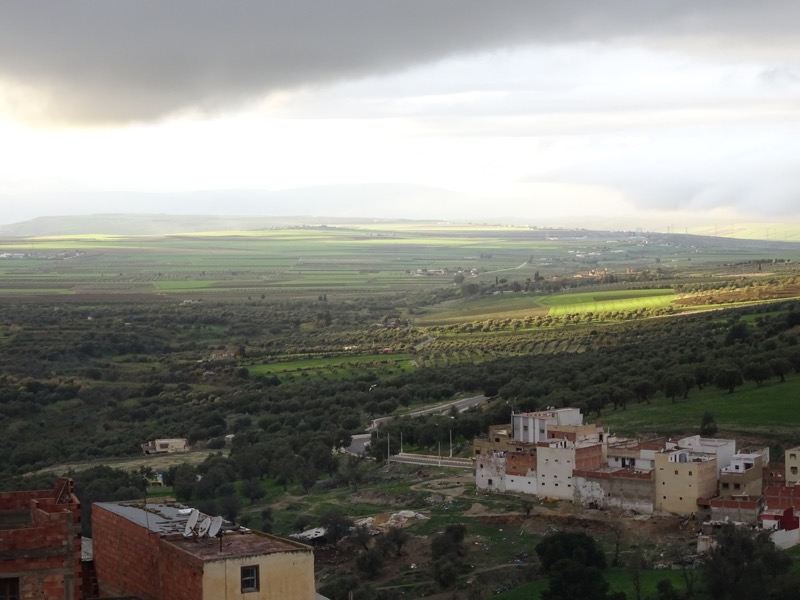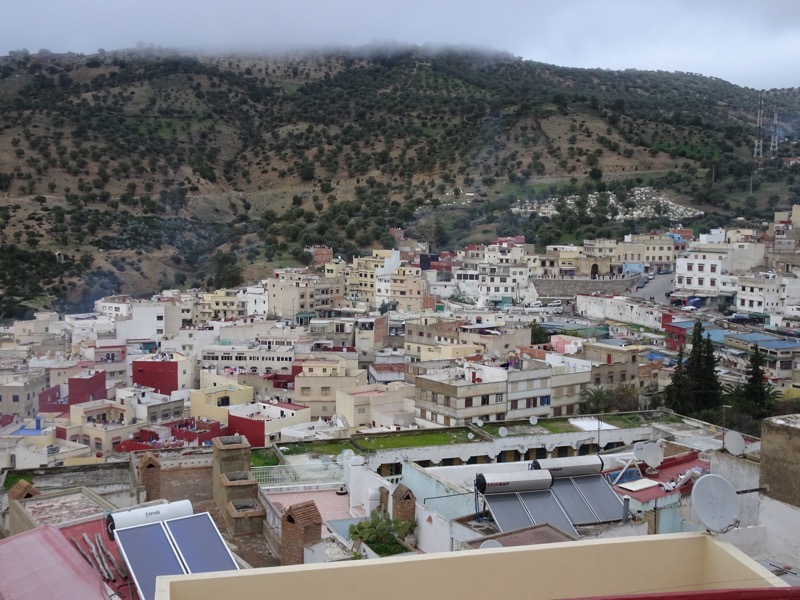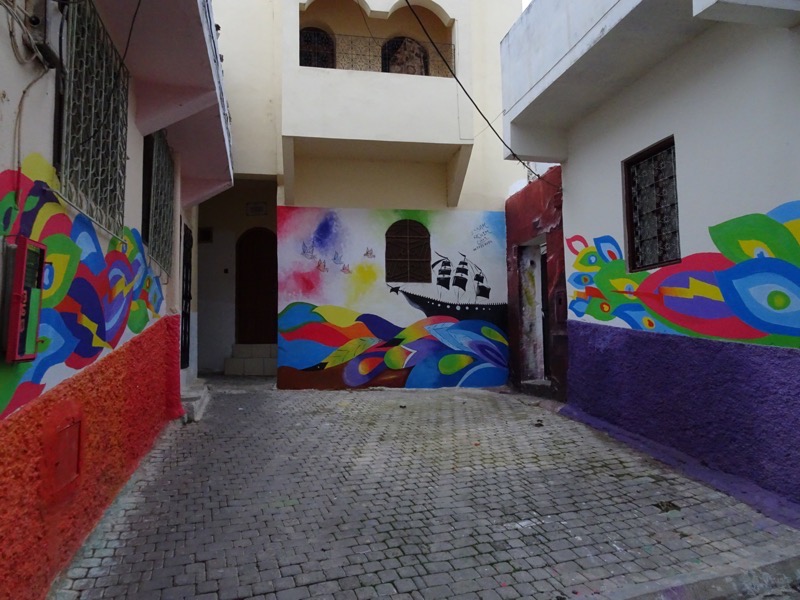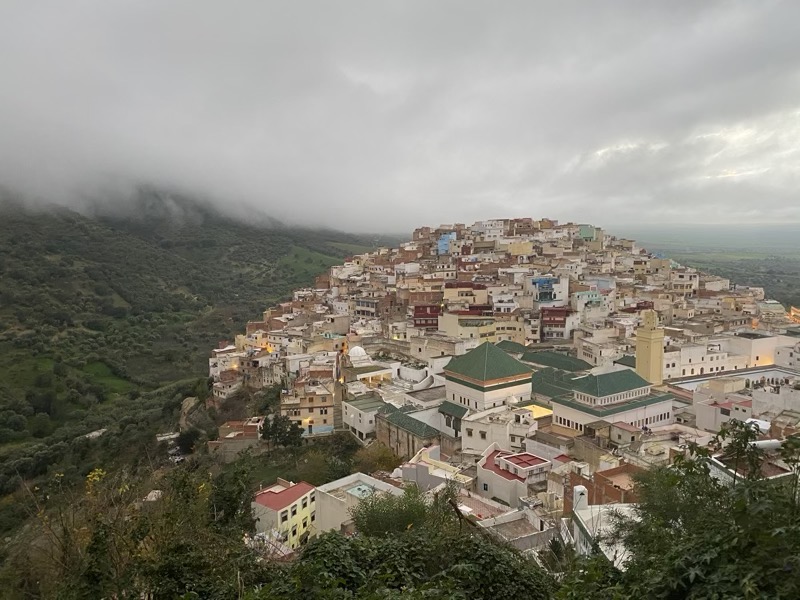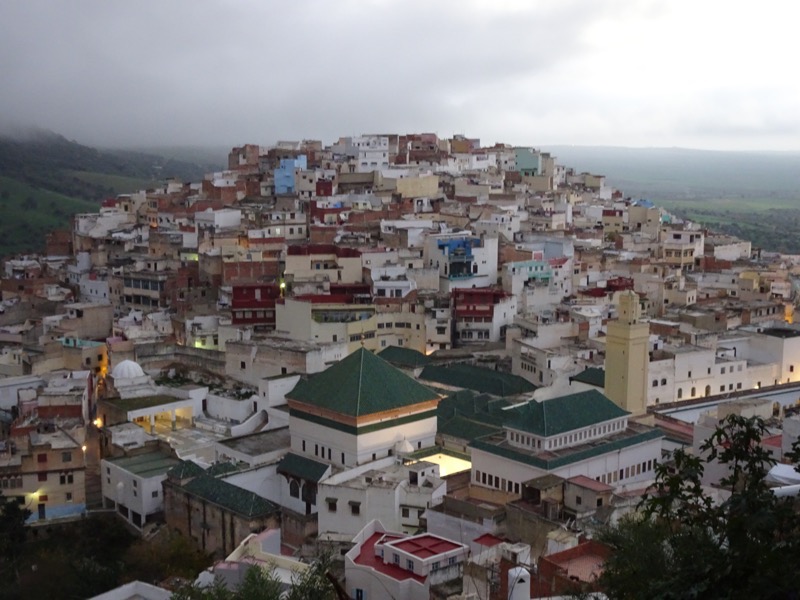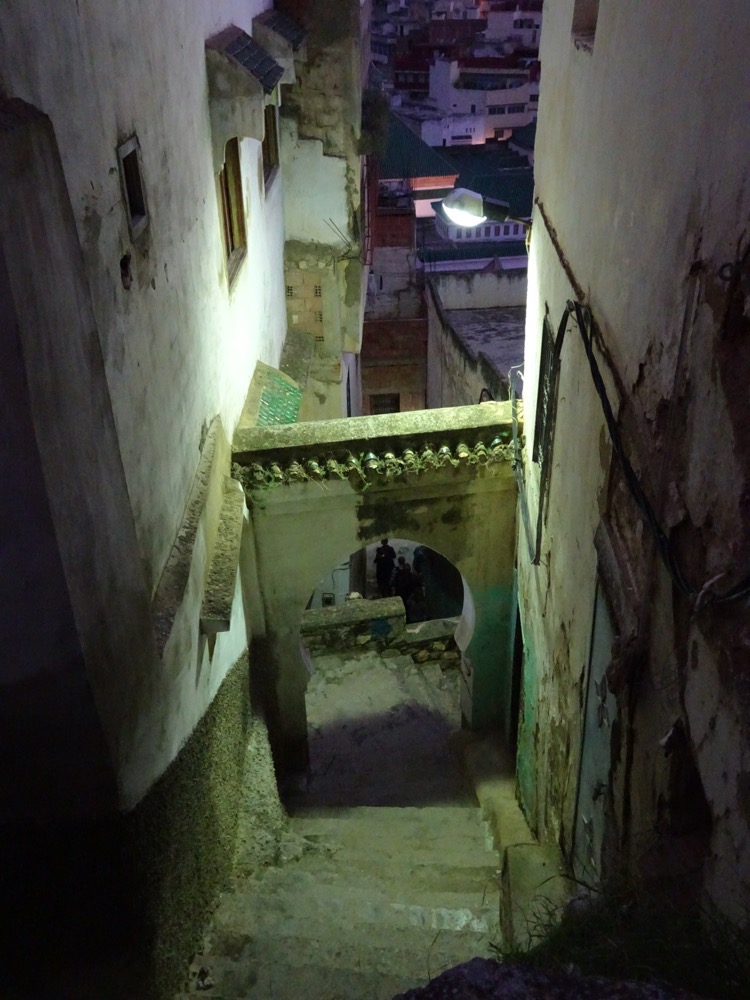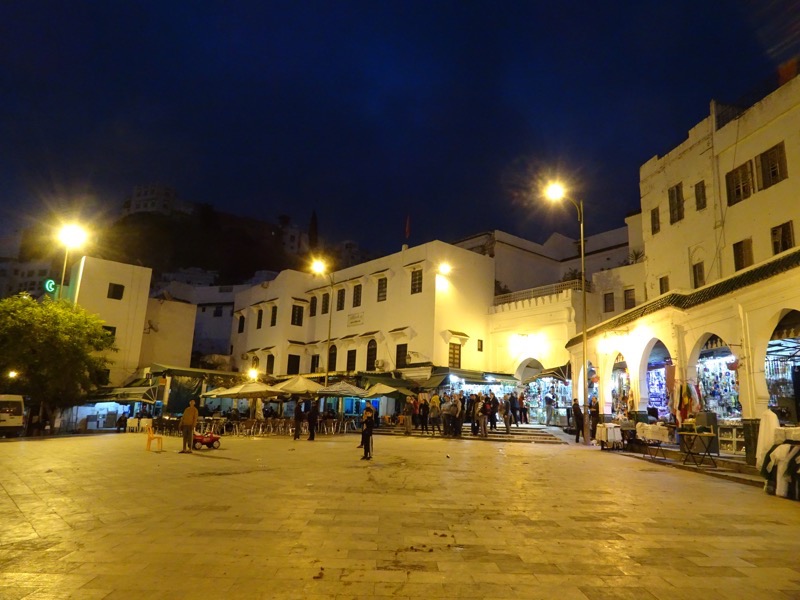This morning we left Fez behind and set off in a private bus (thank fuck for that – the original itinerary said we’d be on public transport!) for Chefchaouen. The private bus was so we could stop here and there and check out a few things on the way, have a picnic lunch somewhere and take our time… it’s not my preference to turn a 4 hour drive into a 6 hour one, but if it saves us from squishing in with 50 or more, and a driver who’s likely on his phone and smoking while whipping around the mountains on the local bus, then I’m down with that.
We had a few photo stops on the way, this is one of the water reservoir dams that feeds Fez. You can see the waterline is way down on ‘what it is supposed to be at this time of year’. 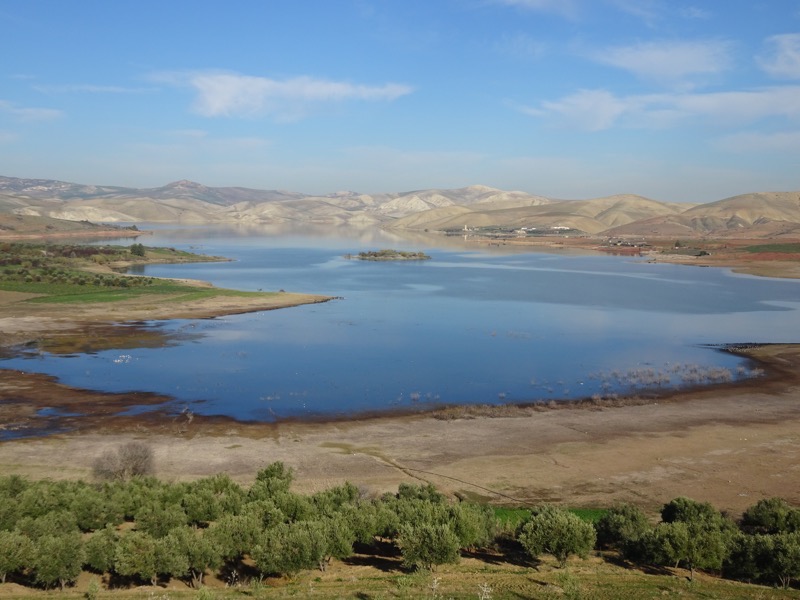 We also made a stop at an orange orchard so we could buy a few fresh oranges for our picnic. The oranges here are lovely, you can get large, cheap glasses of fresh orange juice in restaurants everywhere and the juice tastes slightly more like mandarins than the oranges at home.
We also made a stop at an orange orchard so we could buy a few fresh oranges for our picnic. The oranges here are lovely, you can get large, cheap glasses of fresh orange juice in restaurants everywhere and the juice tastes slightly more like mandarins than the oranges at home. 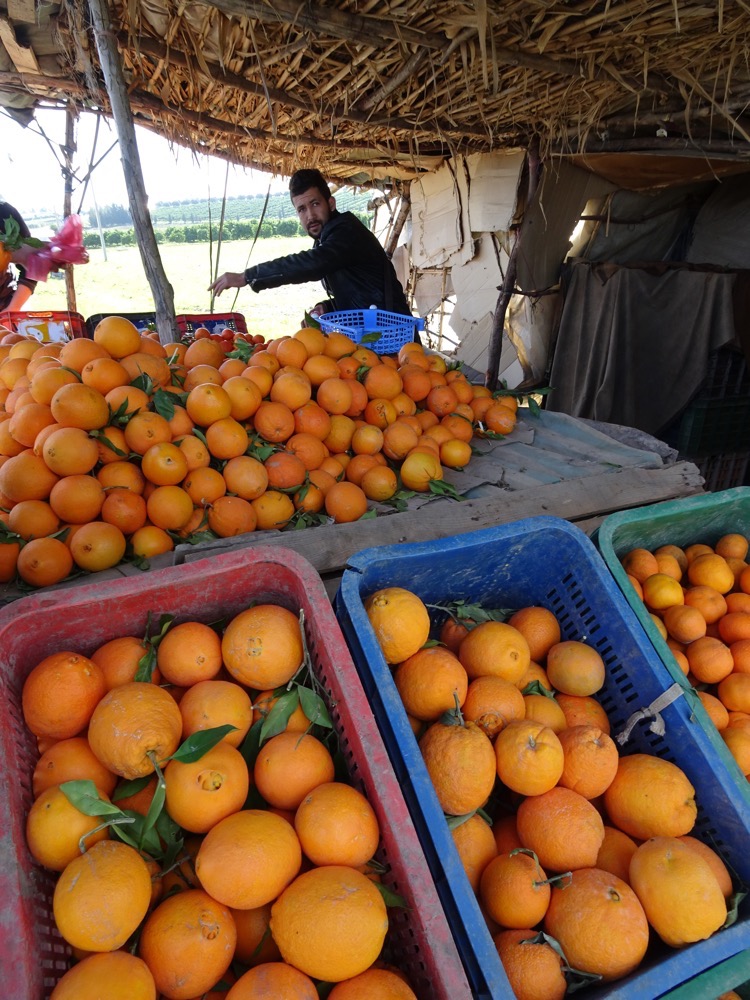 Everytime we get into the countryside, I can’t believe how green everything is…. the grass is lush and green, the trees are green, the stock looks fat and healthy… the drought at home is quickly brought into stark contrast.
Everytime we get into the countryside, I can’t believe how green everything is…. the grass is lush and green, the trees are green, the stock looks fat and healthy… the drought at home is quickly brought into stark contrast.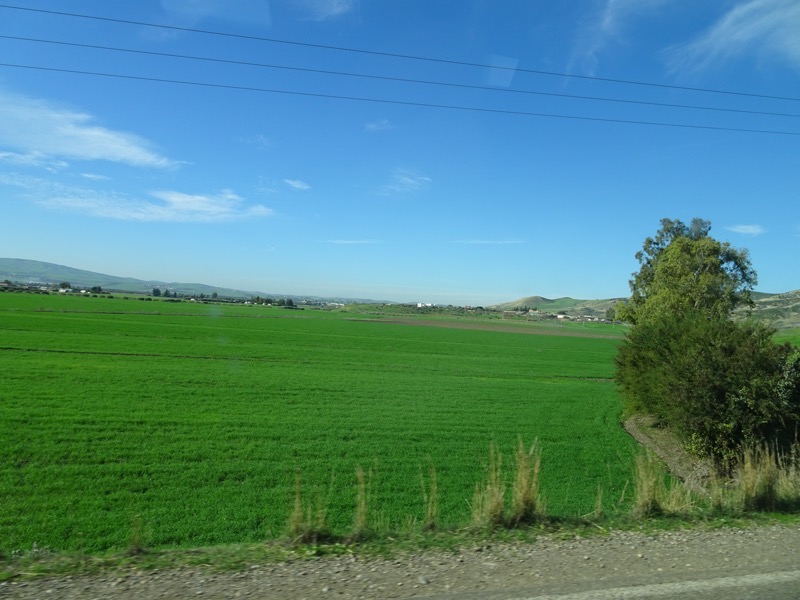 Another stop we made was at an olive press co-op. Some of the smaller local farmers don’t have the expensive machinery required to press olives, so they bring their harvest here and their bags are numbered. They then wait their turn and put their olives through the press. The air felt thick and kinda slimy… the ground is literally dripping in olive oil.
Another stop we made was at an olive press co-op. Some of the smaller local farmers don’t have the expensive machinery required to press olives, so they bring their harvest here and their bags are numbered. They then wait their turn and put their olives through the press. The air felt thick and kinda slimy… the ground is literally dripping in olive oil.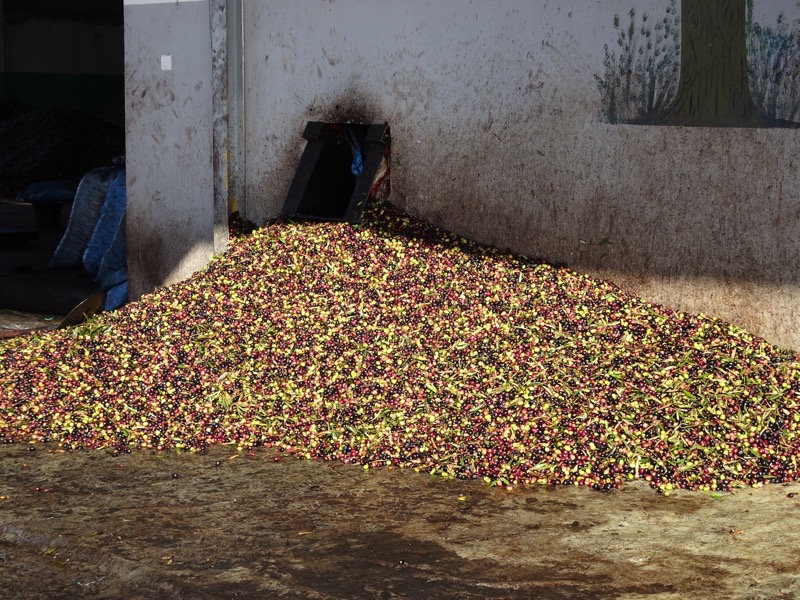 I actually disllike olives, which is weird for me as I usually love savoury and salty foods. The smell here was getting to me quite a bit. Bags of olives belonging to different farmers.
I actually disllike olives, which is weird for me as I usually love savoury and salty foods. The smell here was getting to me quite a bit. Bags of olives belonging to different farmers.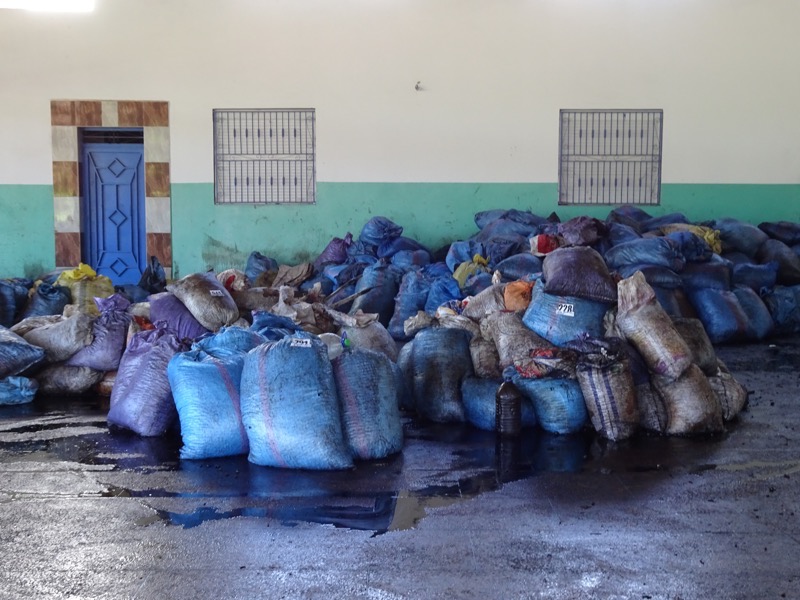 A couple of the men who worked here – their clothes are soaked through with olive oil, their hands and faces black with oily gunk.
A couple of the men who worked here – their clothes are soaked through with olive oil, their hands and faces black with oily gunk. 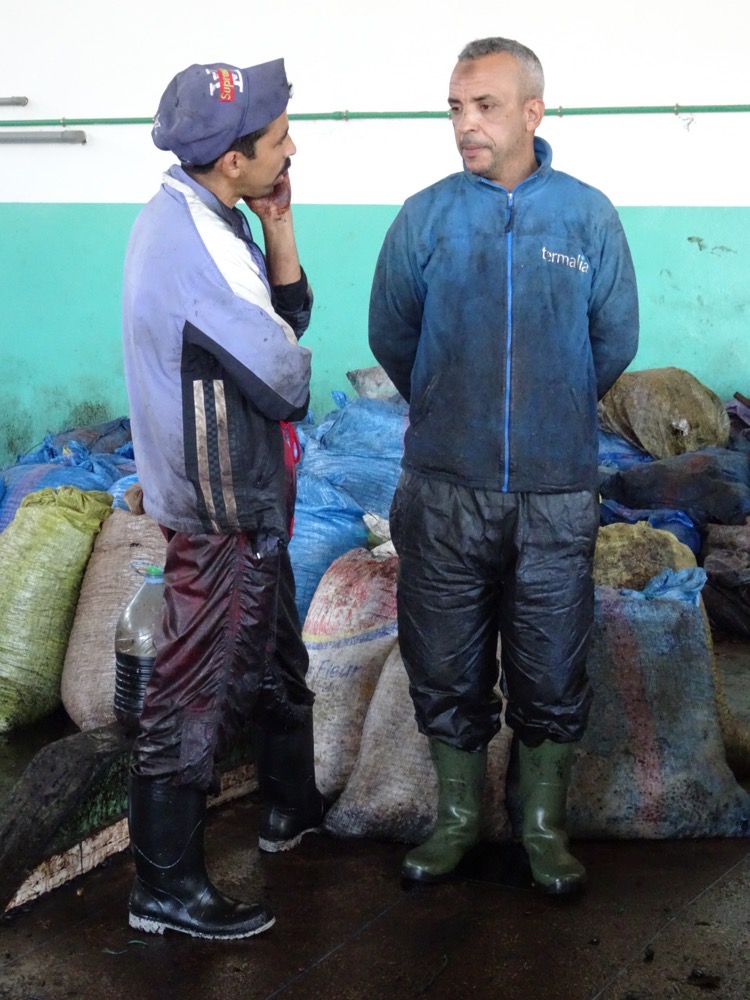 This must be one of the few largely automated processes we have seen in Morocco so far… until now, it seemed like nearly everything is done by hand.
This must be one of the few largely automated processes we have seen in Morocco so far… until now, it seemed like nearly everything is done by hand.
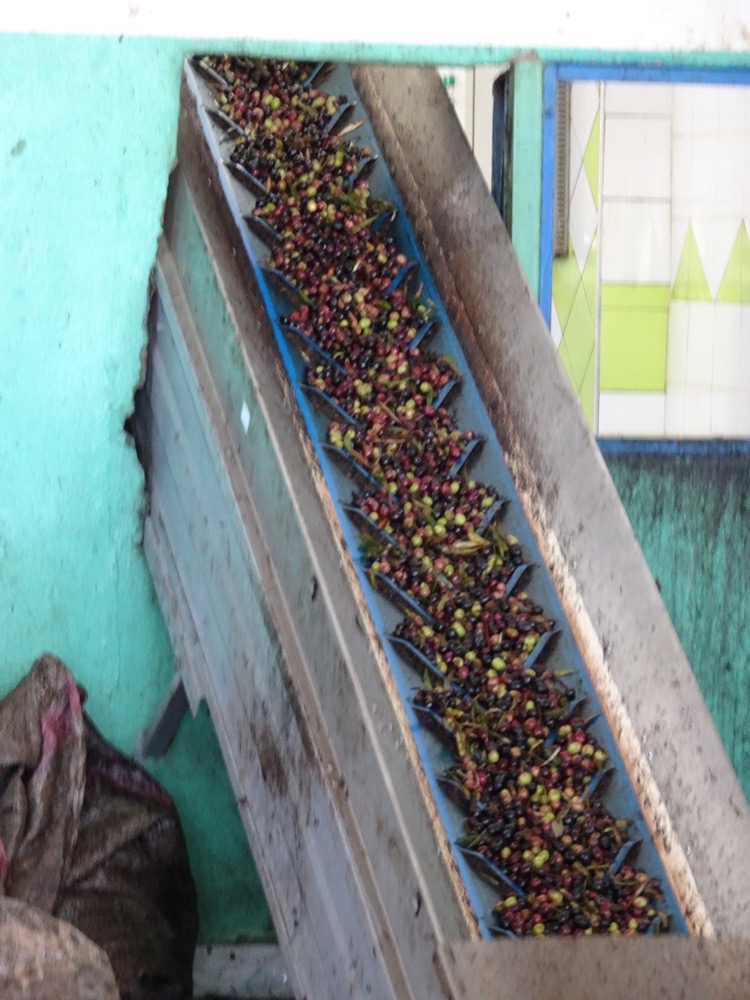
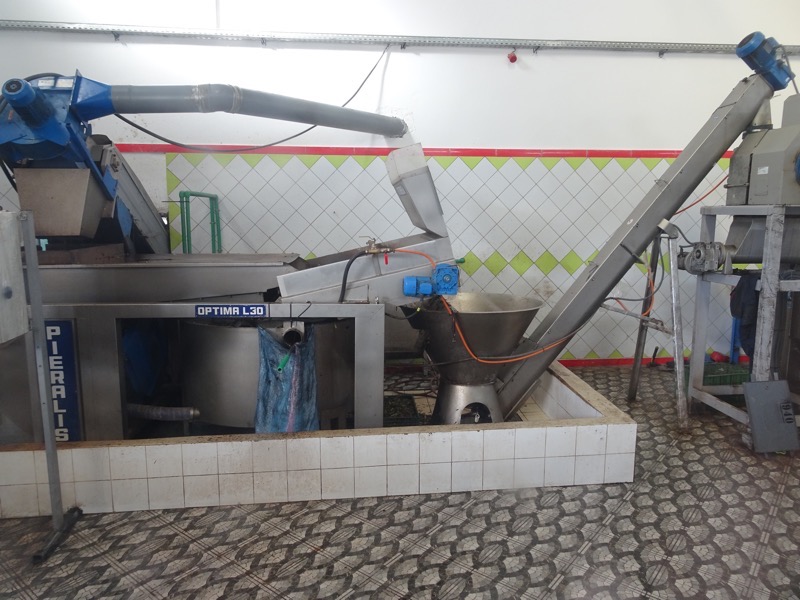
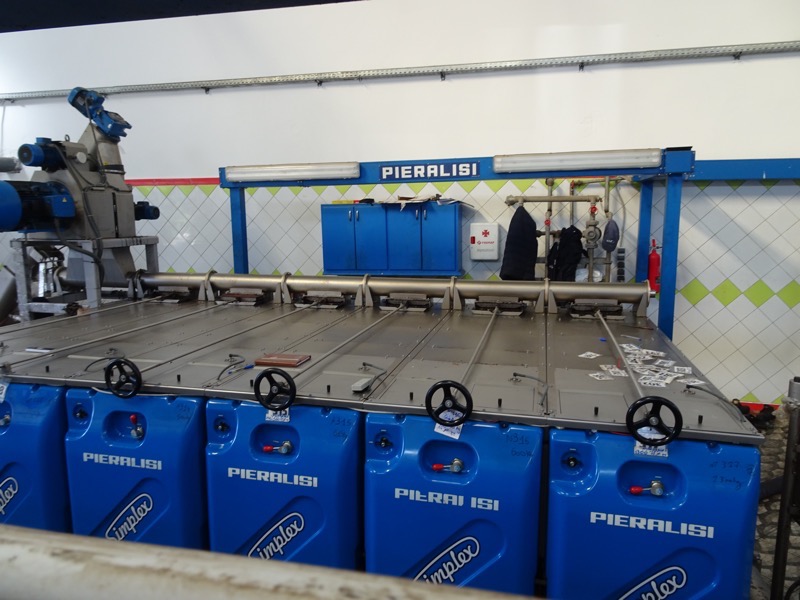 The first press olive oil is thick and green.
The first press olive oil is thick and green.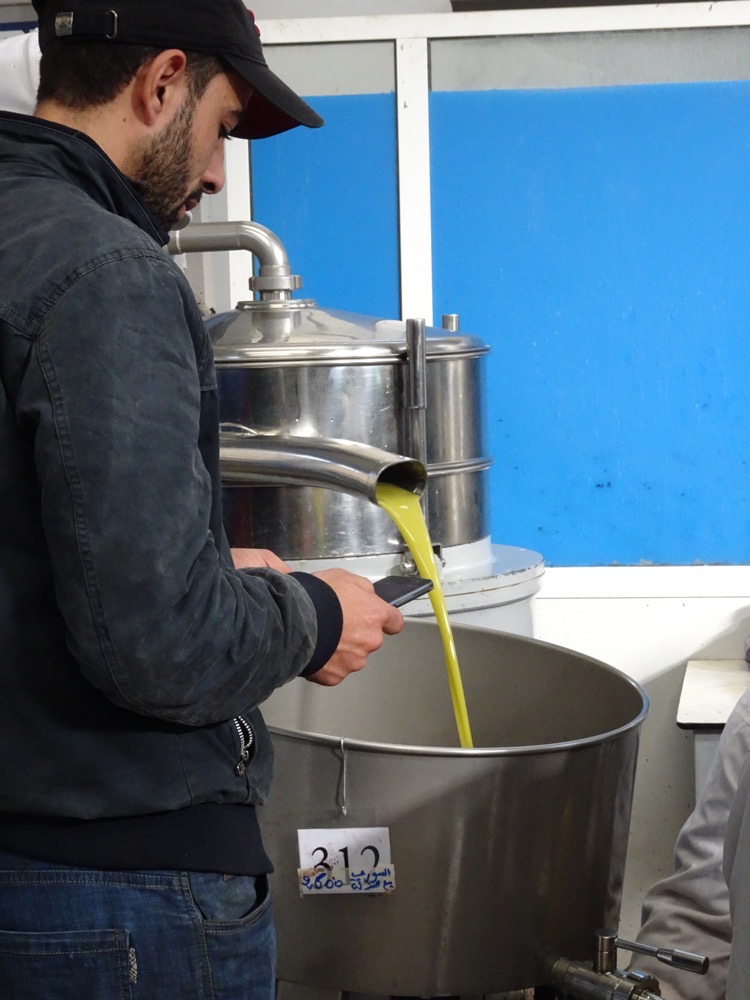
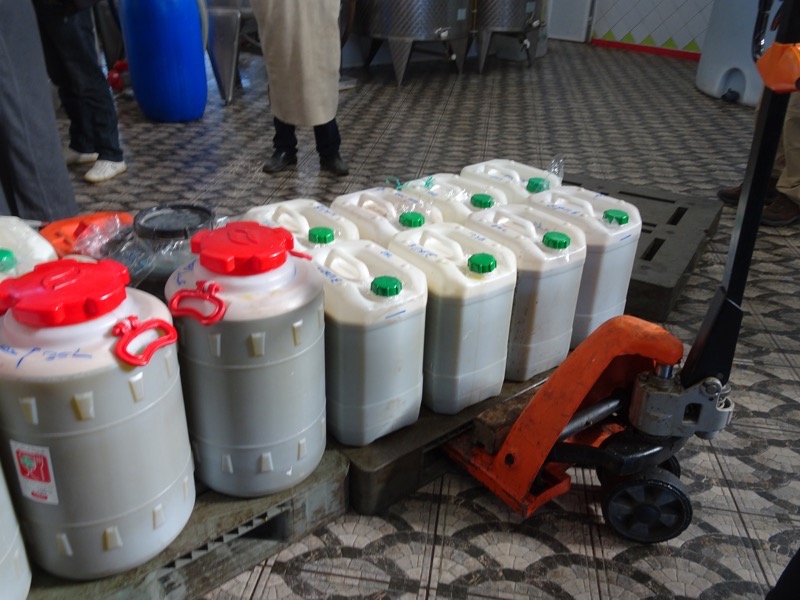 Everyone was offered a bit of bread to try it, along side other oils that had been processed for the second time and third time. I quite like my extra virgin olive oil, but not being a fan of things that actually taste like olives, I gave it a miss (good thing that turned out to be – at least two in our group said they paid for it as it went right through them and they were running for the bathroom a few hours later).
Everyone was offered a bit of bread to try it, along side other oils that had been processed for the second time and third time. I quite like my extra virgin olive oil, but not being a fan of things that actually taste like olives, I gave it a miss (good thing that turned out to be – at least two in our group said they paid for it as it went right through them and they were running for the bathroom a few hours later).
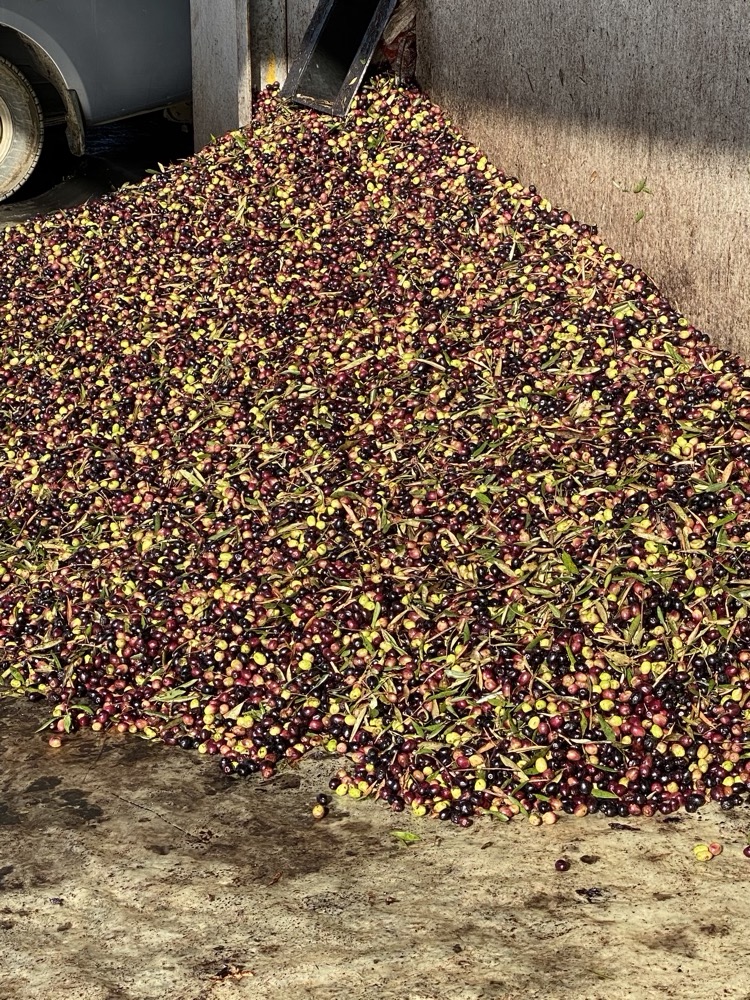 Anyway, back on the bus and a few kilometers down the road we stopped for a picnic lunch. Before leaving Fez, we went to an enormous supermarket and all picked up some tidbits for lunch. We had some very tasty sandwiches and wraps with meats, cheeses, nuts, dates, figs etc. We even managed to buy some drinks so many had picked up some beers to have with lunch.
Anyway, back on the bus and a few kilometers down the road we stopped for a picnic lunch. Before leaving Fez, we went to an enormous supermarket and all picked up some tidbits for lunch. We had some very tasty sandwiches and wraps with meats, cheeses, nuts, dates, figs etc. We even managed to buy some drinks so many had picked up some beers to have with lunch. 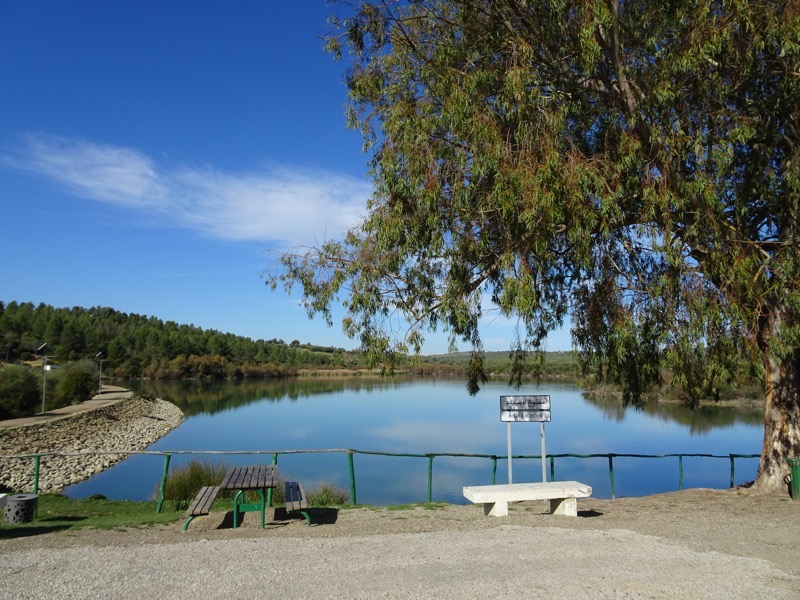 Hay stacks for the winter.
Hay stacks for the winter. 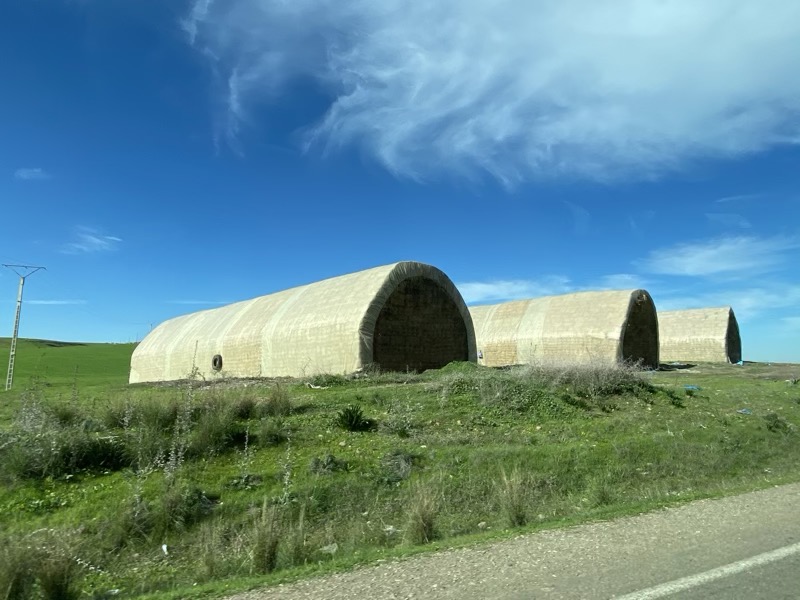 Everywhere, you could see enormous rows of prickly pear. They use it for a few different purposes – hedgerows are grown to make fencing to keep their animals in. The plant itself is eaten in some dishes, and the flowers are used for a natural dye. At home it’s a noxious weed.
Everywhere, you could see enormous rows of prickly pear. They use it for a few different purposes – hedgerows are grown to make fencing to keep their animals in. The plant itself is eaten in some dishes, and the flowers are used for a natural dye. At home it’s a noxious weed. 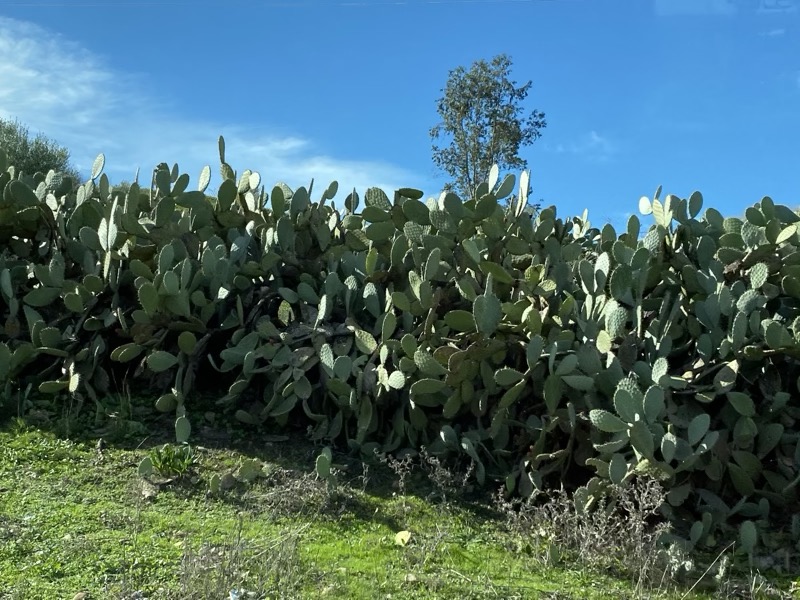 About another hour or so down the road and we arrived at Chefchaouen. Chefchaouen is nestled between two mountain peaks – the word itself actually means ‘two mountian horns’ – and is located at 560m above sealevel, about 70kms from the Mediterranean to the north and 130kms from the Atlantic to the west. From this lookout we could see some glimpses of the blue walls this city is so famous for.
About another hour or so down the road and we arrived at Chefchaouen. Chefchaouen is nestled between two mountain peaks – the word itself actually means ‘two mountian horns’ – and is located at 560m above sealevel, about 70kms from the Mediterranean to the north and 130kms from the Atlantic to the west. From this lookout we could see some glimpses of the blue walls this city is so famous for.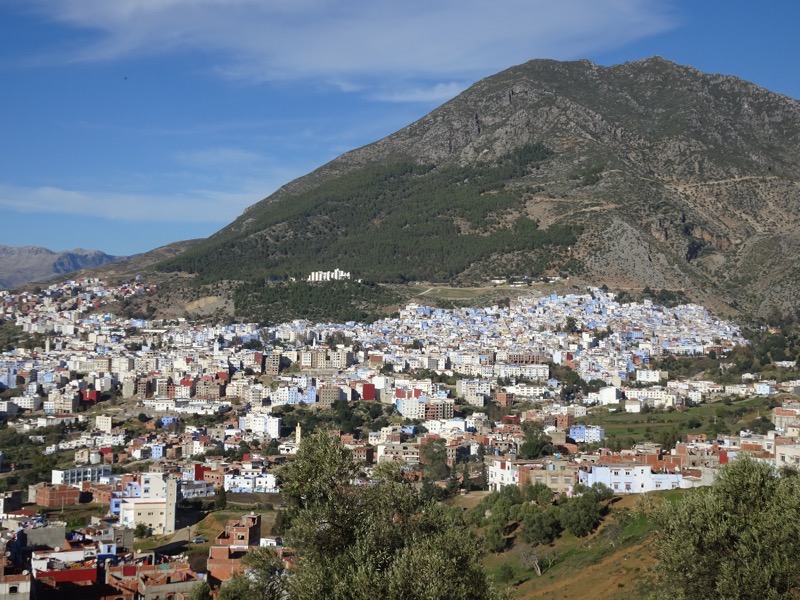
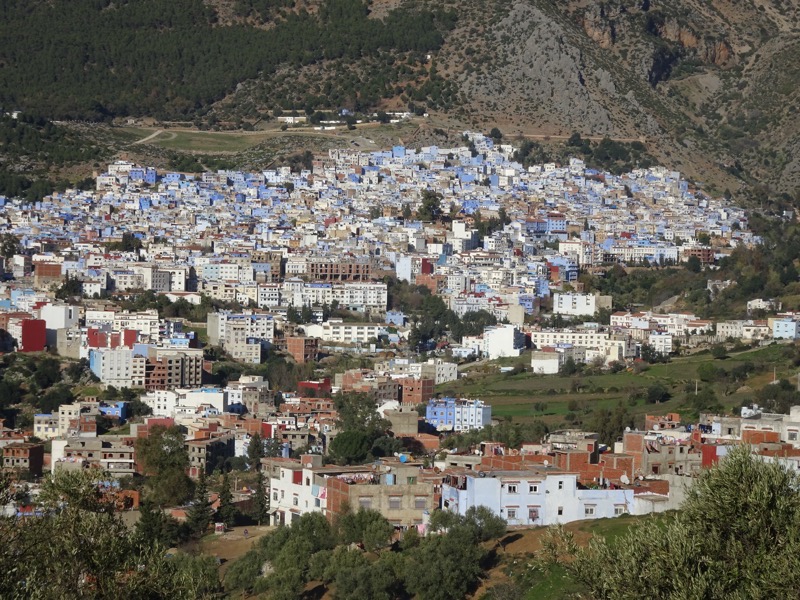 We arrived at our hotel Darechaouen and were greeted with cups of Moroccan mint tea and date cookies while they sorted the rooms out.
We arrived at our hotel Darechaouen and were greeted with cups of Moroccan mint tea and date cookies while they sorted the rooms out. 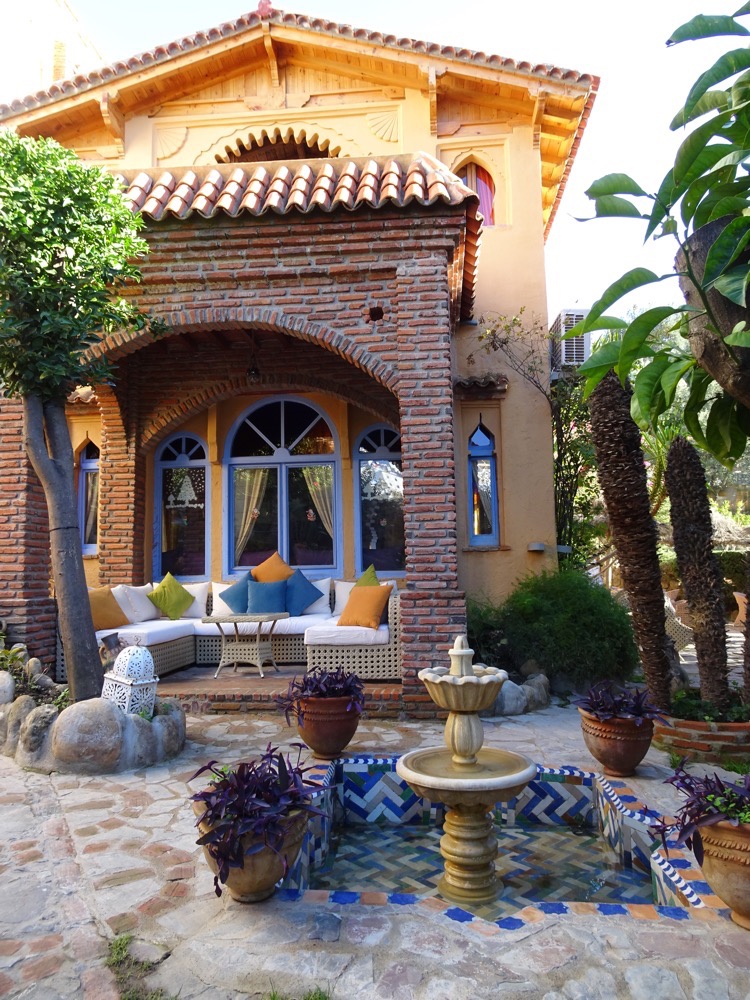
We found ourselves being escorted to a lovely suite room with a large living room attached and a huge ensuite. Very nice!
After everyone had settled in, we went for a bit of an orientation walk around the town. Firstly up to see the mountain spring that feeds the town with fresh water.
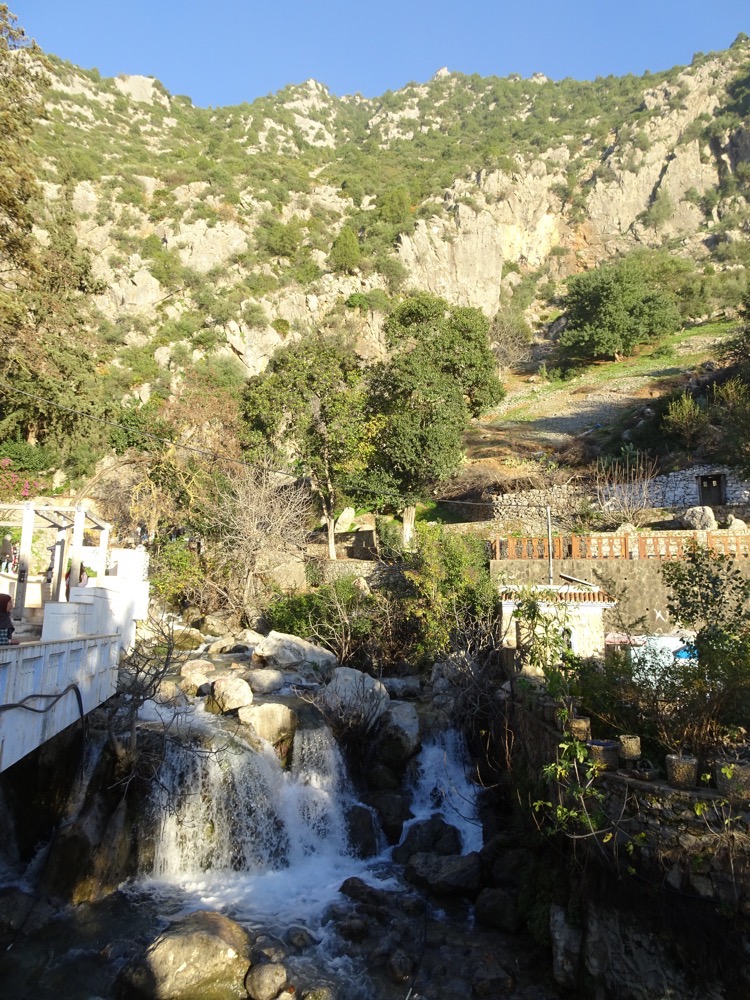
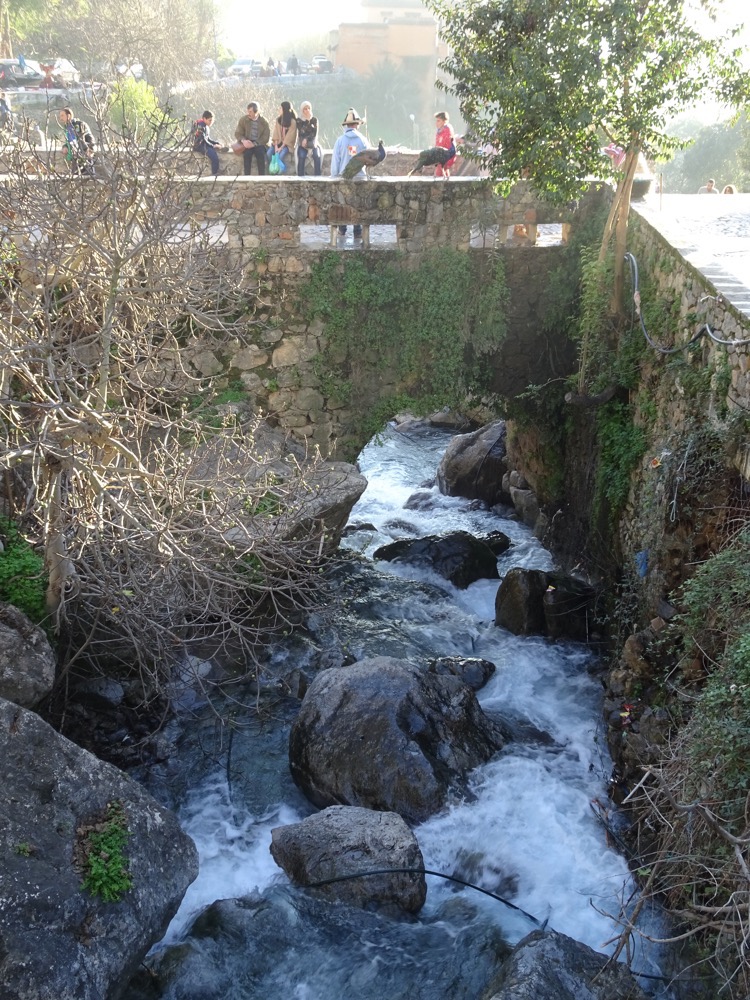 After the winter snow melts, this spring will have twice as much water pouring from it.
After the winter snow melts, this spring will have twice as much water pouring from it.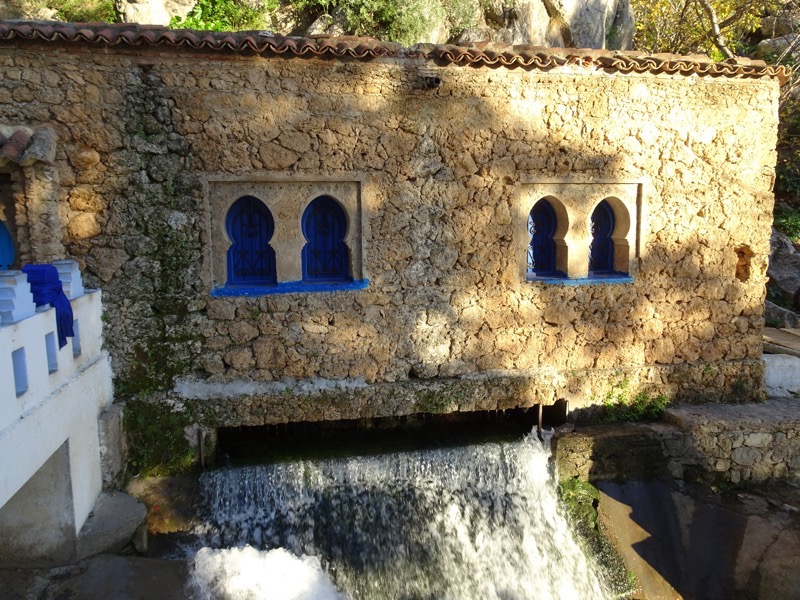
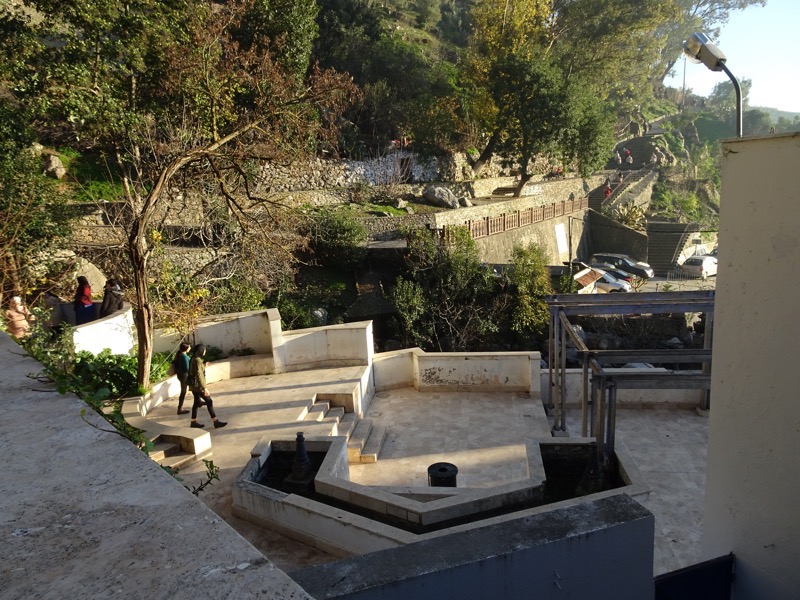 Directly to the left of these four ladies was a bench with four men, presumably their husbands… “What you talking about?” – “Shopping” … “What you talking about?” – “Football”
Directly to the left of these four ladies was a bench with four men, presumably their husbands… “What you talking about?” – “Shopping” … “What you talking about?” – “Football”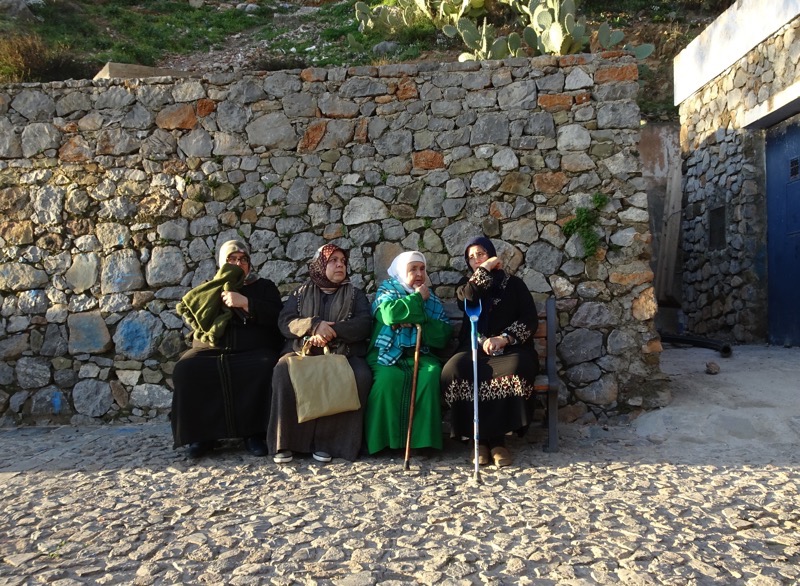
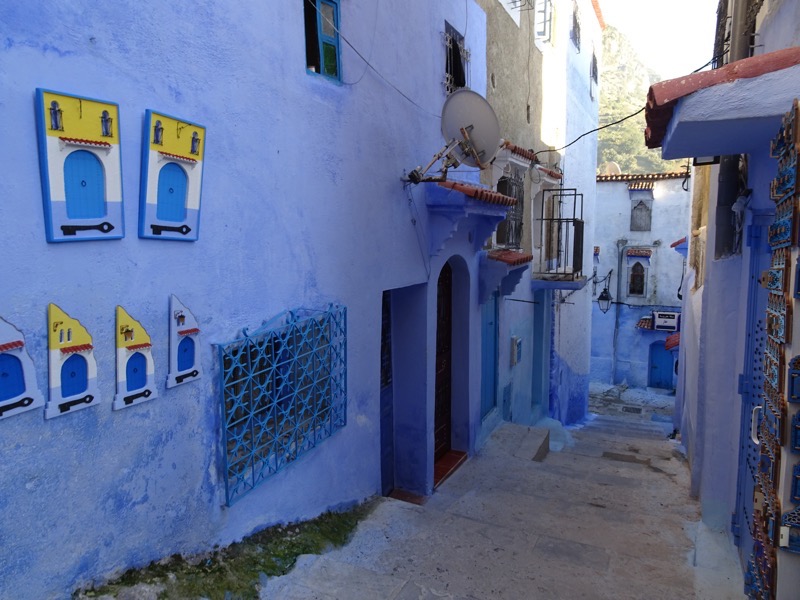
Chefchaouen was founded in 1471 as a small kasbah (fortress) to fight the Portuguese invasions of northern Morocco. Many local tribal people, Berbers and Ghomara peoples, as well as Moriscos and Jews, settled here after the Spanish Reconquista in the medieval period. In the early 20thC (c1920) the Spanish seized the city to form part of Spanish morocco. Spanish troops imprisoned local leaders in the kasbah for several years and there is a decidedly Spanish influence to a lot of the local architecture and food etc.
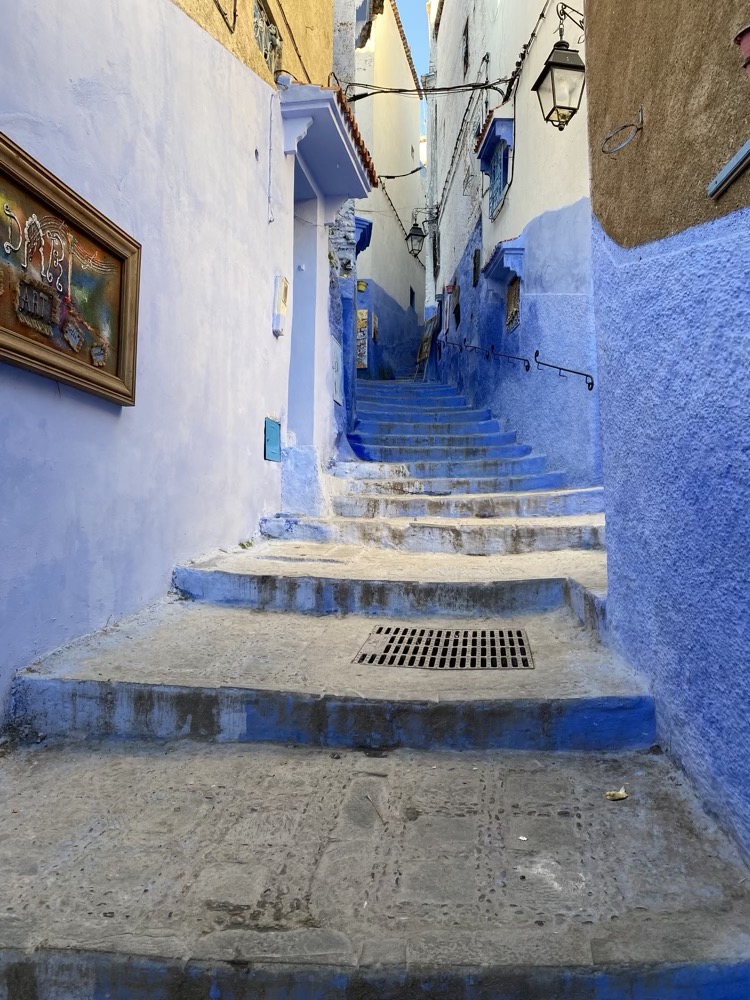 The blue walls are what draws the tourists to town – it makes a stunning backdrop for photographs and is reminiscent of the blue-trimmed whitewashed walls of Santorini or Mykonos. No one is entirely sure why the walls are painted blue – there are several theories though. One popular theory is that the blue keeps the mosquitos away, another is that the Jews introduced the blue when they took refuge here from Hitler’s regime in the 1930s. Another is that the blue paint was brought down as leftover paint from what was used to paint fishing boats to the north. And yet another theory is that the blue symbolizes the sky and the heaven to serve as a reminder to lead a spiritual life. However, some locals apparently say that the town mandated walls were to be primarily painted blue simply to attract tourists at some point int he 1970s… which while far less whimsical, is probably far more likely.
The blue walls are what draws the tourists to town – it makes a stunning backdrop for photographs and is reminiscent of the blue-trimmed whitewashed walls of Santorini or Mykonos. No one is entirely sure why the walls are painted blue – there are several theories though. One popular theory is that the blue keeps the mosquitos away, another is that the Jews introduced the blue when they took refuge here from Hitler’s regime in the 1930s. Another is that the blue paint was brought down as leftover paint from what was used to paint fishing boats to the north. And yet another theory is that the blue symbolizes the sky and the heaven to serve as a reminder to lead a spiritual life. However, some locals apparently say that the town mandated walls were to be primarily painted blue simply to attract tourists at some point int he 1970s… which while far less whimsical, is probably far more likely.
 And it works. Chefchaouen is a very popular tourist destination, partly due to its proximity to Tangier. There are over two hundred riad and hotels to cater for the influx of tourists – once largely catering to the European tourists (lots of Spanish arrive here at Easter and Christmas holidays), but now more commonly the Chinese tourists are here for their photos too.
And it works. Chefchaouen is a very popular tourist destination, partly due to its proximity to Tangier. There are over two hundred riad and hotels to cater for the influx of tourists – once largely catering to the European tourists (lots of Spanish arrive here at Easter and Christmas holidays), but now more commonly the Chinese tourists are here for their photos too.
The region is also known for its native handicrafts that are not seen anywhere else in Morocco, particularly Berber style woollen garments, rugs and woven blankets. 
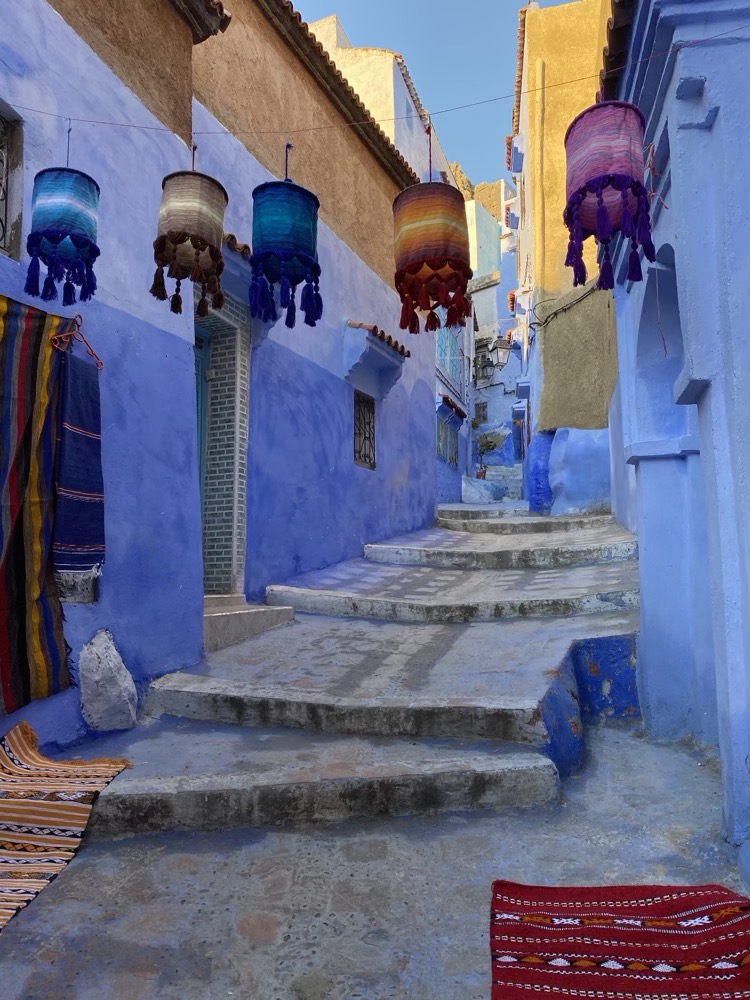 Want to see my scoot?!
Want to see my scoot?!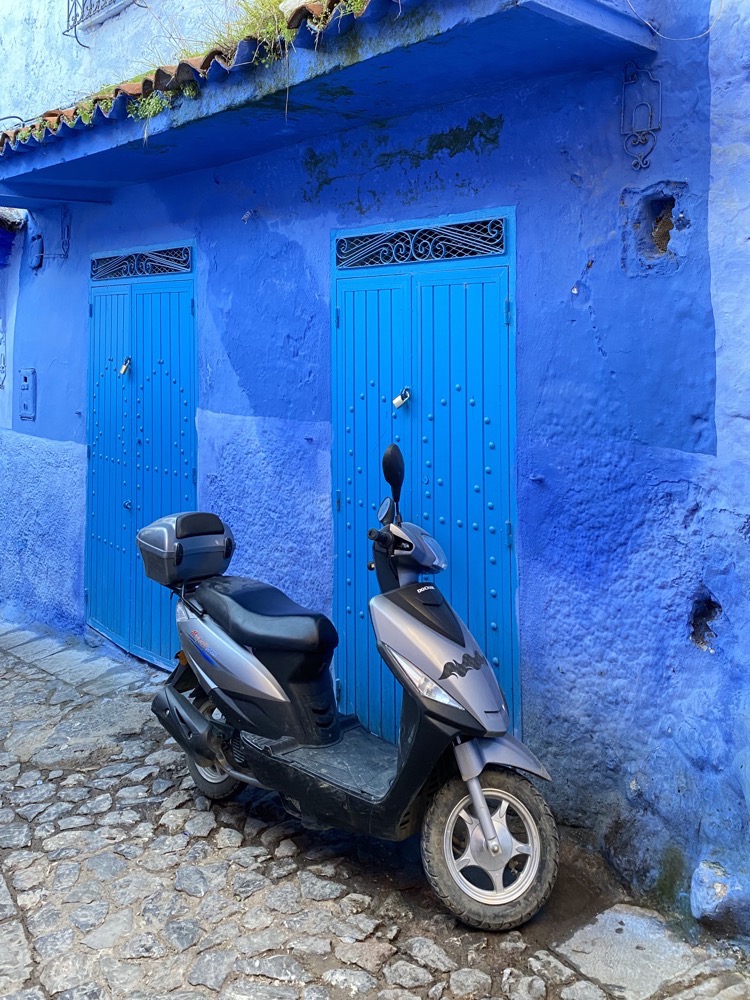 The surrounding countryside is well known as a prolific source of ‘kief’ – marijuana, and as we walked the town you would semiregularly get a strong whiff of pot as you rounded a corner or walked past a shop.
The surrounding countryside is well known as a prolific source of ‘kief’ – marijuana, and as we walked the town you would semiregularly get a strong whiff of pot as you rounded a corner or walked past a shop.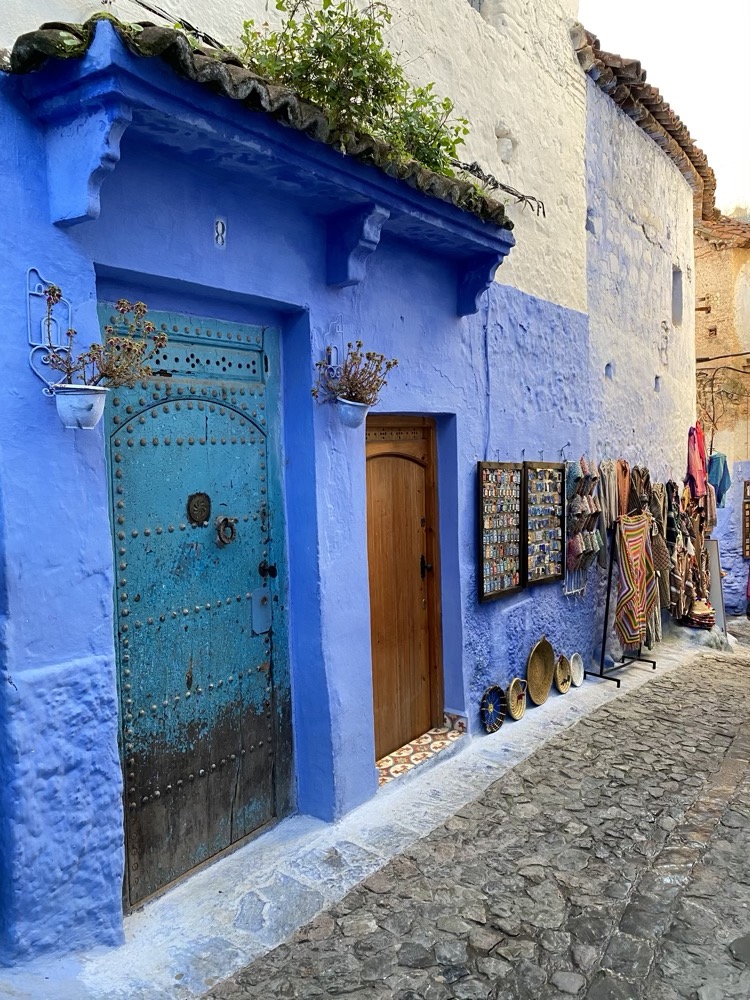 There are public fountains dotting the town that are gravity fed directly from the mountain spring – hundreds of years old, they have seen a lot of use.
There are public fountains dotting the town that are gravity fed directly from the mountain spring – hundreds of years old, they have seen a lot of use.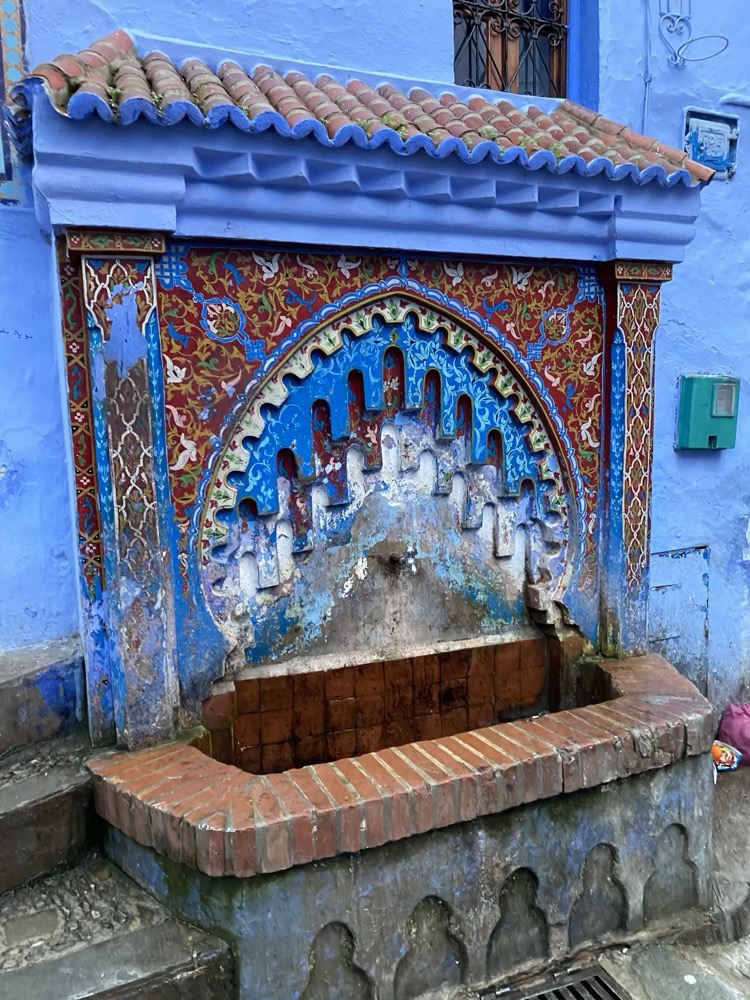 There are quaint little alleyways in every direction, most of them steep and because of the fountains located around the place, most of the walkways were slightly wet and rather slippery.
There are quaint little alleyways in every direction, most of them steep and because of the fountains located around the place, most of the walkways were slightly wet and rather slippery.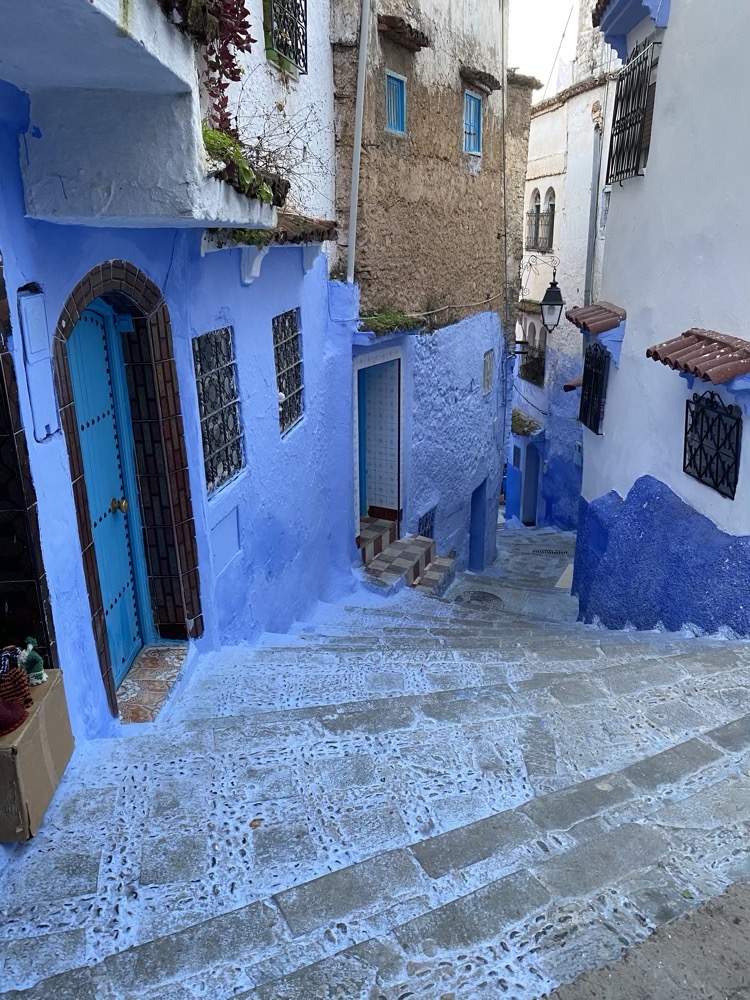 Chefchaouen is also knowns for it’s remarkably varied and popular blue doors… so many gates and doors everywhere – some simple, some elaborately painted, some enormous and some so small I have to duck to go in.
Chefchaouen is also knowns for it’s remarkably varied and popular blue doors… so many gates and doors everywhere – some simple, some elaborately painted, some enormous and some so small I have to duck to go in.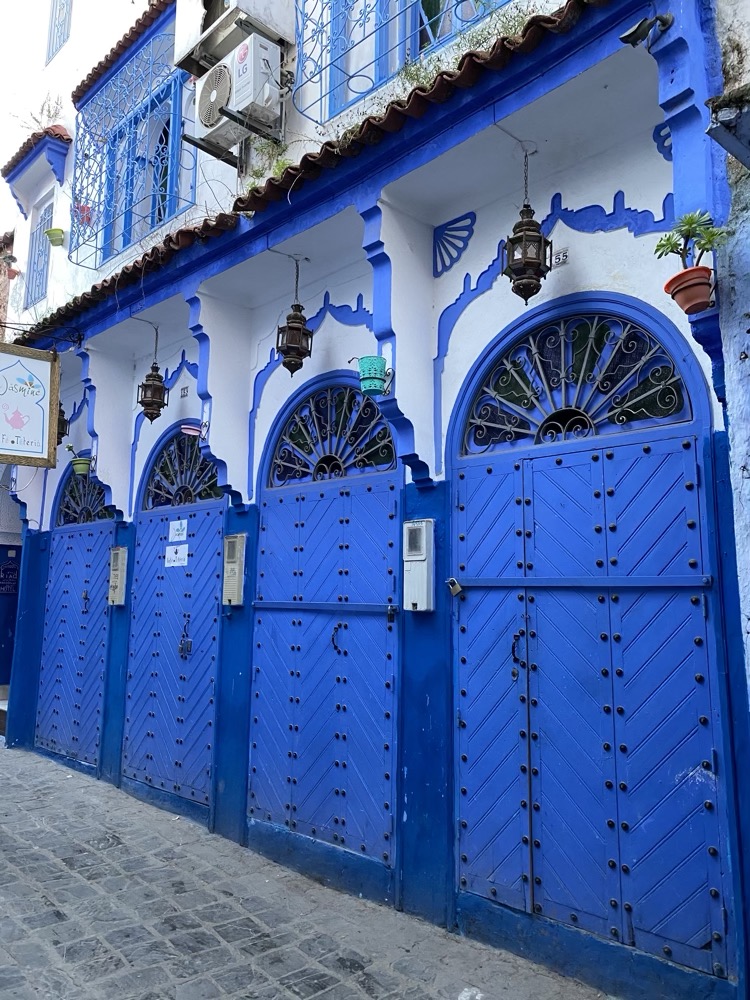 This (below) is one of the most famous photo spots in the city… Samirr warned us that if there were Chinese tourists here, we would ‘have to come back next year’ rather than wait for them to finish taking their photos. The locals are completely over the habit of Chinese tourists to stand in front of any famous object and take fifty photos of themselves in a myriad of very posed positions (tbh, so am I – Iceland last year was a real test of patience on that front).
This (below) is one of the most famous photo spots in the city… Samirr warned us that if there were Chinese tourists here, we would ‘have to come back next year’ rather than wait for them to finish taking their photos. The locals are completely over the habit of Chinese tourists to stand in front of any famous object and take fifty photos of themselves in a myriad of very posed positions (tbh, so am I – Iceland last year was a real test of patience on that front).
When we arrived here of course there were a handful of Chinese tourists hogging ‘the spot’ for their selfies and posing away for their friends with the camera… as soon as one moves out of the way, another will quickly jump in. Samirr’s shoulders slumped and he said, ‘I guess we have to come back next year’. Instead, as one (totally overdressed Chinese lady) was moving out of shot and another was about to move in, I very loudly and firmly said to their group ‘Thank you! Thank you! No people for a moment please!’ and unexpectedly, it worked! They all held back while our group took a few photographs of the street with no people. 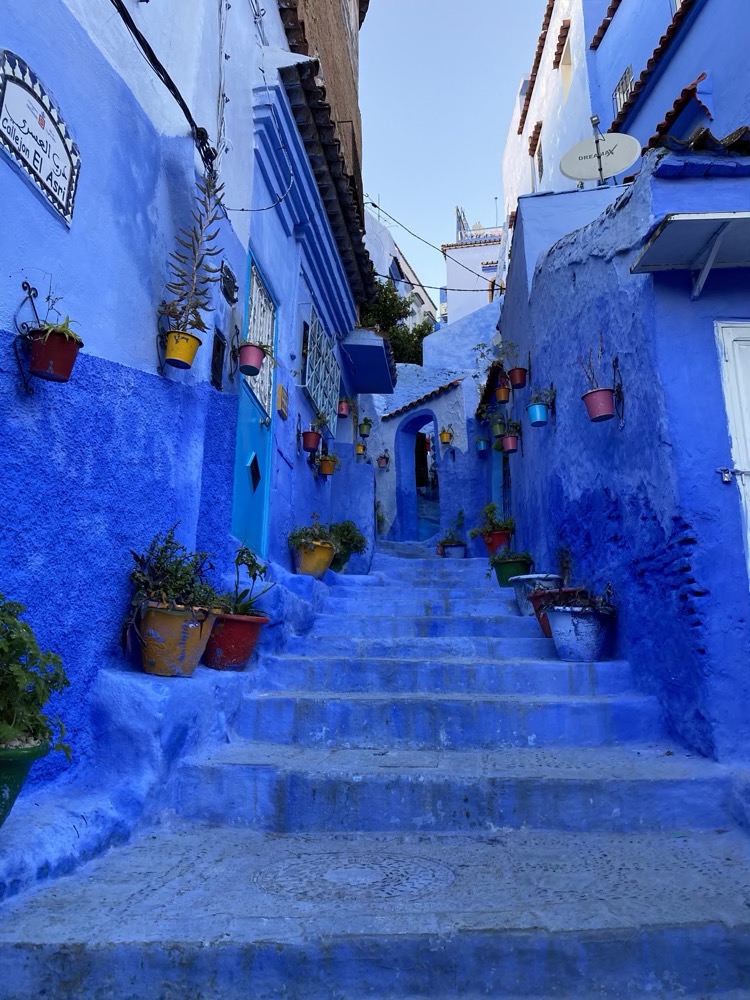 Samirr was impressed at my crowd management skills, our small tour group was pleased to have their chance at photos sans Chinese tourists, and I was simply stunned at the amazing beautiful blue colours of the steps on this tiny little street that attracts people from all over the world.
Samirr was impressed at my crowd management skills, our small tour group was pleased to have their chance at photos sans Chinese tourists, and I was simply stunned at the amazing beautiful blue colours of the steps on this tiny little street that attracts people from all over the world.
As we walked away from the area, everyone was thanking me for clearing the street, but after last year in Iceland where we would stand around patiently waiting for 10 to 15 minutes or longer, waiting for self-absorbed arseholes to get out of the way – I give up. You obviously need to speak up or you just end up wasting time or missing out… patented Mommy Voice for the win.
A little futher we came to an area of town selling pigments for the local craftsmen. 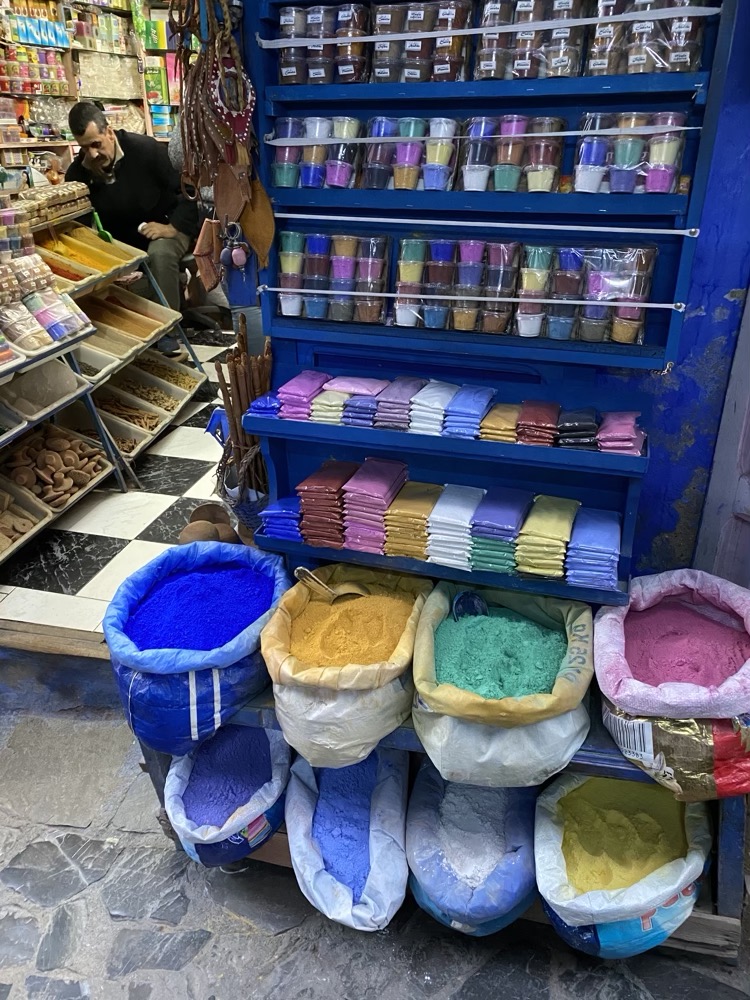
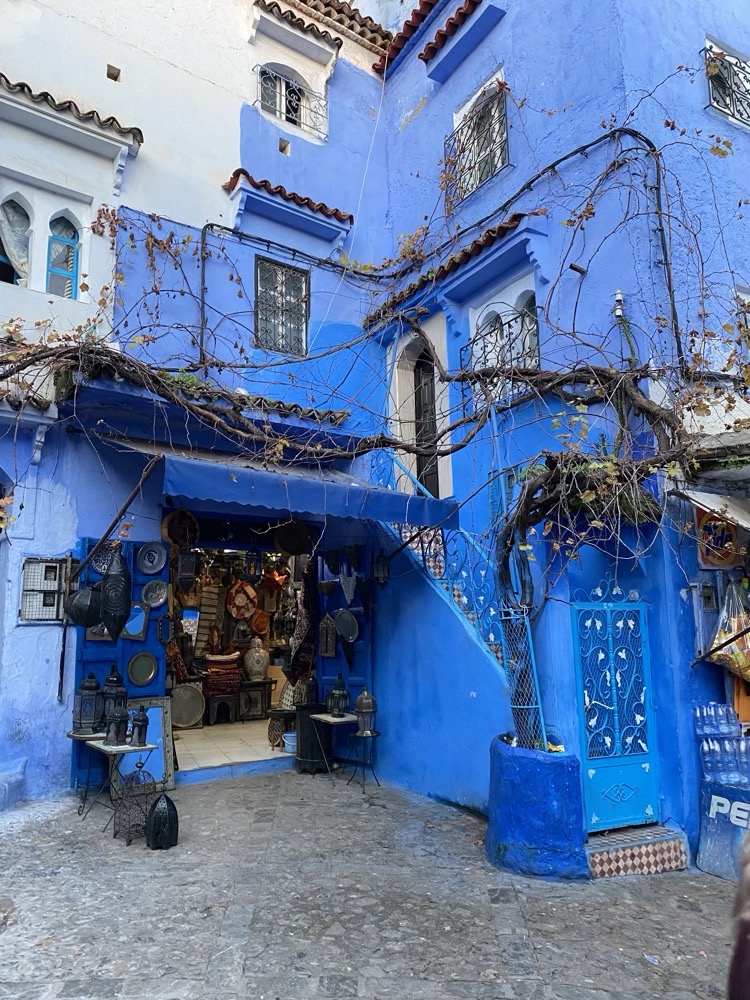
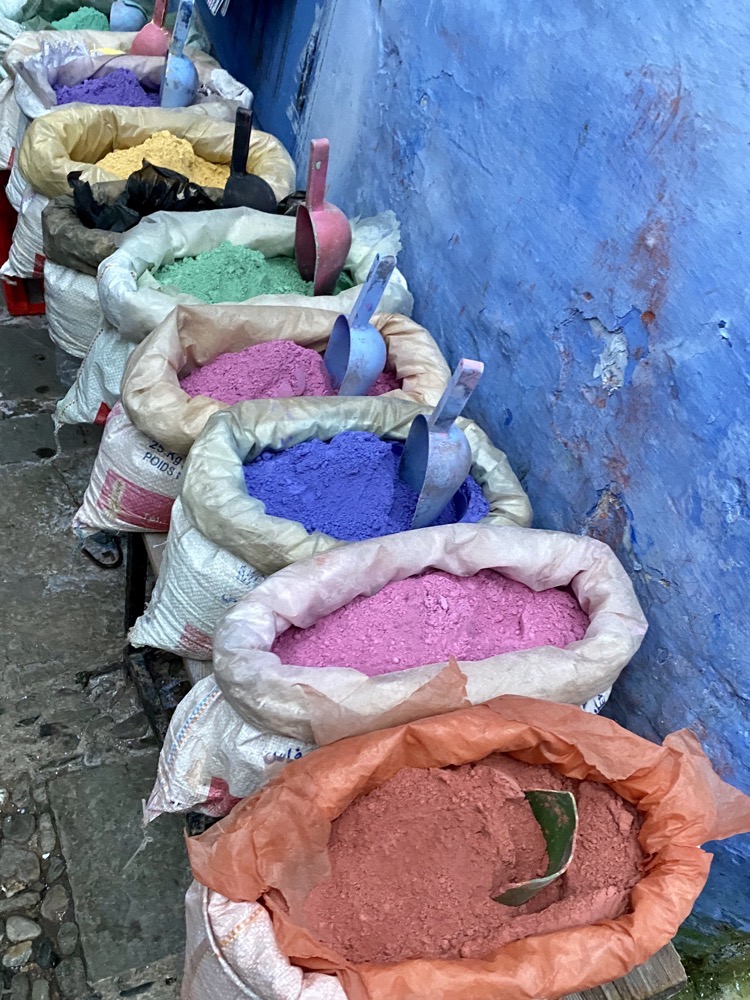 I know it looks like the town is nearly empty in most of these photos – but this is just my judicious sense of timing. Pick a spot and wait for the person to move right out of frame and *click* before someone moves into the left of frame. But trust me, there were plenty of people around and the medina only became busier as the sun went down and the locals came to town for the restaurants and clubs.
I know it looks like the town is nearly empty in most of these photos – but this is just my judicious sense of timing. Pick a spot and wait for the person to move right out of frame and *click* before someone moves into the left of frame. But trust me, there were plenty of people around and the medina only became busier as the sun went down and the locals came to town for the restaurants and clubs.
The original 15thC kasbah which we may go visit tomorrow… The town’s main square, which is pretty much at the bottom of the steep medina.
The town’s main square, which is pretty much at the bottom of the steep medina. 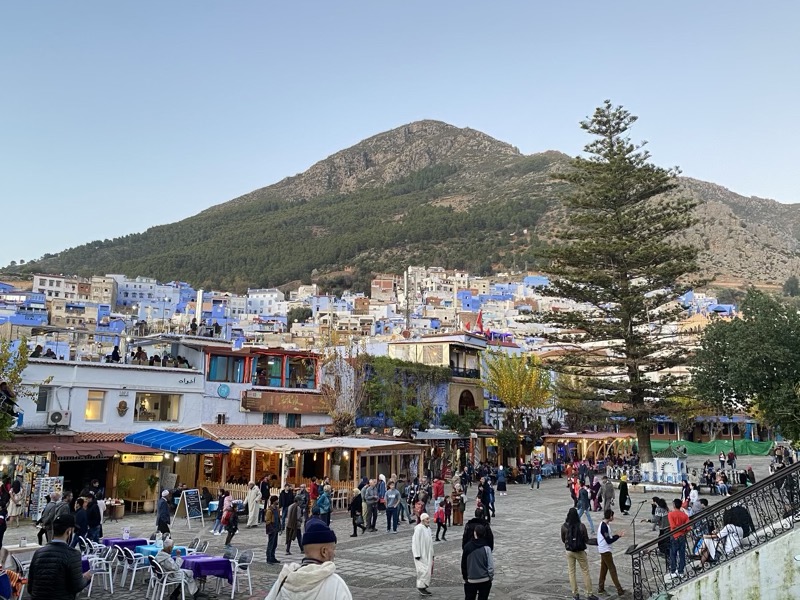 Still.. there were further little alleyways winding further down the mountain and we were diving back into them to find a Berber carpet shop.
Still.. there were further little alleyways winding further down the mountain and we were diving back into them to find a Berber carpet shop. 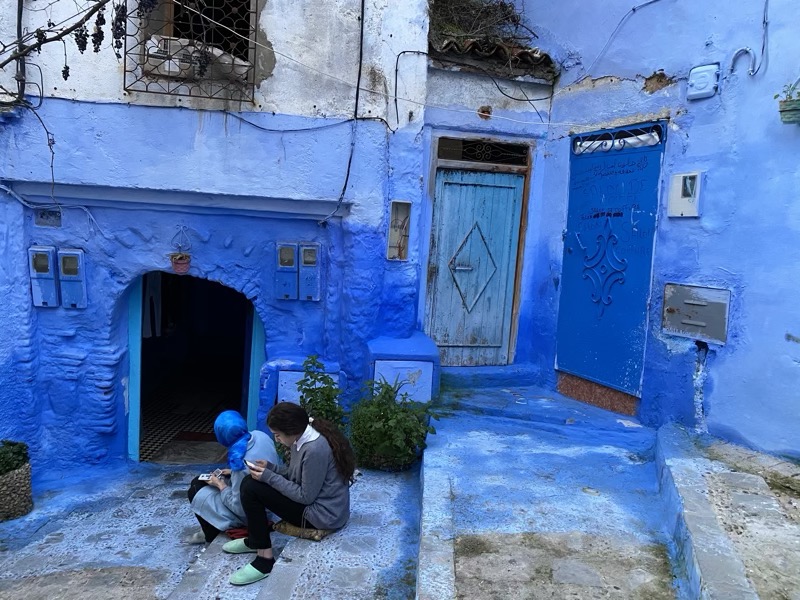 As tradition dictates, one must go carpet/rug shopping when in Turkey or Pakistan or India or Morocco and well, nearly everywhere from North Africa to the Subcontinent!
As tradition dictates, one must go carpet/rug shopping when in Turkey or Pakistan or India or Morocco and well, nearly everywhere from North Africa to the Subcontinent!
 Abdullah, our host offered us all sweet Moroccan mint tea… very sweet this time and quite refreshing. This is also part of the tradition, coming right before the selling! In Turkey, I think they have much more success with the selling part, as they often ply customers with beer and raki instead. Here, have a buzz, buy a rug!
Abdullah, our host offered us all sweet Moroccan mint tea… very sweet this time and quite refreshing. This is also part of the tradition, coming right before the selling! In Turkey, I think they have much more success with the selling part, as they often ply customers with beer and raki instead. Here, have a buzz, buy a rug! 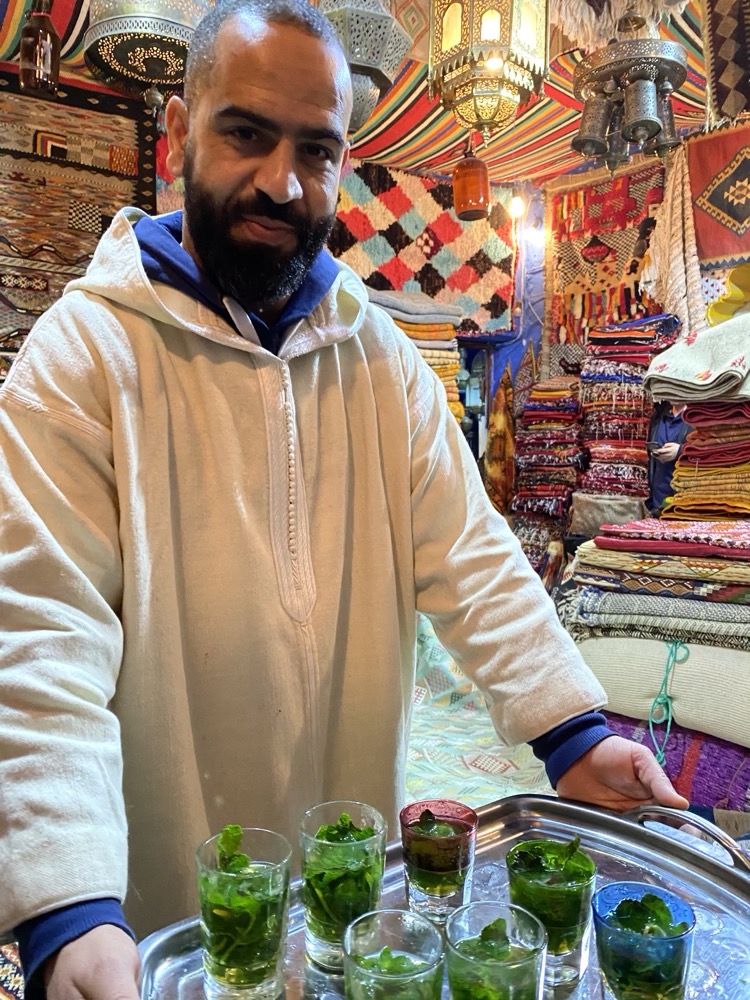 The group waiting for the rugs to start falling.
The group waiting for the rugs to start falling.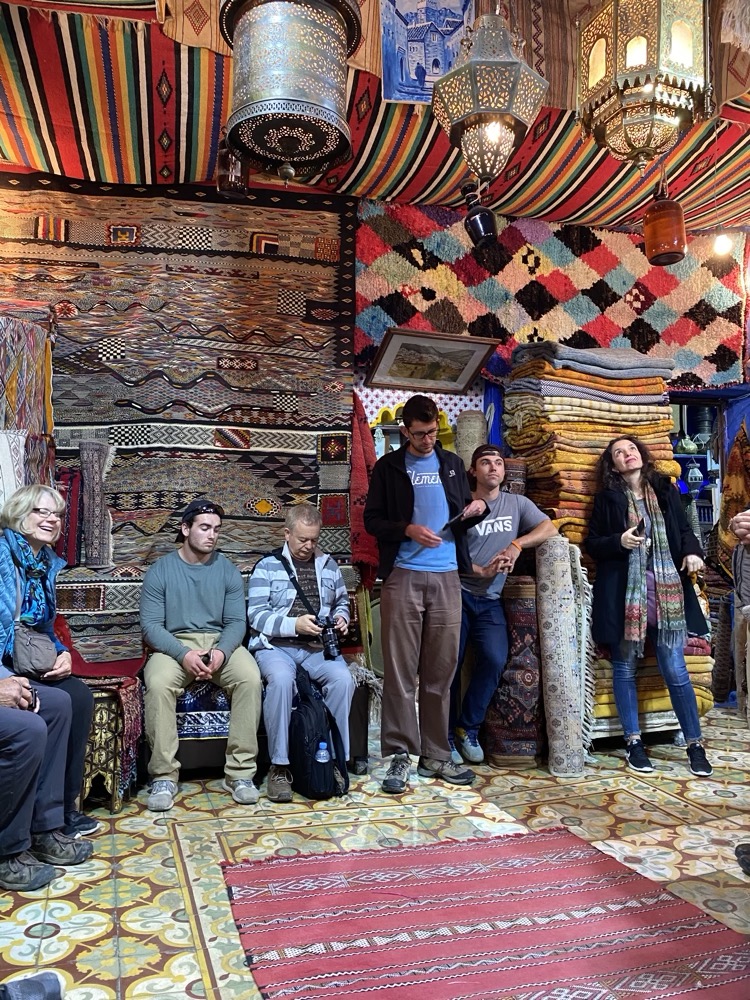
 And so they did… Abdullah*, threw down about fifty rugs in total, all of them locally made by Berber tribes, and in a wide variety of colours and sizes. These rugs are unlike any I’ve seen before, predominantly kilim style and most of them asymmetrical in design – which makes me twitch like all giddyup. So I was pretty safe from any unplanned rug purchases.
And so they did… Abdullah*, threw down about fifty rugs in total, all of them locally made by Berber tribes, and in a wide variety of colours and sizes. These rugs are unlike any I’ve seen before, predominantly kilim style and most of them asymmetrical in design – which makes me twitch like all giddyup. So I was pretty safe from any unplanned rug purchases.
(*We were fairly confident that Abdullah was stoned off his gourd which was vaguely amusing.)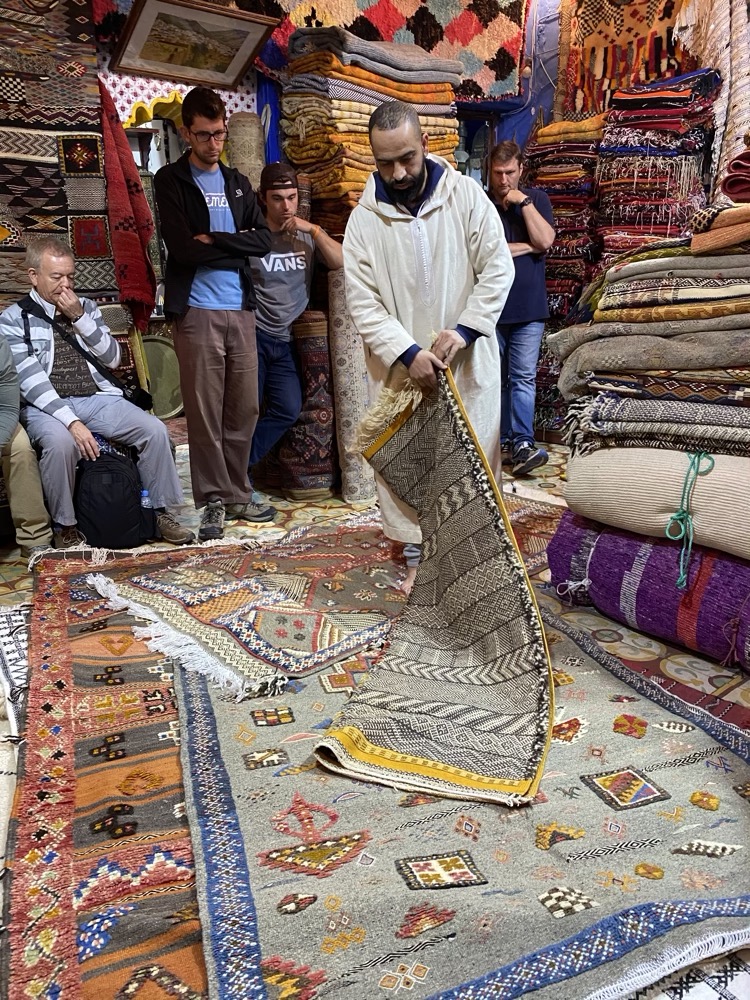 Anyway after our rug shopping experience, where no one found anything they liked, we went to a restaurnt called, Restaurant Bab Ssour, for a lovely rooftop dining and some delicious local tagine dishes.
Anyway after our rug shopping experience, where no one found anything they liked, we went to a restaurnt called, Restaurant Bab Ssour, for a lovely rooftop dining and some delicious local tagine dishes. 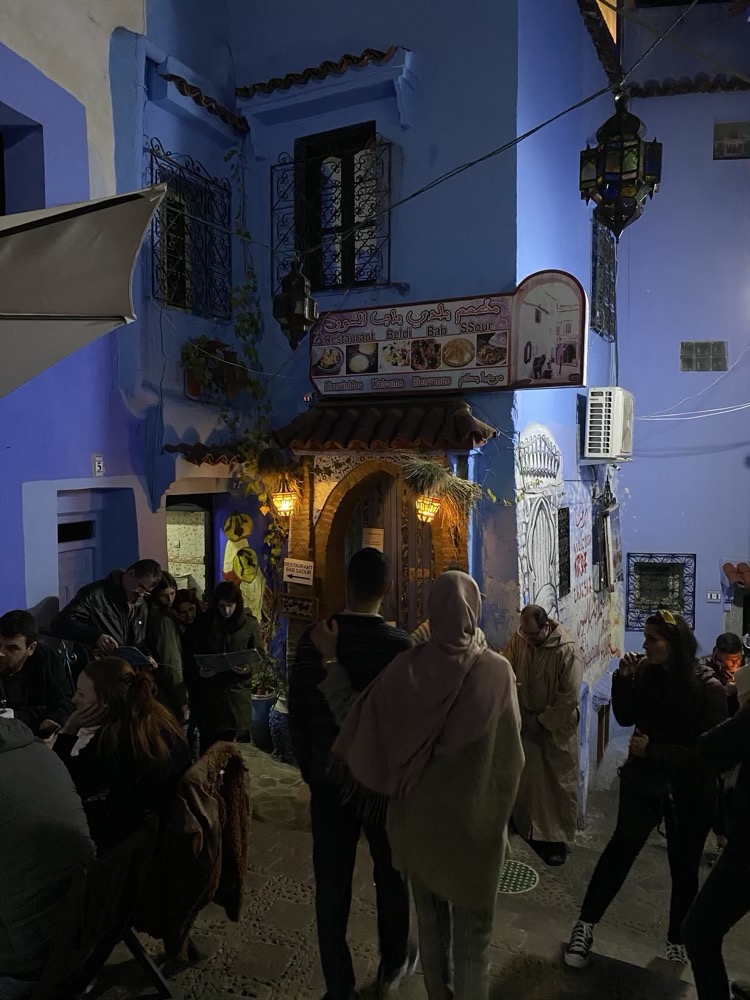 The view across the medina from the rooftop terrace.
The view across the medina from the rooftop terrace.
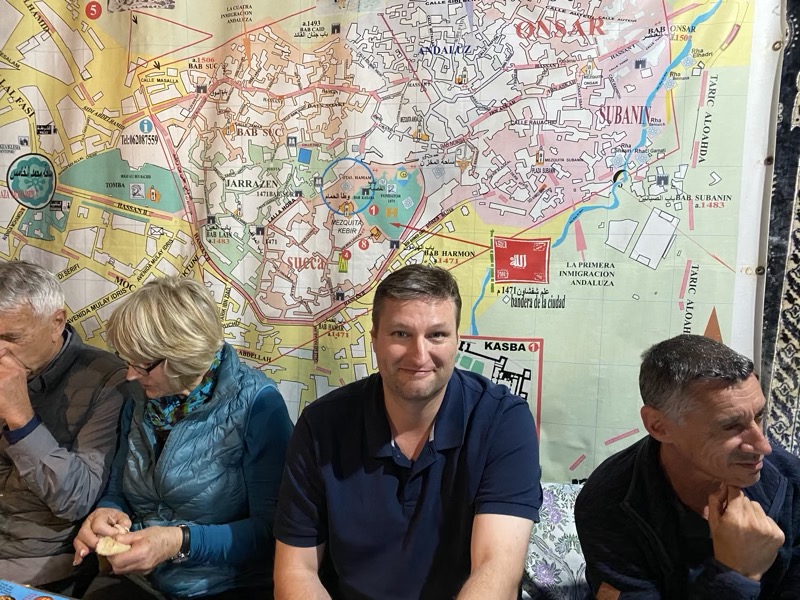 Goat cheese is a speciality local dish, served with balsamic. It was really good and had a smooth creamy texture.
Goat cheese is a speciality local dish, served with balsamic. It was really good and had a smooth creamy texture.
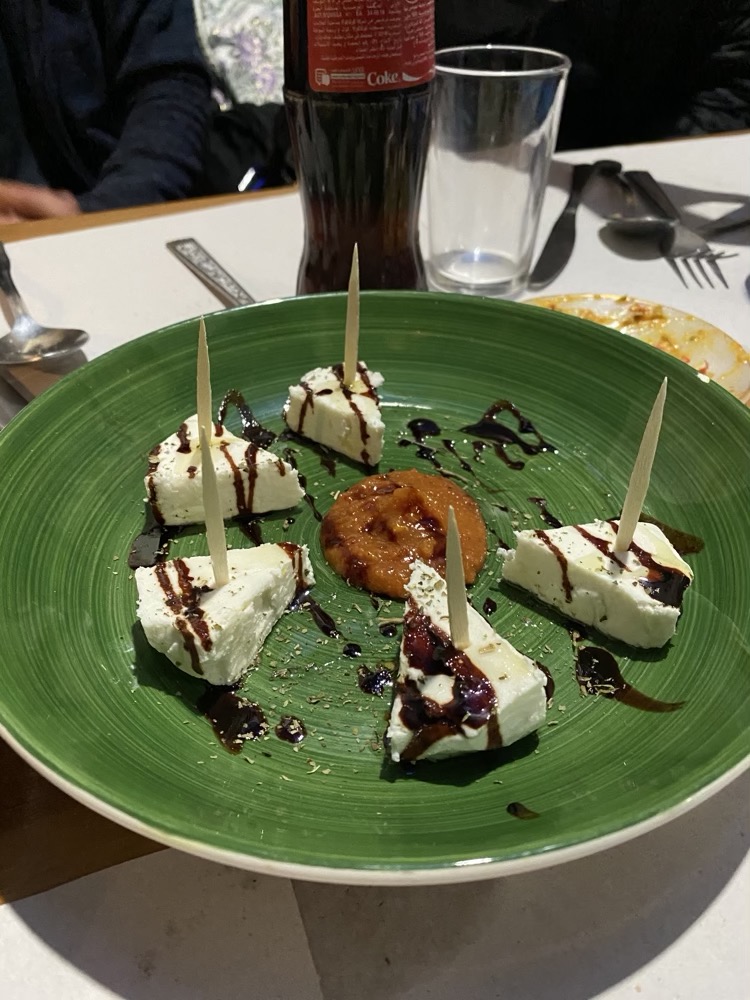 Goat tagine with plums! The meat was just falling off the bone and absolutely delicious.
Goat tagine with plums! The meat was just falling off the bone and absolutely delicious.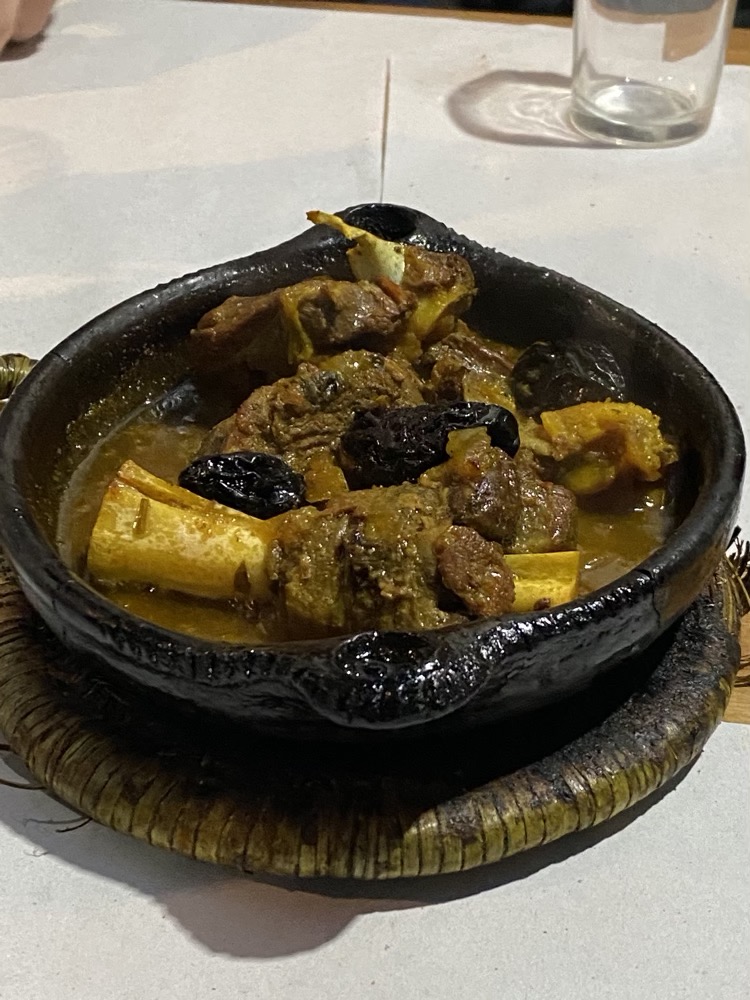
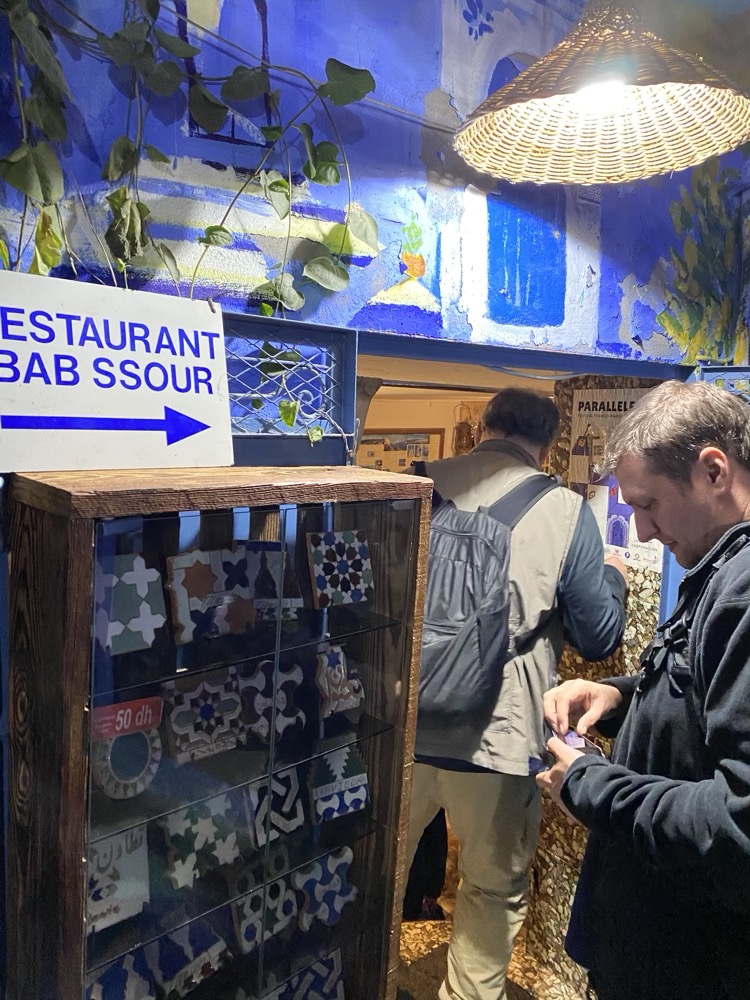 After our long day of driving followed by what was supposed to be a short orientation walk (6kms), we head back to the hotel for a vodka tonic and crashed in our big luxurious bed.
After our long day of driving followed by what was supposed to be a short orientation walk (6kms), we head back to the hotel for a vodka tonic and crashed in our big luxurious bed.

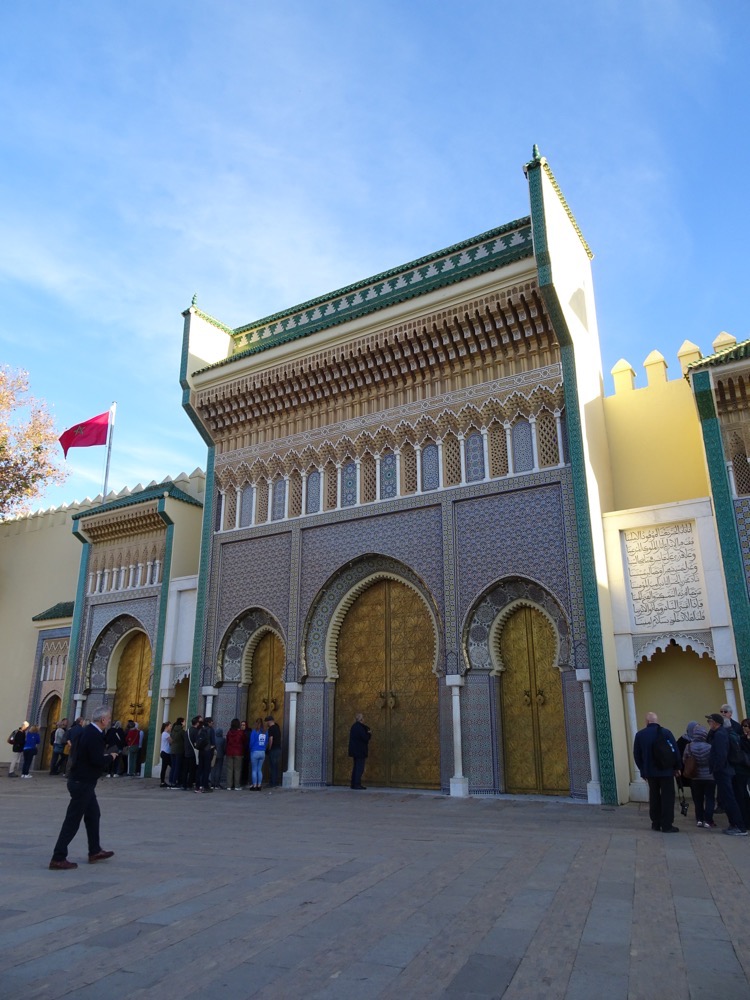 The royal palace is a popular tourist stop for its enormous ornate bronze doors in gates heavily decorated with zellige tilework and carved cedarwood. The innumerable hours of hand-craftsmanship that goes into making these things is simply phenomenal.
The royal palace is a popular tourist stop for its enormous ornate bronze doors in gates heavily decorated with zellige tilework and carved cedarwood. The innumerable hours of hand-craftsmanship that goes into making these things is simply phenomenal.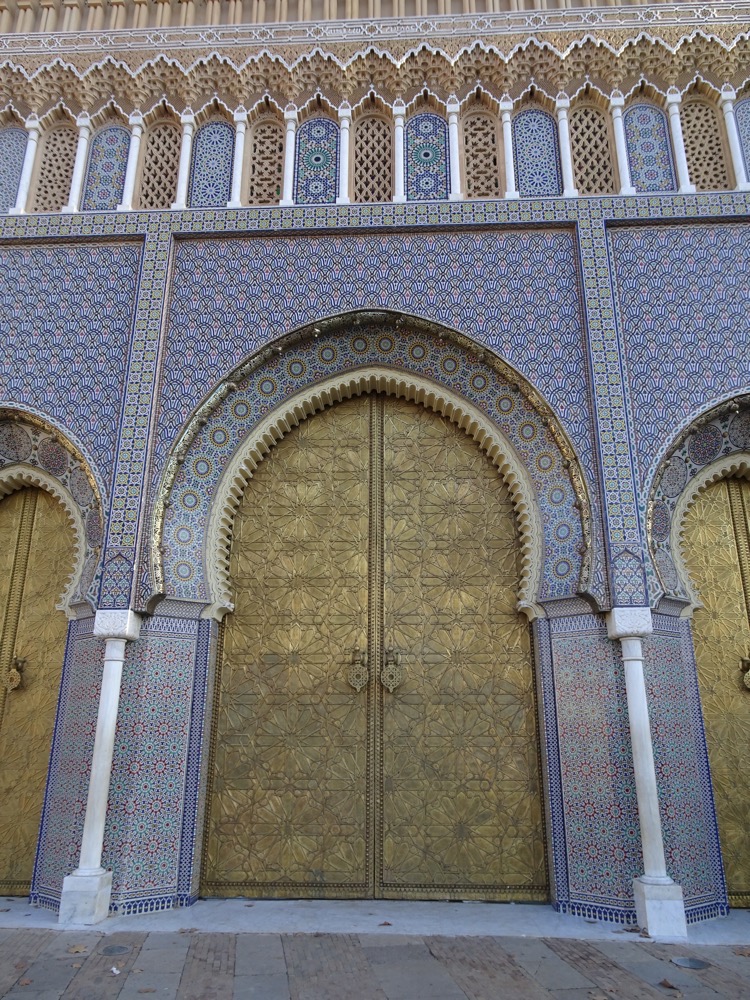
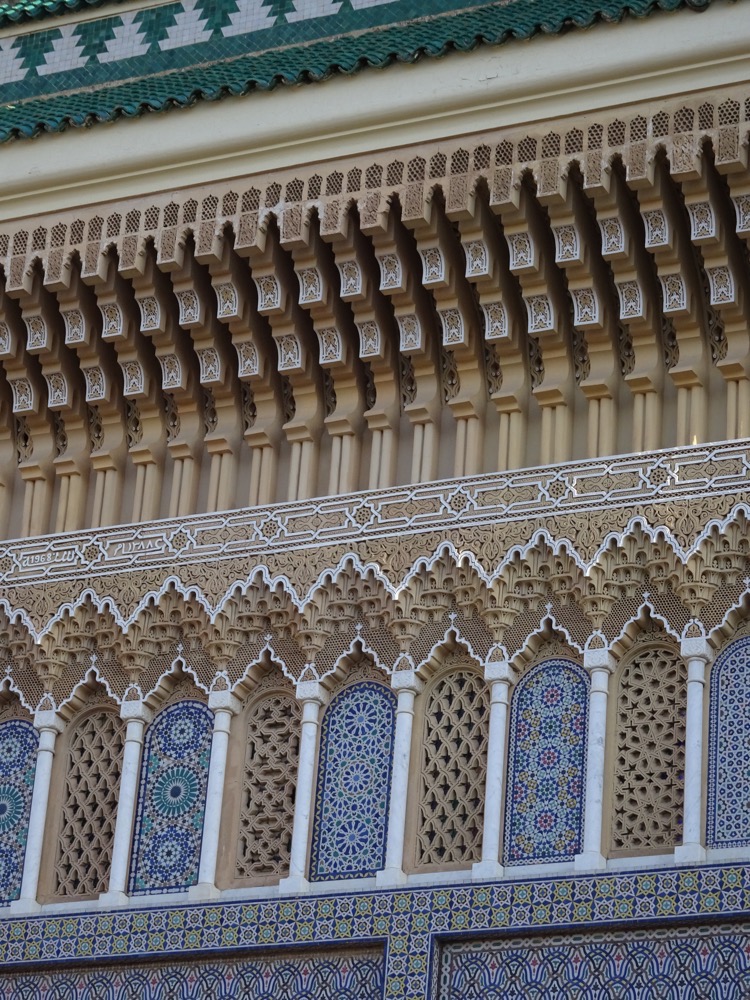
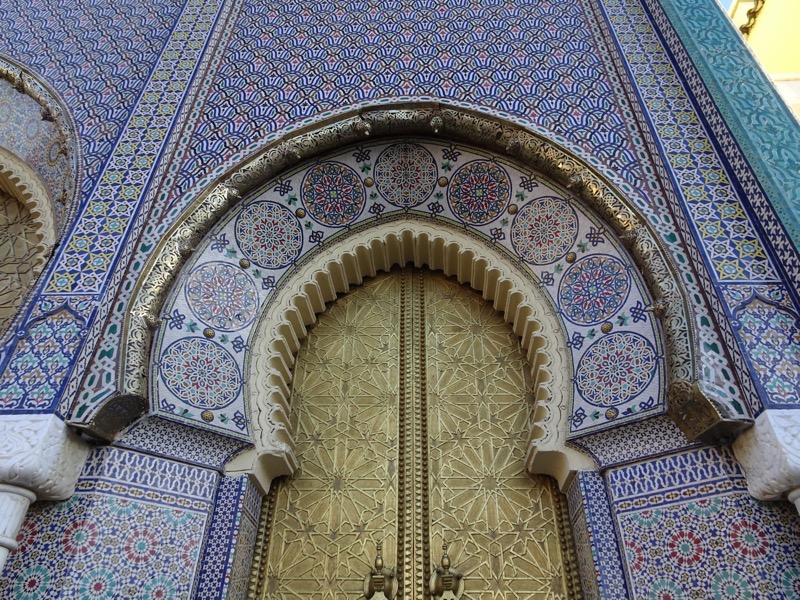
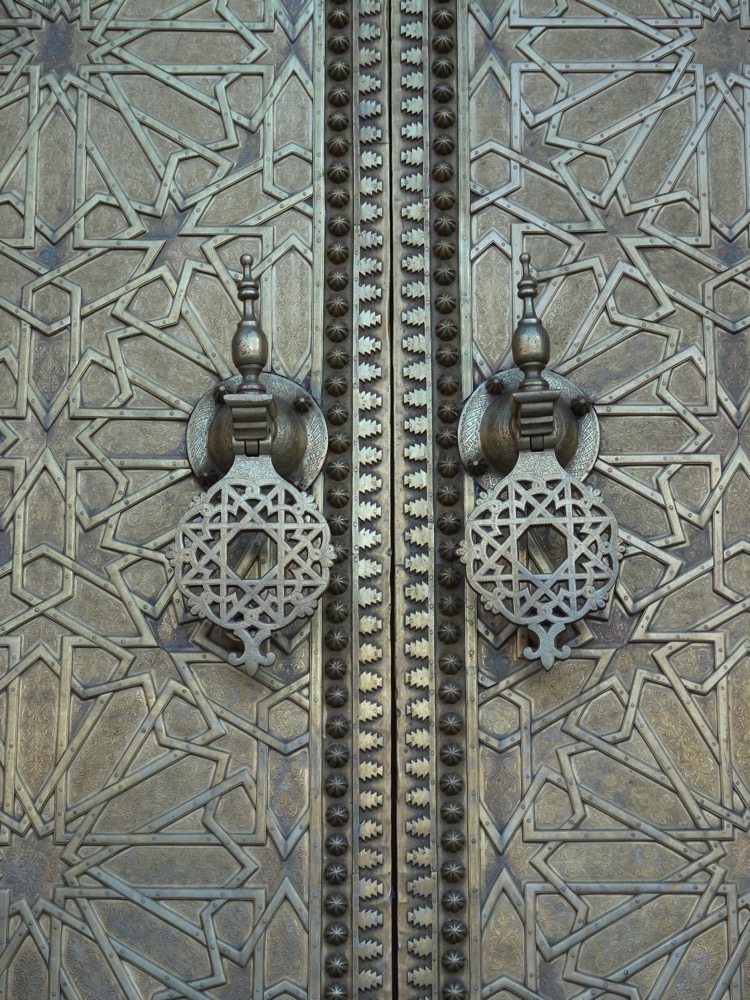 Zellige is mosaic tilework technique that is achieved by taking individually chiselled geometric tiles and then setting them into a plaster base (for certain purposes, like small fountains, they use fibreglass to set them into place. It’s a really popular and prevalent form of Islamic art that we’ve seen replicated on a lot of Moroccan architecture. The geometric patterns are really appealing and you see them on walls, ceilings, fountains, floors, pools and tables.
Zellige is mosaic tilework technique that is achieved by taking individually chiselled geometric tiles and then setting them into a plaster base (for certain purposes, like small fountains, they use fibreglass to set them into place. It’s a really popular and prevalent form of Islamic art that we’ve seen replicated on a lot of Moroccan architecture. The geometric patterns are really appealing and you see them on walls, ceilings, fountains, floors, pools and tables. 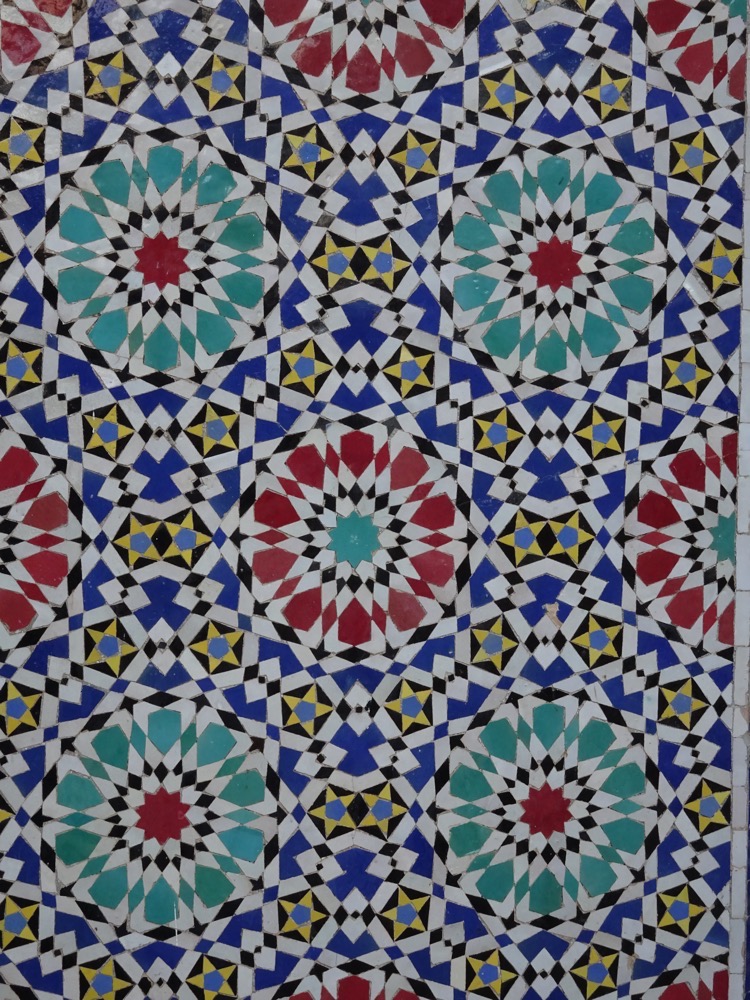
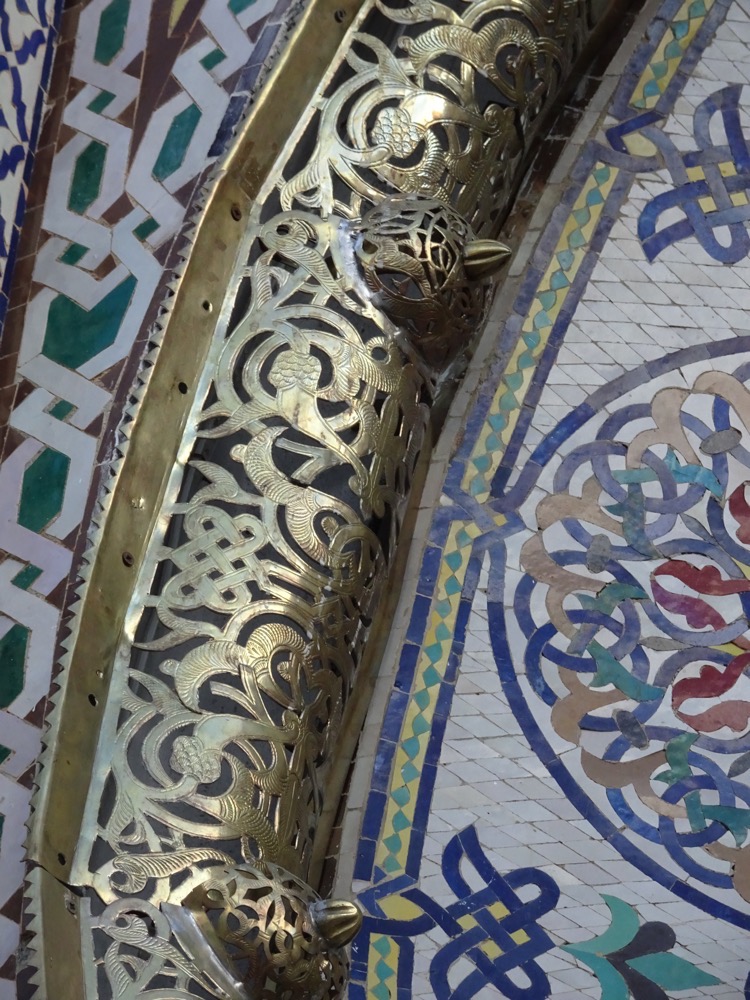 Off to the left of this main gate is a small ‘servants entrance’… frankly, they probably deserve to use the main entrance seeing they come and go way more than the King!
Off to the left of this main gate is a small ‘servants entrance’… frankly, they probably deserve to use the main entrance seeing they come and go way more than the King!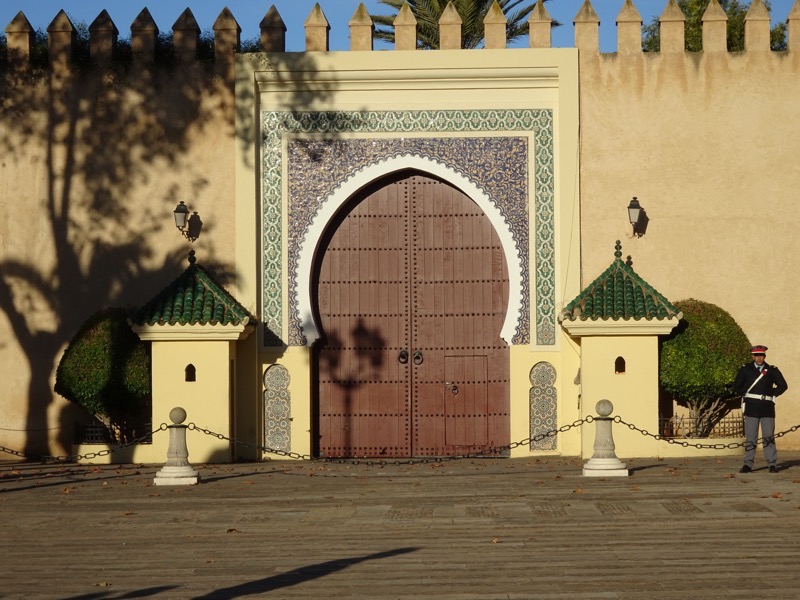
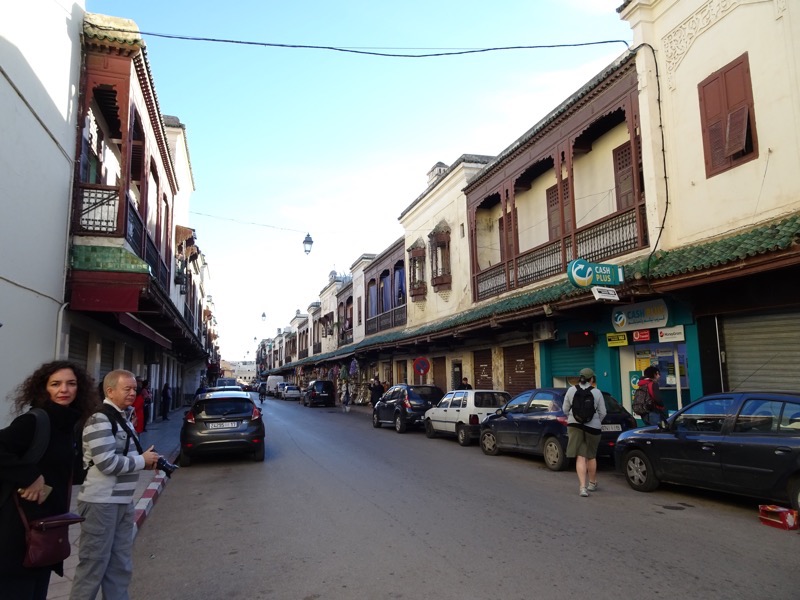
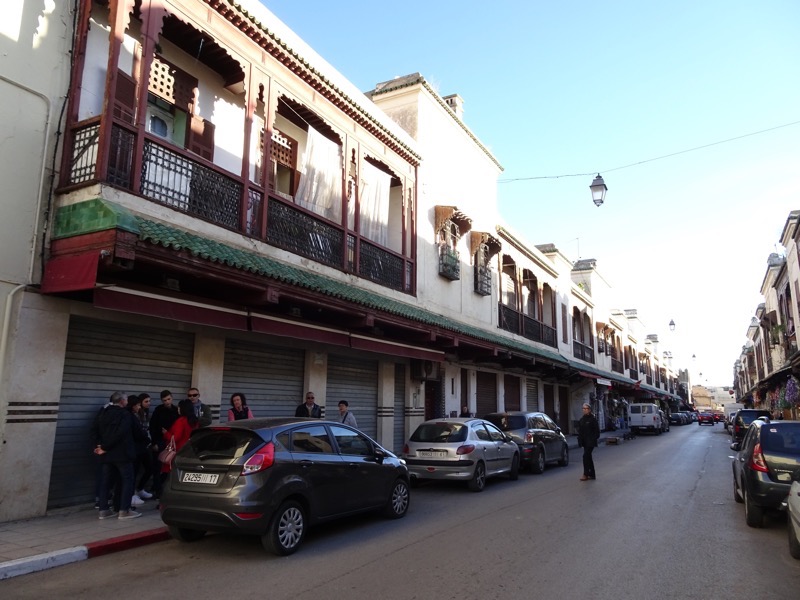
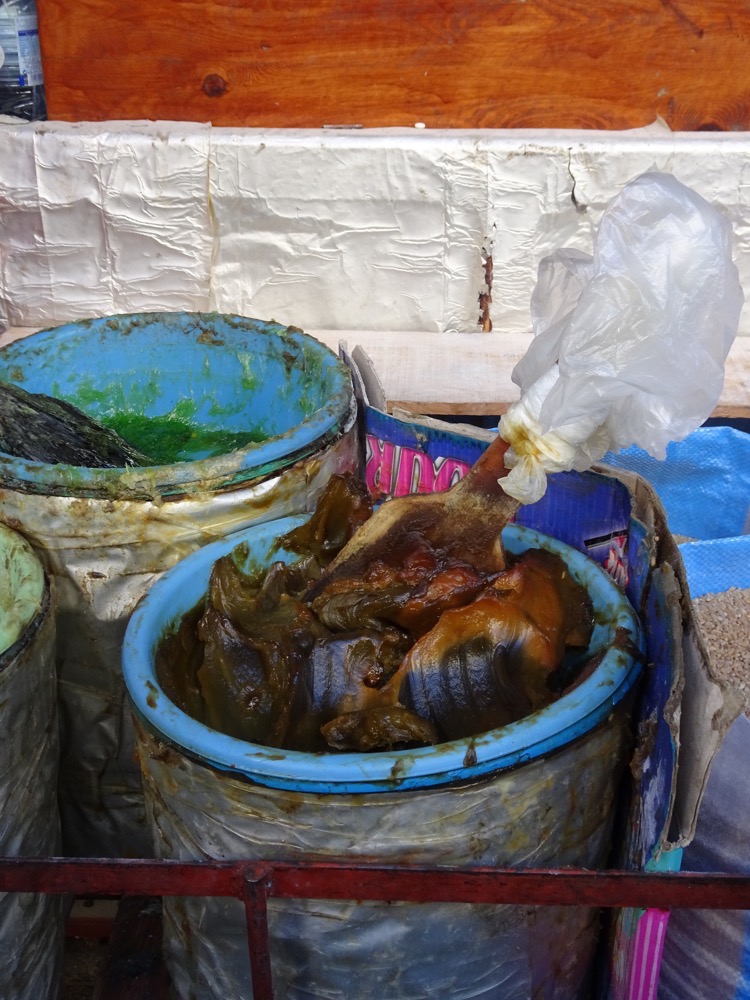
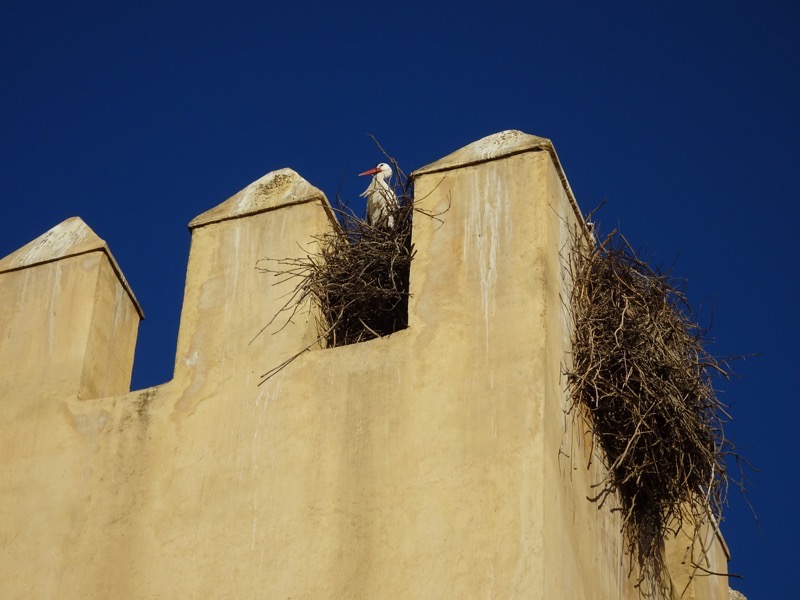 After a quick wander through the Jewish Quarter, we took a drive out to a lookout to have a look at the city of Fez. Fez is Morocco’s second largest city, behind Casablanca, with 1.4million peoples. It is largely locaed in a valley surrounded by the high grounds, and the old city or the Medina is divided by the River Fez which runs through the 9thC walled part of the city.
After a quick wander through the Jewish Quarter, we took a drive out to a lookout to have a look at the city of Fez. Fez is Morocco’s second largest city, behind Casablanca, with 1.4million peoples. It is largely locaed in a valley surrounded by the high grounds, and the old city or the Medina is divided by the River Fez which runs through the 9thC walled part of the city.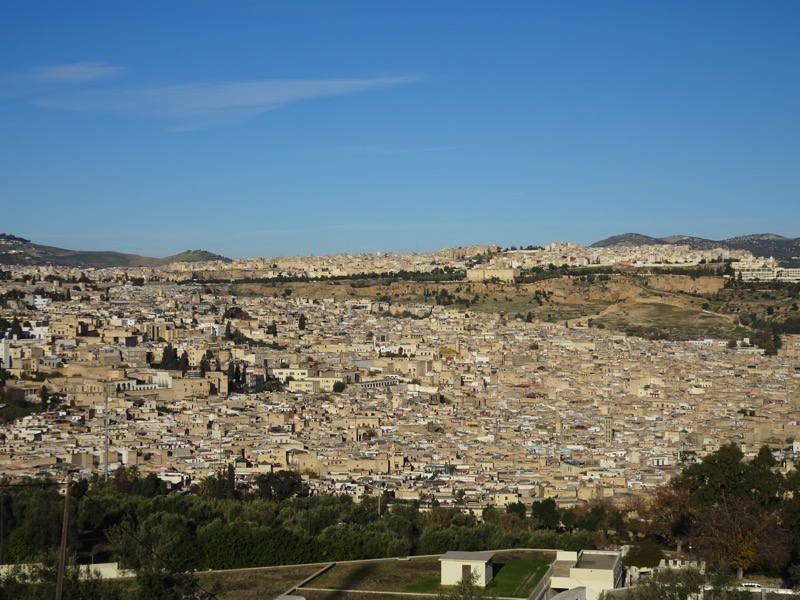 These pictures show how closely packed the Fez Medina is – it is believed to be the largest pedestrian zone in the world. Not a single vehicle can enter the medina as it is a completely bamboozling labyrinth of winding alleyways some of which are barely 70cm wide. Donkeys, mules and horses are the only form of transport in the medina and everything is transported in via animal or hand cart.
These pictures show how closely packed the Fez Medina is – it is believed to be the largest pedestrian zone in the world. Not a single vehicle can enter the medina as it is a completely bamboozling labyrinth of winding alleyways some of which are barely 70cm wide. Donkeys, mules and horses are the only form of transport in the medina and everything is transported in via animal or hand cart.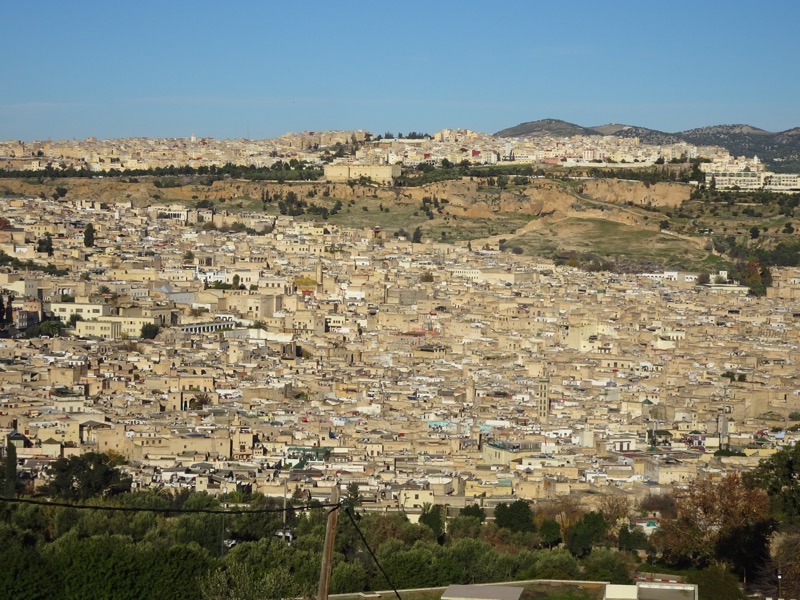 Walls of the Fez Medina…the holes in the walls are desinged to allow the high wind to pass through the walls rather than causing damage. Apparently the wind here gets so bad it can ‘knock over’ wall like this…
Walls of the Fez Medina…the holes in the walls are desinged to allow the high wind to pass through the walls rather than causing damage. Apparently the wind here gets so bad it can ‘knock over’ wall like this…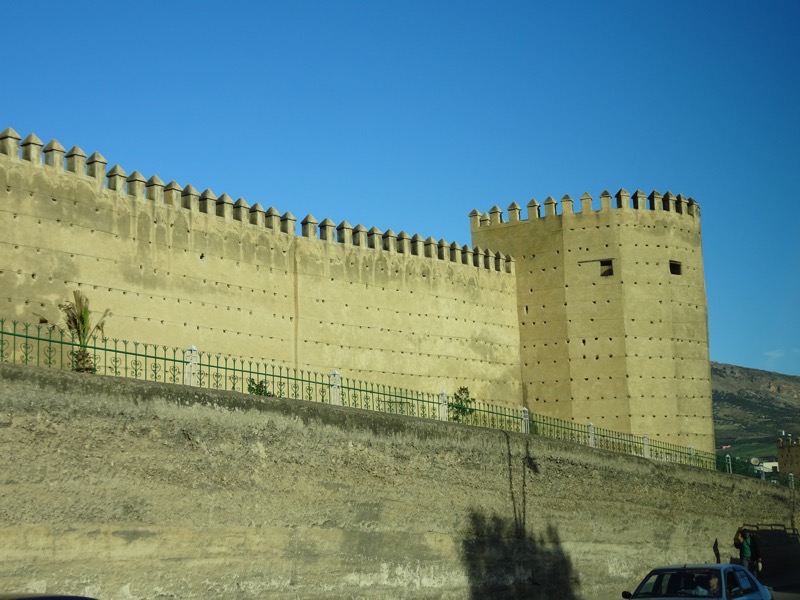 Before we threw caution to the aforemented wind and ventured into the Medina, we took a stop at a local mosaic and ceramic factory. Pictoral mosaics like the one below are not particularly common. Usually you see the traditional geometric, typically Islamic styles of art still being replicated in mosaic work.
Before we threw caution to the aforemented wind and ventured into the Medina, we took a stop at a local mosaic and ceramic factory. Pictoral mosaics like the one below are not particularly common. Usually you see the traditional geometric, typically Islamic styles of art still being replicated in mosaic work.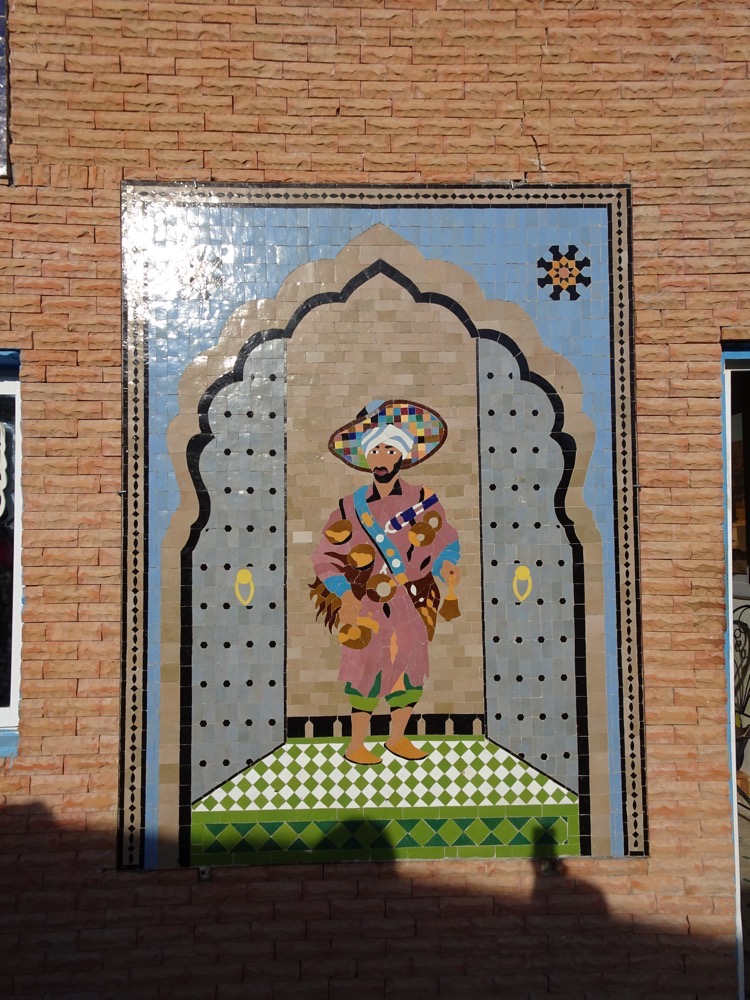 Piles of clay come straight from quarries and have zero purification or cleansing before being put to use.
Piles of clay come straight from quarries and have zero purification or cleansing before being put to use. 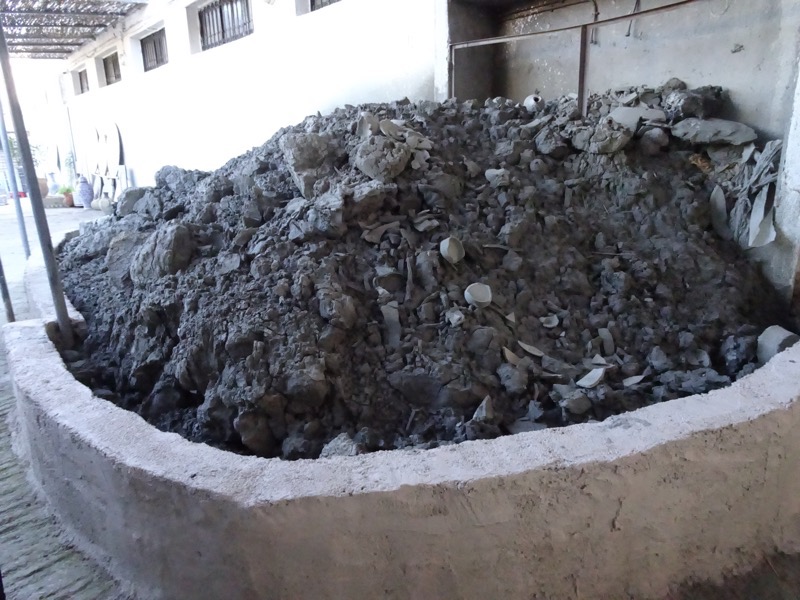
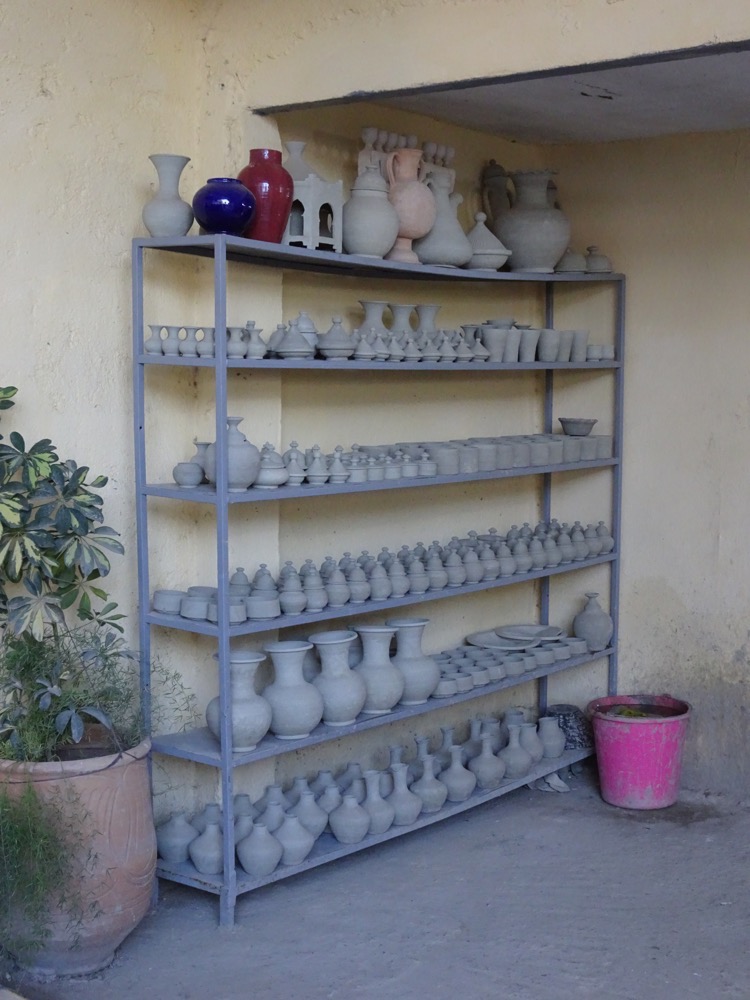
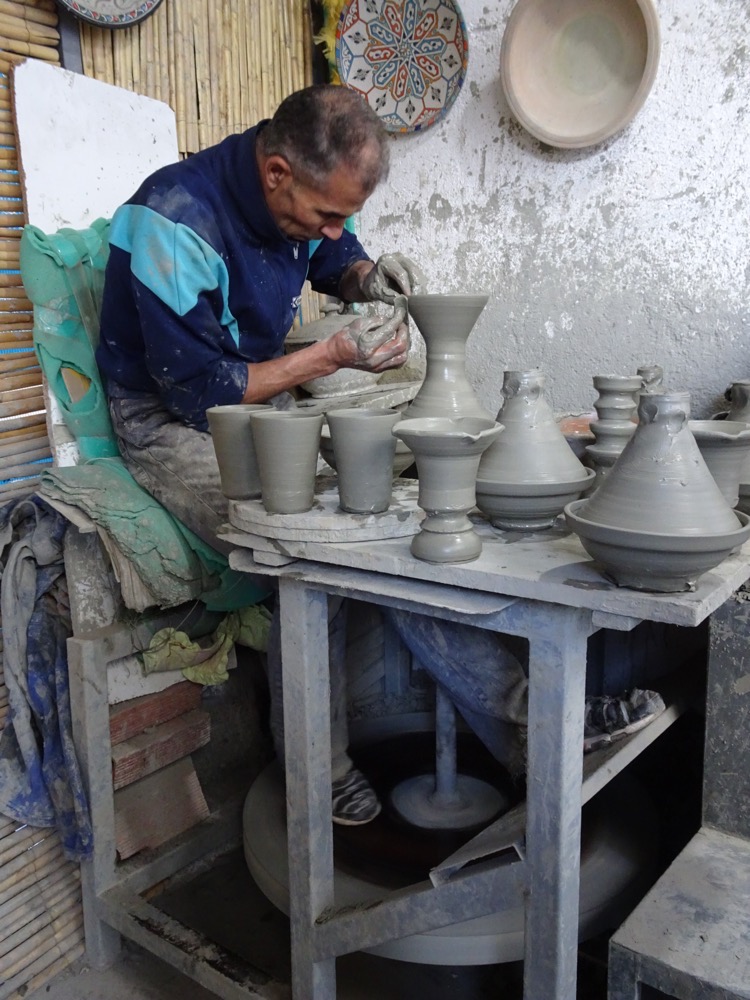 Turned bowls drying before their first firing.
Turned bowls drying before their first firing.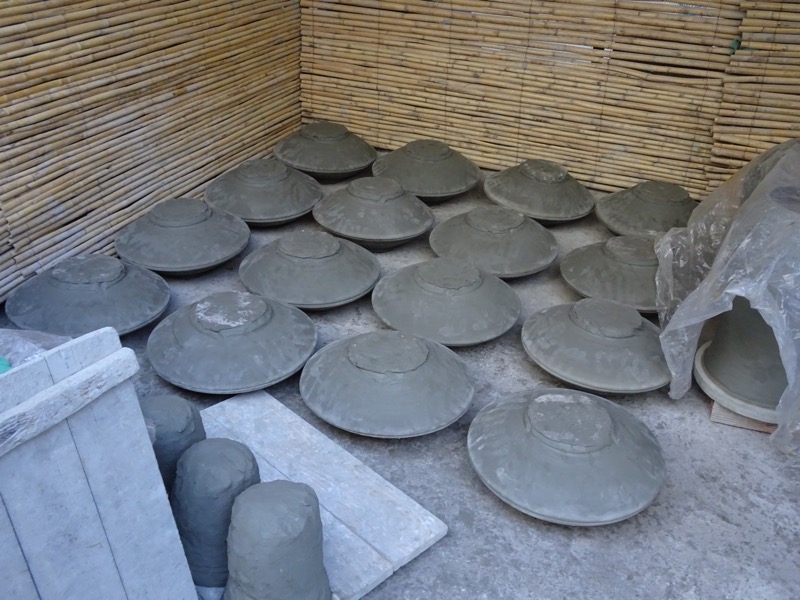 The kilns used are still traditional kilns that have been used for hundreds of years… the ground up dark dirt seen in the front is actually ground up olive pits which are added to the kiln fires. Something to do with the oils being beneficial in the firing process, but I’ll admit the explanation was a bit disjointed.
The kilns used are still traditional kilns that have been used for hundreds of years… the ground up dark dirt seen in the front is actually ground up olive pits which are added to the kiln fires. Something to do with the oils being beneficial in the firing process, but I’ll admit the explanation was a bit disjointed. 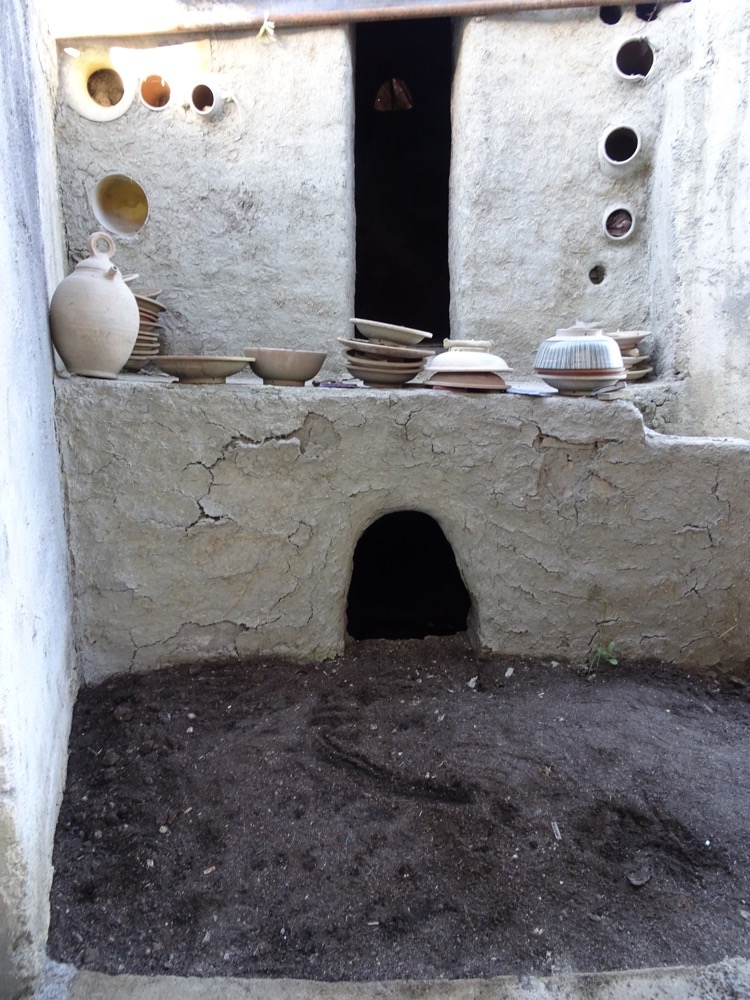 Tile making in action – this guys spends all day making clay squares into more uniform, flat and tapered clay squares. :/
Tile making in action – this guys spends all day making clay squares into more uniform, flat and tapered clay squares. :/ 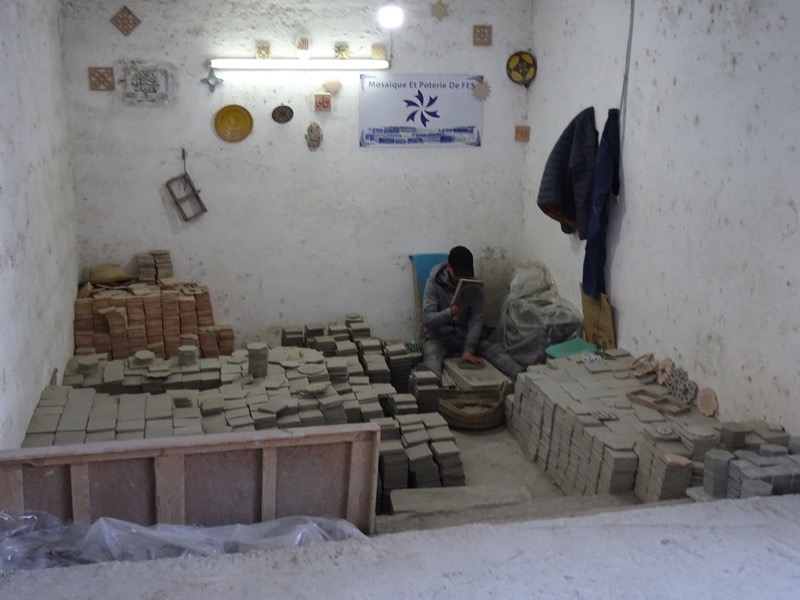
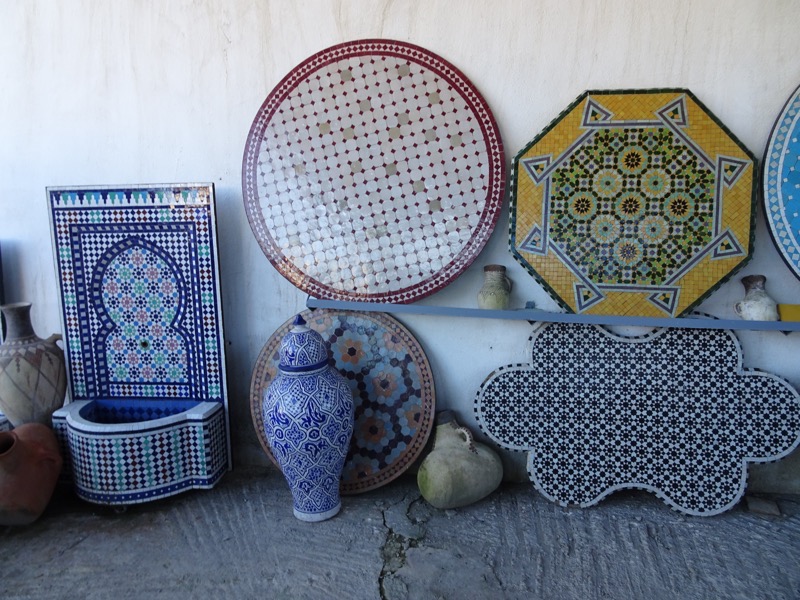 Painting the ceramics with glaze before the second firing.
Painting the ceramics with glaze before the second firing.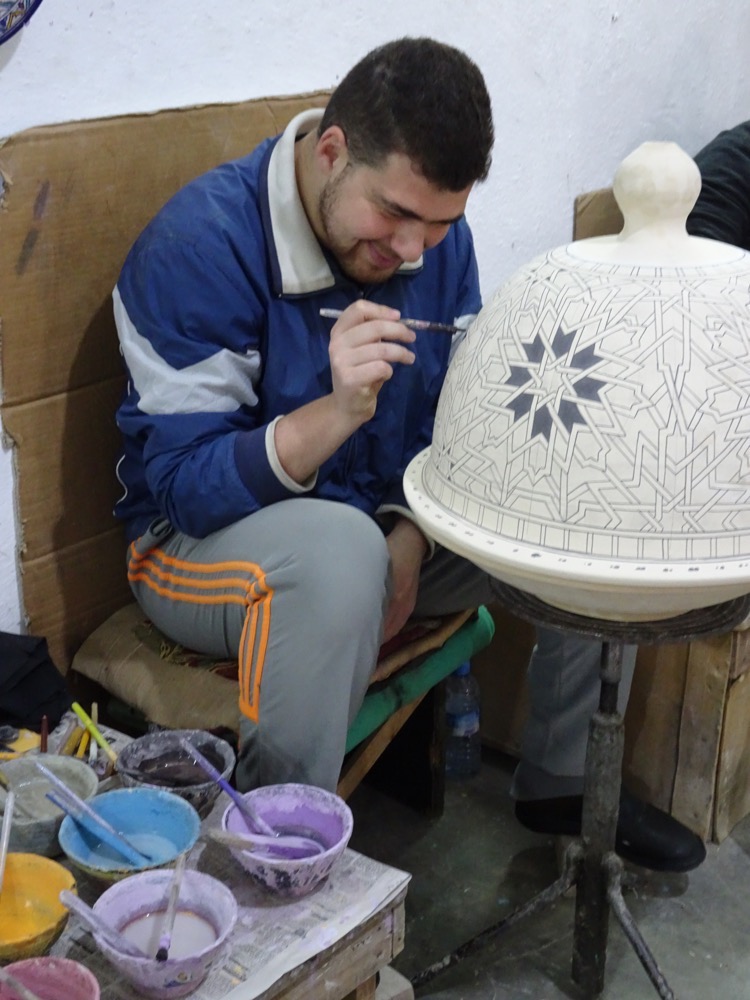 Etching off the glaze before a second glaze is done.
Etching off the glaze before a second glaze is done. 
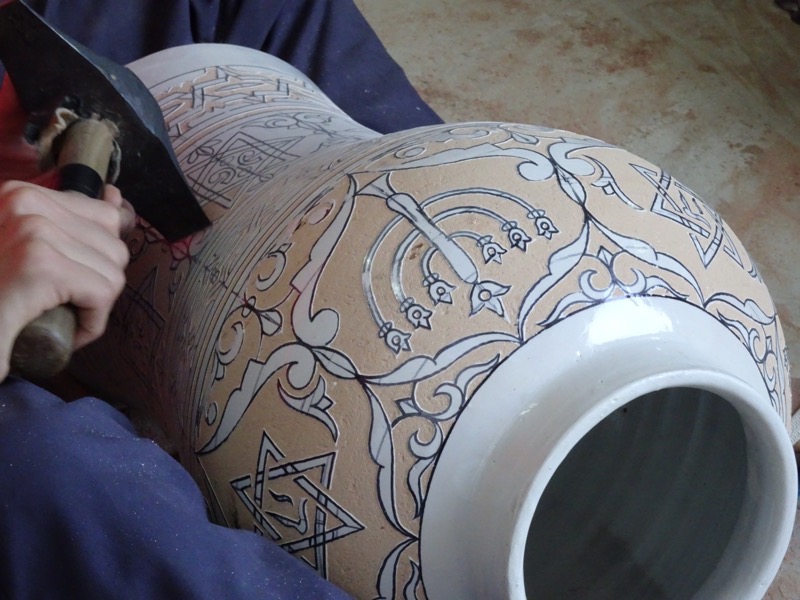
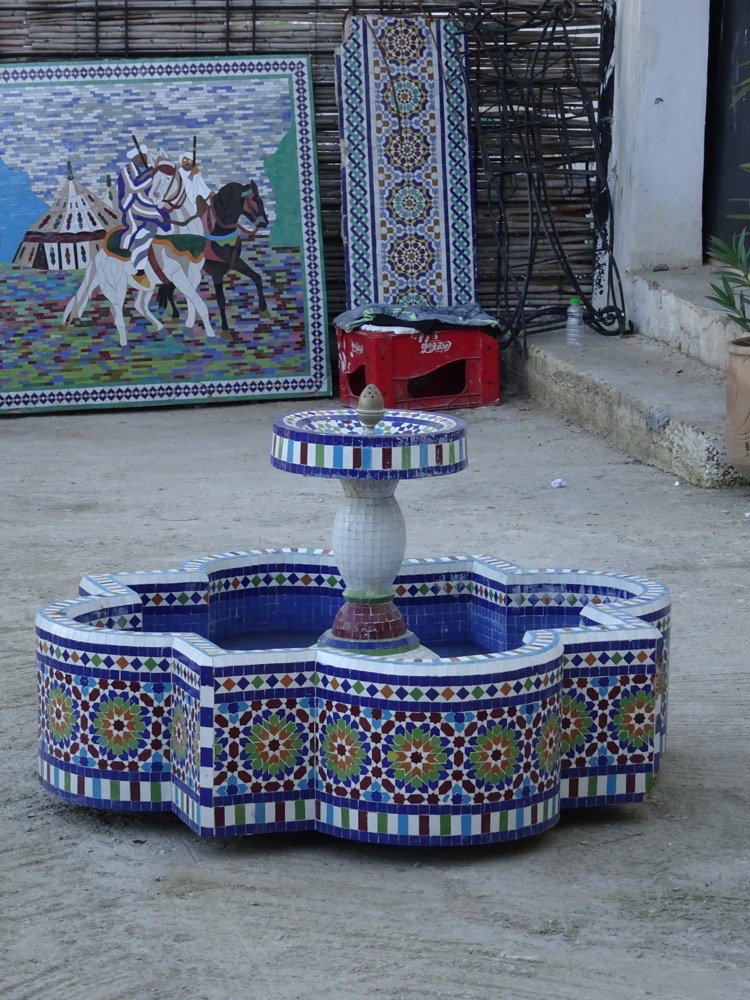
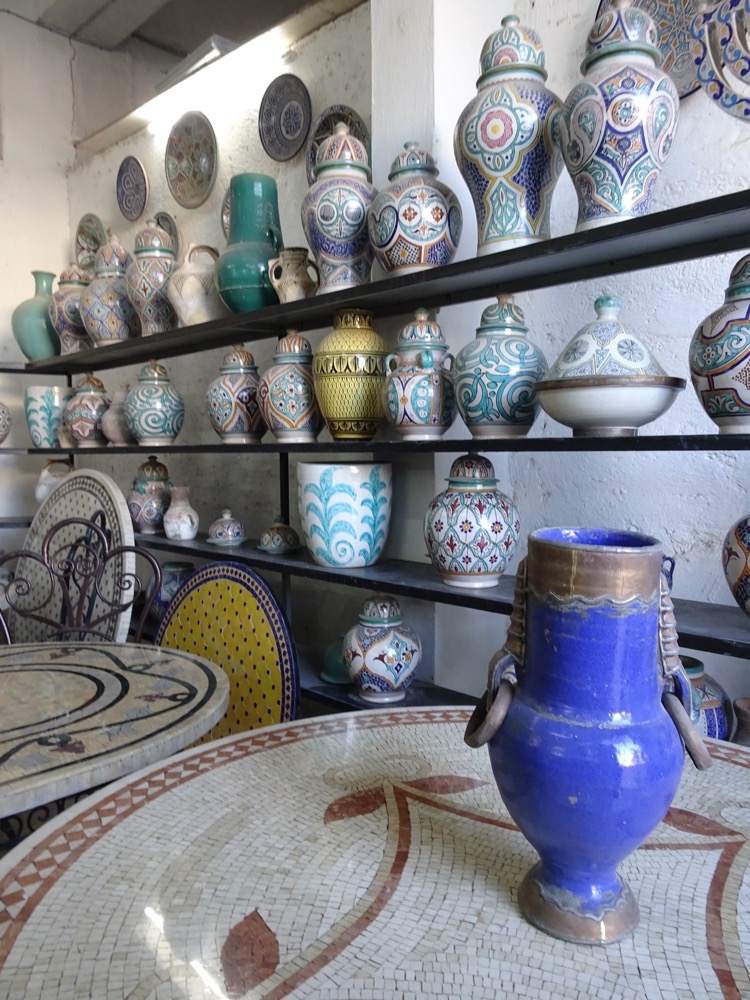 Mosaic work is painstakingly done by hand. From the drawing of the designs onto the nice square tiles the previous guy was making…
Mosaic work is painstakingly done by hand. From the drawing of the designs onto the nice square tiles the previous guy was making…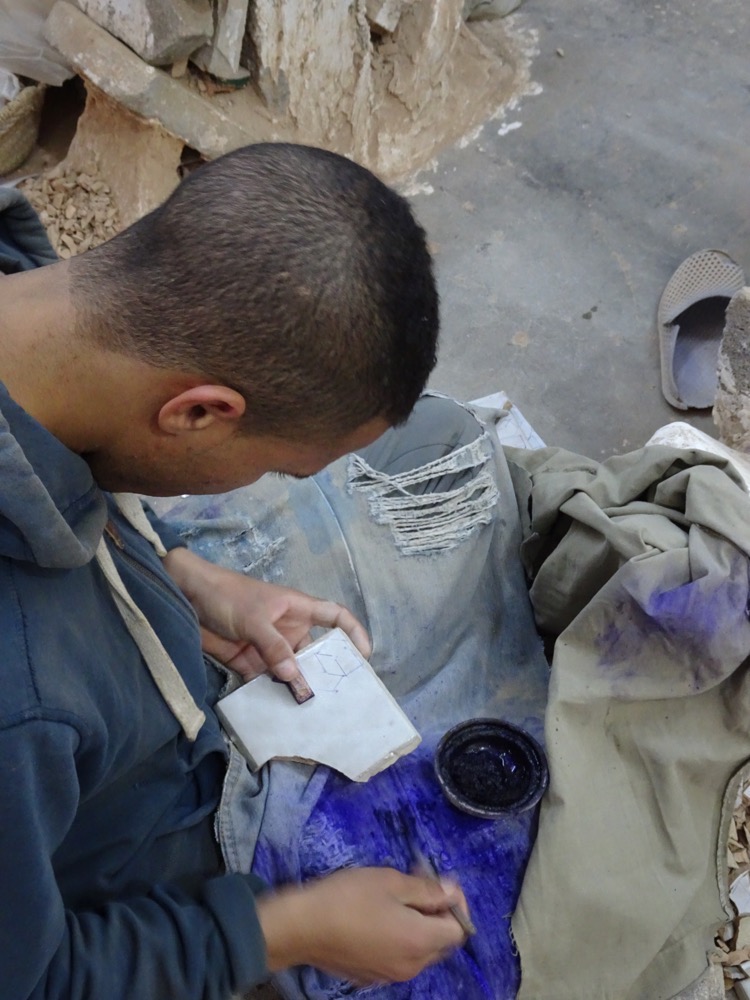
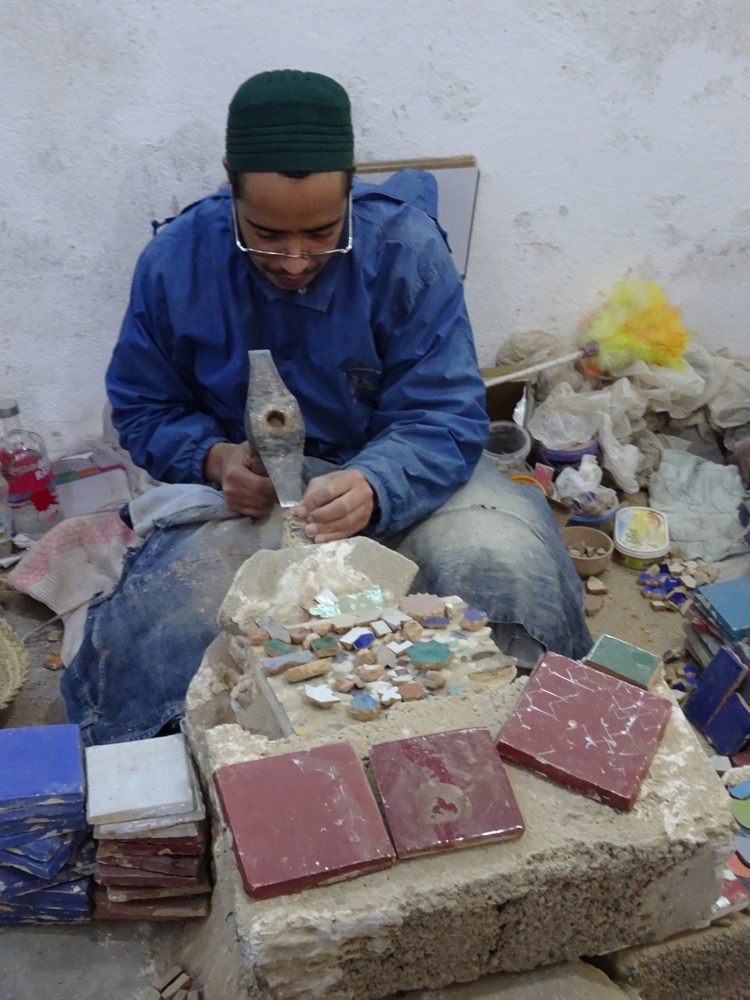 To the laying out of the design – upside down so the plaster can be poured onto the back to hold it together!
To the laying out of the design – upside down so the plaster can be poured onto the back to hold it together!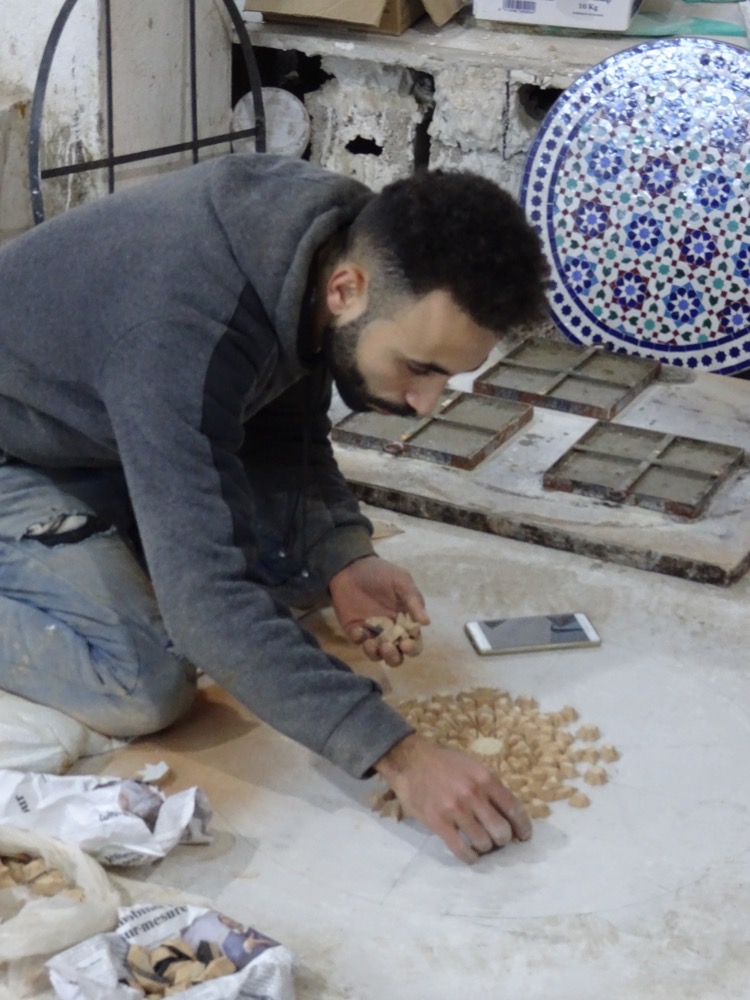 To the final chiselling of the finished product to clean up any irregular edges or overflowed plaster.
To the final chiselling of the finished product to clean up any irregular edges or overflowed plaster.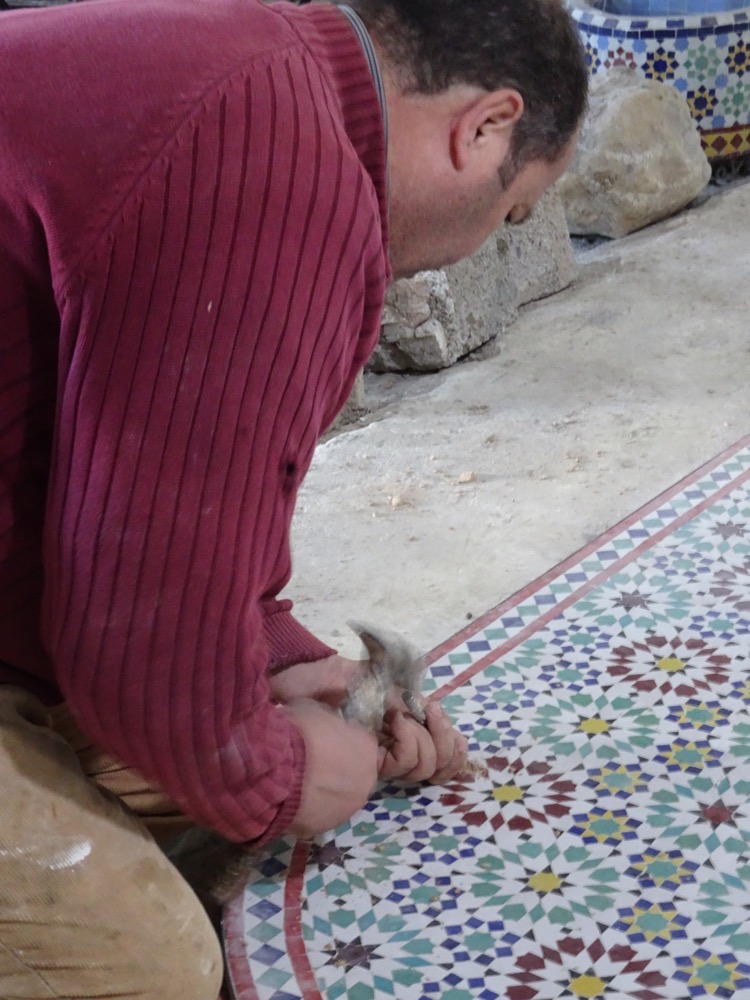 The end results of this meticulous and time consuming work are amazingly beautful artworks.
The end results of this meticulous and time consuming work are amazingly beautful artworks.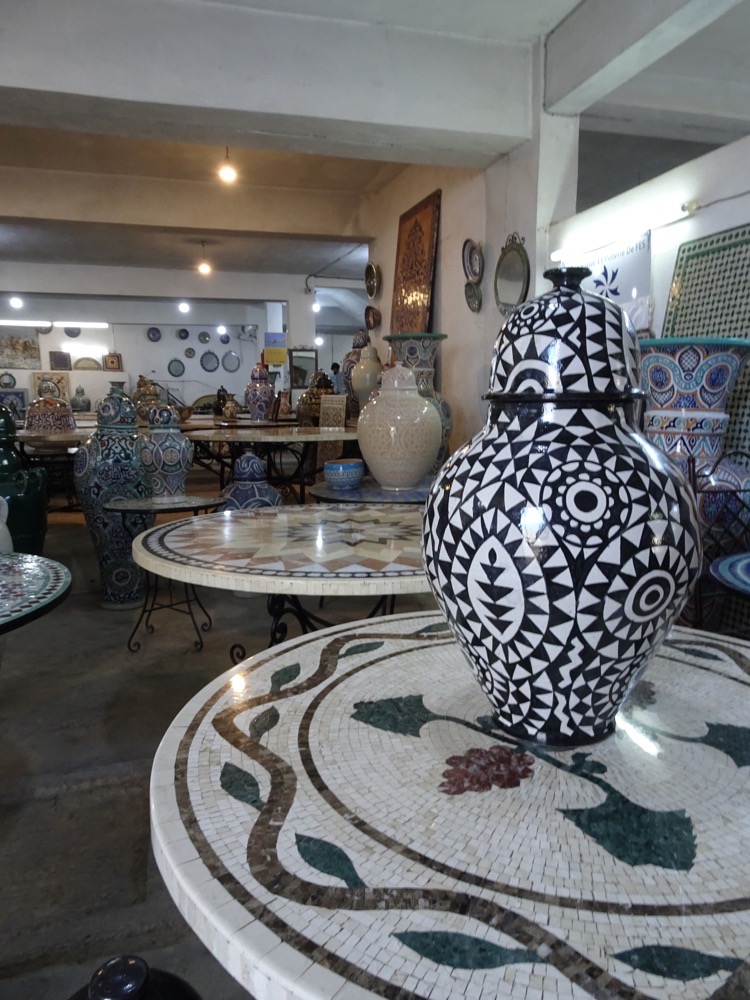
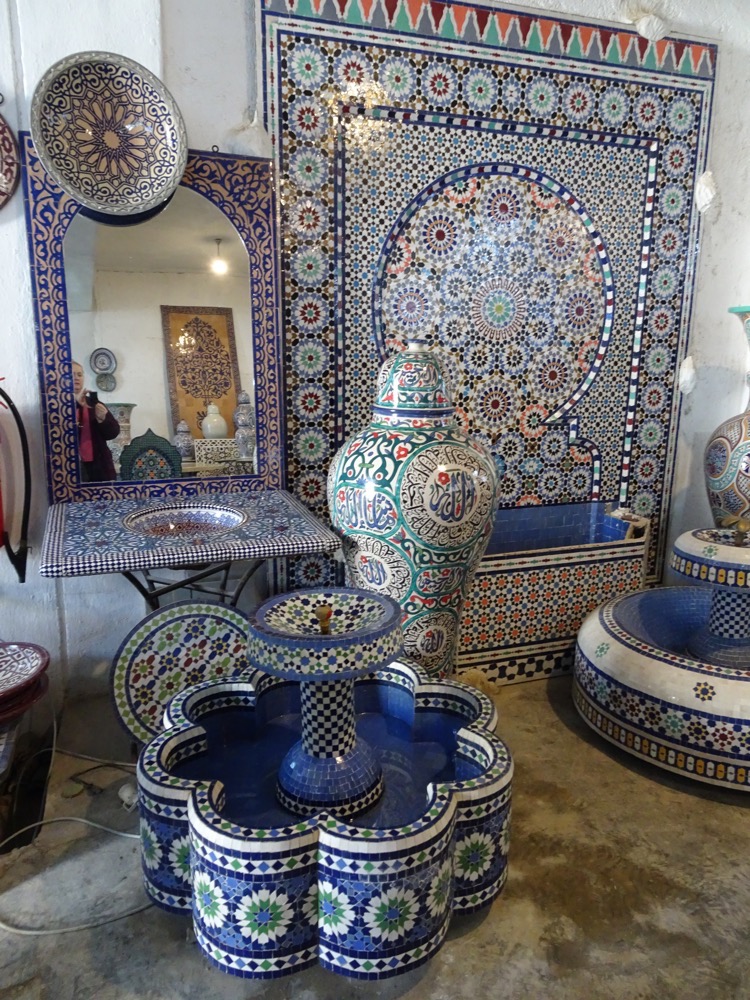
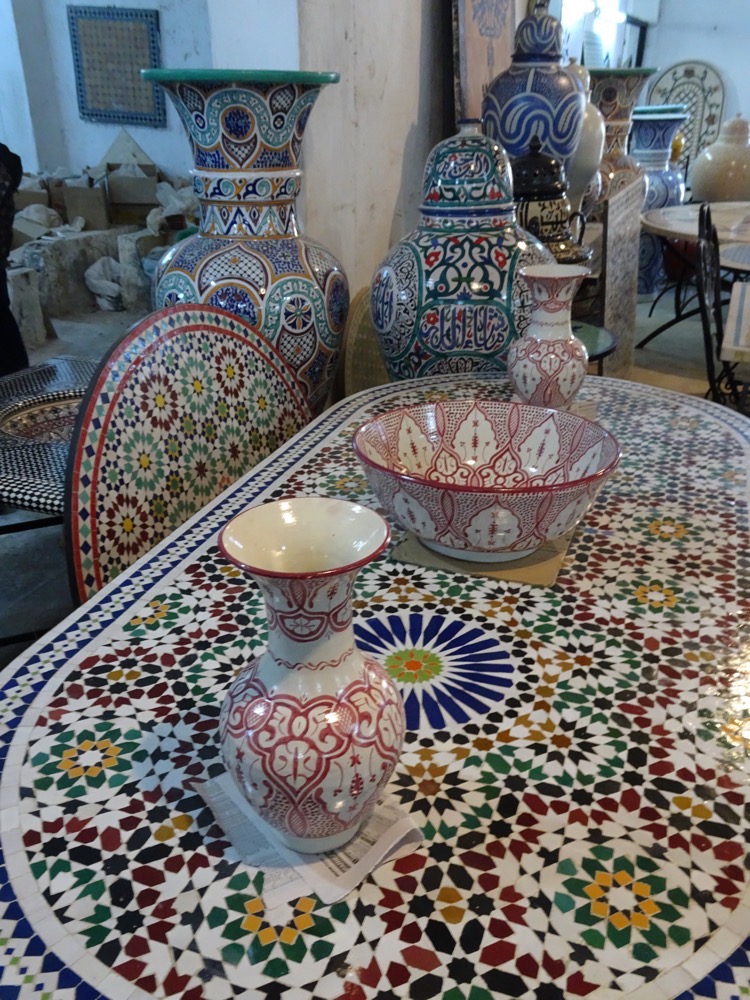
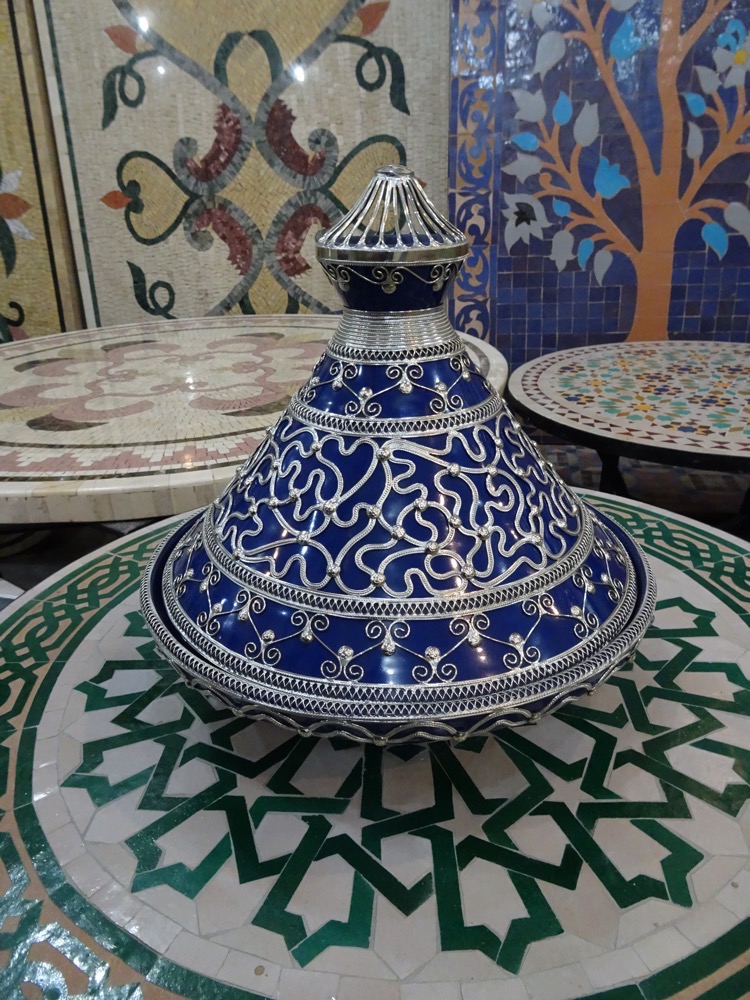
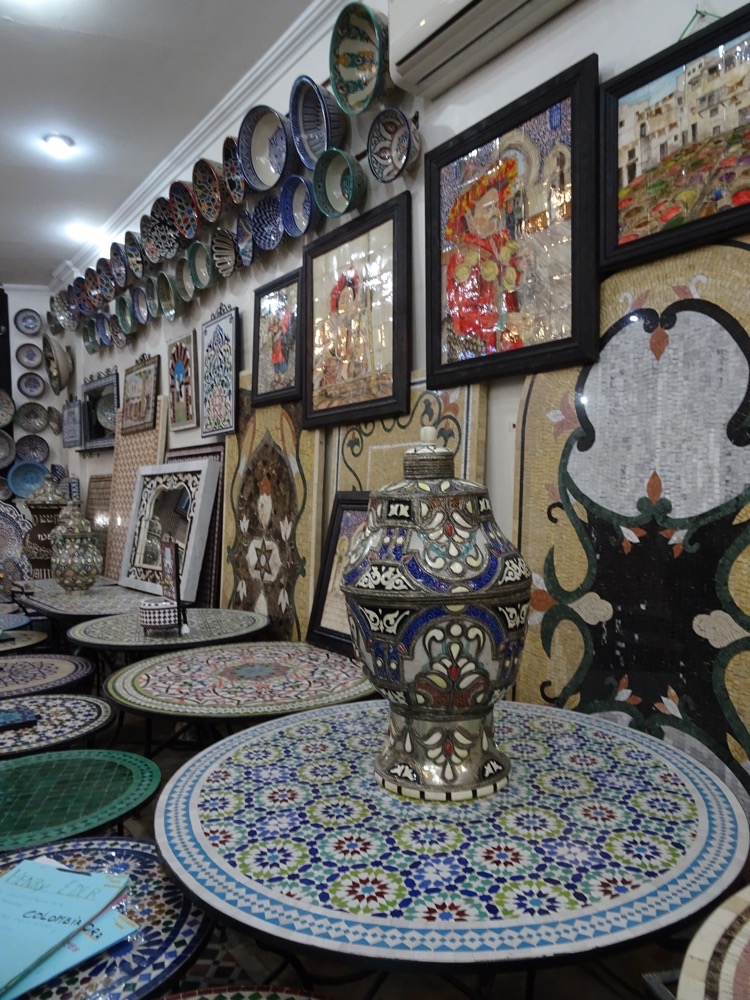
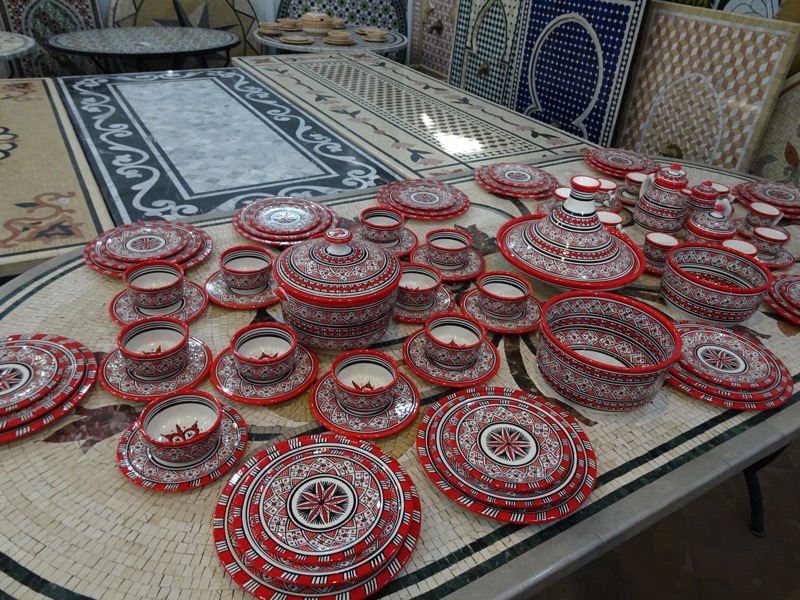
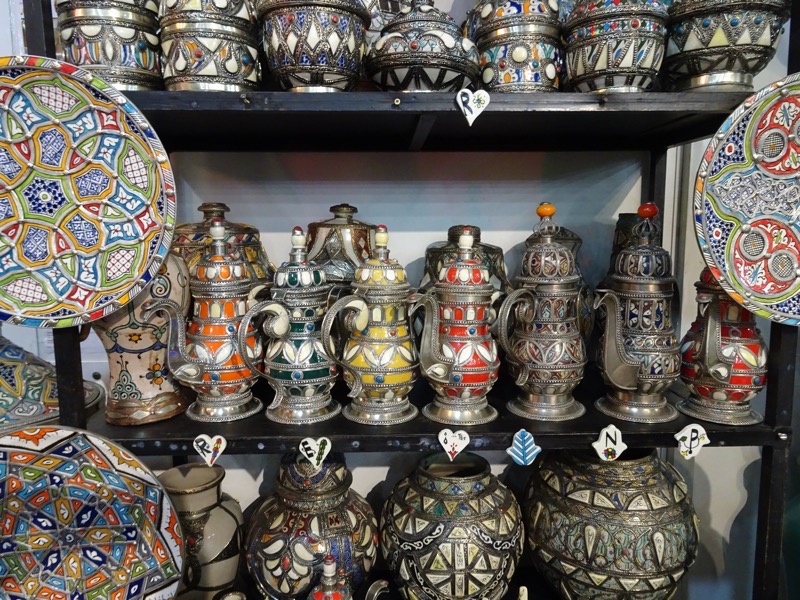
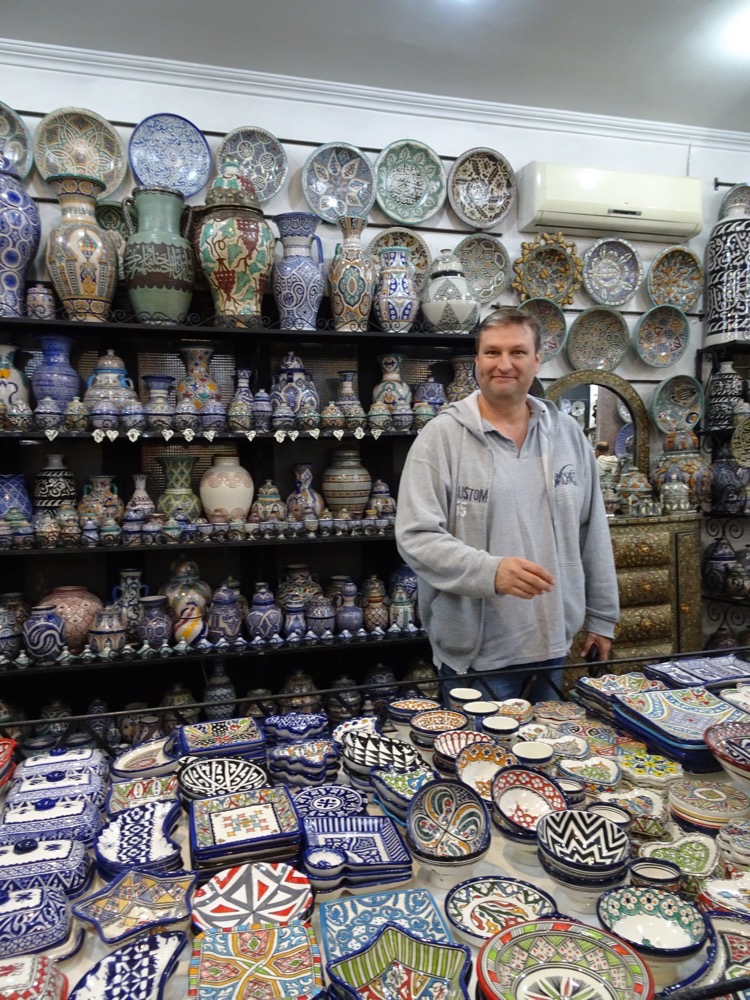
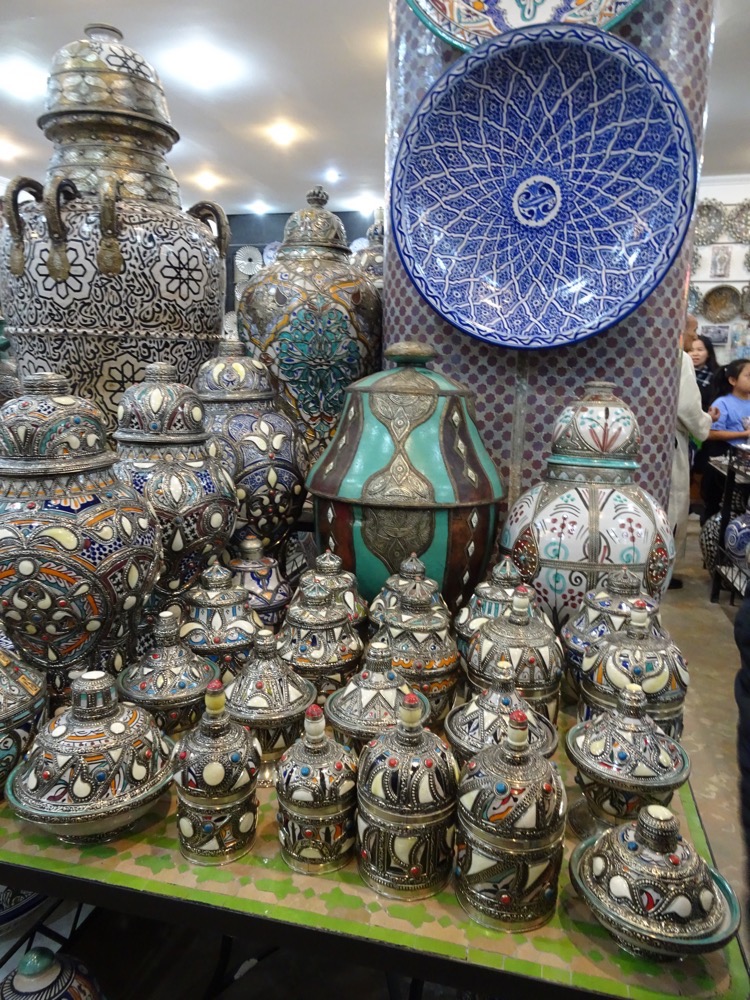
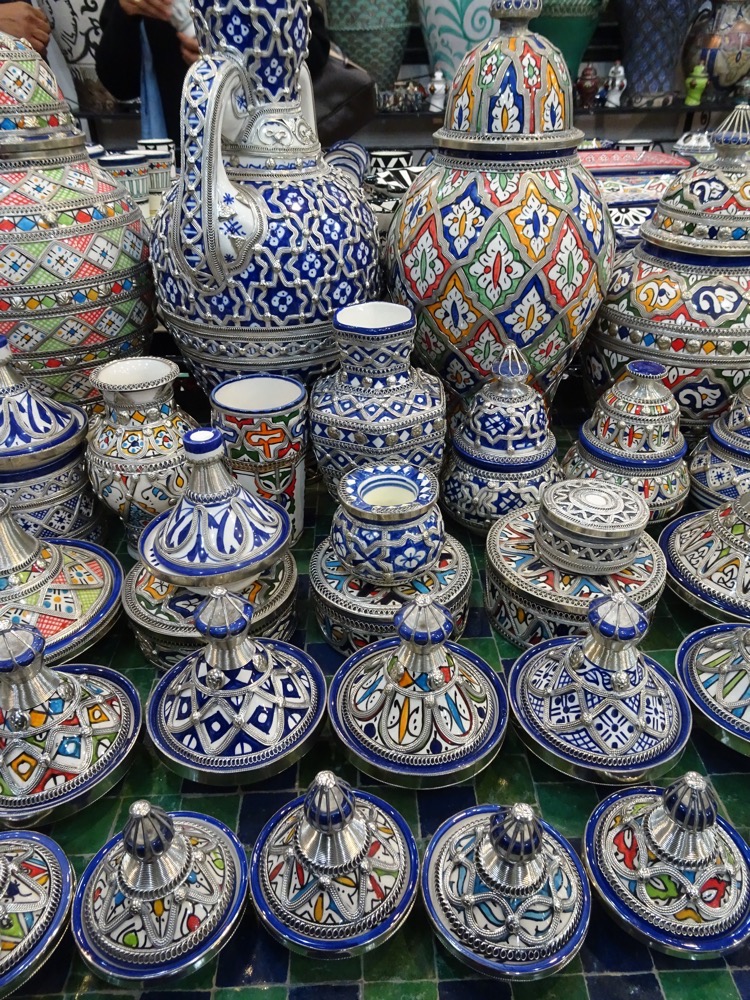
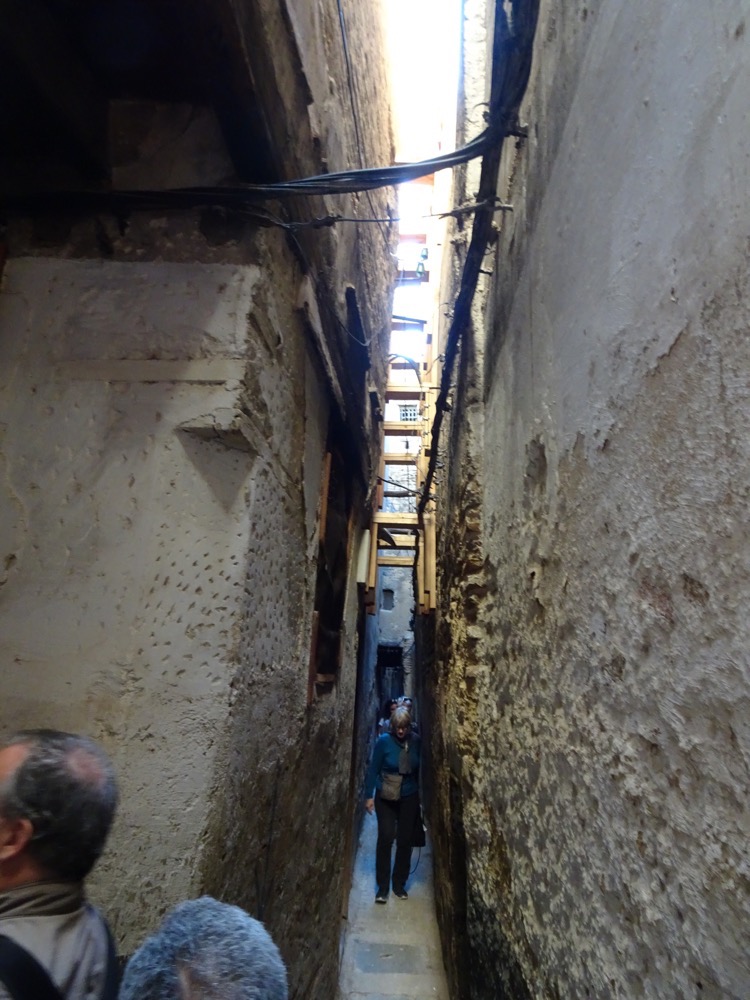 The World Heritage listed Fez al Bali Medina has alleys coming off alleys,stemming from alleys that are connected to even more alleys. Nearly all tourists who venture into this place come with a guide of some sort, becuase it is so easy to get completely lost and end up wandering around for kilometres to find your way out. We entered near a food section of covered markets.
The World Heritage listed Fez al Bali Medina has alleys coming off alleys,stemming from alleys that are connected to even more alleys. Nearly all tourists who venture into this place come with a guide of some sort, becuase it is so easy to get completely lost and end up wandering around for kilometres to find your way out. We entered near a food section of covered markets. 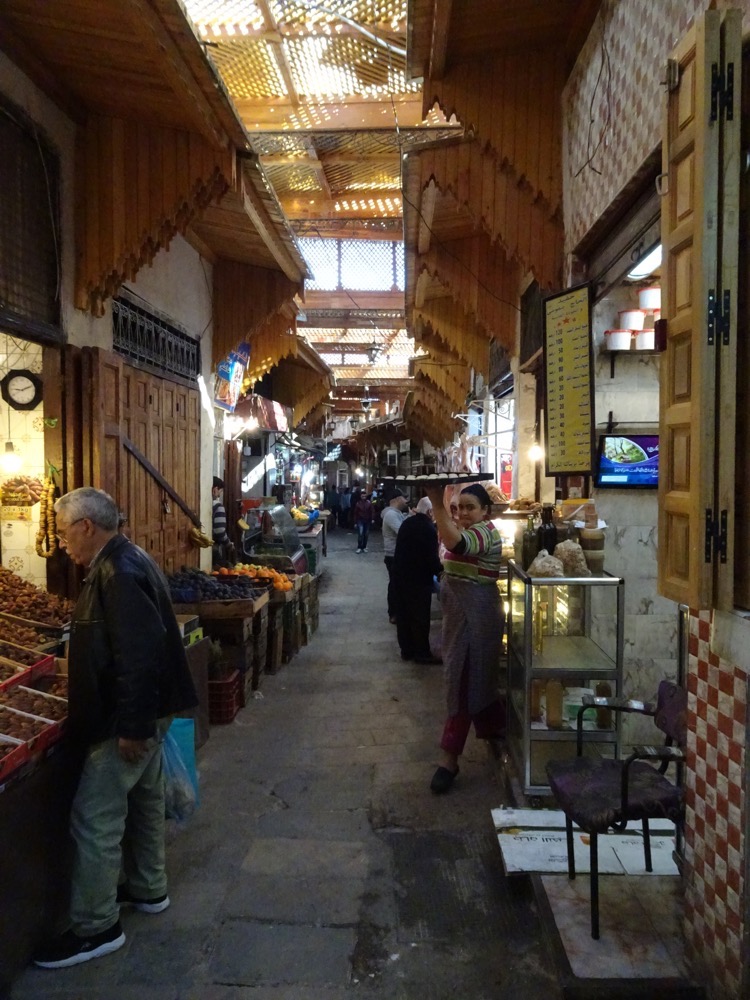 Dates, figs, seafood, meat, fresh fruits and vegetables, tea, grains, spices, herbs, and god knows what else was stashed into every available square inch of space in the covered shops. It is very similar to the Grand Bazaar in Isanbul.
Dates, figs, seafood, meat, fresh fruits and vegetables, tea, grains, spices, herbs, and god knows what else was stashed into every available square inch of space in the covered shops. It is very similar to the Grand Bazaar in Isanbul. 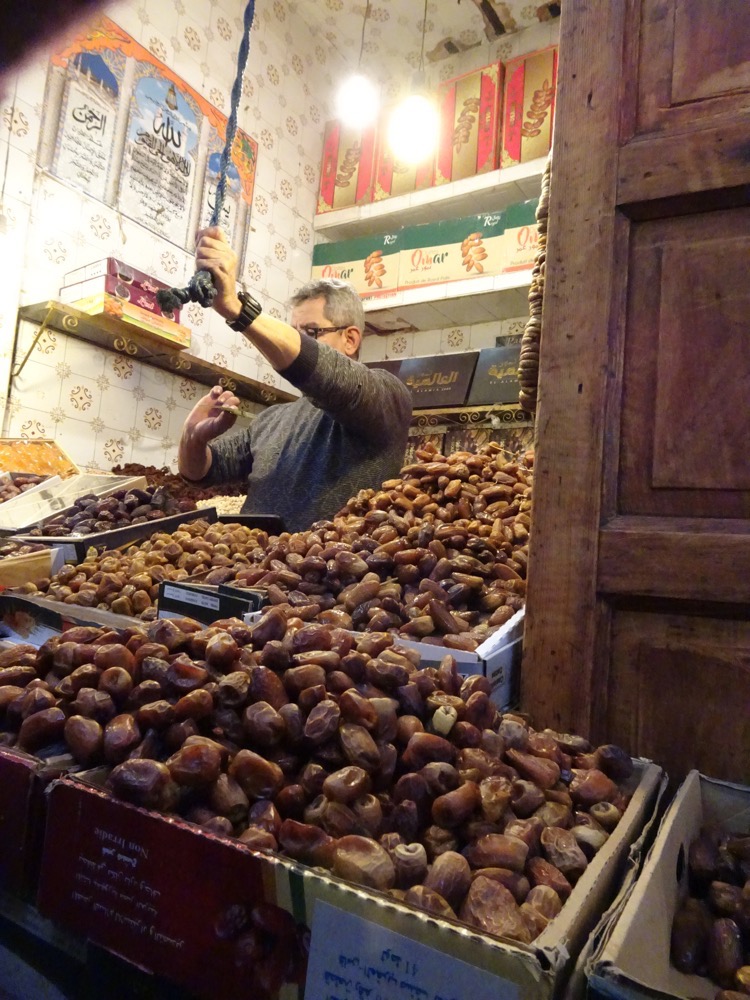 This man was selling live snails, and when he saw the tourists photographing his big tub of slimy delicacies, he started asking for money from people who shoved their cameras right over the tub of writhing creatures… tourists in the medina taking lots of photos and buying no produce must drive them crazy.
This man was selling live snails, and when he saw the tourists photographing his big tub of slimy delicacies, he started asking for money from people who shoved their cameras right over the tub of writhing creatures… tourists in the medina taking lots of photos and buying no produce must drive them crazy.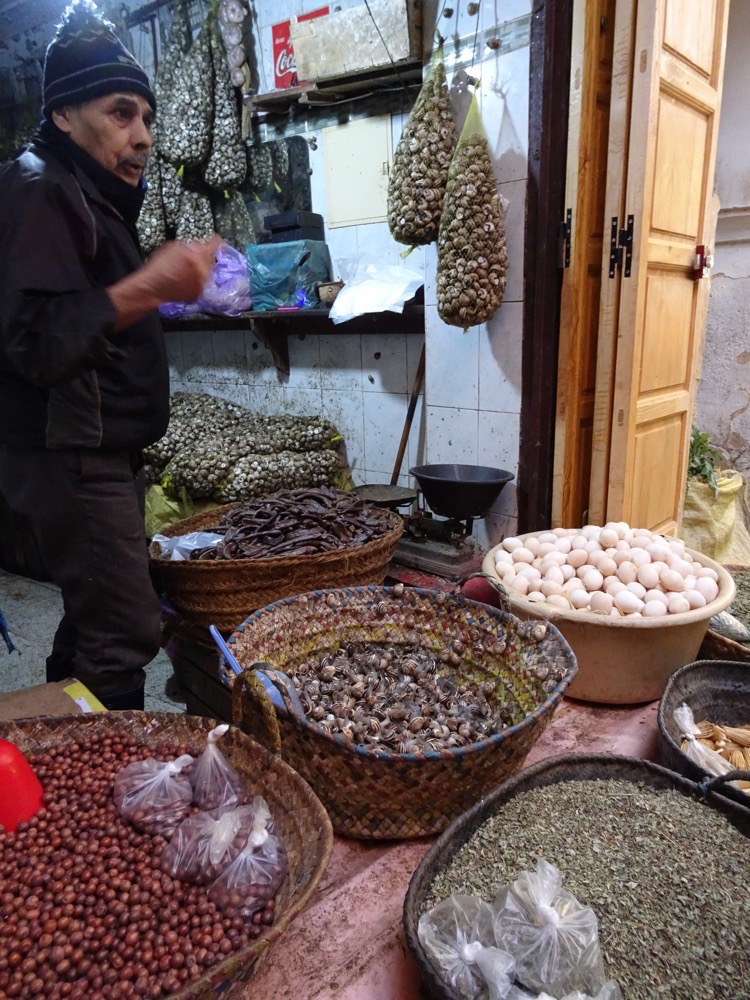 The camel heads hanging at the butcher’s shop is apparently the easiest way to tell people that you have camel meat in stock today. Little gory, definitely effective advertising.
The camel heads hanging at the butcher’s shop is apparently the easiest way to tell people that you have camel meat in stock today. Little gory, definitely effective advertising. 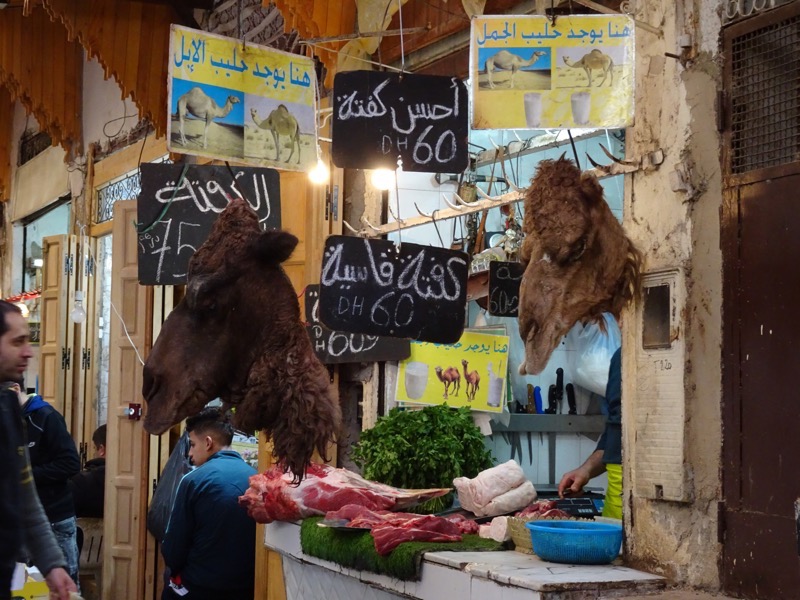 Seafoods – the large lumps of white flesh in the front of the table is some sort of local shark meat.
Seafoods – the large lumps of white flesh in the front of the table is some sort of local shark meat.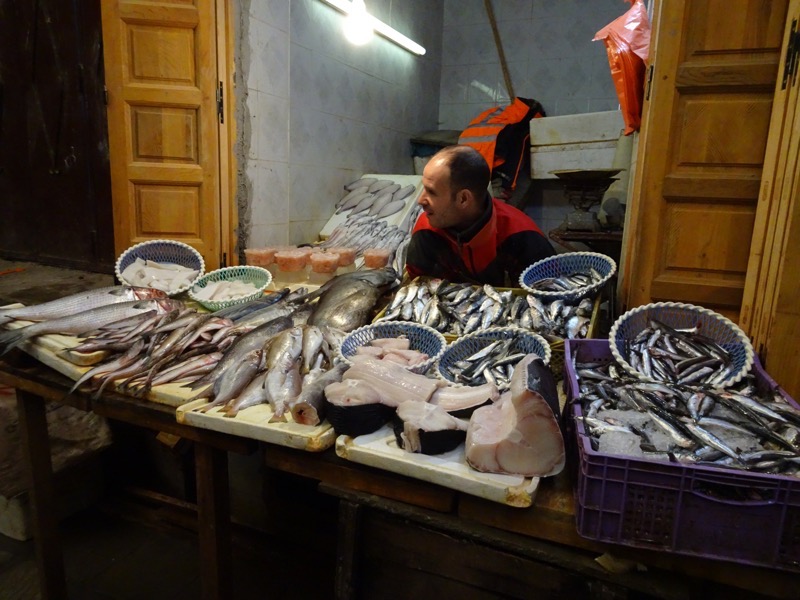 Not far from the fresh produce and food stuffs are was dyers lane. I could see all this silk hanging up and it piqued my interest immediately. Apparently this is ‘saba silk’, which allegedly comes from the agave cactus plant – yes, that agave plant. Disappointinly, from what I’ve read up on this thread though, the bulk of the ‘saba silk’ used in Morrocan crafts is actually rayon that has been manufactured in Spain or India and comes in bulk and is dyed here for local use. I don’t think people care that their item has rayon embroidery on it – but generally speaking I don’t think it’s ethical to lead people to think that their item is made from hand harvested agave and spun by local women into something beautiful, when it’s actually brough in pre-manufactured from India. This is one of those things you hear about and think: ‘yeah, not entirely surprised’.
Not far from the fresh produce and food stuffs are was dyers lane. I could see all this silk hanging up and it piqued my interest immediately. Apparently this is ‘saba silk’, which allegedly comes from the agave cactus plant – yes, that agave plant. Disappointinly, from what I’ve read up on this thread though, the bulk of the ‘saba silk’ used in Morrocan crafts is actually rayon that has been manufactured in Spain or India and comes in bulk and is dyed here for local use. I don’t think people care that their item has rayon embroidery on it – but generally speaking I don’t think it’s ethical to lead people to think that their item is made from hand harvested agave and spun by local women into something beautiful, when it’s actually brough in pre-manufactured from India. This is one of those things you hear about and think: ‘yeah, not entirely surprised’. 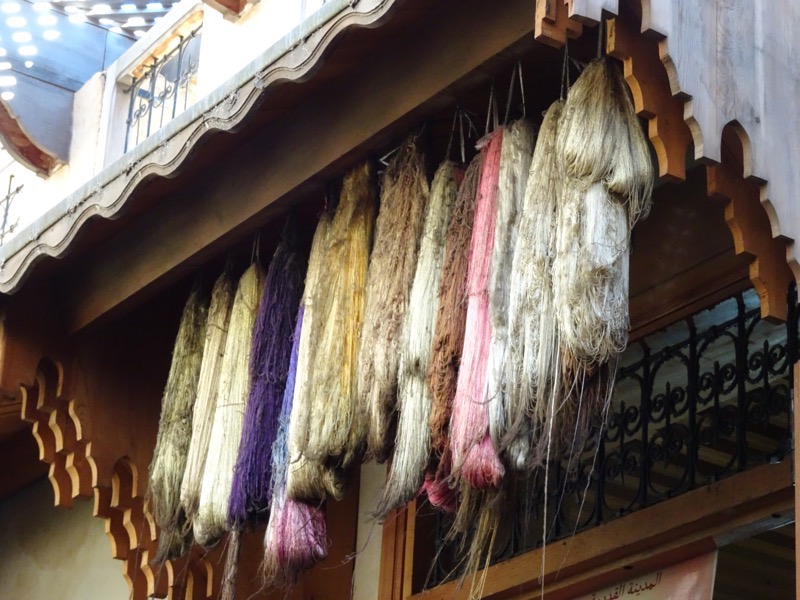 Just outside the dyer’s lane was a small bridge that gave a view of the Fez River which runs thorugh the medina. It’s difficult to see in this photo with such a high contrast ration, but I can tell you unequivocally that the fish and eel and other seafood stuffs being sold inside, does NOT come from this river.
Just outside the dyer’s lane was a small bridge that gave a view of the Fez River which runs thorugh the medina. It’s difficult to see in this photo with such a high contrast ration, but I can tell you unequivocally that the fish and eel and other seafood stuffs being sold inside, does NOT come from this river.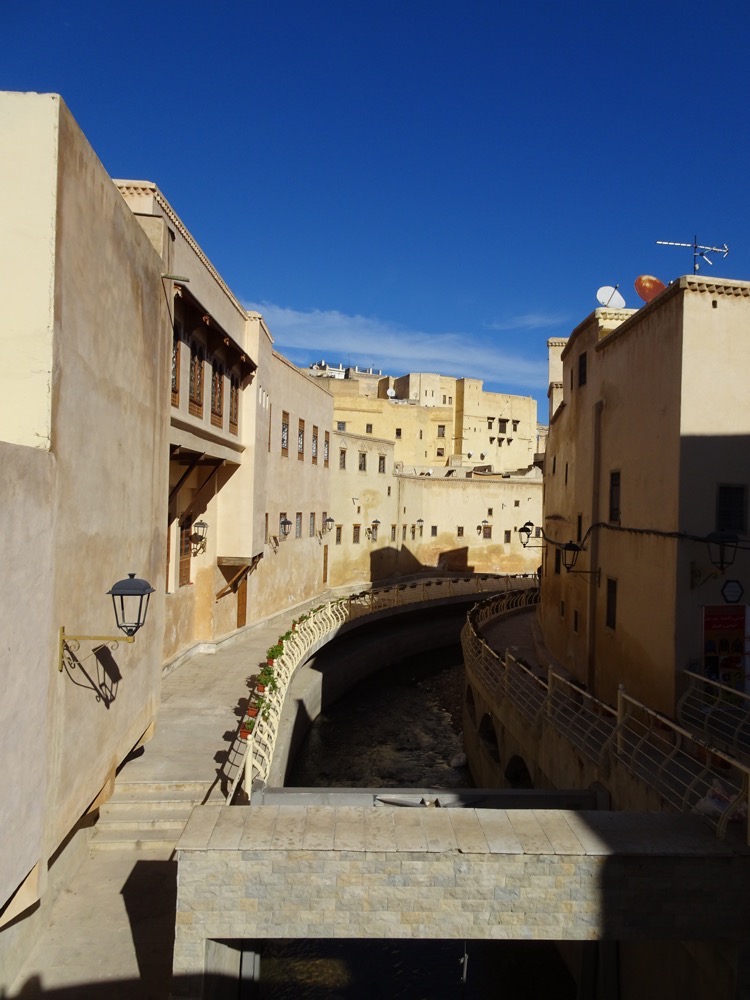 We saw loads of these large cone shaped items around the place and had to ask Mustafa what they were – they are food coverings, and apparently these huge velvet and embroidered ones are used for covering bread… ’tis a far cry from the Brabante bread bin that adorns my kitchen!
We saw loads of these large cone shaped items around the place and had to ask Mustafa what they were – they are food coverings, and apparently these huge velvet and embroidered ones are used for covering bread… ’tis a far cry from the Brabante bread bin that adorns my kitchen!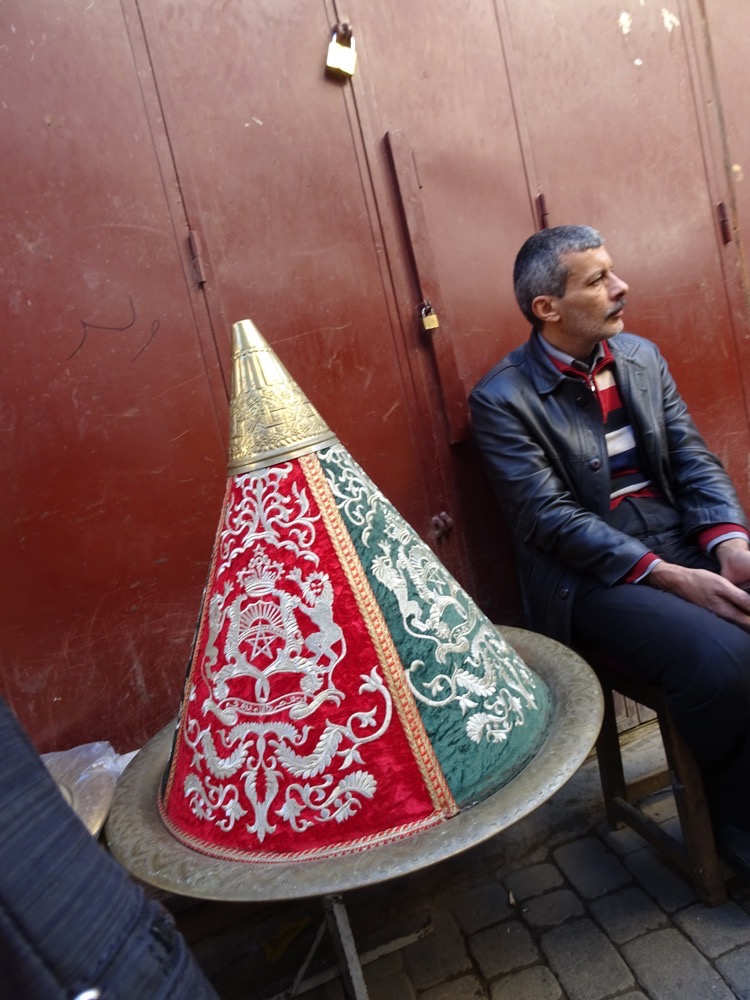
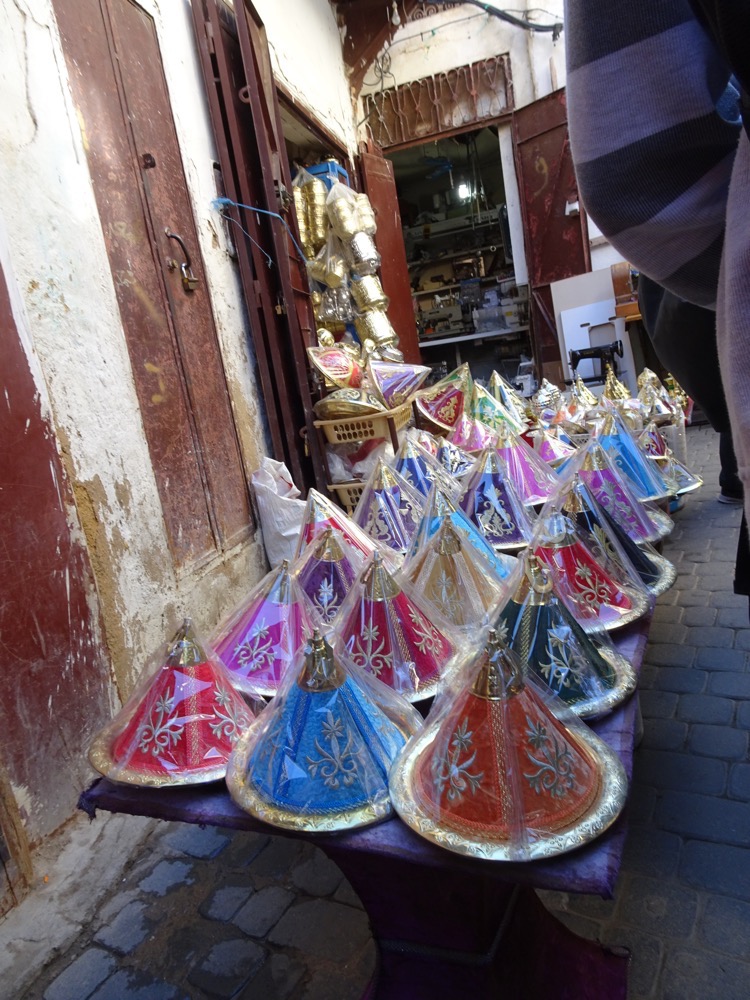
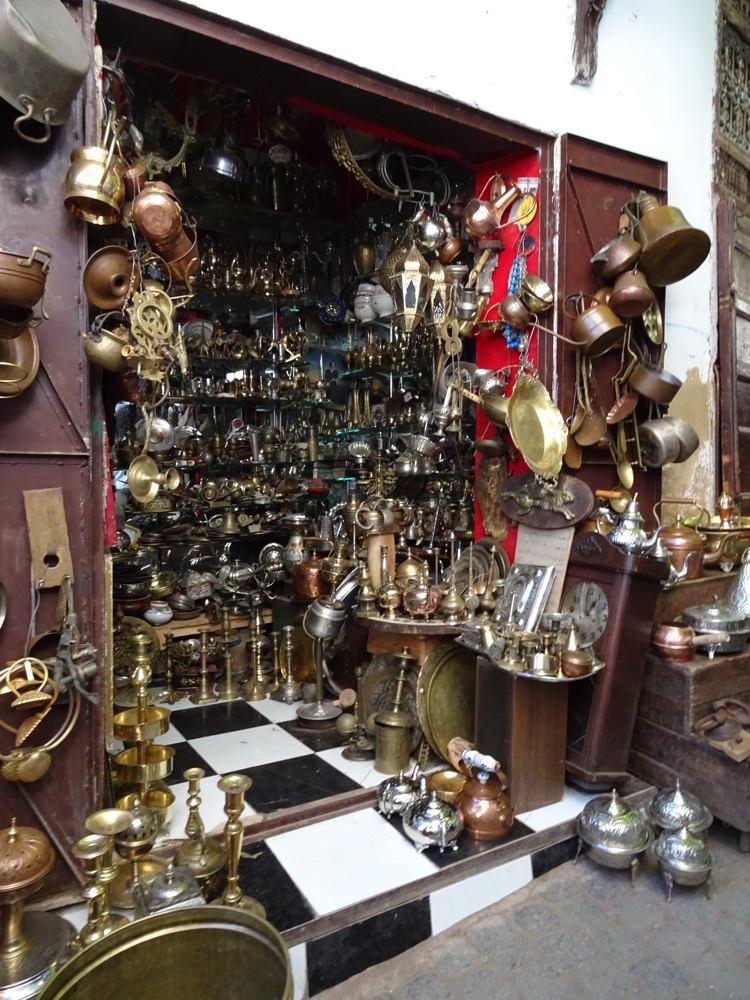
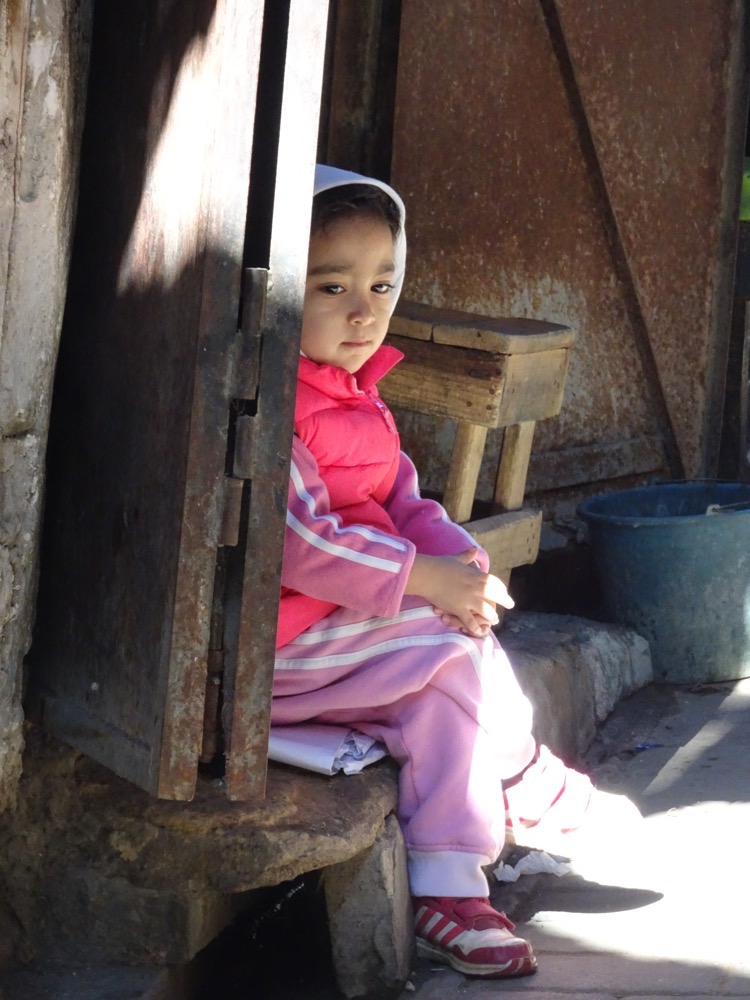
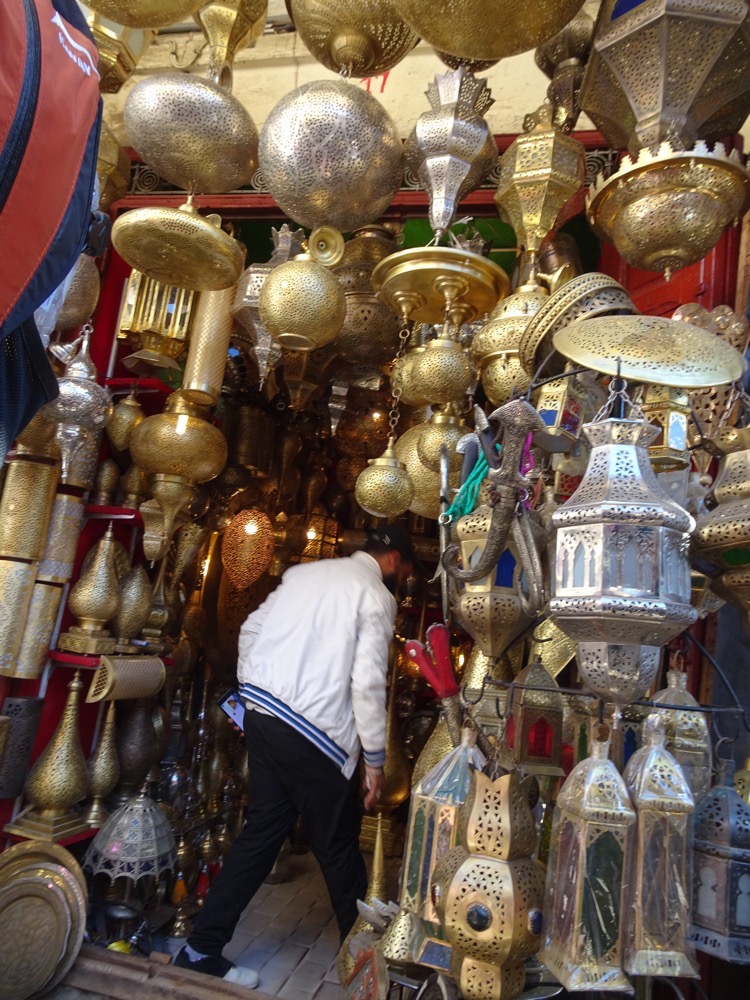
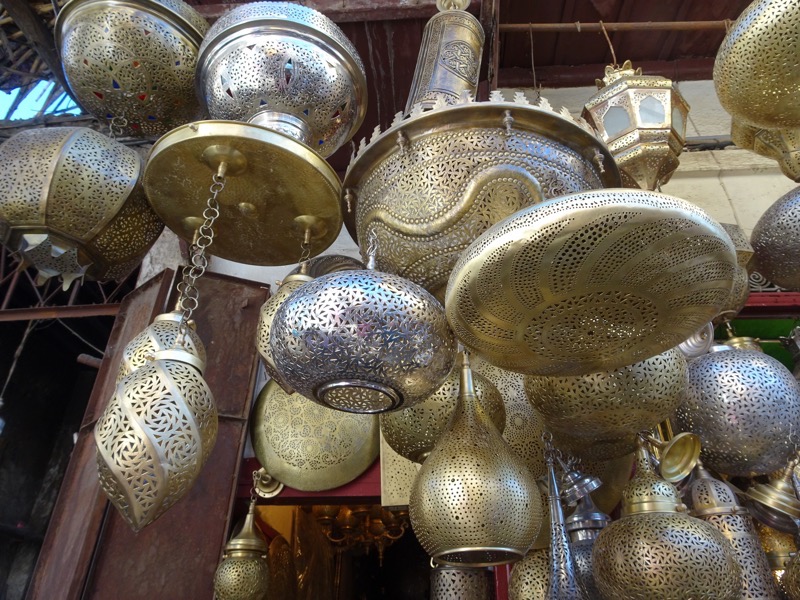
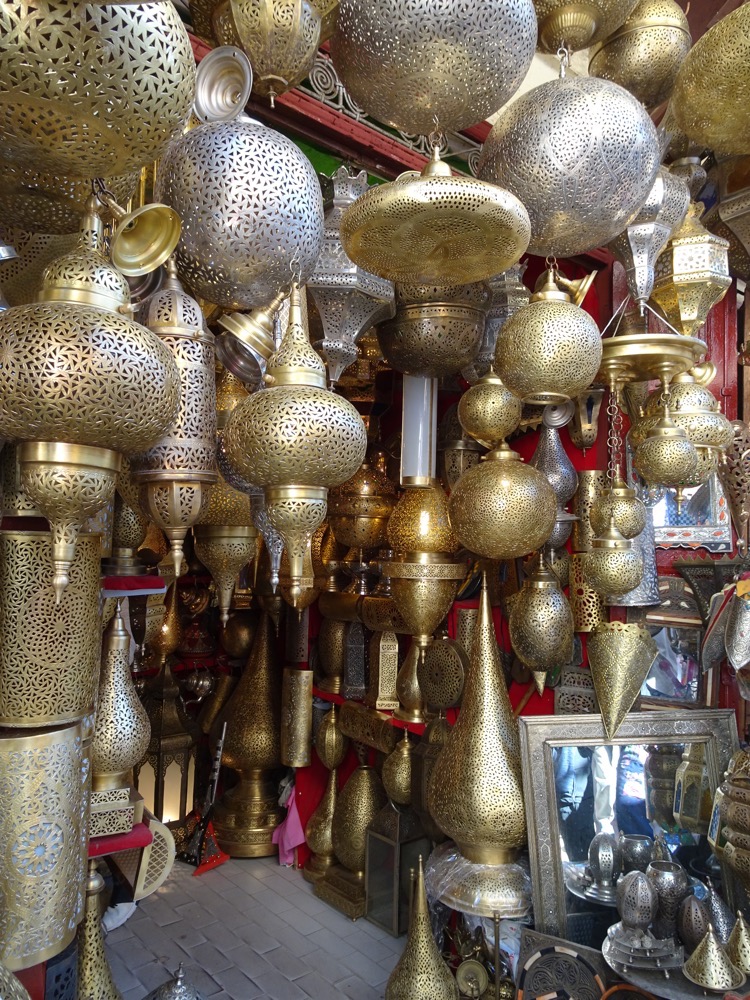
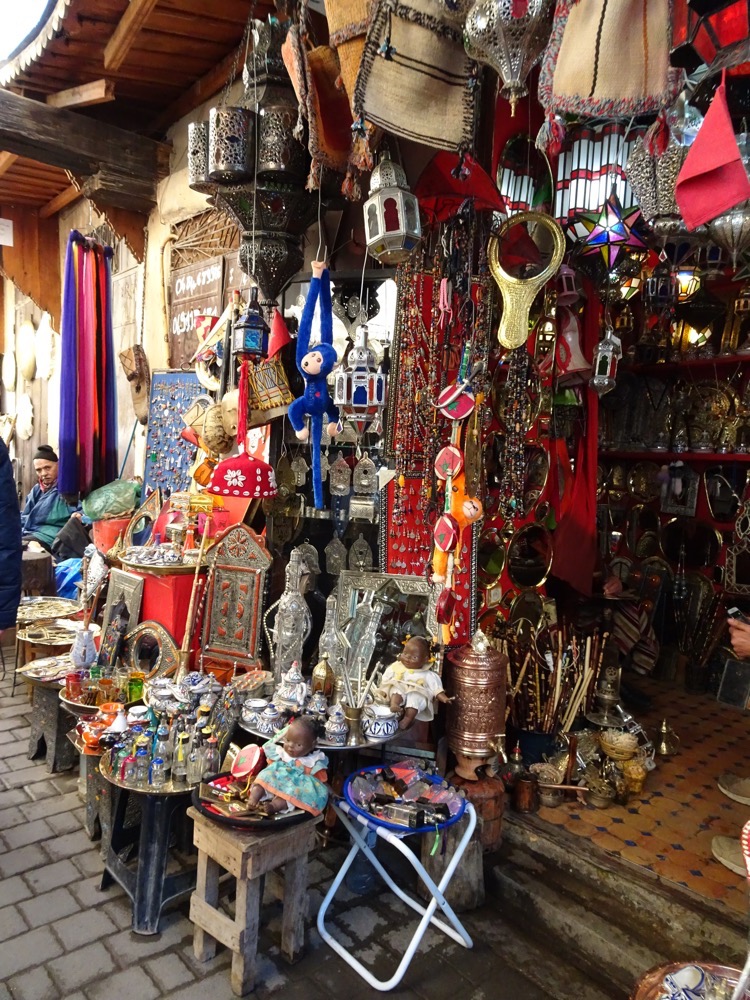
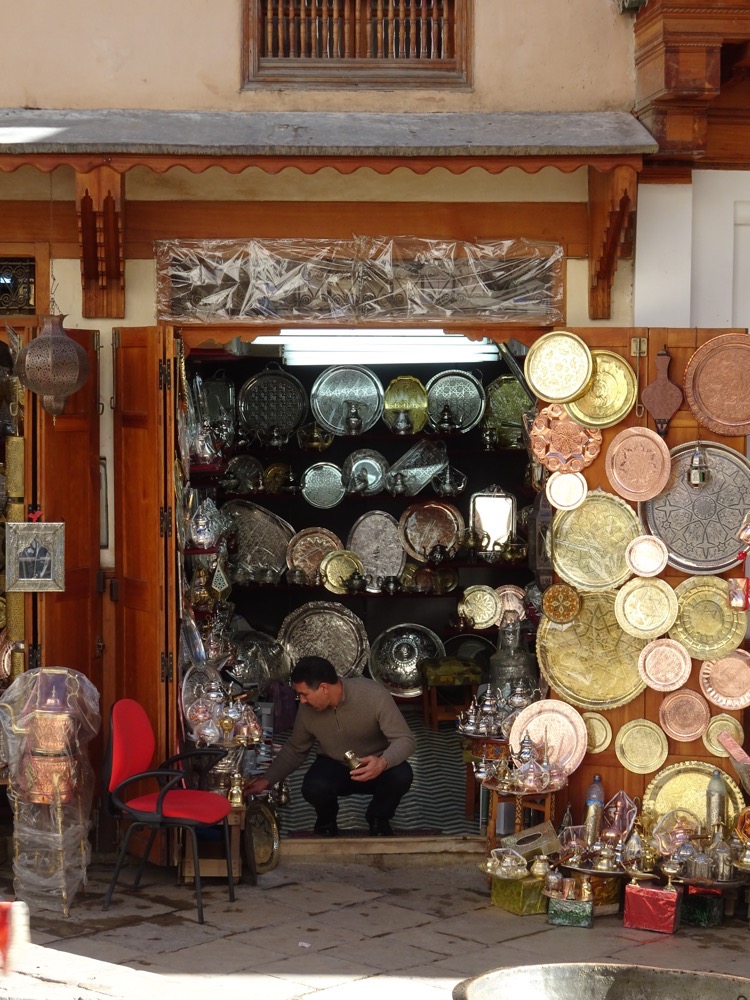
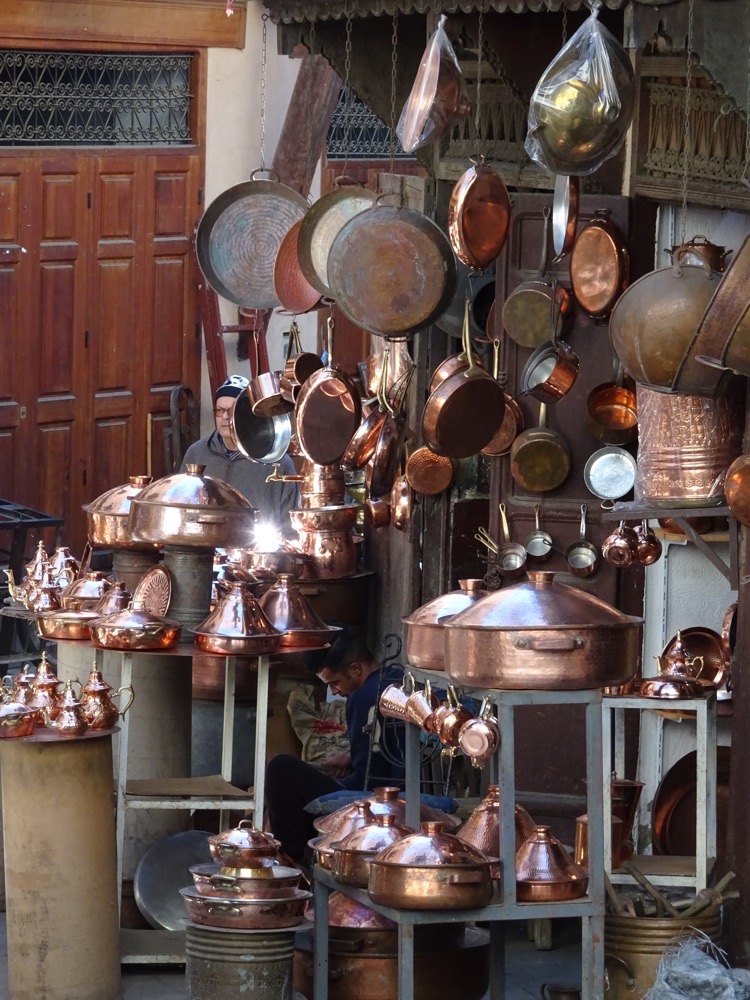 I managed to see another man doing some metal work on one of these metal topped tables, and was just amazed at how detailed they were.
I managed to see another man doing some metal work on one of these metal topped tables, and was just amazed at how detailed they were.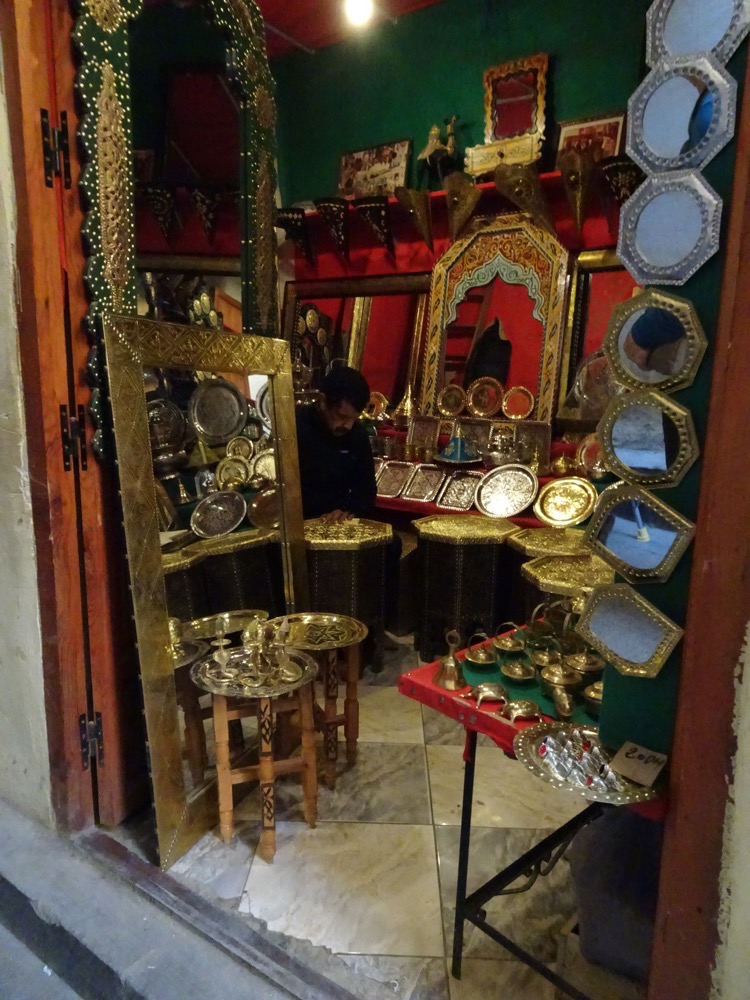 Further into the the medina we found ourselves moving into the leather area. Morocco is famous for its leather industry, and the medina has three tanneries contained within its walls.
Further into the the medina we found ourselves moving into the leather area. Morocco is famous for its leather industry, and the medina has three tanneries contained within its walls.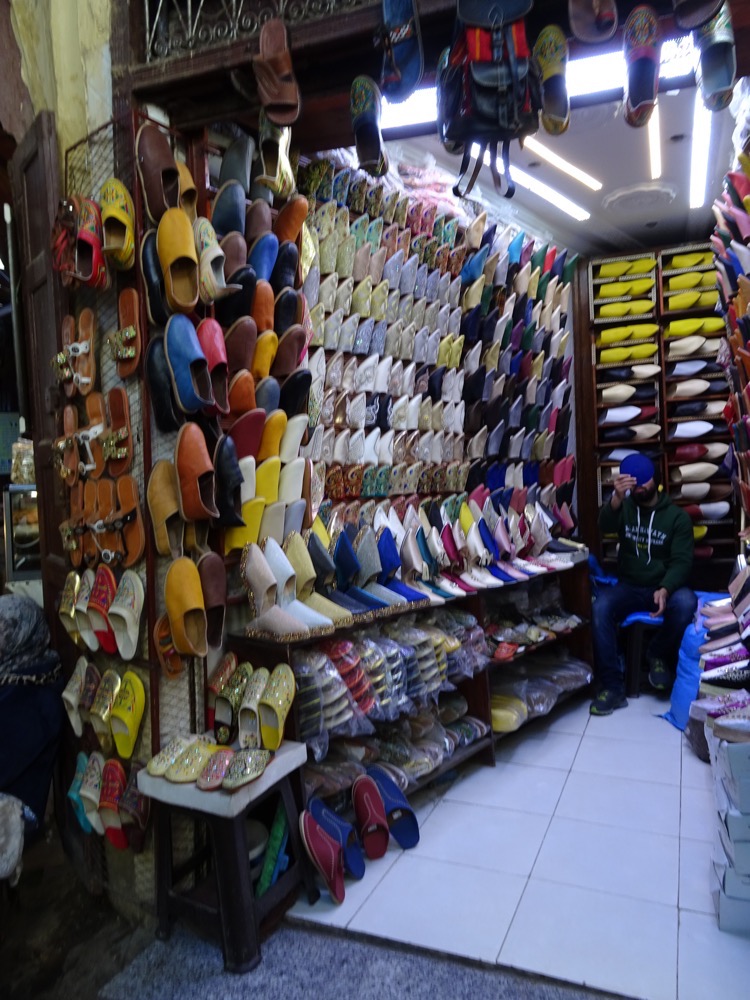
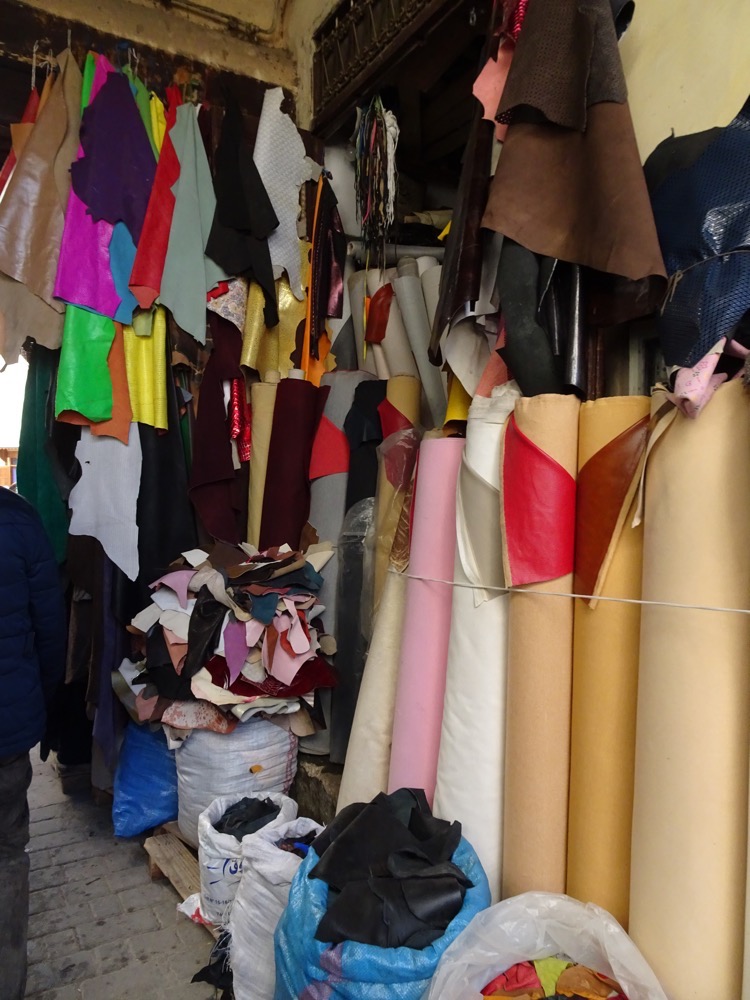
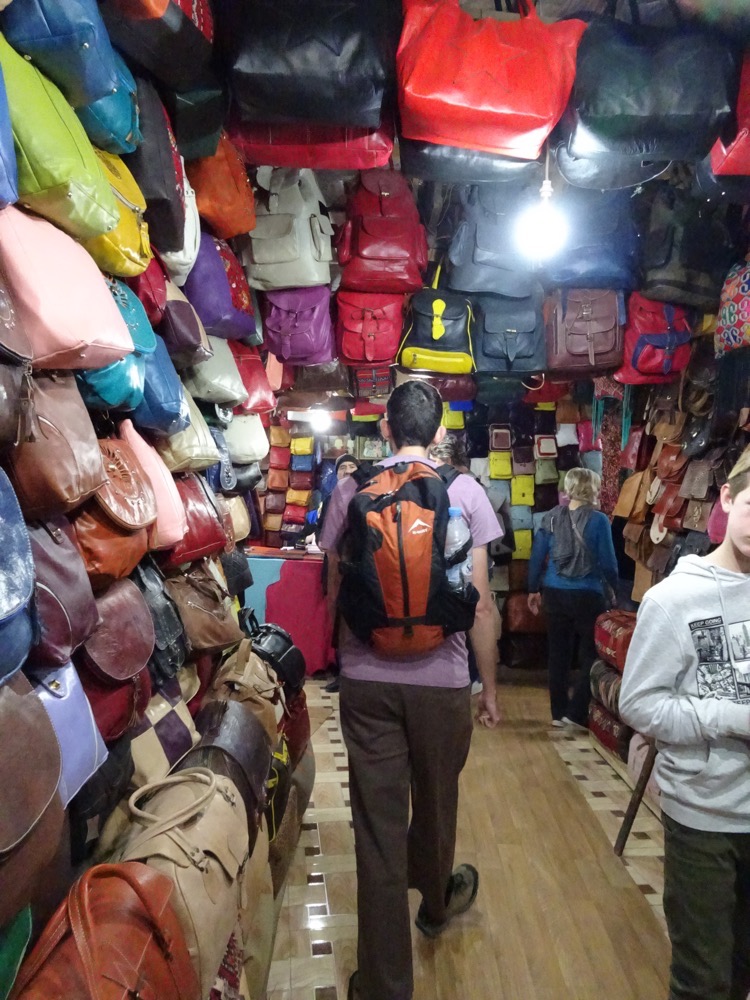 From a balcony overlooking the tannery, you can see numerous stone pits filled with different coloured dyes and liquids. Hides of cows, sheep, goats, and camels are processed here – the first step is to soak them in a series of white liquids – this first stage of the process uses a liquid that is a varying mixture of cow urine, pigeon shit, quicklime, salt, and water. This cleans the often very tough skins, and it normally takes about two or three days. After the cleaning and scraping, they are soaked in various dyeing solutions. The tannery uses many natural colourants such as poppy for red, indigo for blue, and henna for orange – same as they have used since the 11thC. After the skins are dyed, they get spread out on rooftops for sun drying. The leather then gets sold to various craftsmen who use it to make Morocco’s famous leather goods: bags, coats, shoes, and slippers. The entire leather production process in Morocco is done completely by manual labour and uses no modern machinery. They have retained methods that are unchanged since the medieval period… which is just amazing but also completely nuts.
From a balcony overlooking the tannery, you can see numerous stone pits filled with different coloured dyes and liquids. Hides of cows, sheep, goats, and camels are processed here – the first step is to soak them in a series of white liquids – this first stage of the process uses a liquid that is a varying mixture of cow urine, pigeon shit, quicklime, salt, and water. This cleans the often very tough skins, and it normally takes about two or three days. After the cleaning and scraping, they are soaked in various dyeing solutions. The tannery uses many natural colourants such as poppy for red, indigo for blue, and henna for orange – same as they have used since the 11thC. After the skins are dyed, they get spread out on rooftops for sun drying. The leather then gets sold to various craftsmen who use it to make Morocco’s famous leather goods: bags, coats, shoes, and slippers. The entire leather production process in Morocco is done completely by manual labour and uses no modern machinery. They have retained methods that are unchanged since the medieval period… which is just amazing but also completely nuts.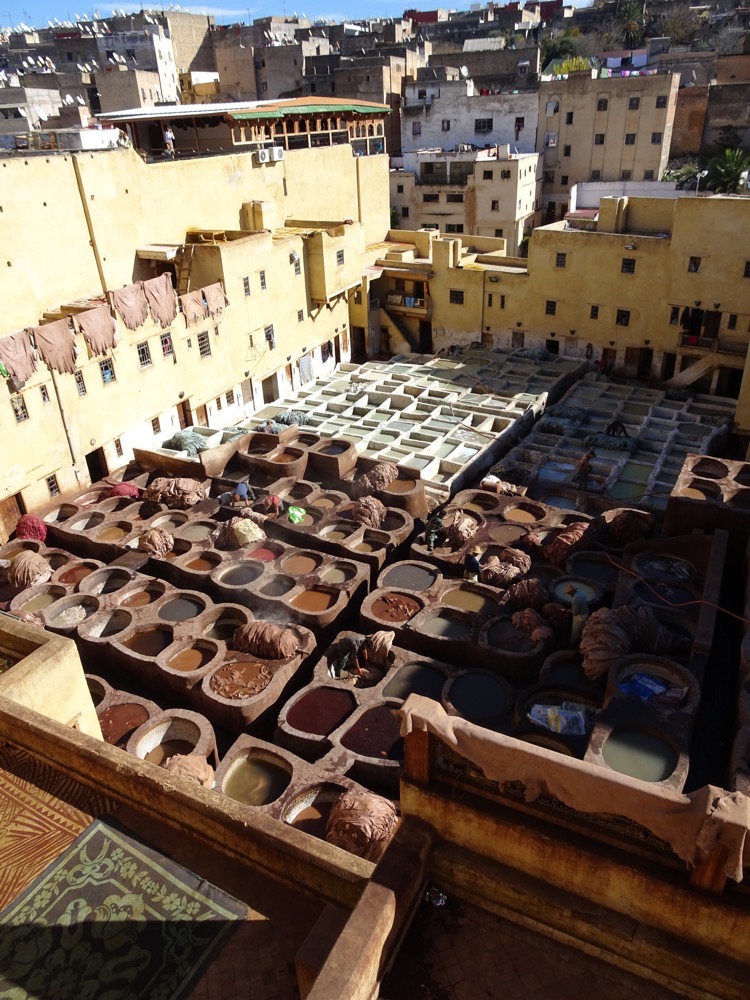
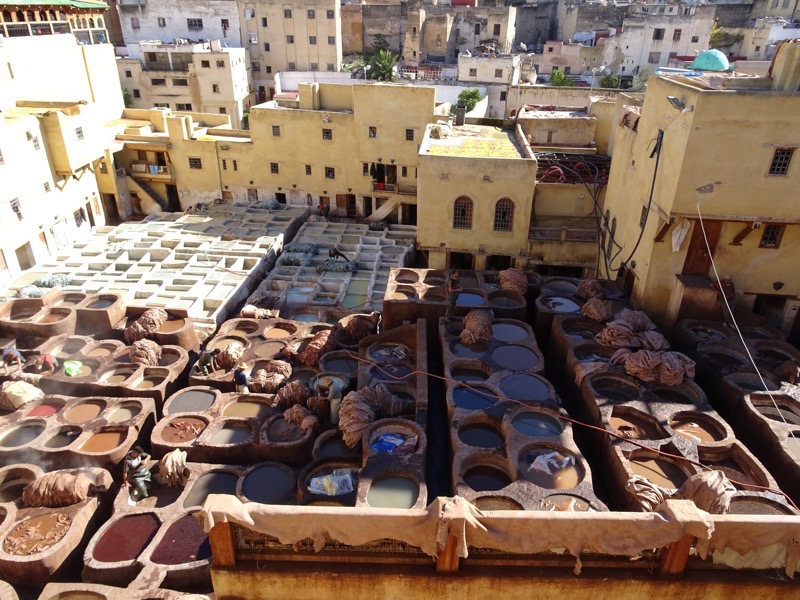
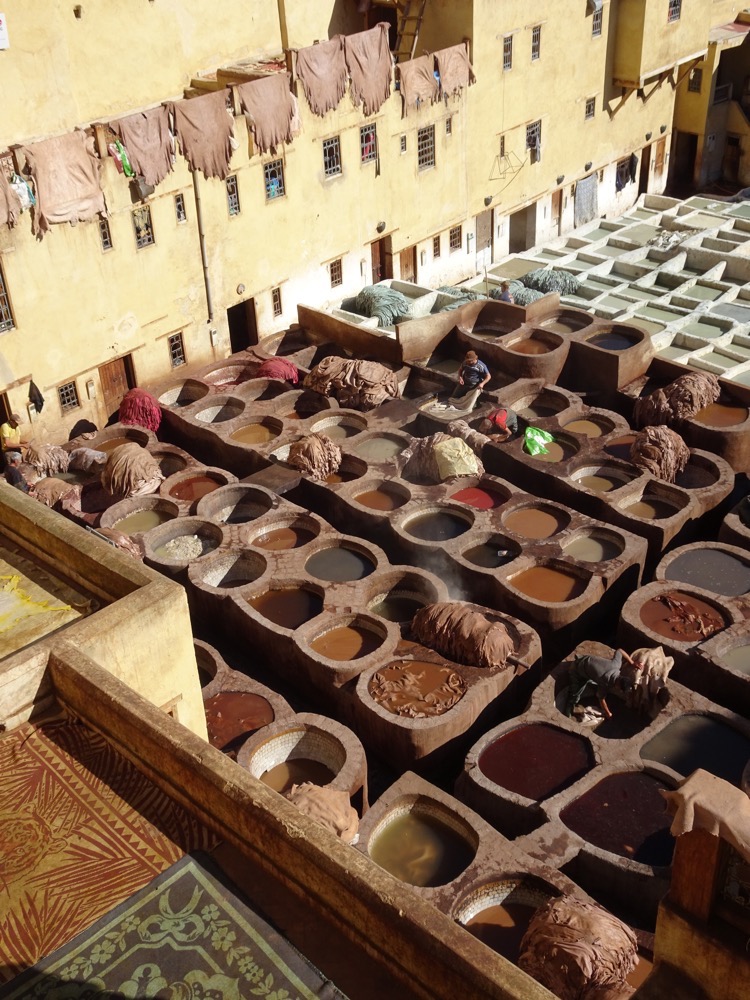 Thank the gods for that spring of mint – the stench was enough to turn your stomcah. I can’t imagine how anyone survives a visit up here in the summer, and I really don’t know how anyone survives working down there their whole life!
Thank the gods for that spring of mint – the stench was enough to turn your stomcah. I can’t imagine how anyone survives a visit up here in the summer, and I really don’t know how anyone survives working down there their whole life!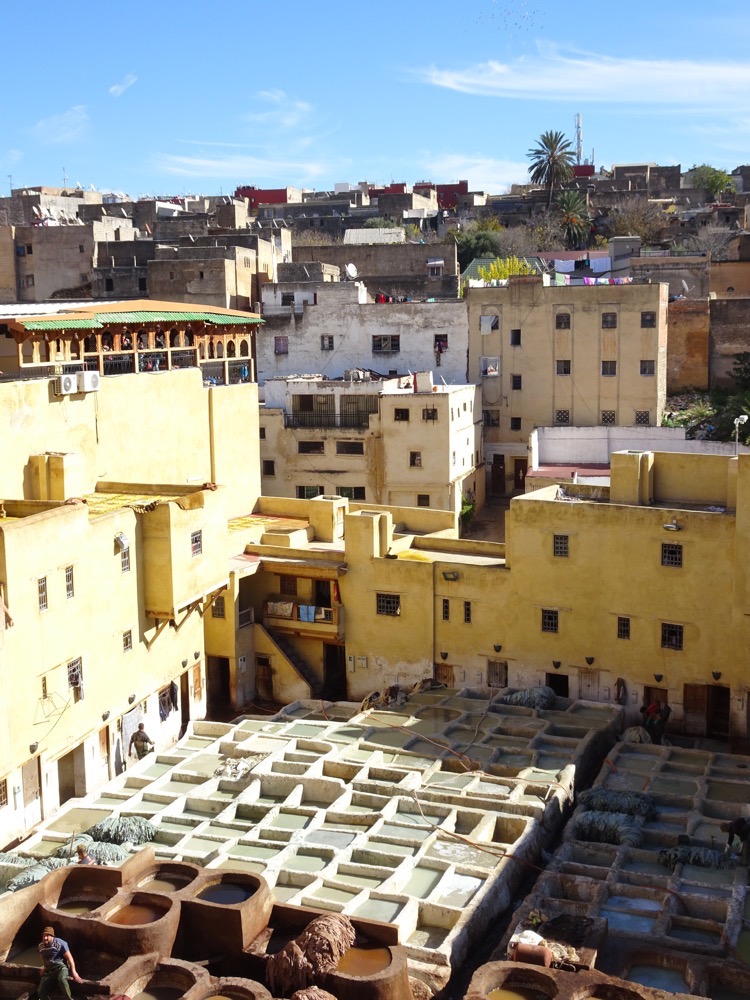
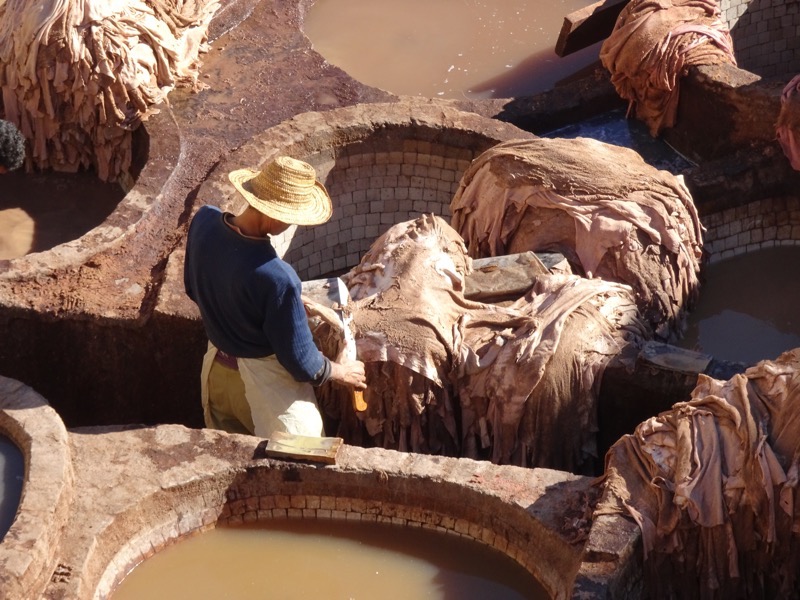
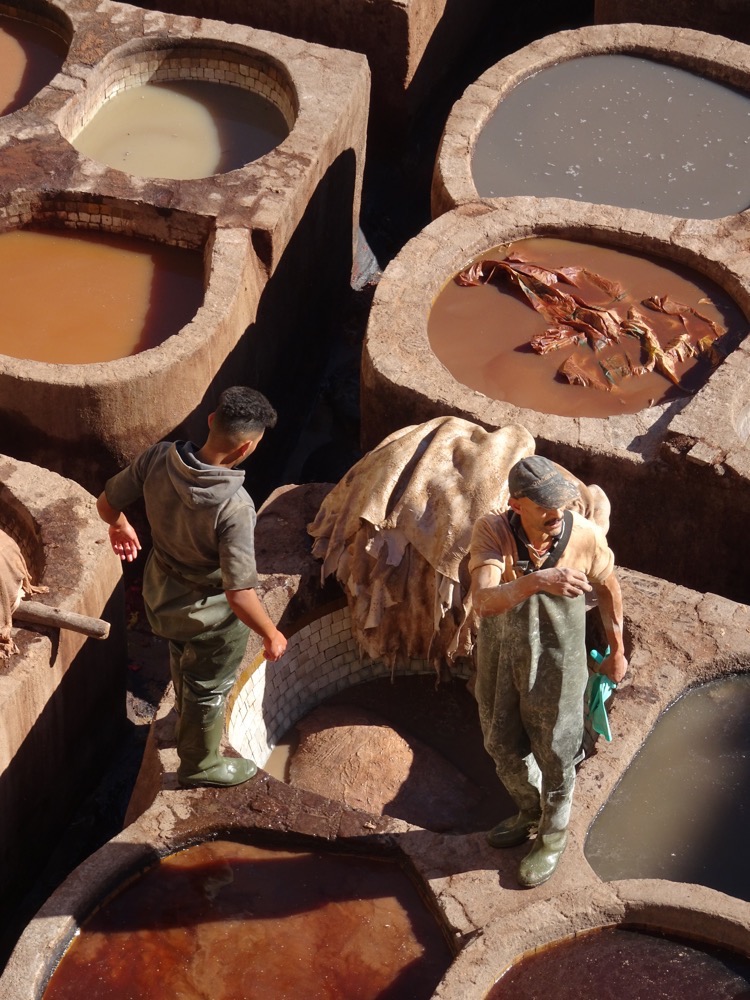
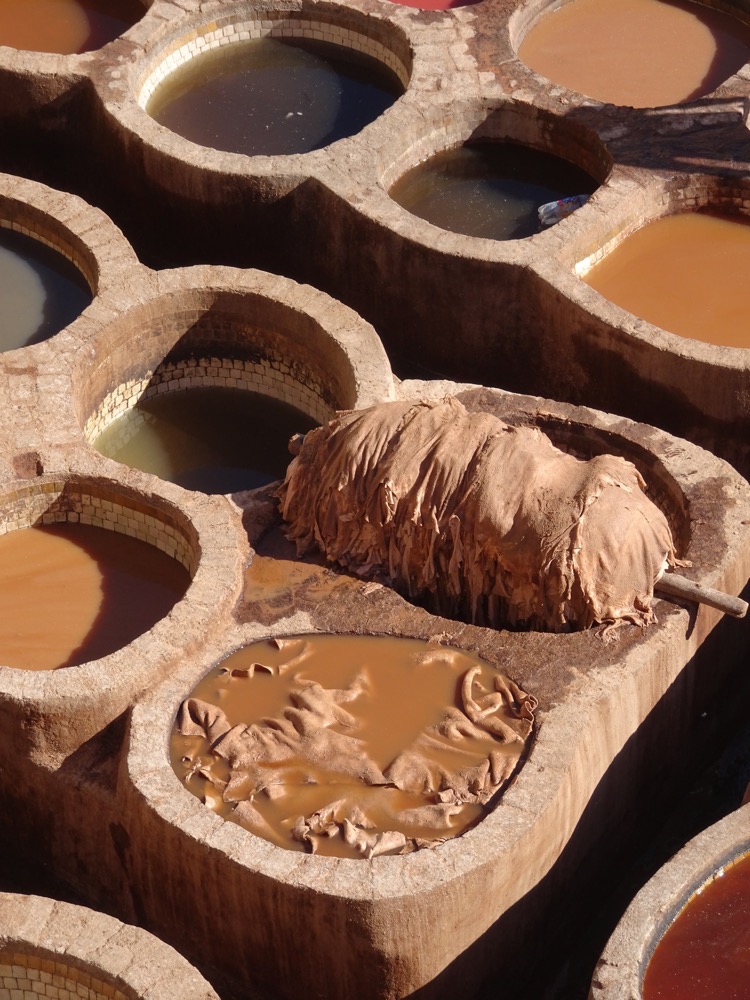
 I love all these colourful ottomans… you buy them unstuffed and take them home and can stuf them with wadding, wool, rags, hair, whaterver you want. They’re not particularly small to transport though.
I love all these colourful ottomans… you buy them unstuffed and take them home and can stuf them with wadding, wool, rags, hair, whaterver you want. They’re not particularly small to transport though.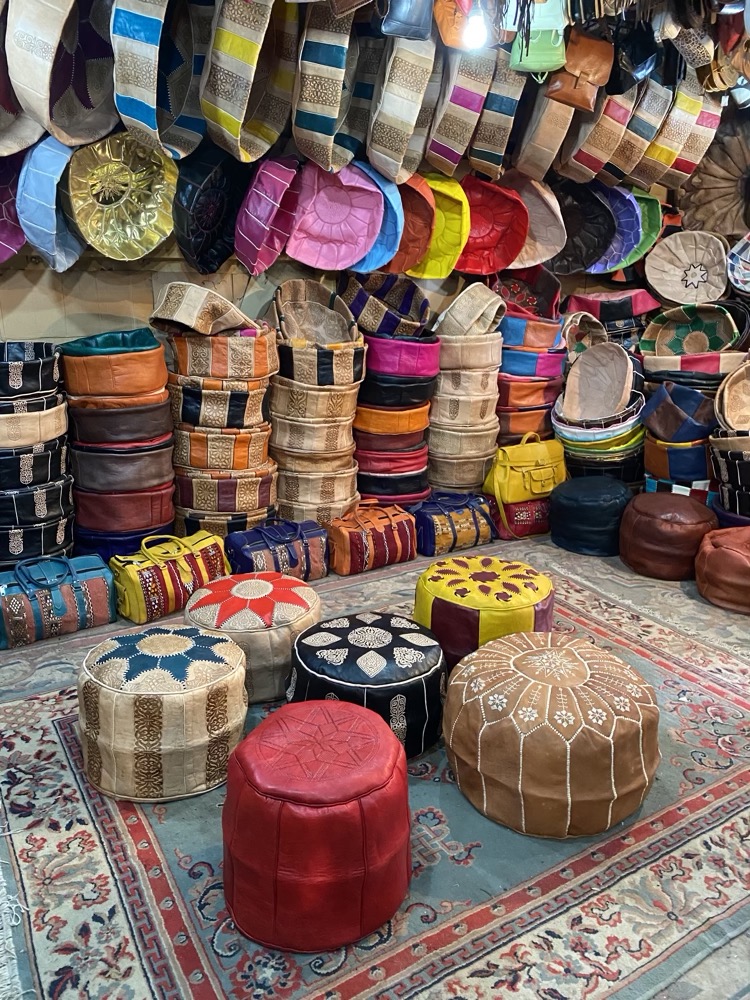
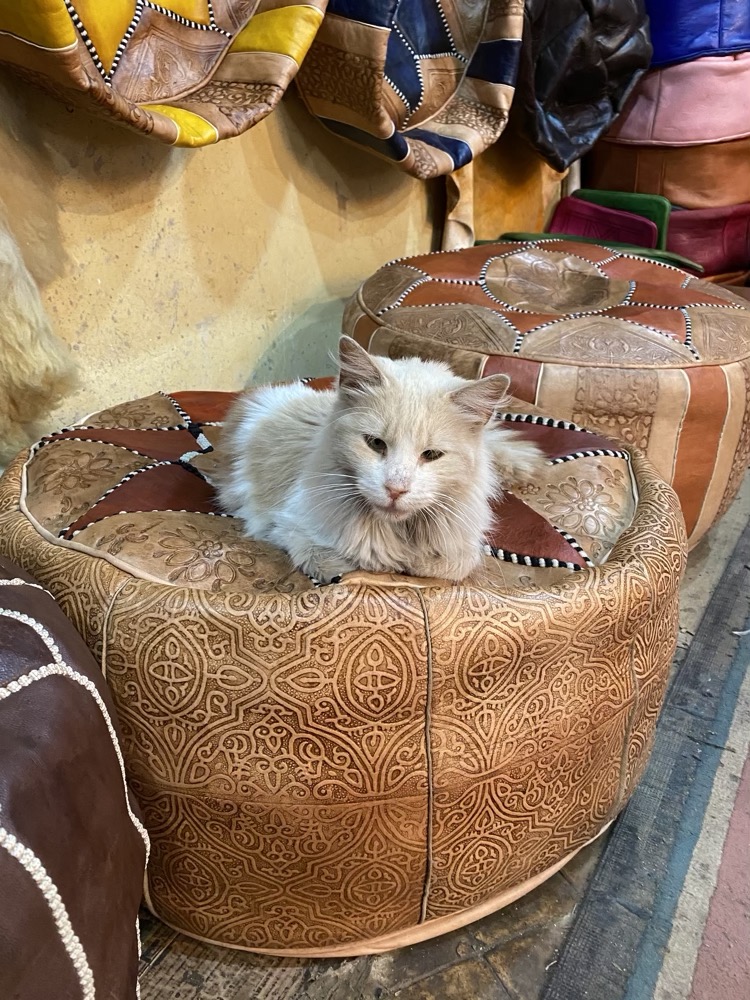 Deep in the heart of the medina is the Zaouia of Moulay Idriss II religious complex. It’s a shrine, a mosque and temple dedicated to the tomb of Idris II who ruled Morocco from 807 to 828 (or Moulay Idris II when you include his sharifian title). He was considered the founder of the city of Fes and the first Moroccan Islamic state. The shrine is UNESCO listed and is one of the holiest shrines in Morocco.
Deep in the heart of the medina is the Zaouia of Moulay Idriss II religious complex. It’s a shrine, a mosque and temple dedicated to the tomb of Idris II who ruled Morocco from 807 to 828 (or Moulay Idris II when you include his sharifian title). He was considered the founder of the city of Fes and the first Moroccan Islamic state. The shrine is UNESCO listed and is one of the holiest shrines in Morocco.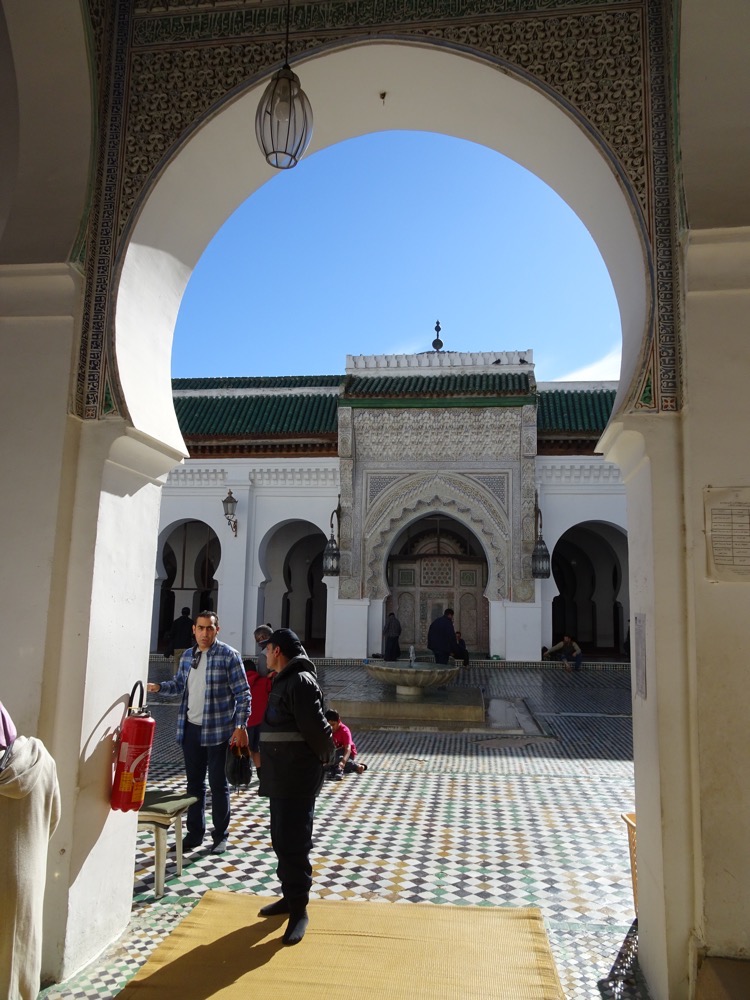
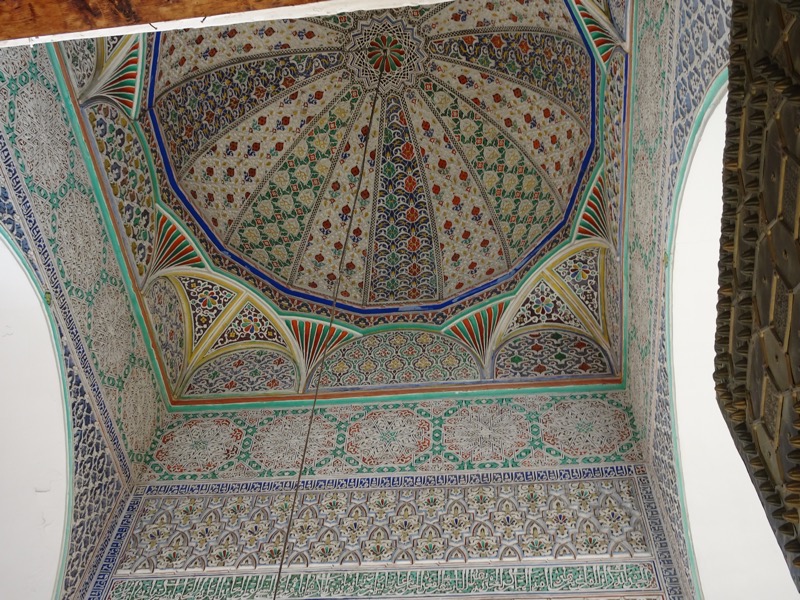 Men performing their ablutions prior to prayer.
Men performing their ablutions prior to prayer.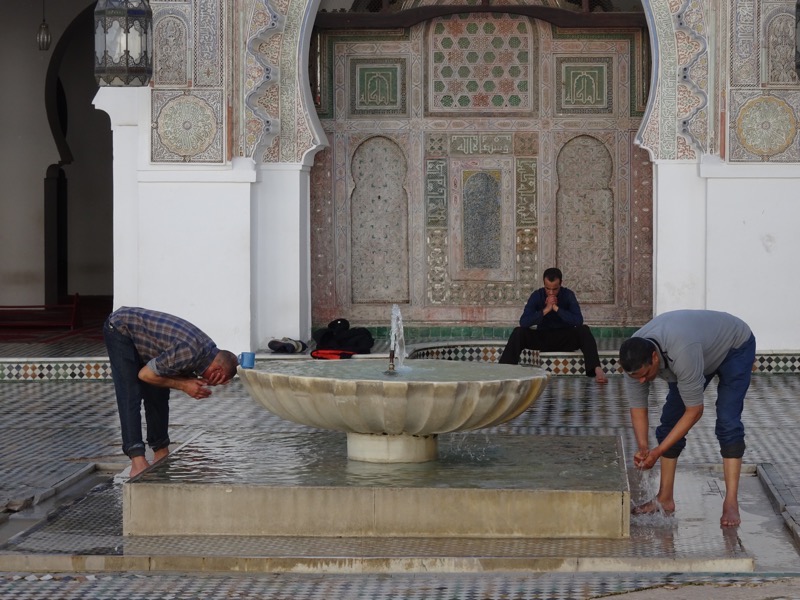 There are multiple doors to the enormous religious complex and madras (religious university) which allow glimpses of life inside.
There are multiple doors to the enormous religious complex and madras (religious university) which allow glimpses of life inside.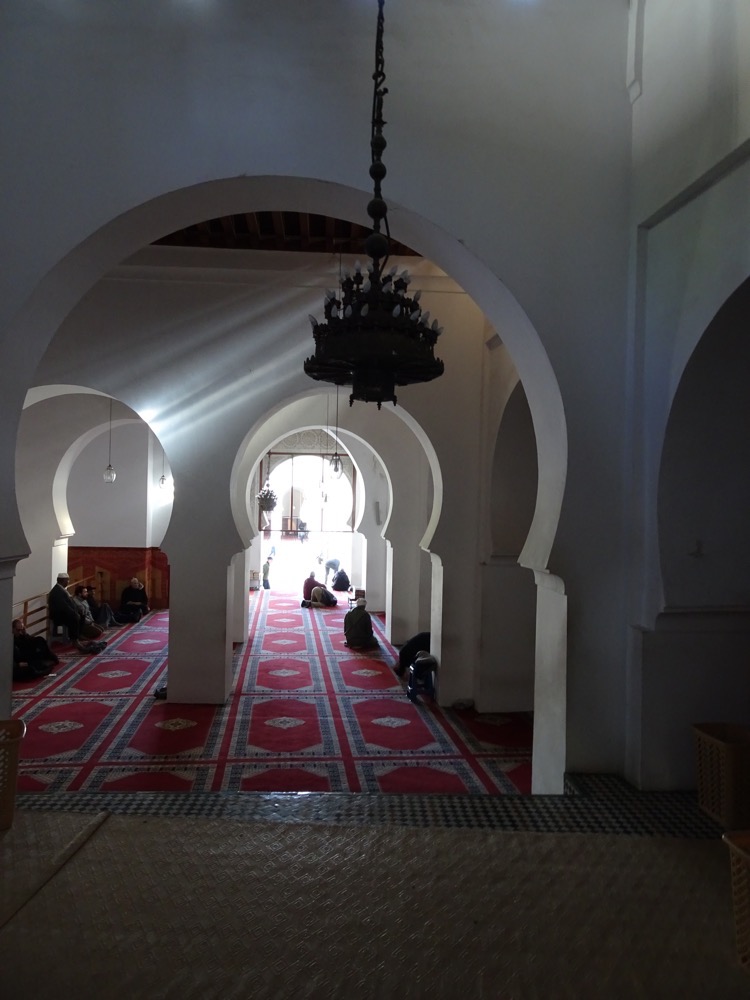 After this we took a well earned break for lunch – we had been walking the medina for a hectic three and a half hours… hectic because the place is packed shoulder to shoulder/cheek to jowl in many places. The ground is uneven and often slippery, it’s winding and there are ramps up and down all over the place, it’s easy to get lost and/or trampled by oncoming donkeys or men with handcarts. There is no dwardling in the medina without creating a traffic hazzard. It literally feels like there is no place to ‘be’ most of the time.
After this we took a well earned break for lunch – we had been walking the medina for a hectic three and a half hours… hectic because the place is packed shoulder to shoulder/cheek to jowl in many places. The ground is uneven and often slippery, it’s winding and there are ramps up and down all over the place, it’s easy to get lost and/or trampled by oncoming donkeys or men with handcarts. There is no dwardling in the medina without creating a traffic hazzard. It literally feels like there is no place to ‘be’ most of the time.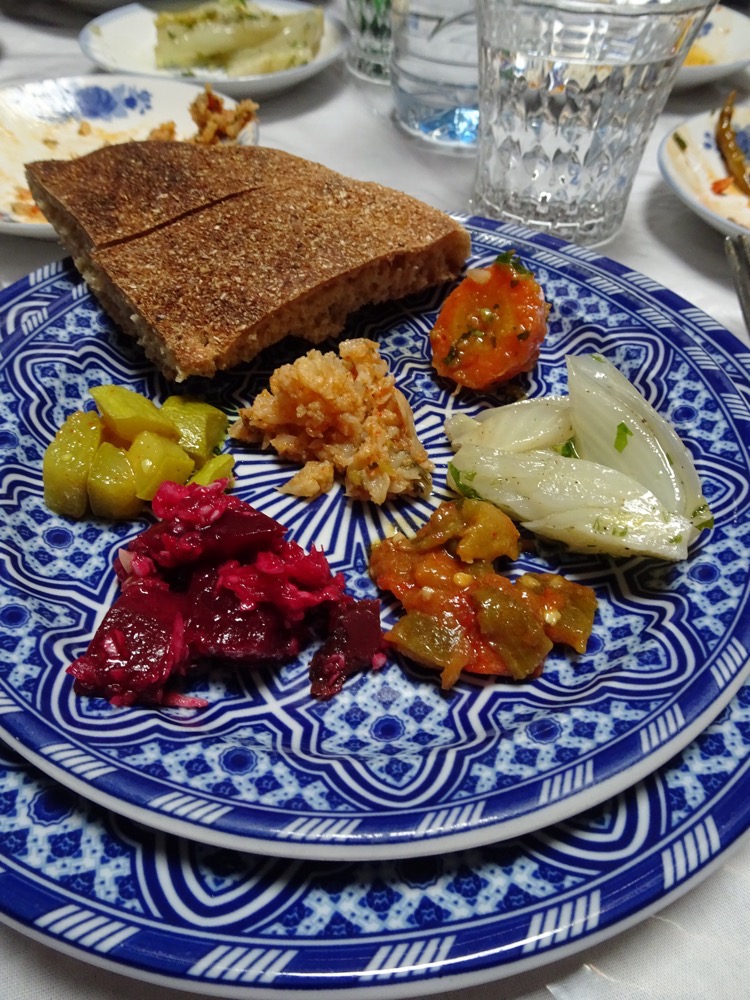 And also included some fabulous local dishes – a chicken pastille (chicken pie – shredded chicken with fruit and covered in cinamon and sugar), meatballs served with egg (this is rapidly turning into one of my fav Moroccan dishes), a beef tagine with almonds and prunes and some mixed grill skewers. Everything we’ve had here (with the exception of that first bland touristy restaurant) has been delicious.
And also included some fabulous local dishes – a chicken pastille (chicken pie – shredded chicken with fruit and covered in cinamon and sugar), meatballs served with egg (this is rapidly turning into one of my fav Moroccan dishes), a beef tagine with almonds and prunes and some mixed grill skewers. Everything we’ve had here (with the exception of that first bland touristy restaurant) has been delicious.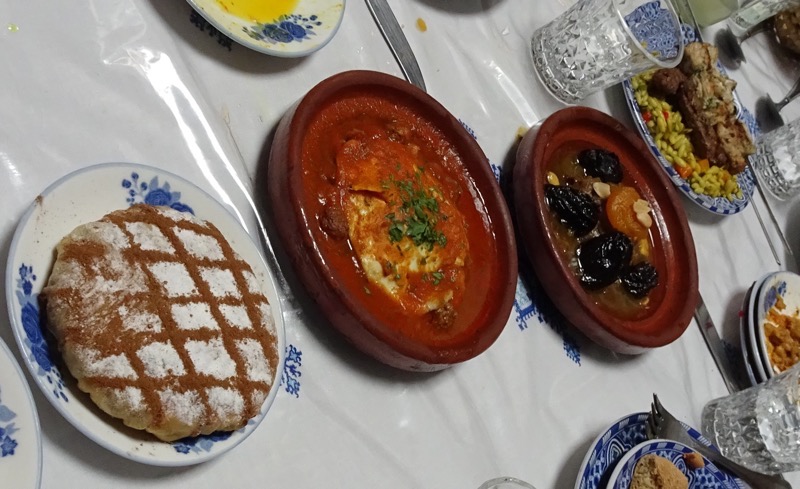 After a wonderful shared lunch, we ventured back into the medina to have a few more glimpses into the various gates leading to the mosque and mausoleum complex. The artwork and elaborate decoration on the doorways, walls everywhere you look is astounding.
After a wonderful shared lunch, we ventured back into the medina to have a few more glimpses into the various gates leading to the mosque and mausoleum complex. The artwork and elaborate decoration on the doorways, walls everywhere you look is astounding.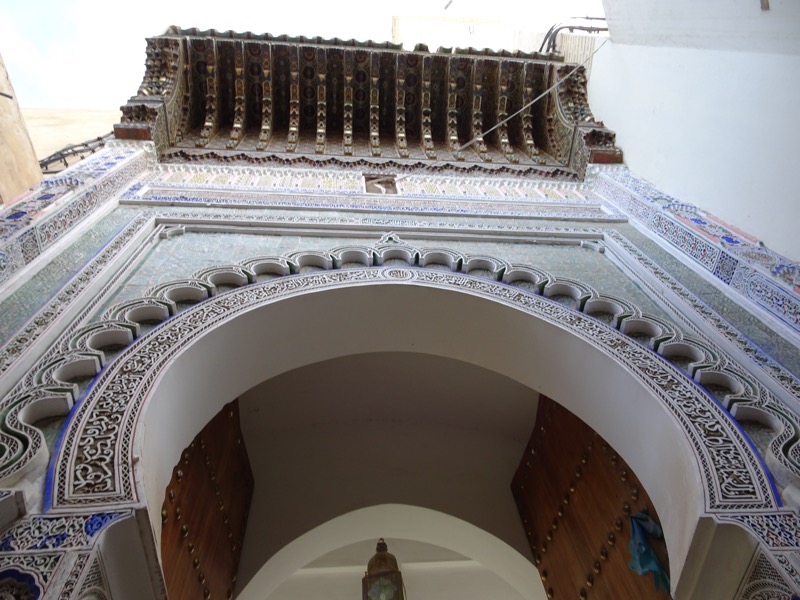
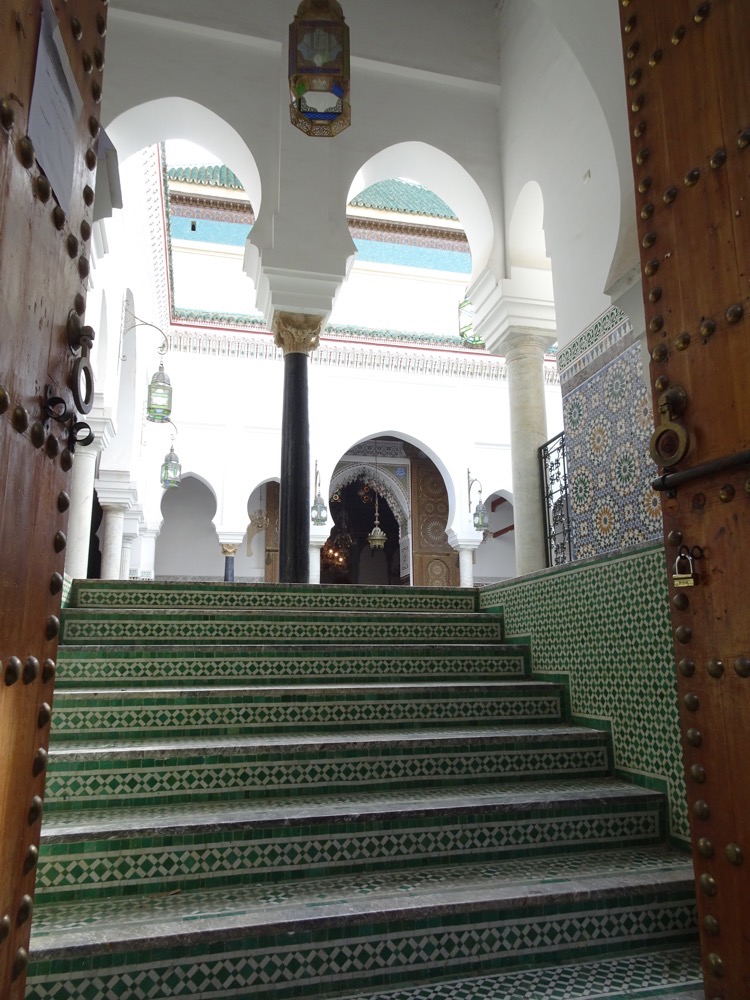
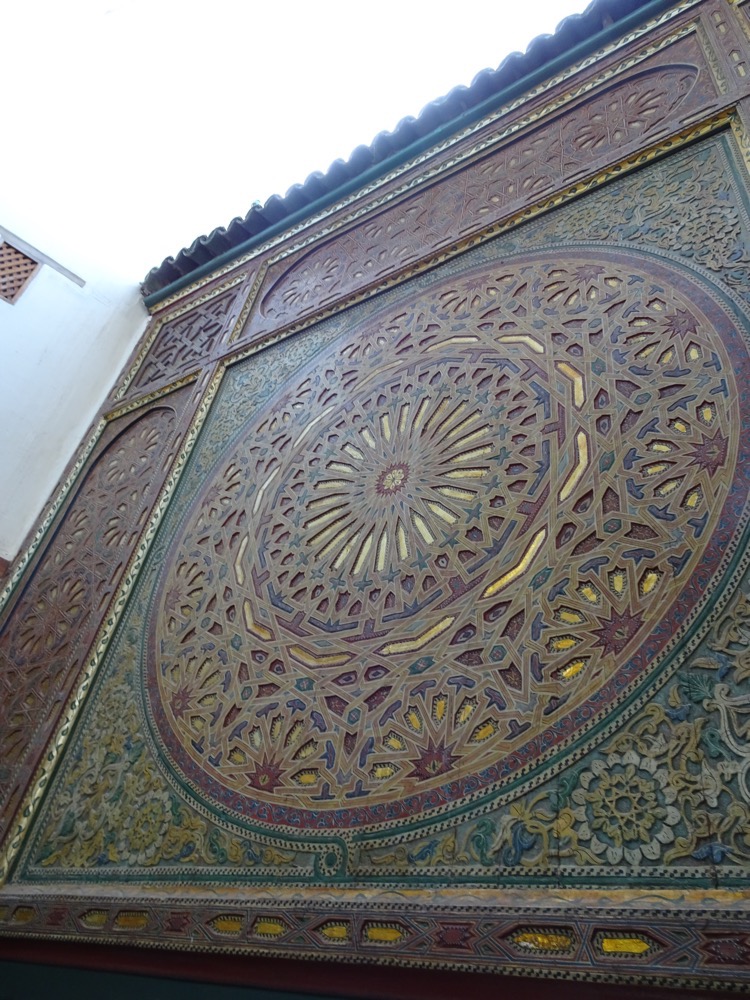
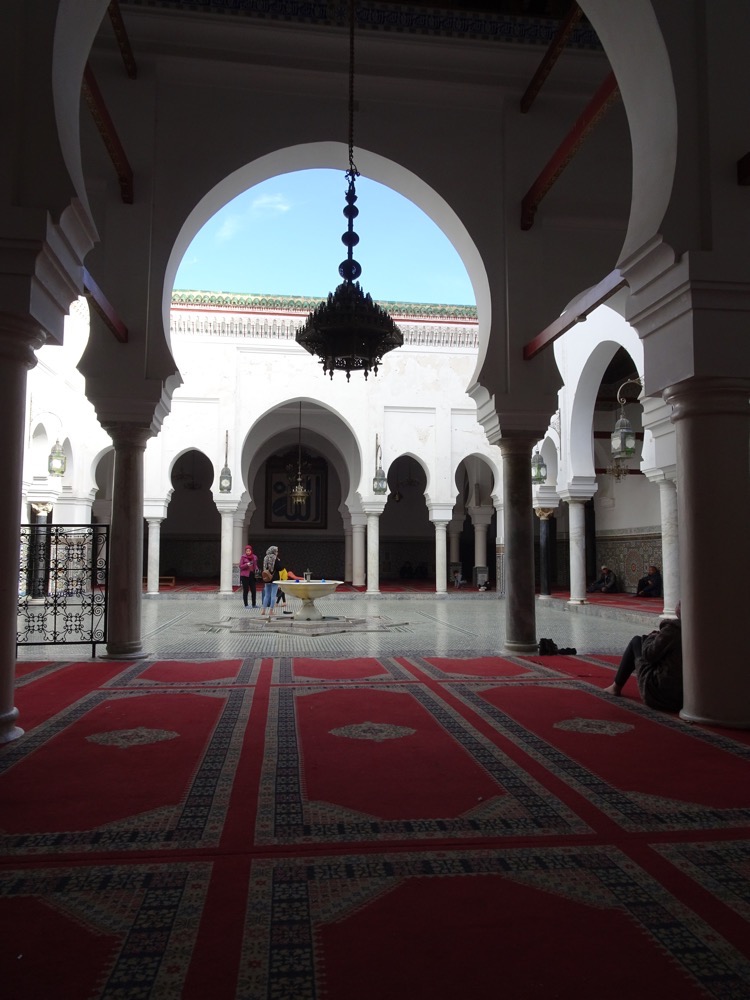
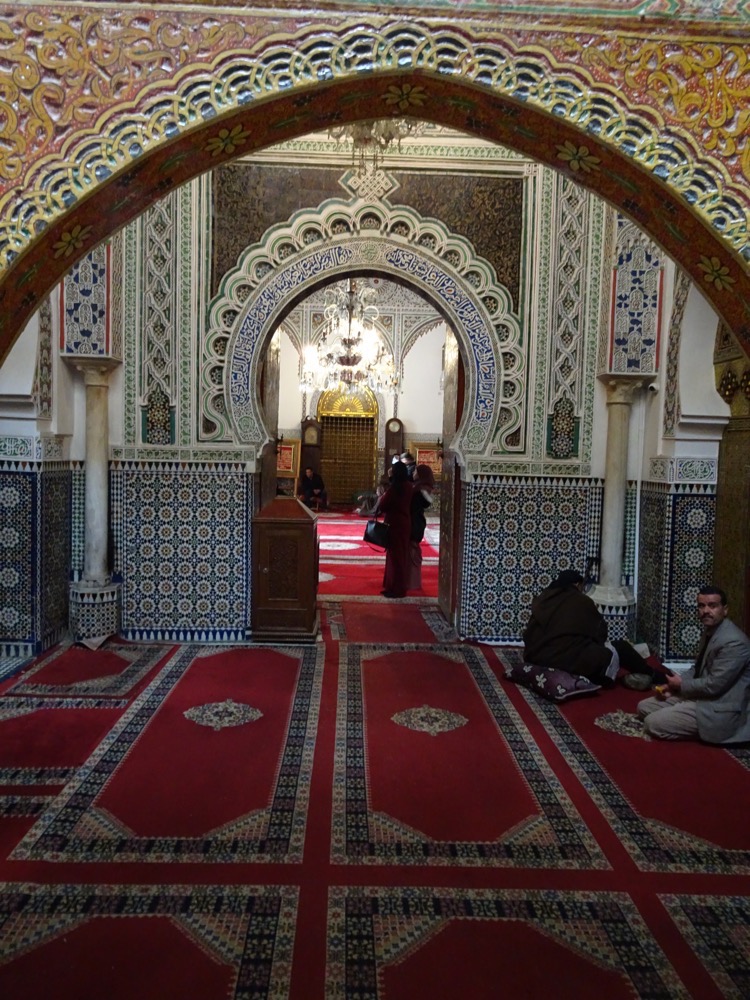

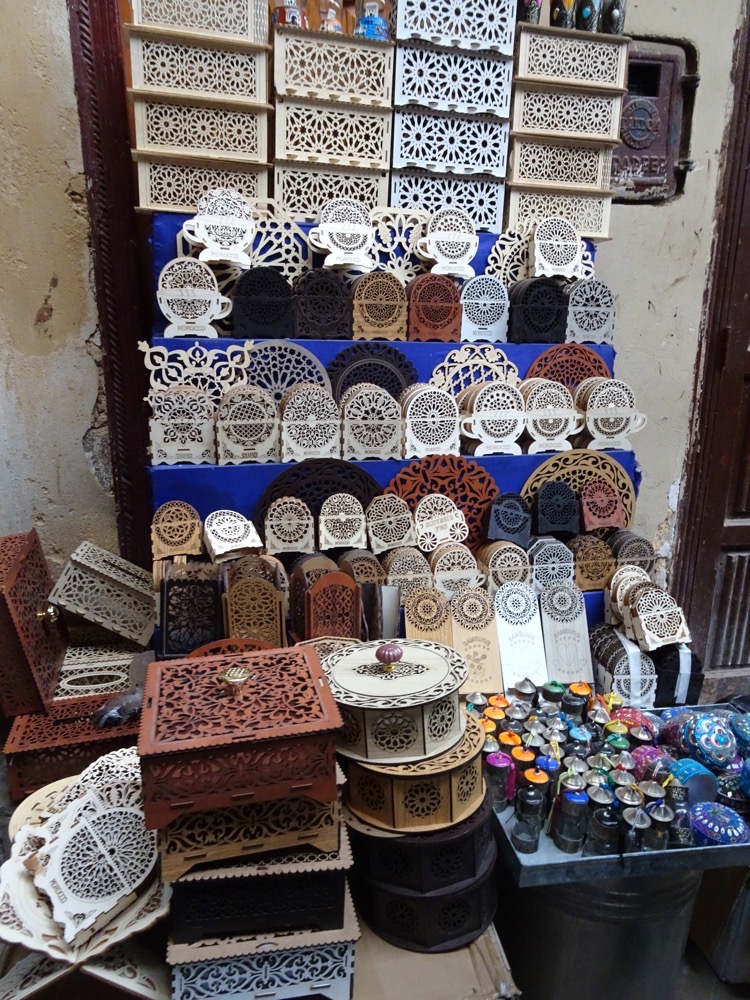 There are public fountains scattered throughout the medina, and while the water is safe for locals, tourists generally don’t have the constitution to deal with it… so it’s best avoided.
There are public fountains scattered throughout the medina, and while the water is safe for locals, tourists generally don’t have the constitution to deal with it… so it’s best avoided. 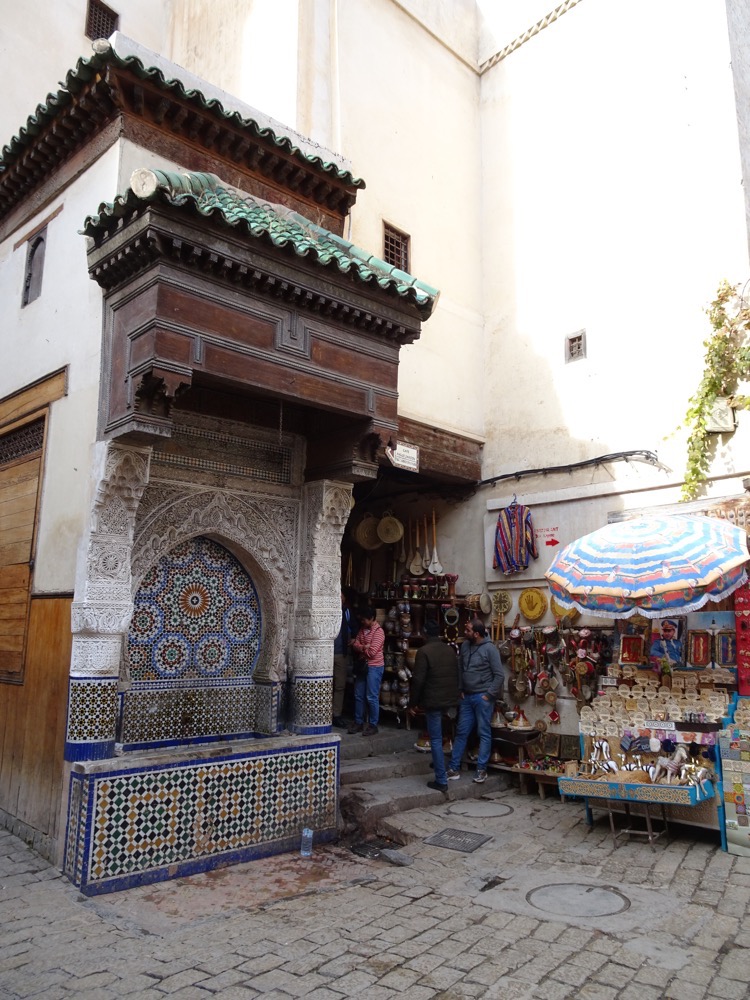 Also connected to the mosque and mausoleaum complex is the University of al-Qarawiyyin which is THE oldest existing, continually operating higher educational institution in the world (according to both UNESCO and Guinness World Records). It was founded by in 859 AD with an associated madrasa, and subsequently became one of the leading spiritual and educational centers of the historic Muslim world. It was only incorporated into Morocco’s modern state university system in 1963, but has been a formal institute of learning that entire time.
Also connected to the mosque and mausoleaum complex is the University of al-Qarawiyyin which is THE oldest existing, continually operating higher educational institution in the world (according to both UNESCO and Guinness World Records). It was founded by in 859 AD with an associated madrasa, and subsequently became one of the leading spiritual and educational centers of the historic Muslim world. It was only incorporated into Morocco’s modern state university system in 1963, but has been a formal institute of learning that entire time.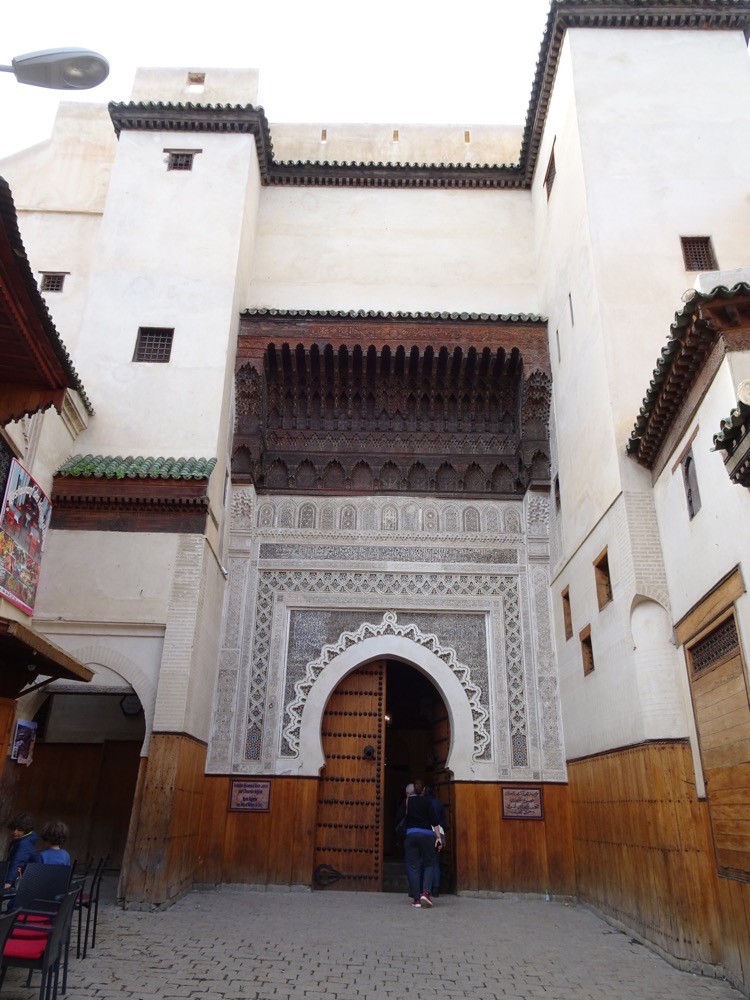
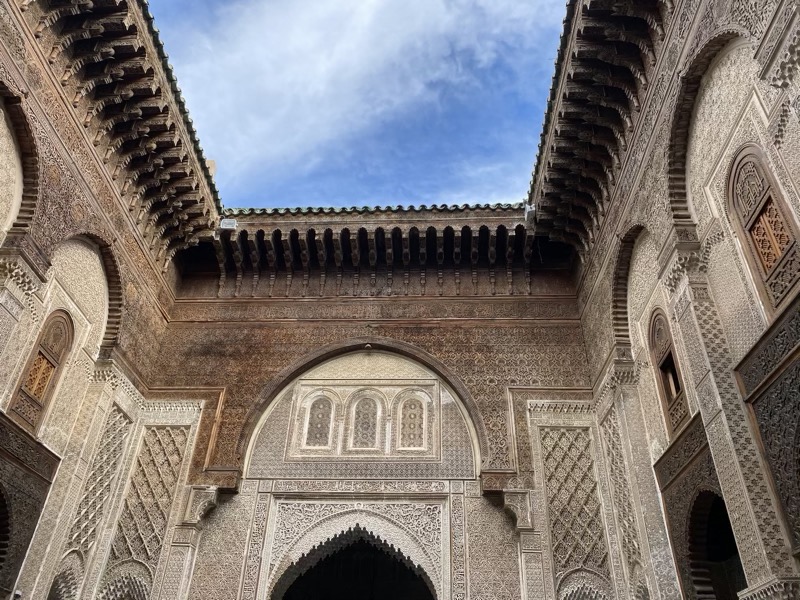
 The small windows above are cells for the scholars who lived here… each has a bare room approximately 2m x 2m where they would dedicate themselves to Islamic religious and legal studies with a heavy emphasis on Classical Arabic grammar and linguistics and Maliki law. Some other non-Islamic studies are now also offered such as French and English.
The small windows above are cells for the scholars who lived here… each has a bare room approximately 2m x 2m where they would dedicate themselves to Islamic religious and legal studies with a heavy emphasis on Classical Arabic grammar and linguistics and Maliki law. Some other non-Islamic studies are now also offered such as French and English.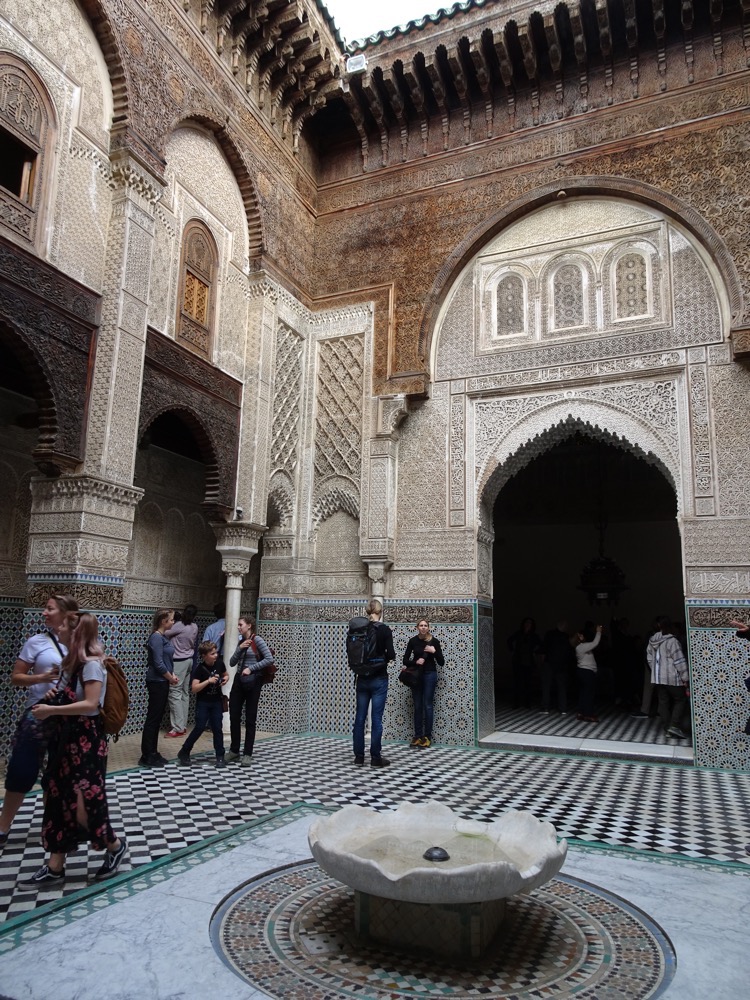
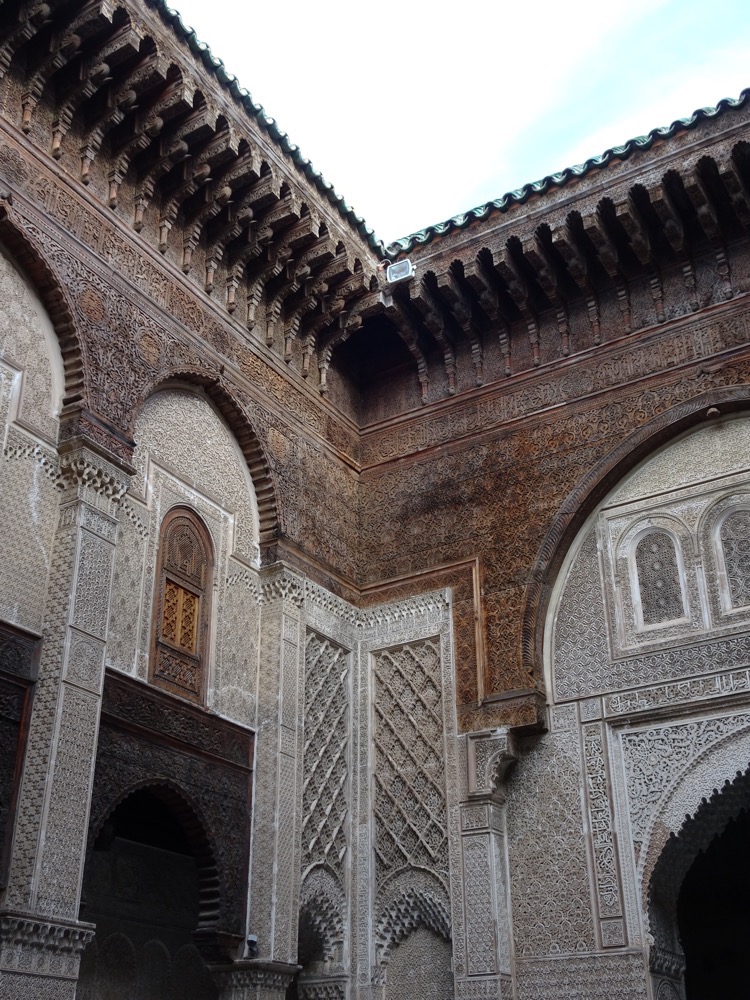
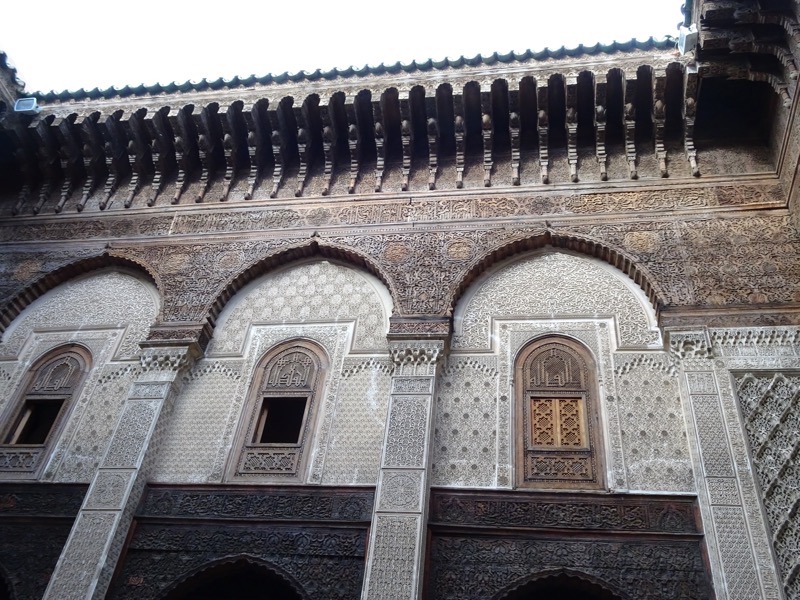
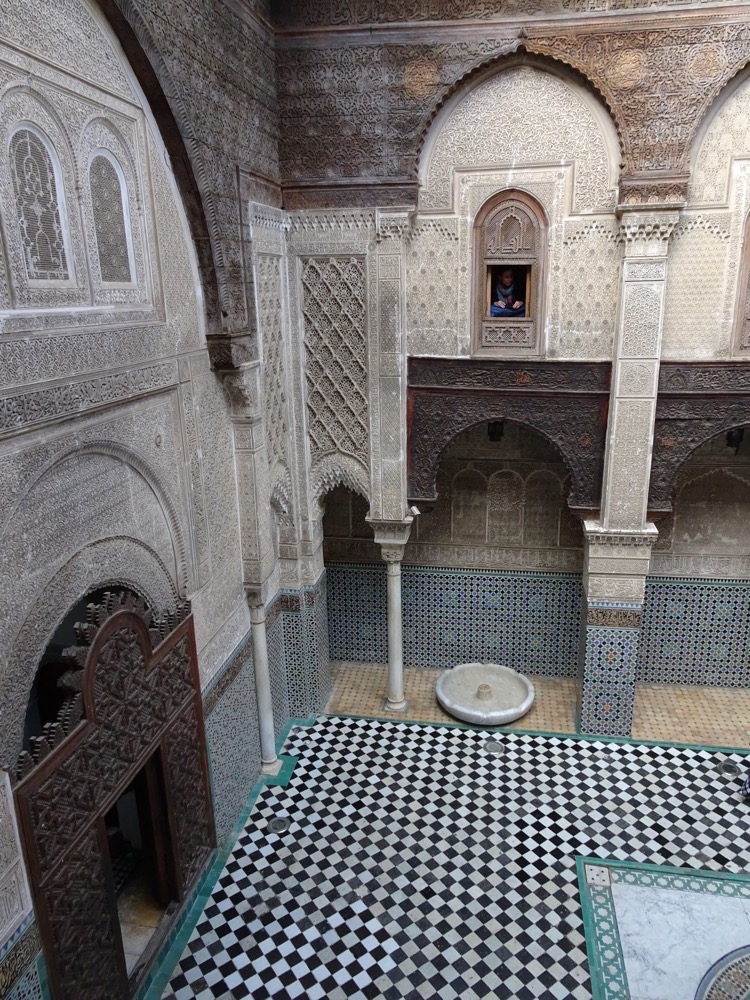
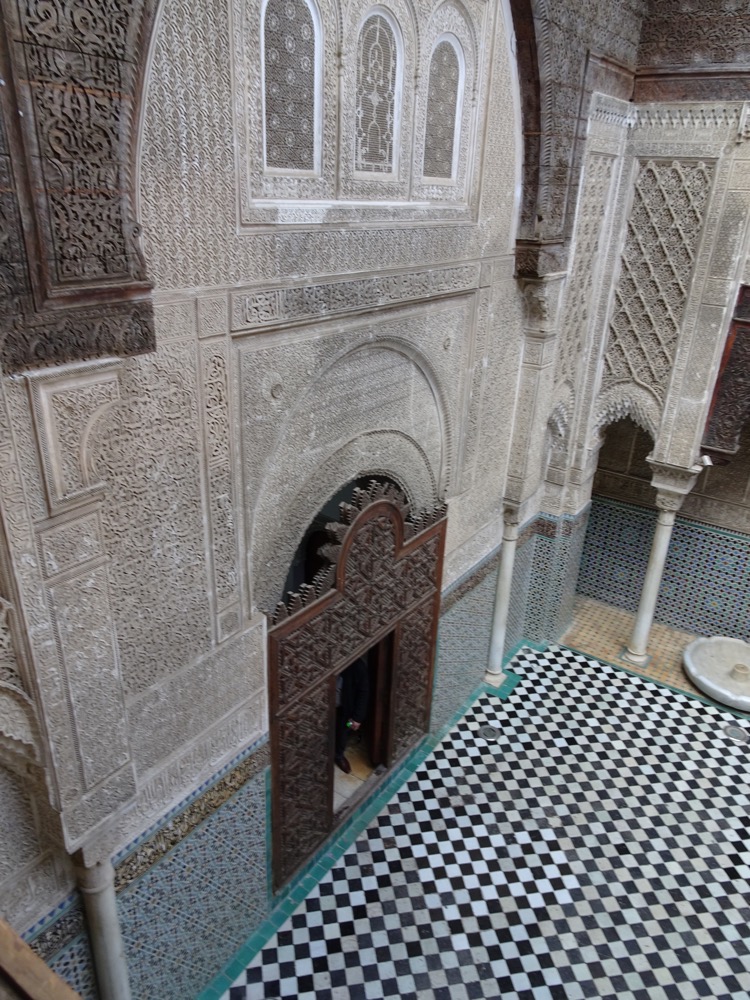 We went upstairs to see the old student’s rooms, and were somewhat perturbed to notice that there were only locks on the doors on the outside of each room and small slots at eye level in each door… it felt more like a luxiourious detention centre than a student/monk’s type cell…?
We went upstairs to see the old student’s rooms, and were somewhat perturbed to notice that there were only locks on the doors on the outside of each room and small slots at eye level in each door… it felt more like a luxiourious detention centre than a student/monk’s type cell…?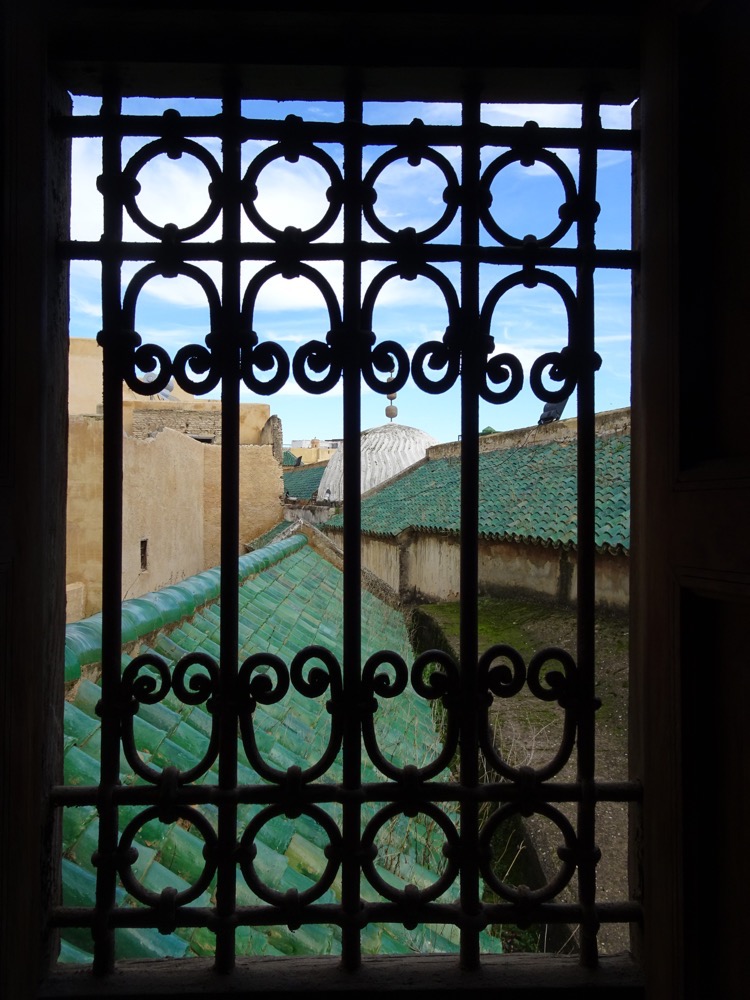 After our visit to the monastery, we made our way deep into the textiles sector of the medina – now THIS, I was really looking forward to. I was hoping to gain some insight into the sabra silk situation and find out whether it is made from the agave plant or no. We saw a demonstration of someone weaving on an old treadle loom, and the man who seemed to run/own the shop handed around pieces of agave and told us the sabra silk is made from agave fibres. It certainly seems fibrous enough to create a thread – but we weren’t offered any more information than that. From there it was ‘on with the hard sell’, which was a bit unfortunate as we hadn’t experienced this in the ceramics workshop or the tannery.
After our visit to the monastery, we made our way deep into the textiles sector of the medina – now THIS, I was really looking forward to. I was hoping to gain some insight into the sabra silk situation and find out whether it is made from the agave plant or no. We saw a demonstration of someone weaving on an old treadle loom, and the man who seemed to run/own the shop handed around pieces of agave and told us the sabra silk is made from agave fibres. It certainly seems fibrous enough to create a thread – but we weren’t offered any more information than that. From there it was ‘on with the hard sell’, which was a bit unfortunate as we hadn’t experienced this in the ceramics workshop or the tannery. 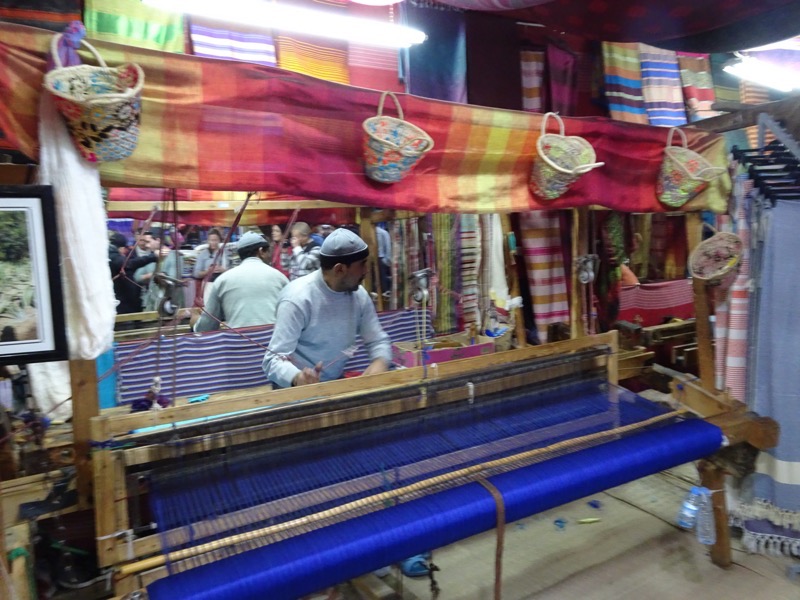 The ‘sabra silk’ items were mostly tablecloths and other durable items that most definitely felt somewhat ‘plasticy’ so I dare say it was all rayon and roughly woven at that. There was also loads and loads of pashmina and various garments, huge cotton tassels – no doubt all of which was imported.
The ‘sabra silk’ items were mostly tablecloths and other durable items that most definitely felt somewhat ‘plasticy’ so I dare say it was all rayon and roughly woven at that. There was also loads and loads of pashmina and various garments, huge cotton tassels – no doubt all of which was imported. 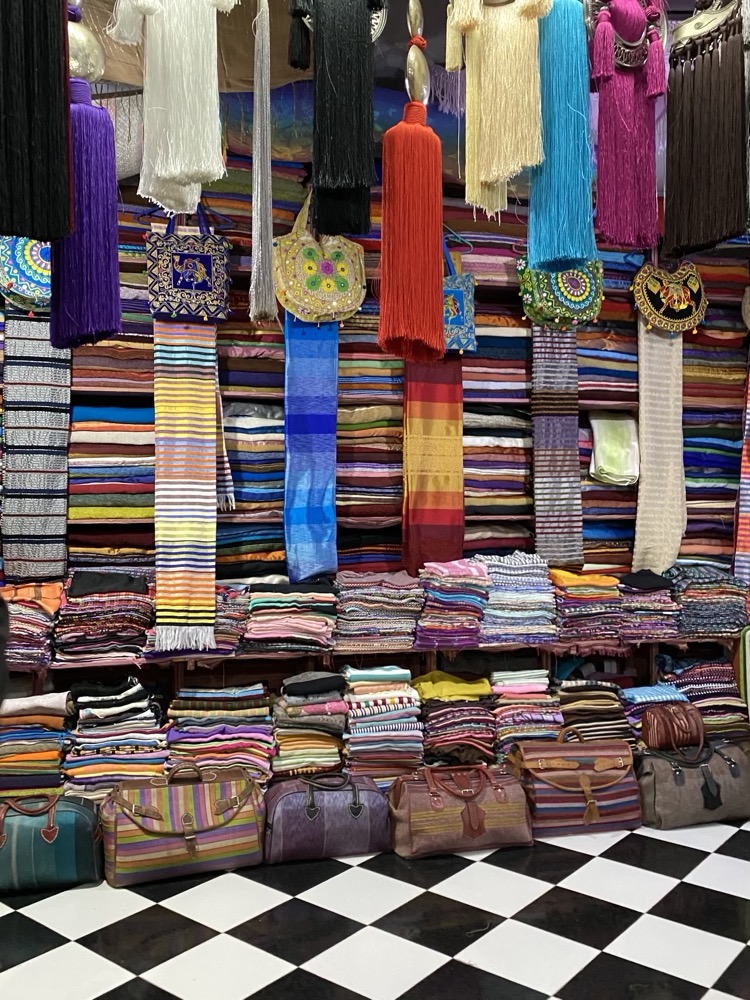
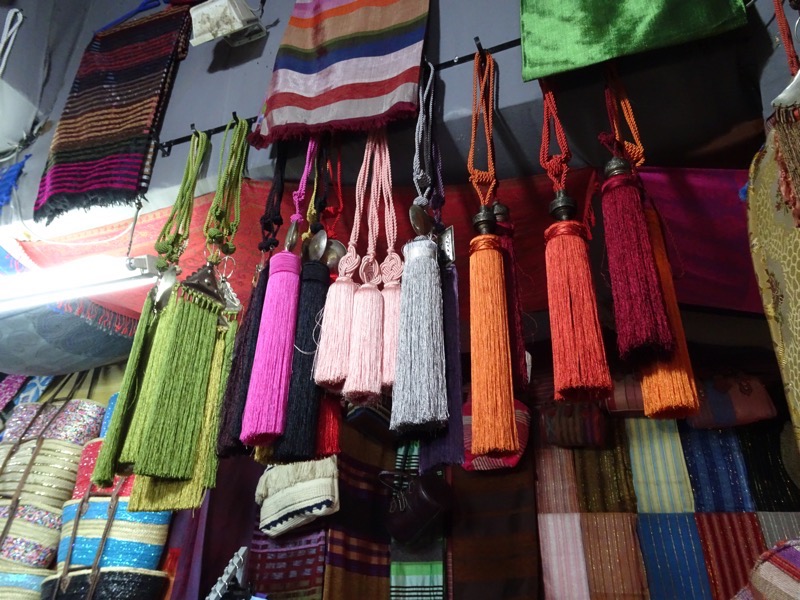
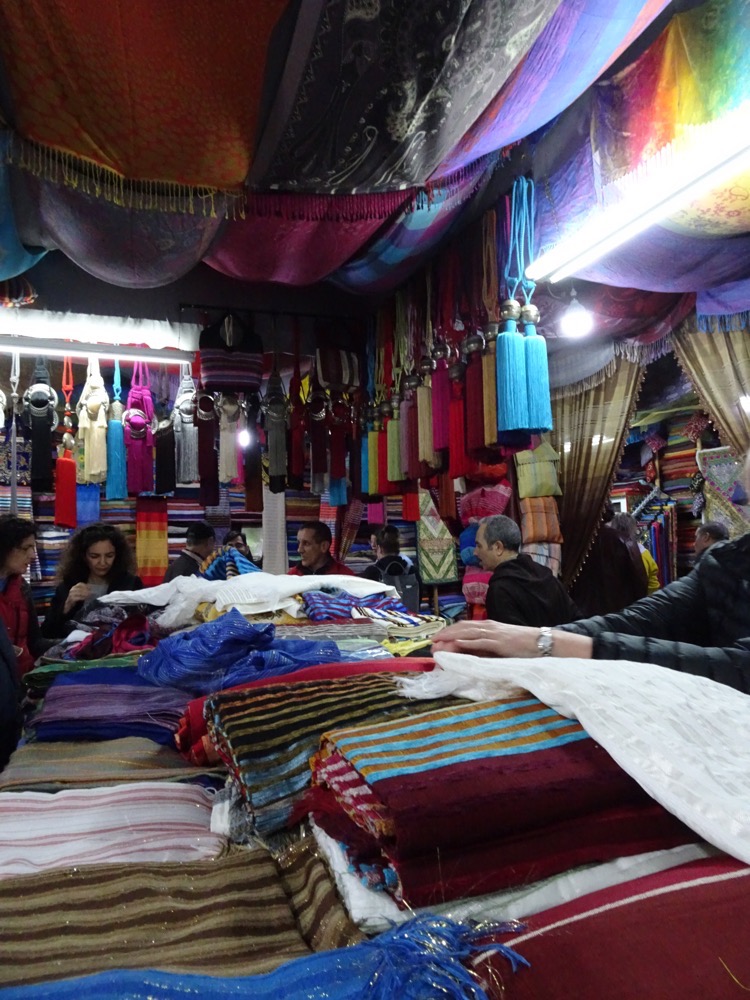 After this we were pretty much all medina’d out. Some of our group went on their own to find some more shopping and hunt for bargains, and some of us head back to the hotel to rest our weary feet. All up, it was an amazing day with so many sights and so much to see, but now I’m fucking exhausted! So it was back to the hotel for me for a chill evening of writing.
After this we were pretty much all medina’d out. Some of our group went on their own to find some more shopping and hunt for bargains, and some of us head back to the hotel to rest our weary feet. All up, it was an amazing day with so many sights and so much to see, but now I’m fucking exhausted! So it was back to the hotel for me for a chill evening of writing.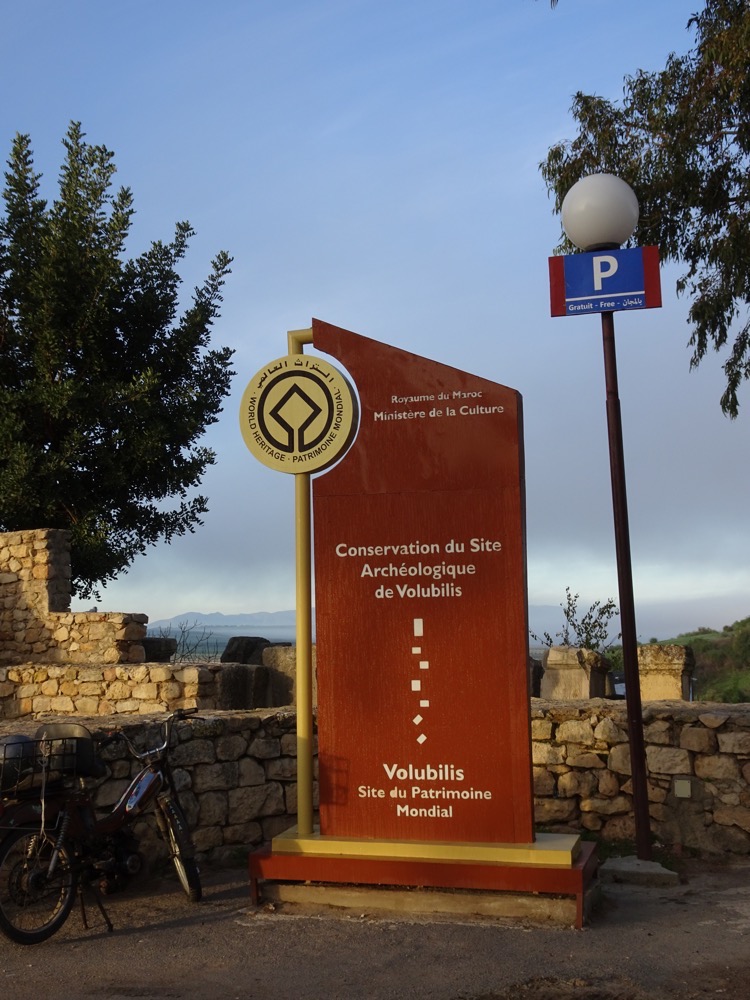
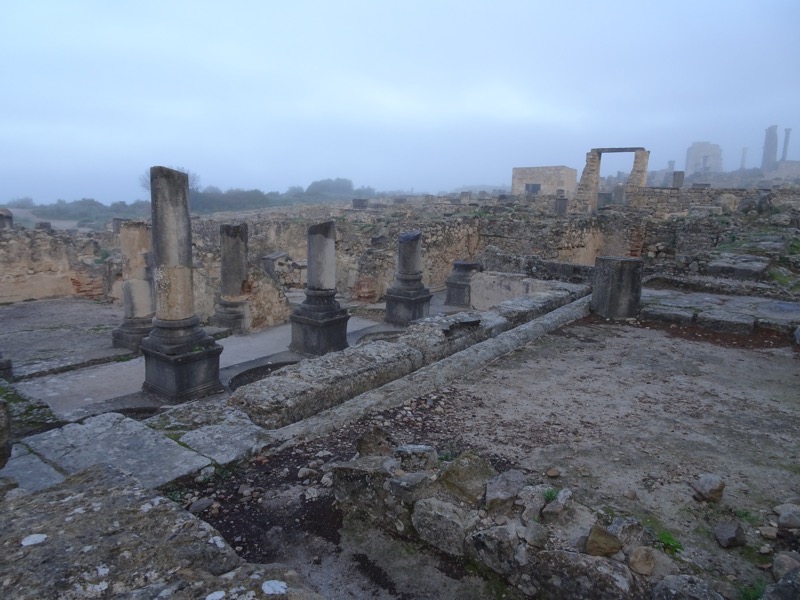
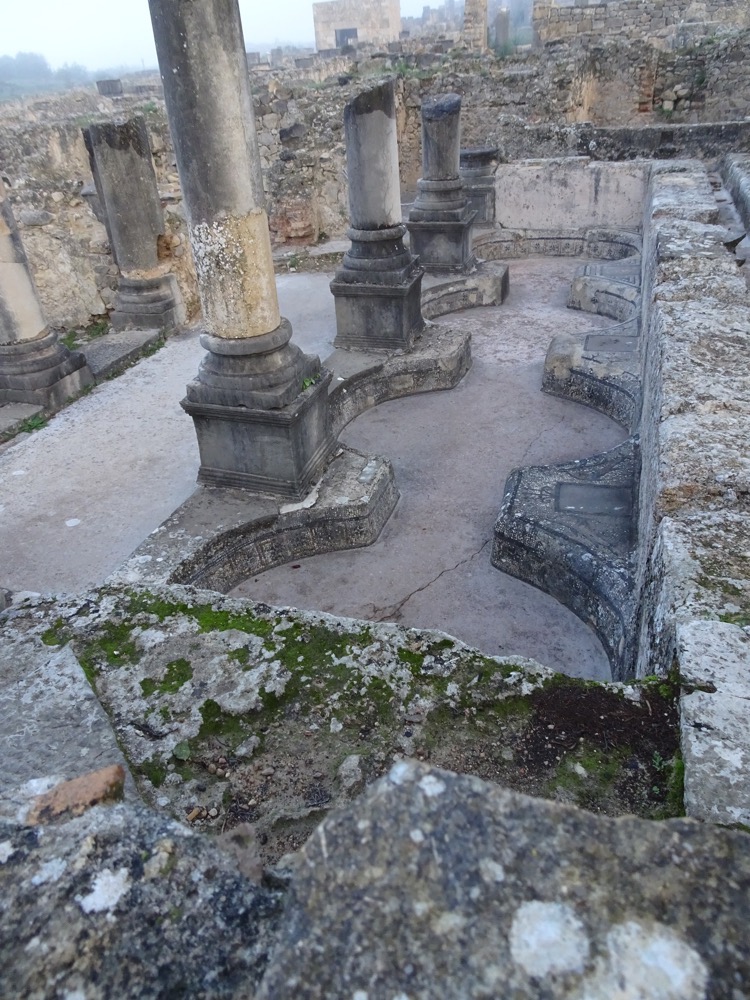
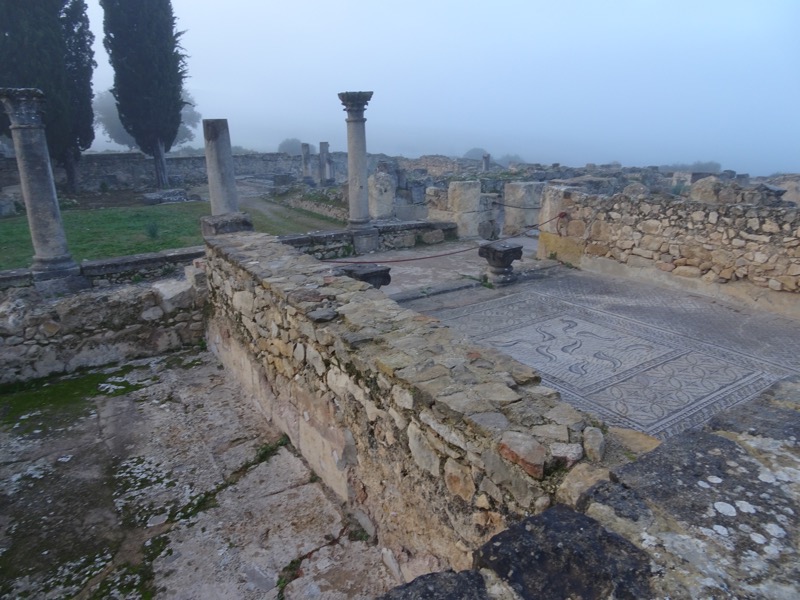 A terrace that would have been an open courtyard for dining with lovely dolphins in the mosaic floors.
A terrace that would have been an open courtyard for dining with lovely dolphins in the mosaic floors.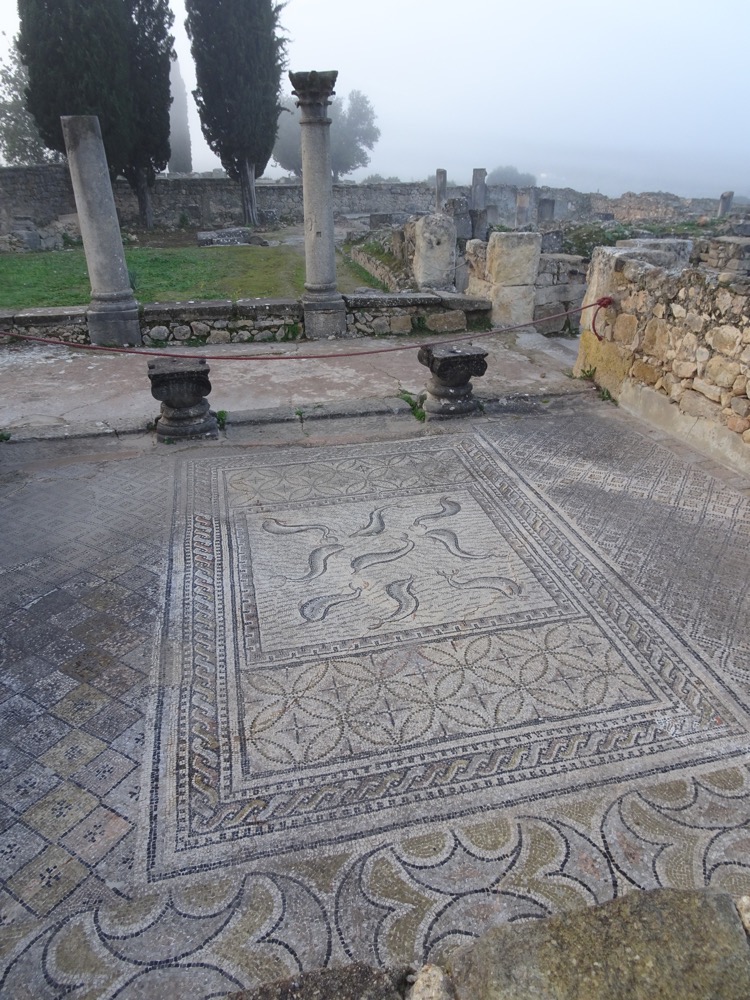
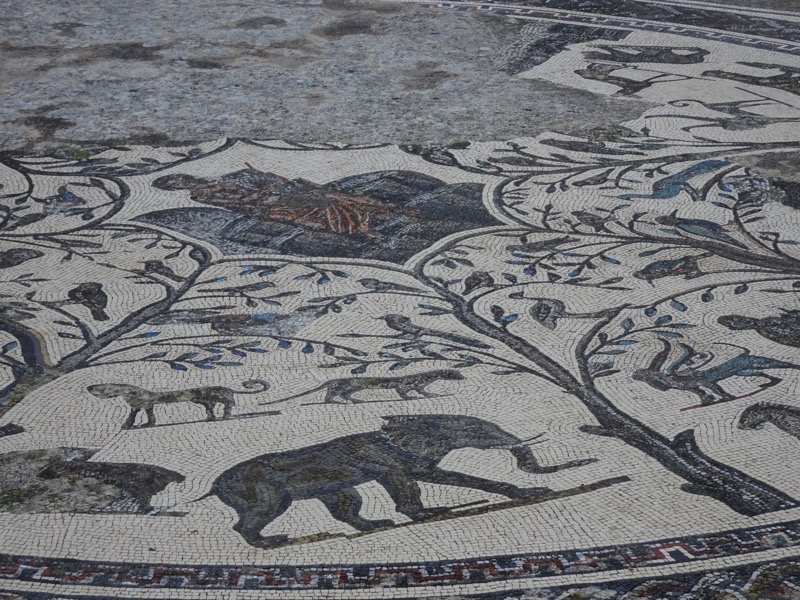
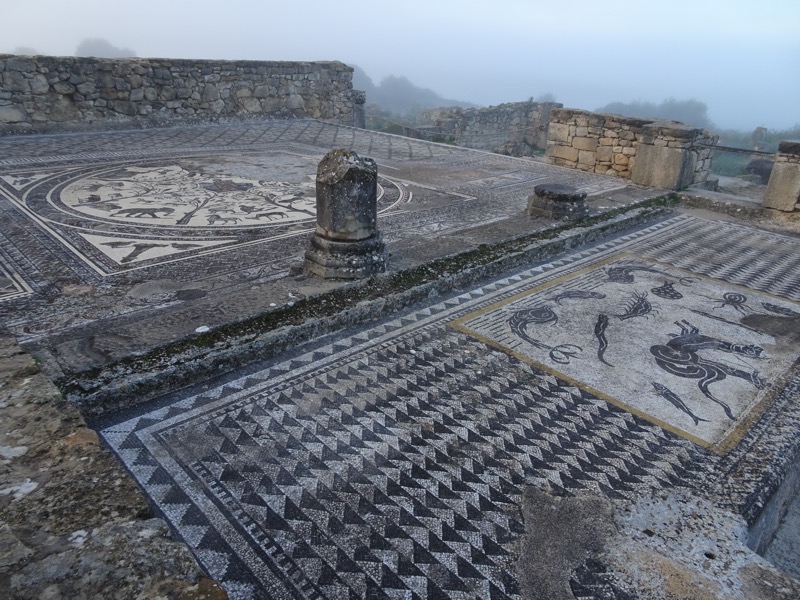
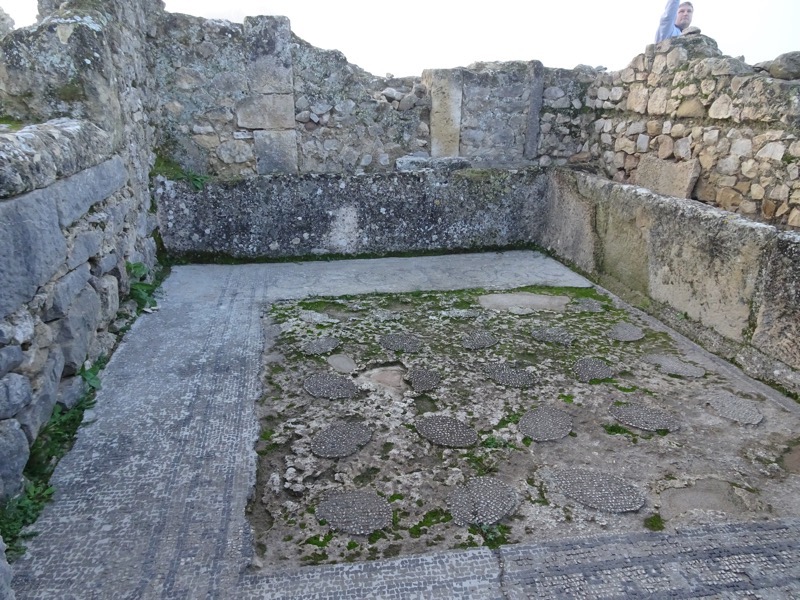 Being made of natural stone rather than ceramic, the mosaics are in incredible condition given their age and the disruptions to the civilization here.
Being made of natural stone rather than ceramic, the mosaics are in incredible condition given their age and the disruptions to the civilization here. 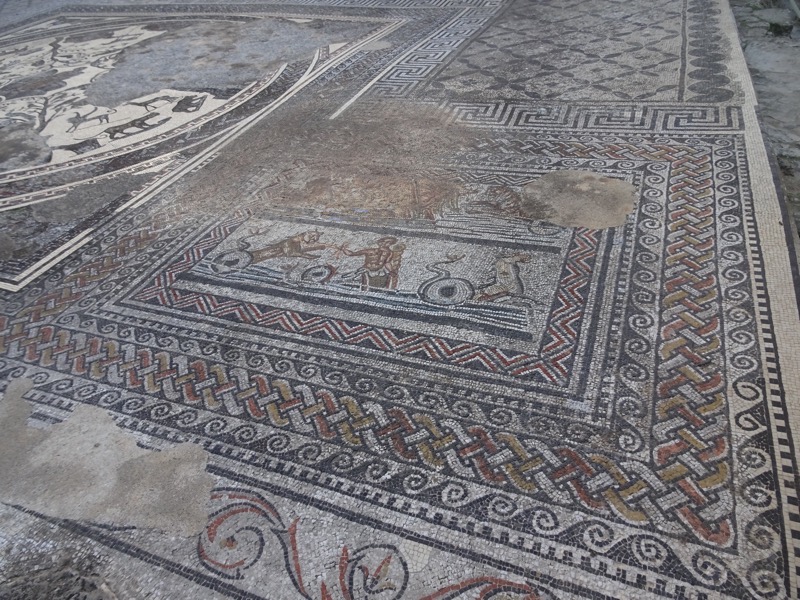 A reconstructed olive press that shows how the town made much of its wealth:
A reconstructed olive press that shows how the town made much of its wealth: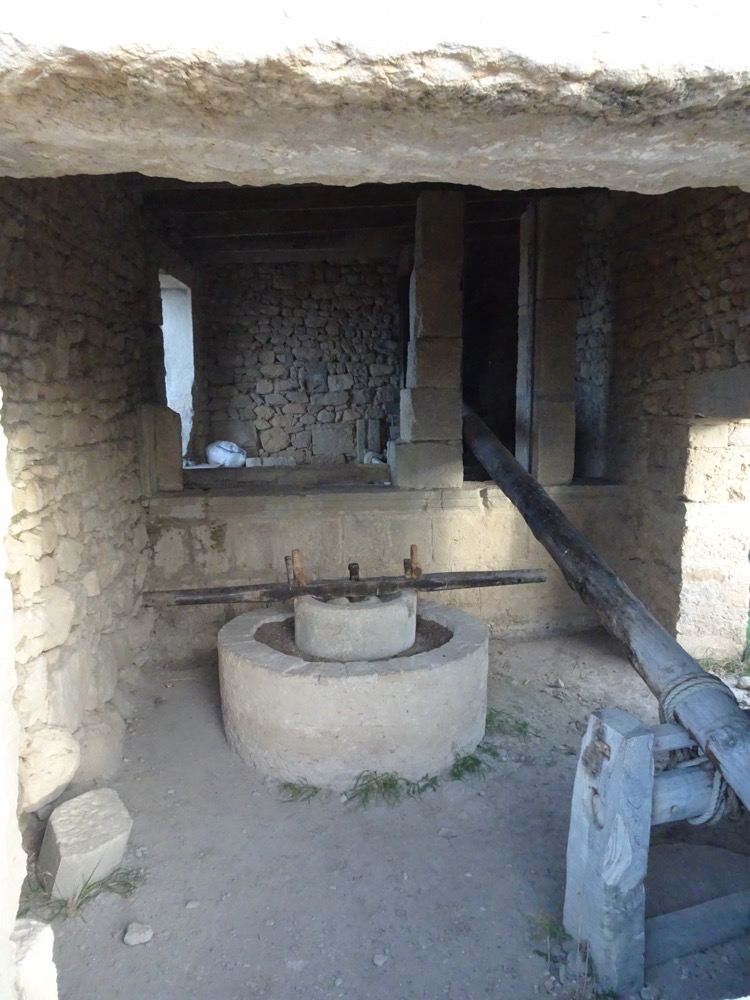 We arrived at the site very early and were the first visitors, so we had the place predominantly to ourselves… there was a very moody early morning fog that lifted about half an hour after we arrived.
We arrived at the site very early and were the first visitors, so we had the place predominantly to ourselves… there was a very moody early morning fog that lifted about half an hour after we arrived.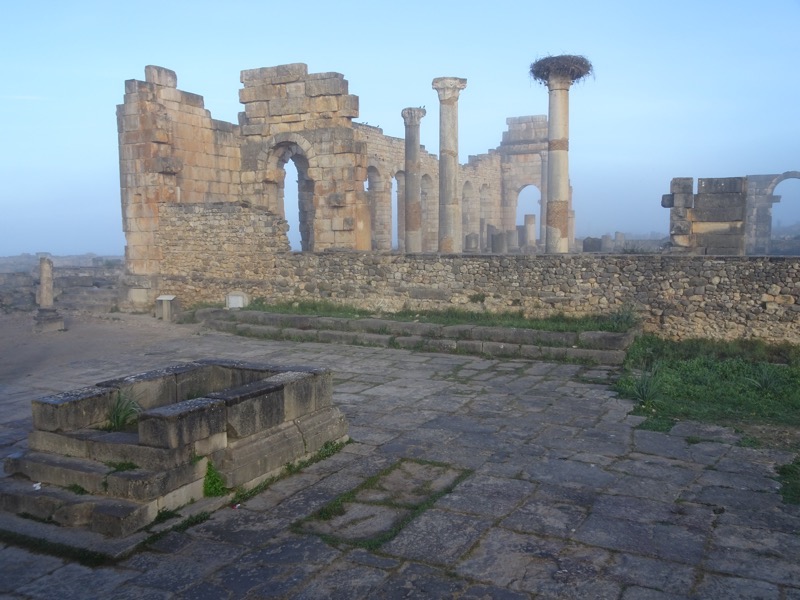
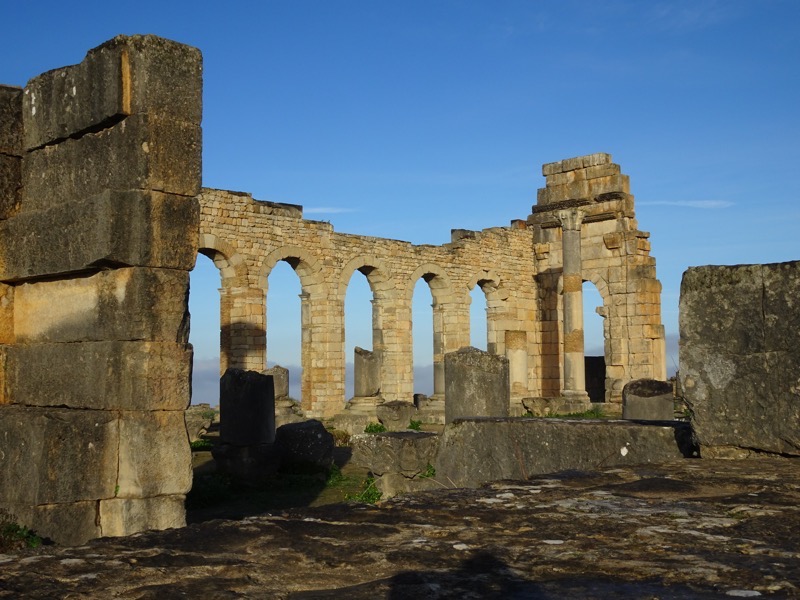 The tops of ancient columns seem to be a favoured place for swallows and storks to build their nests…
The tops of ancient columns seem to be a favoured place for swallows and storks to build their nests…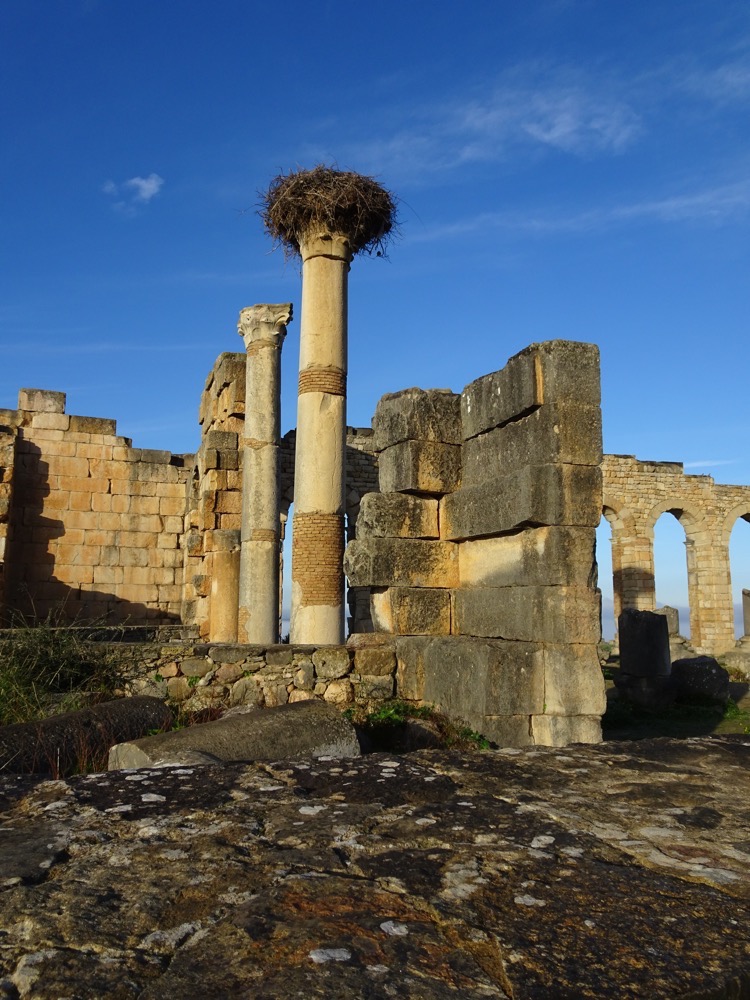 Front facade of the Basilica
Front facade of the Basilica 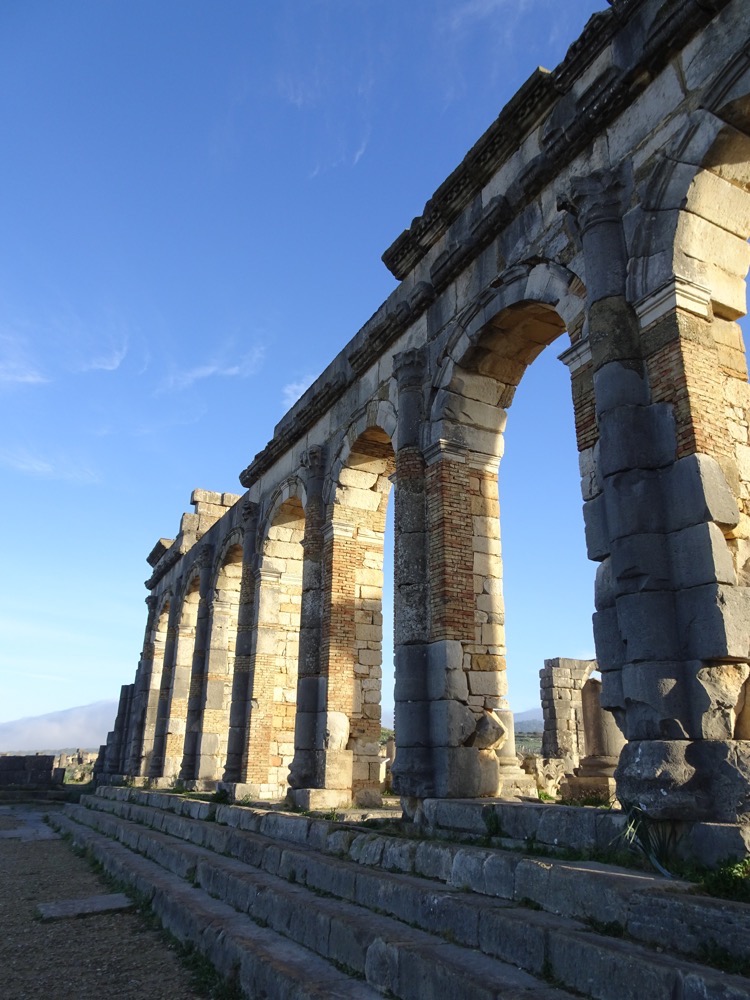
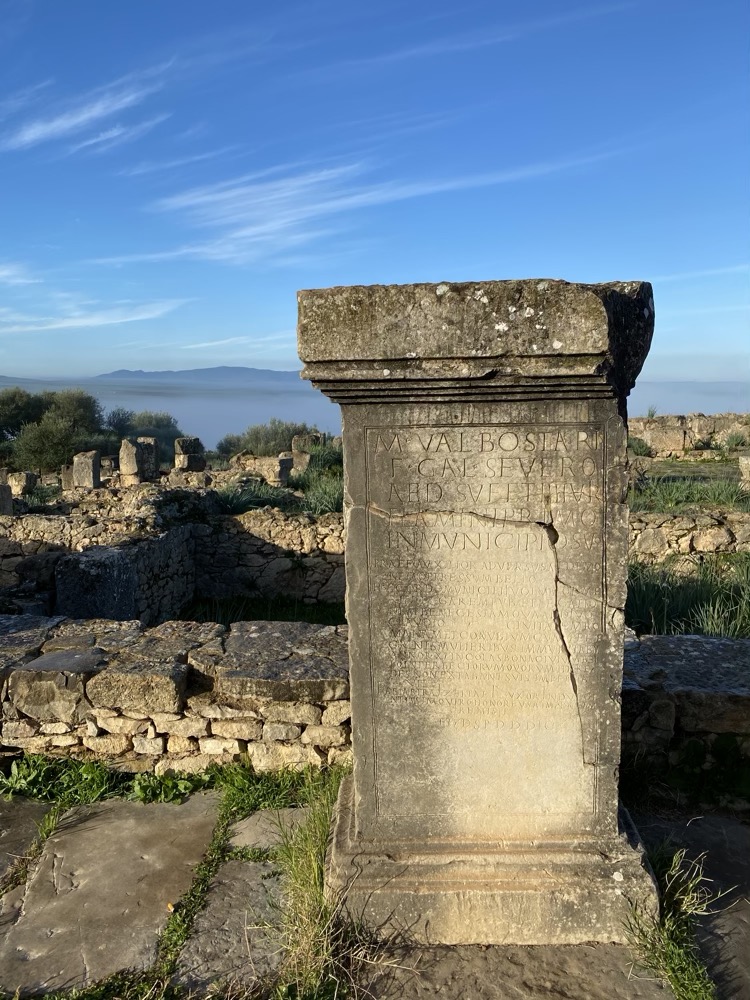 Interior of the Basilica
Interior of the Basilica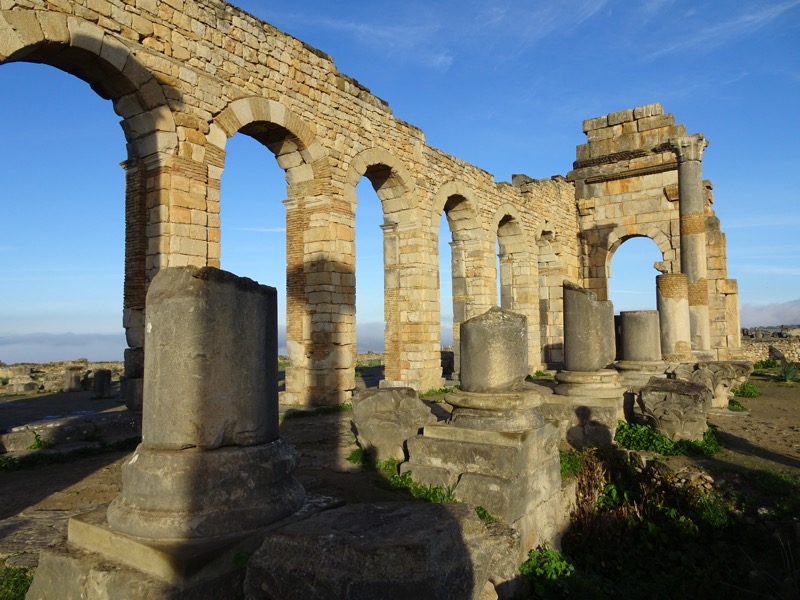
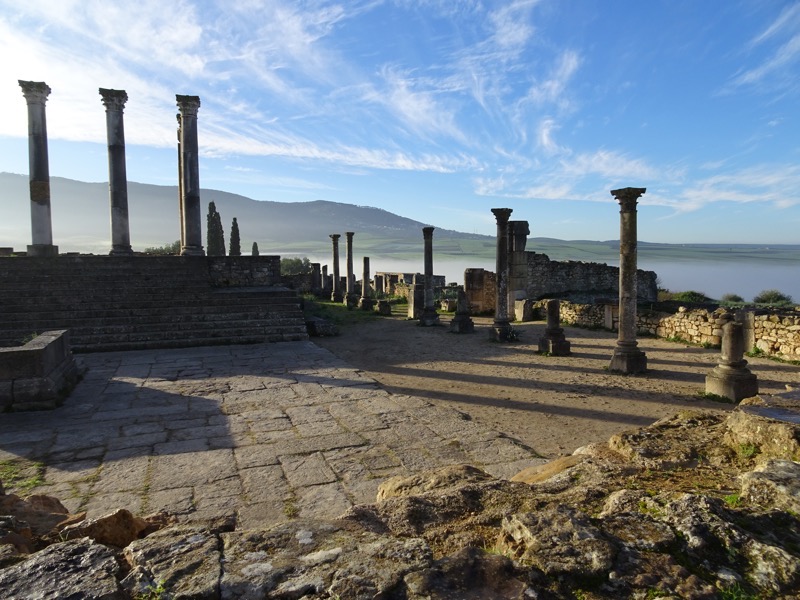
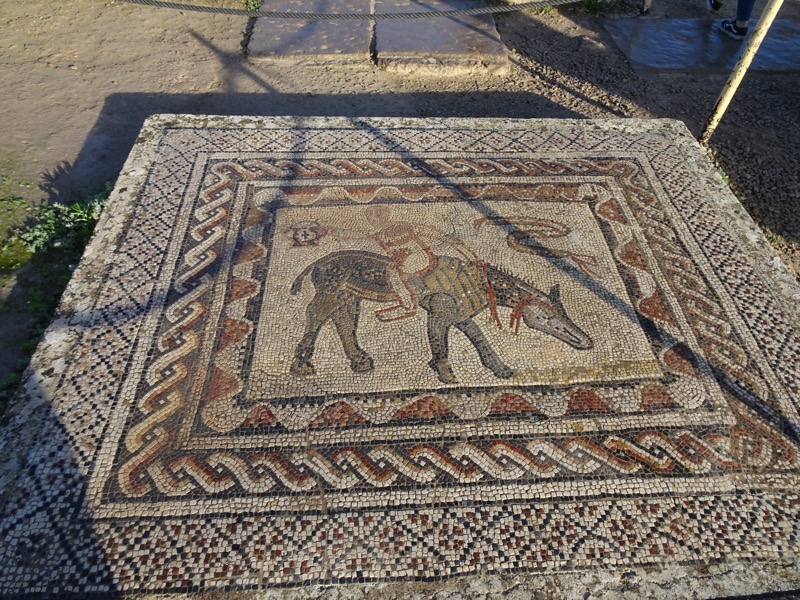
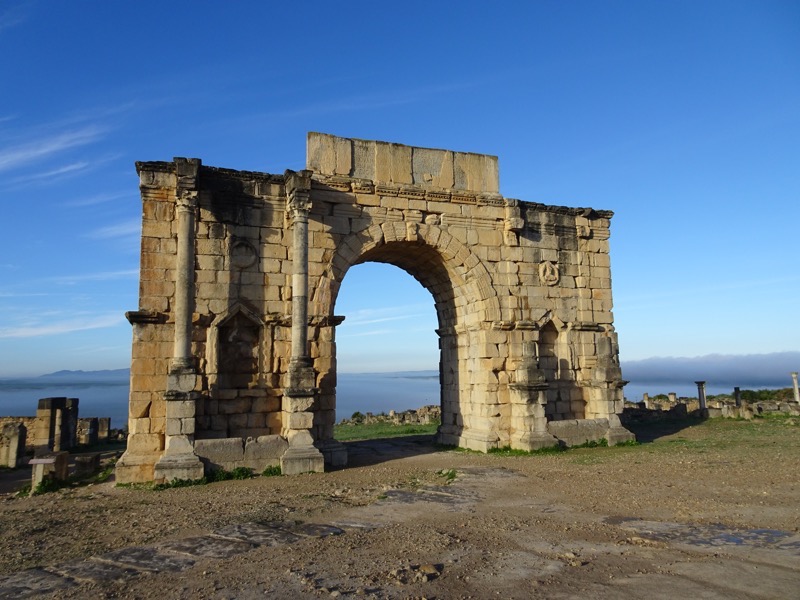
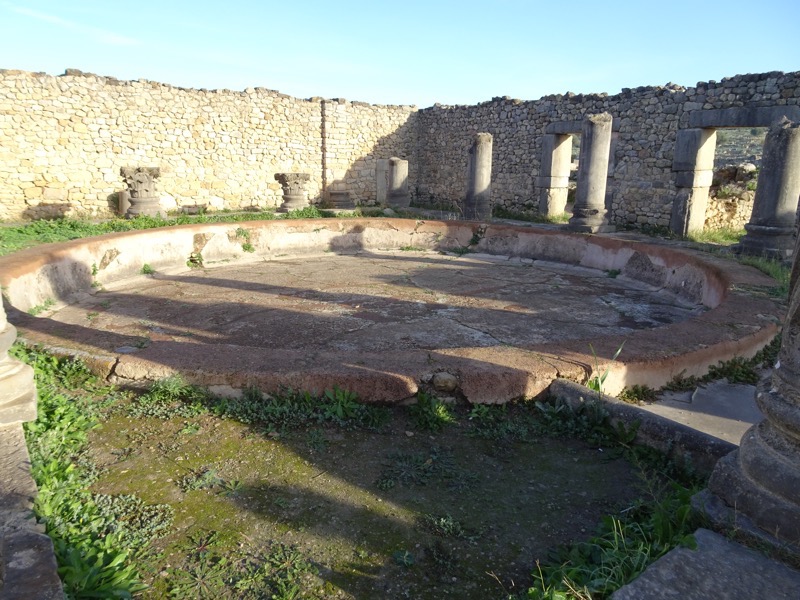
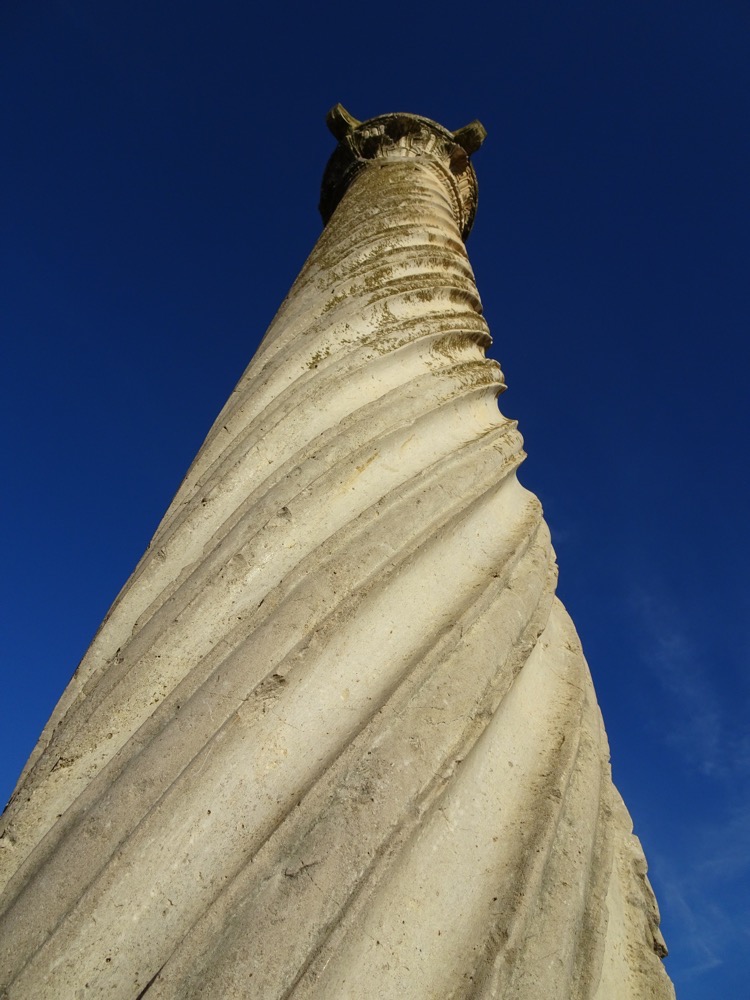 A somewhat damaged mosaic depicting the Goddess DIana… Diana herself has been removed from the mosaic, most likely by the French who took many artefacts from the site and sent them back to France.
A somewhat damaged mosaic depicting the Goddess DIana… Diana herself has been removed from the mosaic, most likely by the French who took many artefacts from the site and sent them back to France.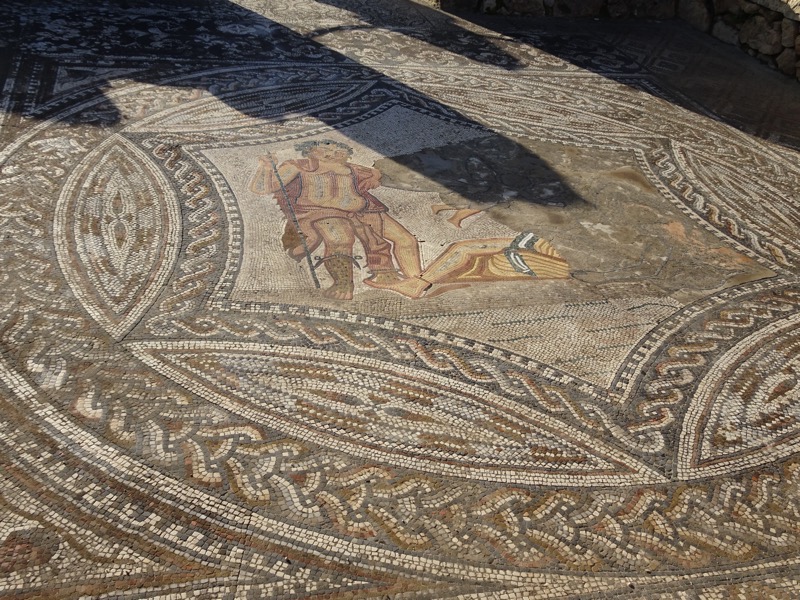 This wonderful, large terrace space depicts the Twelve Trials of Hercules.
This wonderful, large terrace space depicts the Twelve Trials of Hercules.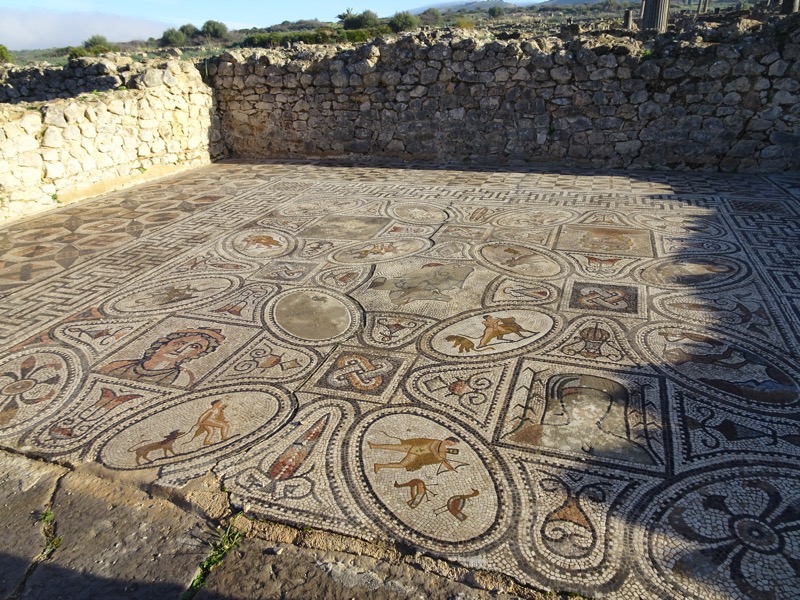
 Shooting lions, wrestling pheasants, that sort of thing…
Shooting lions, wrestling pheasants, that sort of thing… A spa area which had a fountain in the middle and visitors could sit in the semicircular cut out spaces and enjoy the fresh waters from the fountains.
A spa area which had a fountain in the middle and visitors could sit in the semicircular cut out spaces and enjoy the fresh waters from the fountains.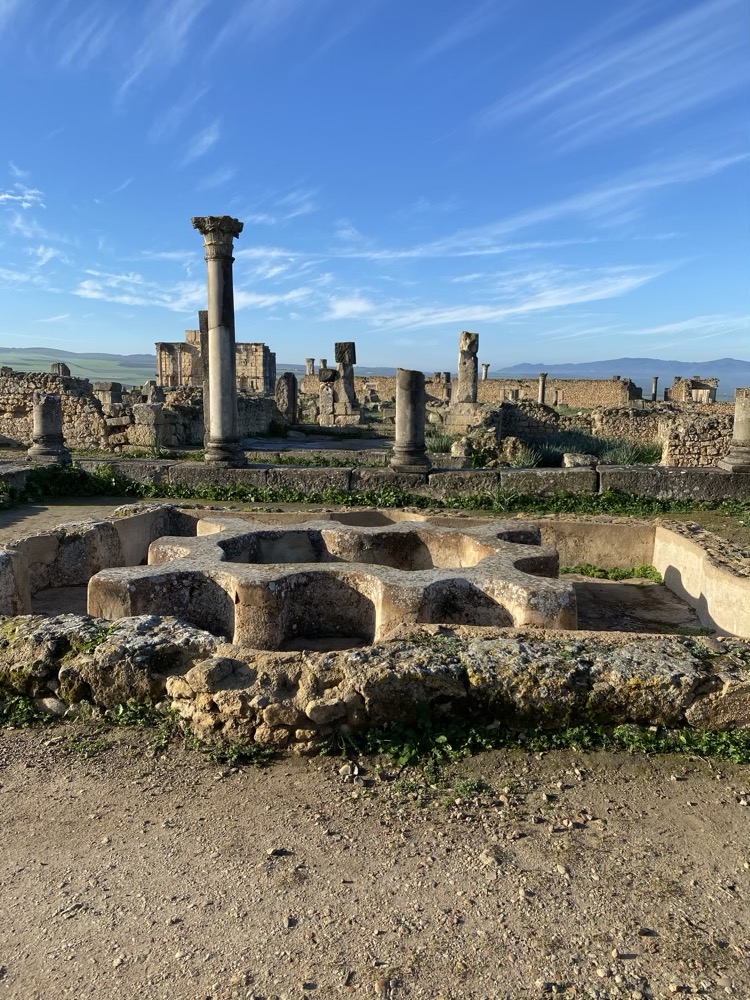
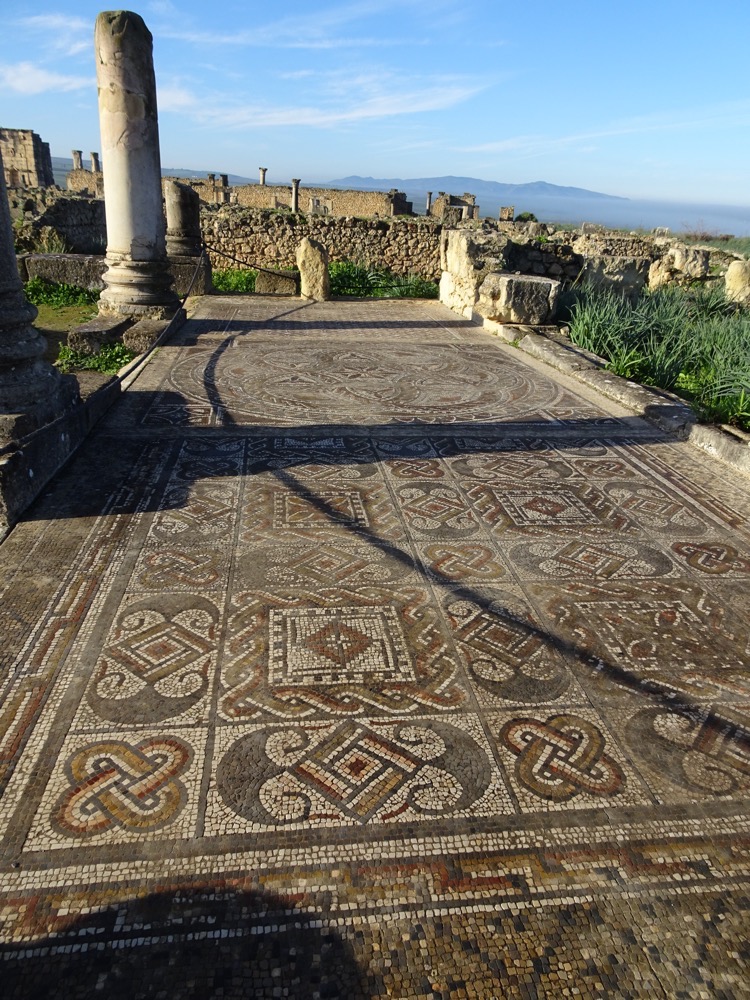 The Four Seasons depicted in the floors of the House of Hercules.
The Four Seasons depicted in the floors of the House of Hercules. 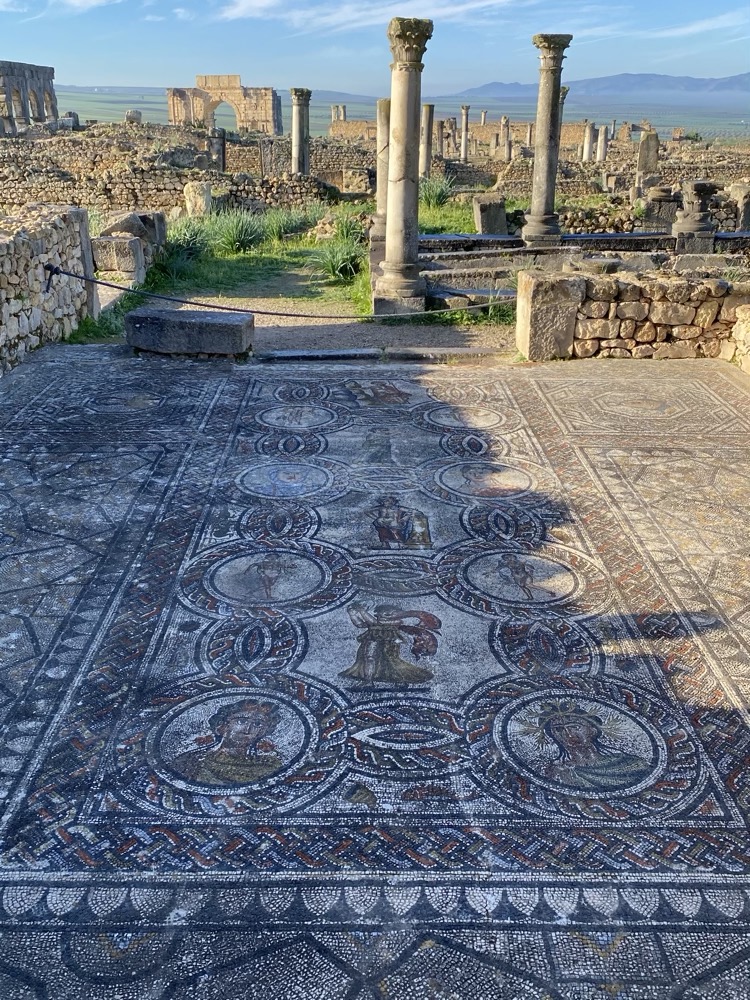

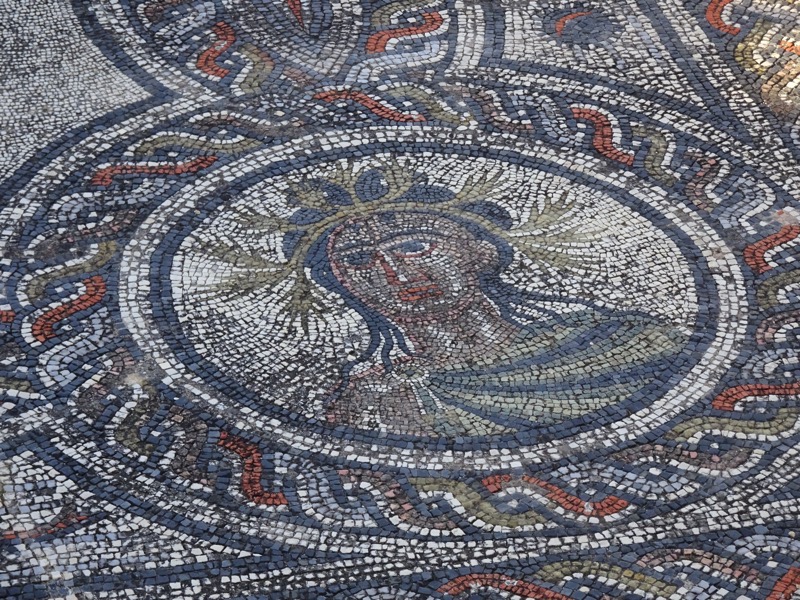
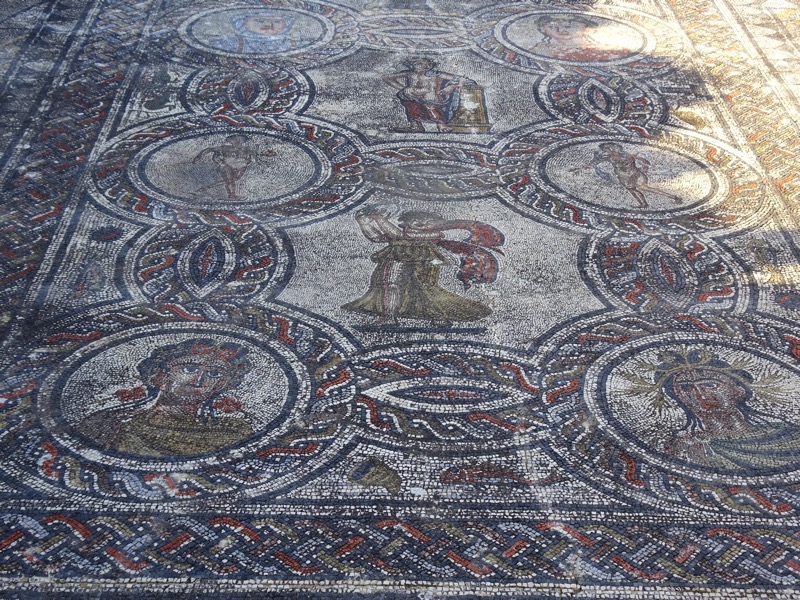
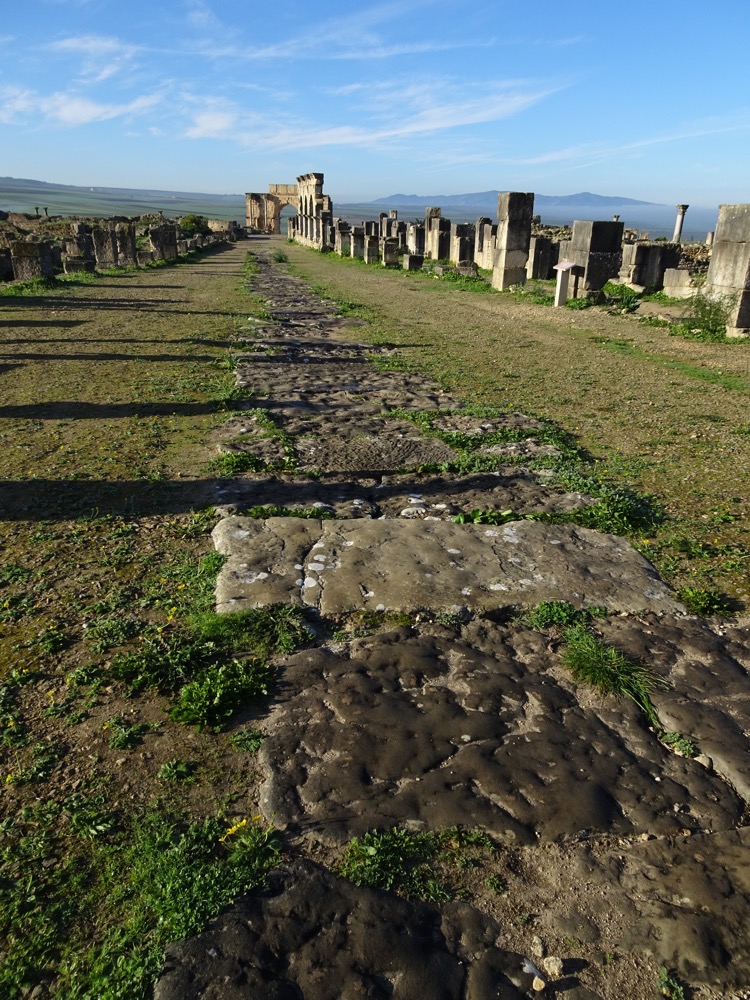
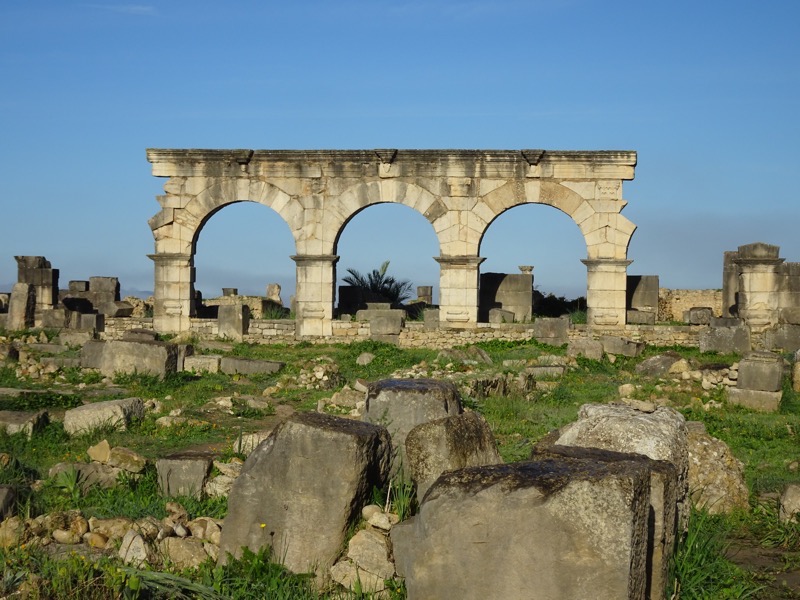 Attached to the site is a relatively new interpretive centre with some artefacts that were found on the site. Unfortunately, much of the site’s treasures have landed in the various museums of Europe, but there were some interesting objects housed here, including these steles from the Mauritanian to the Roman period. A stele was a small monument which depicts a character in relief or engraved often showing offerings in their hands.
Attached to the site is a relatively new interpretive centre with some artefacts that were found on the site. Unfortunately, much of the site’s treasures have landed in the various museums of Europe, but there were some interesting objects housed here, including these steles from the Mauritanian to the Roman period. A stele was a small monument which depicts a character in relief or engraved often showing offerings in their hands. 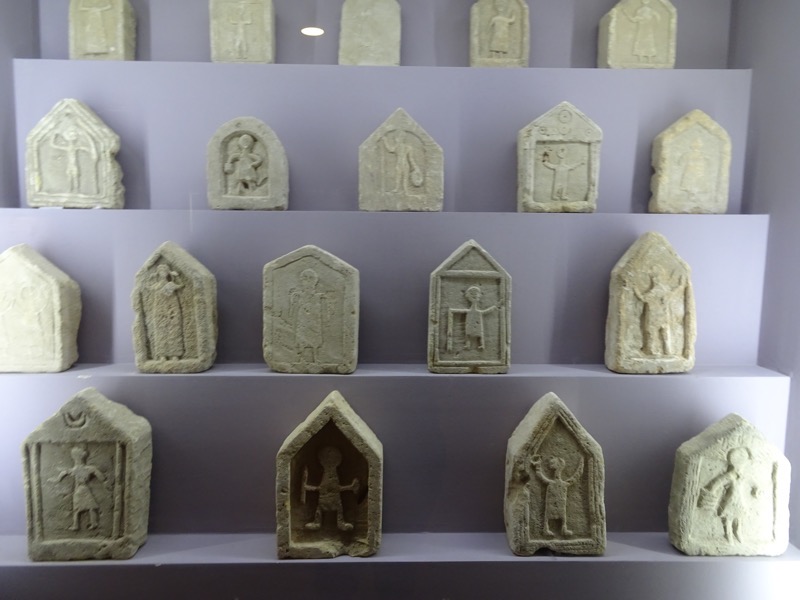
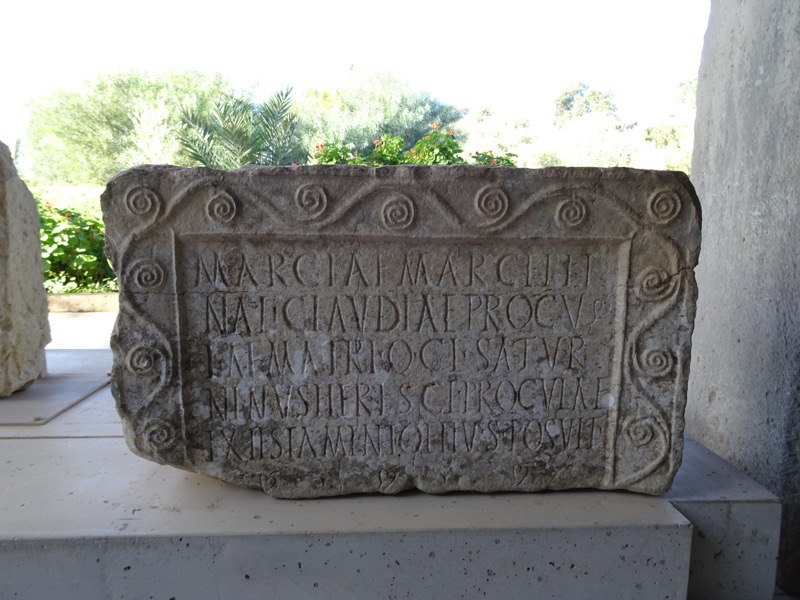
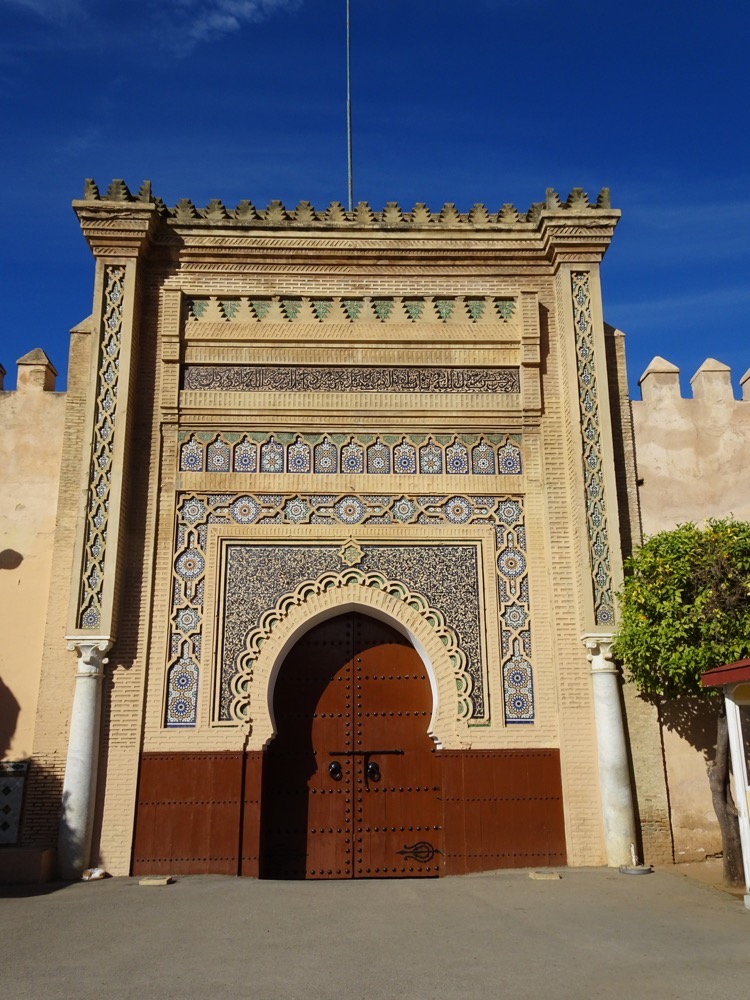 The Royal Palace still belongs to the current royal family and is not open to visitors. Inside we believe there are lavish buildings and a golf course for the King and his visitors.
The Royal Palace still belongs to the current royal family and is not open to visitors. Inside we believe there are lavish buildings and a golf course for the King and his visitors.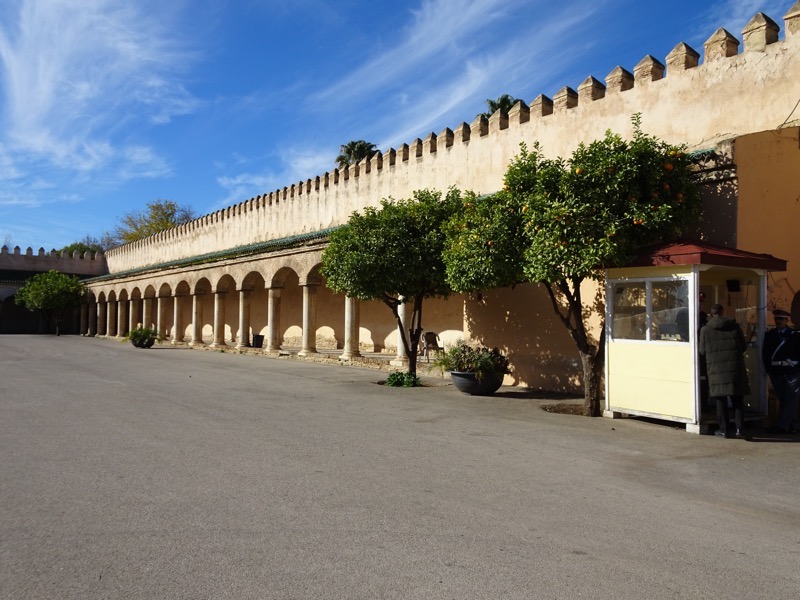 Outside, rows of palms and Seville orange trees…
Outside, rows of palms and Seville orange trees…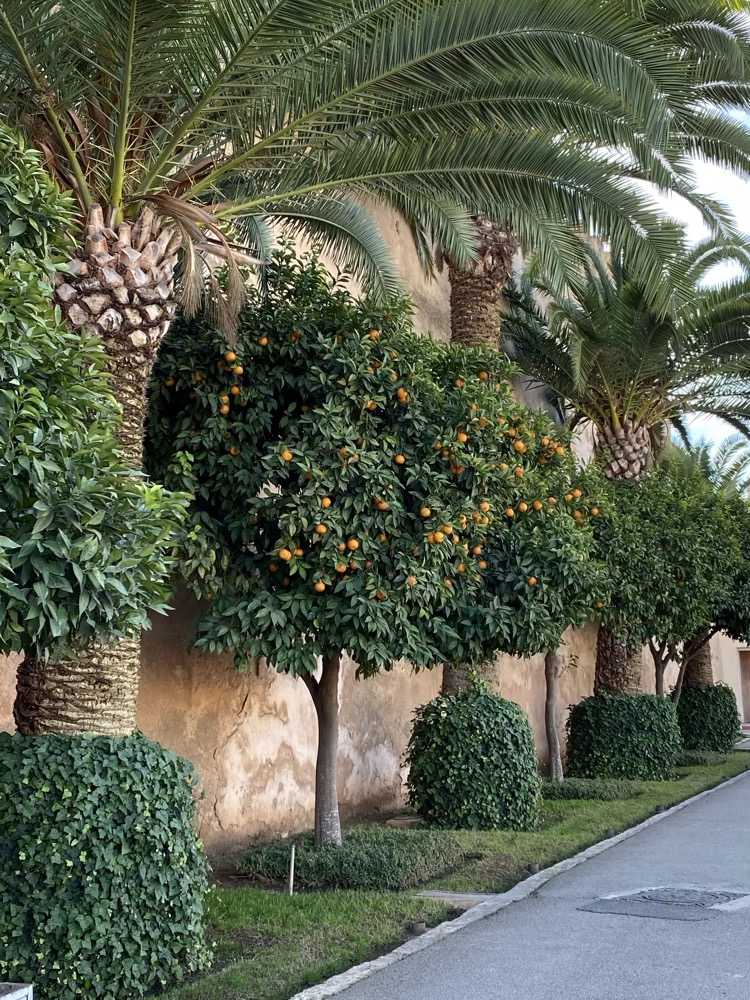
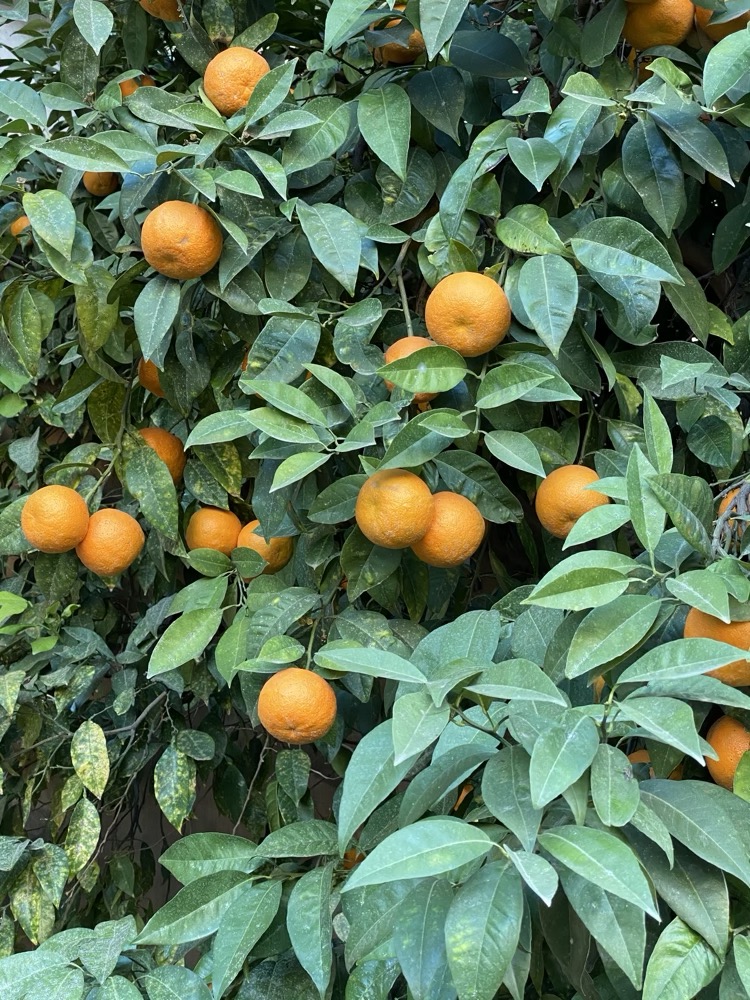
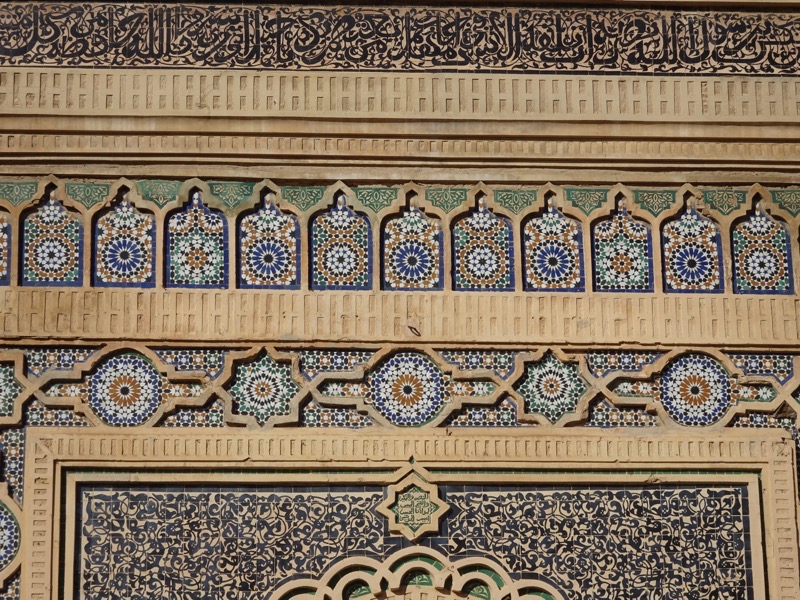 A modern monument celebrating the water bearers who wear the funny outfits.
A modern monument celebrating the water bearers who wear the funny outfits.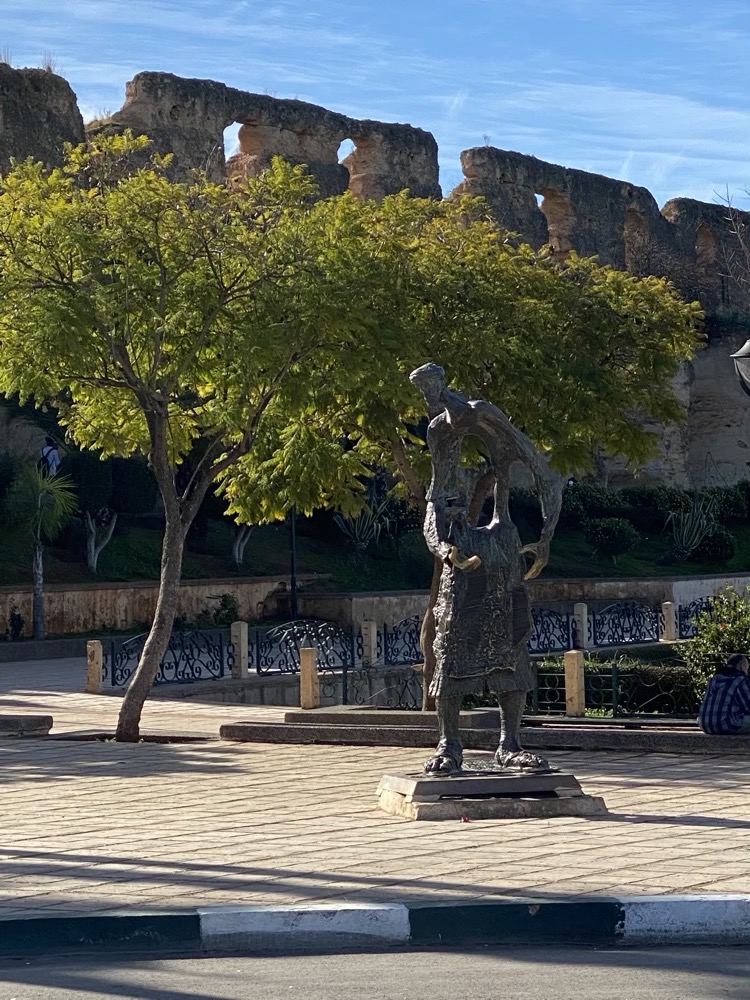
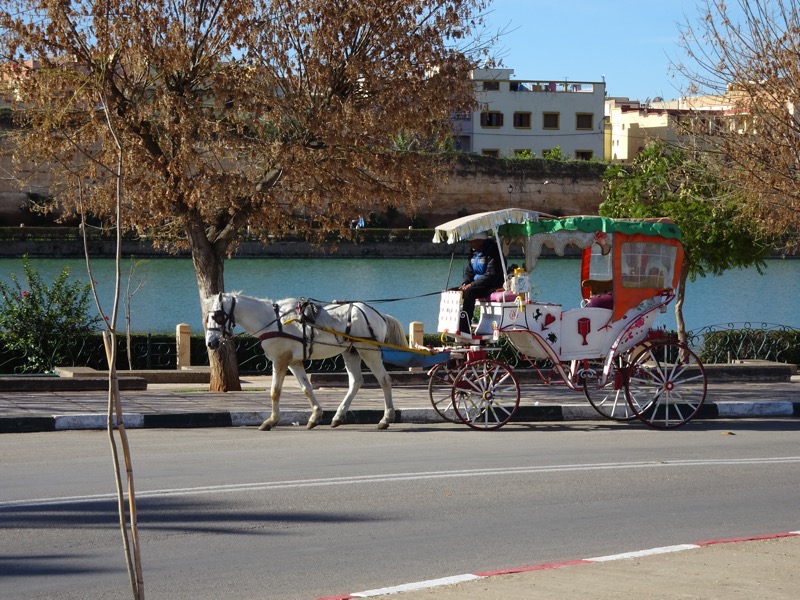 The Sahrij Swani – enormous granaries and stables that were built to support the military – the stables used to house some 3000 horses at the height of the Alaouite dynasty.
The Sahrij Swani – enormous granaries and stables that were built to support the military – the stables used to house some 3000 horses at the height of the Alaouite dynasty.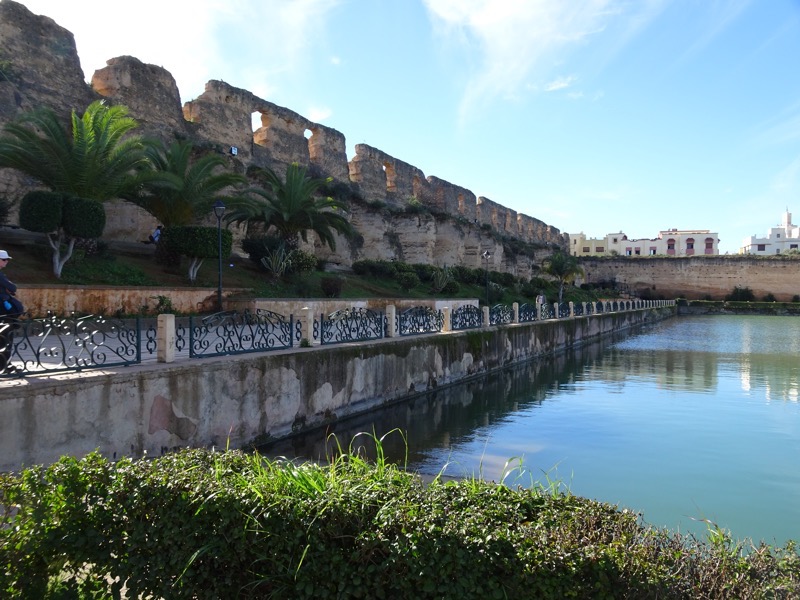 The Bab El Khemis Gate Built in 1693, near the Riad and Mellah quarters – we saw a heavily overloaded truck speed through this gate. It barely scraped through, we all did a sharp intake of breath as it screamed towards it. Whoever packed up that truck was obviously very familiar with the size of the gate!
The Bab El Khemis Gate Built in 1693, near the Riad and Mellah quarters – we saw a heavily overloaded truck speed through this gate. It barely scraped through, we all did a sharp intake of breath as it screamed towards it. Whoever packed up that truck was obviously very familiar with the size of the gate! 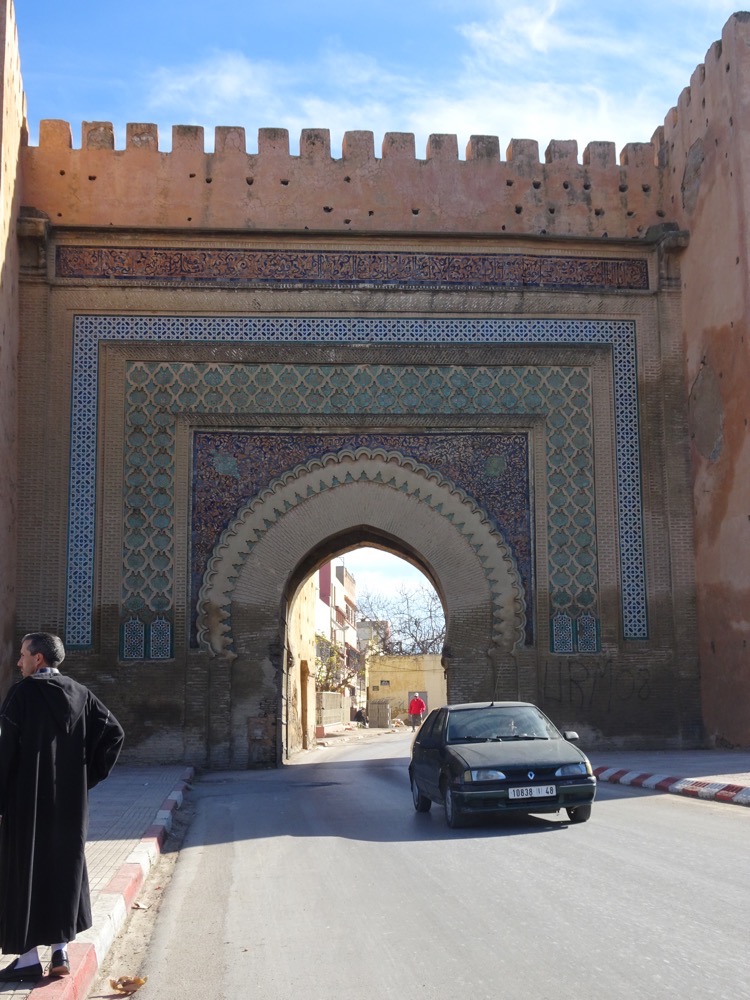 The very famous Bab El-Mansour gate, covered in mosaics, tile work and koranic inscriptions – built in 1732.
The very famous Bab El-Mansour gate, covered in mosaics, tile work and koranic inscriptions – built in 1732.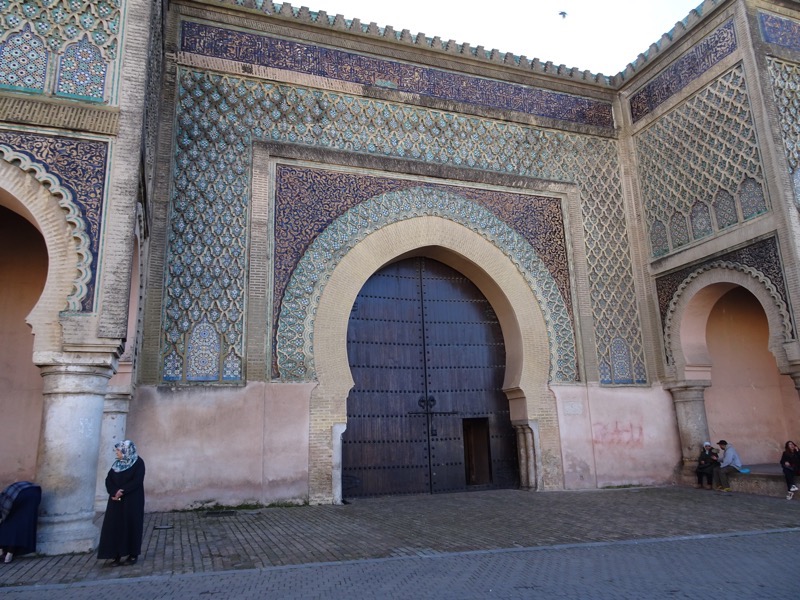 The history of the gate tells us that on completion of the gate when the Sultan inspected it, he asked the architect El-Mansour if he could do better, El-Mansour felt compelled to say ‘yes’, probably anticipating another commission. Instead, the Sultan was infuriated and had El-Mansour immediately executed.
The history of the gate tells us that on completion of the gate when the Sultan inspected it, he asked the architect El-Mansour if he could do better, El-Mansour felt compelled to say ‘yes’, probably anticipating another commission. Instead, the Sultan was infuriated and had El-Mansour immediately executed.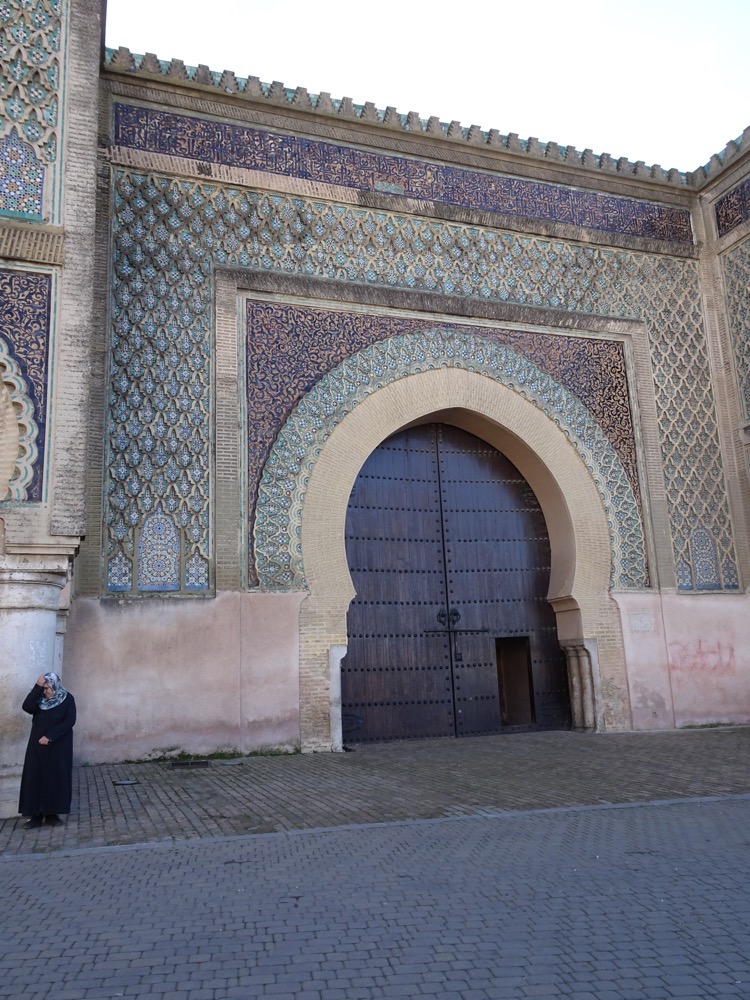
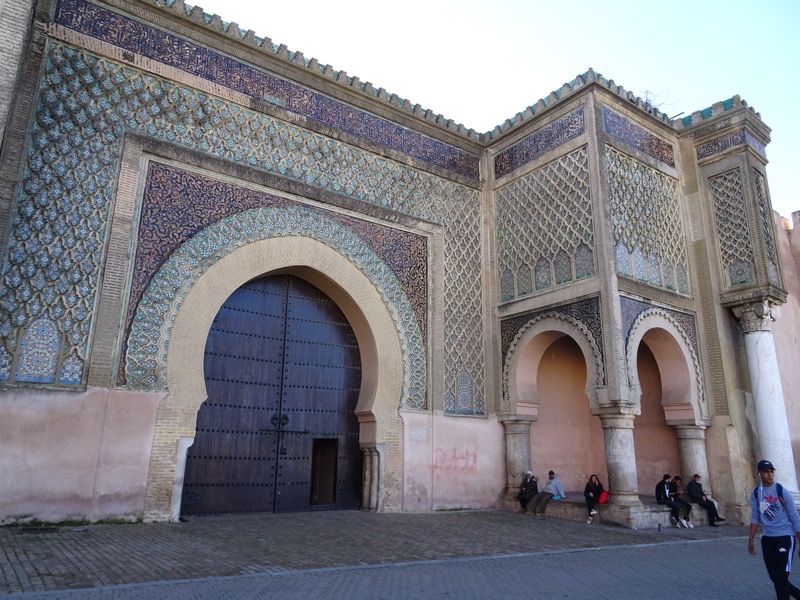
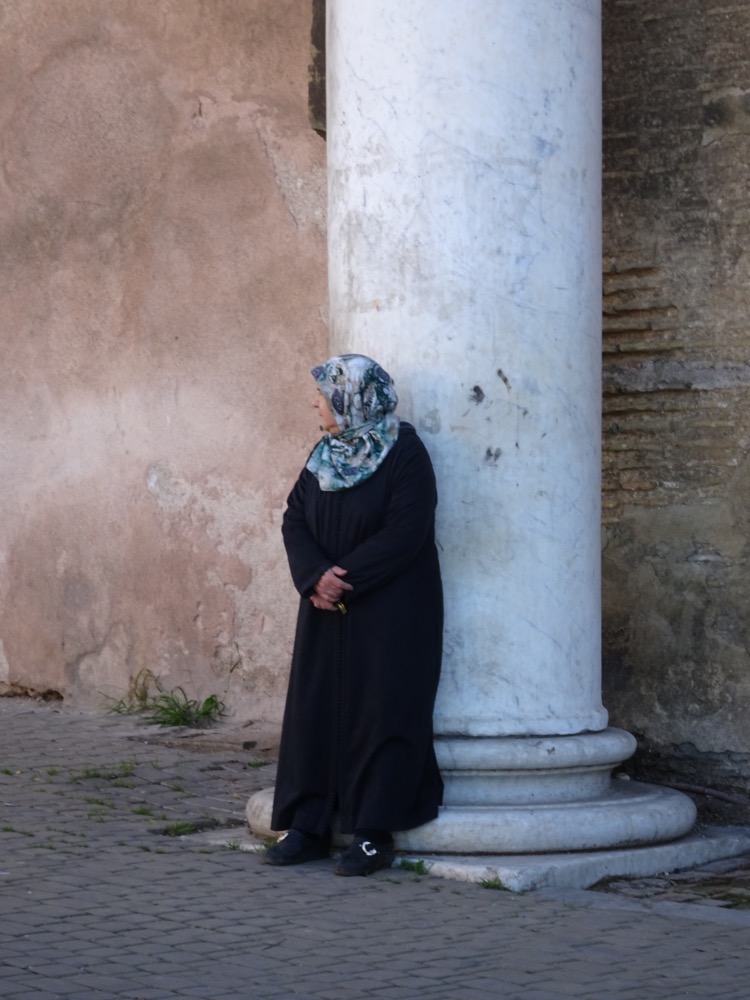 While I love the weird integration of Islamic and Roman elements in the design – it was less than impressive to learn that the columns were pilfered from Volubilis.
While I love the weird integration of Islamic and Roman elements in the design – it was less than impressive to learn that the columns were pilfered from Volubilis. 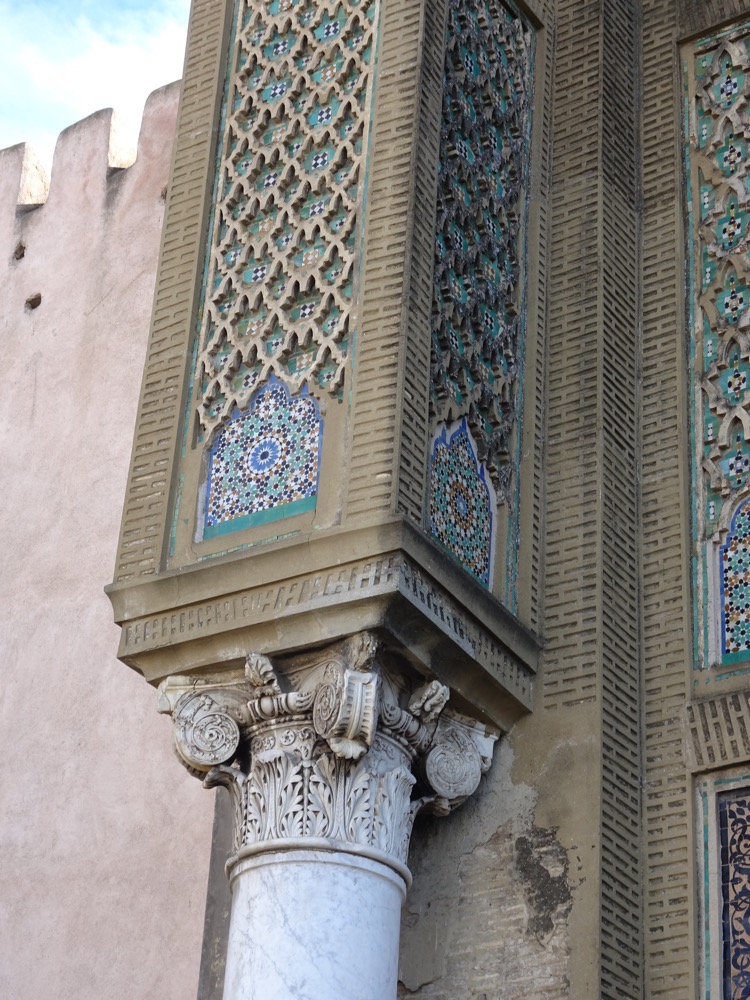 Across the road from the gate is an enormous town square – currently occupied by snake charmers (yes, actual snake charmers, though I don’t think they were very good – their snakes were mostly just laying around in the sun), and men with little monkeys on chains dressed in soccer team shirts that they were literally throwing onto hapless tourists to take photos with, so they could then demand money from the unsuspecting visitors. Most of our group is very well travelled and didn’t fall for this nonsense. Poor little monkeys. 🙁
Across the road from the gate is an enormous town square – currently occupied by snake charmers (yes, actual snake charmers, though I don’t think they were very good – their snakes were mostly just laying around in the sun), and men with little monkeys on chains dressed in soccer team shirts that they were literally throwing onto hapless tourists to take photos with, so they could then demand money from the unsuspecting visitors. Most of our group is very well travelled and didn’t fall for this nonsense. Poor little monkeys. 🙁 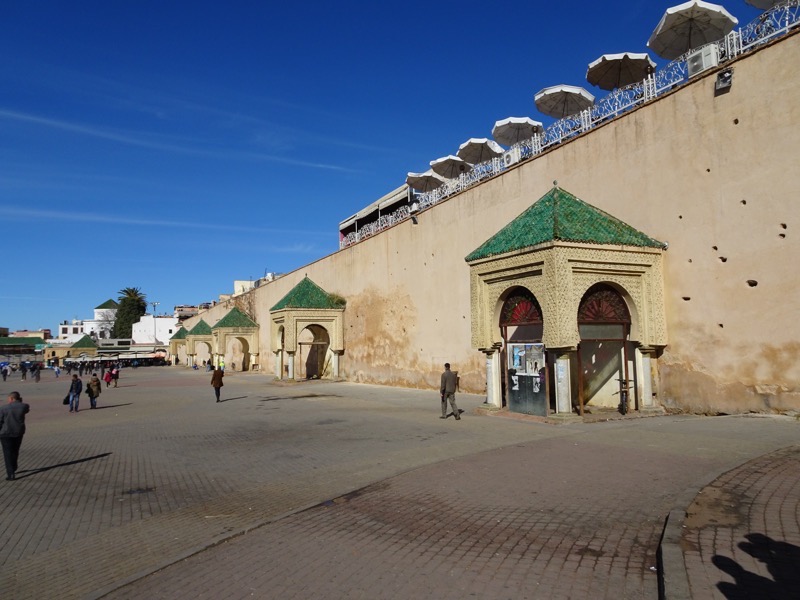 Surrounding the square was an endless row of restaurants and people selling tiles and ceramics and all sorts. The green-roofed doorway to right of this picture was the entrance to the undercover food market, which was full of shops selling spices, dates, figs, olives, pickles and down the smelly end – unrefrigerated meat.
Surrounding the square was an endless row of restaurants and people selling tiles and ceramics and all sorts. The green-roofed doorway to right of this picture was the entrance to the undercover food market, which was full of shops selling spices, dates, figs, olives, pickles and down the smelly end – unrefrigerated meat.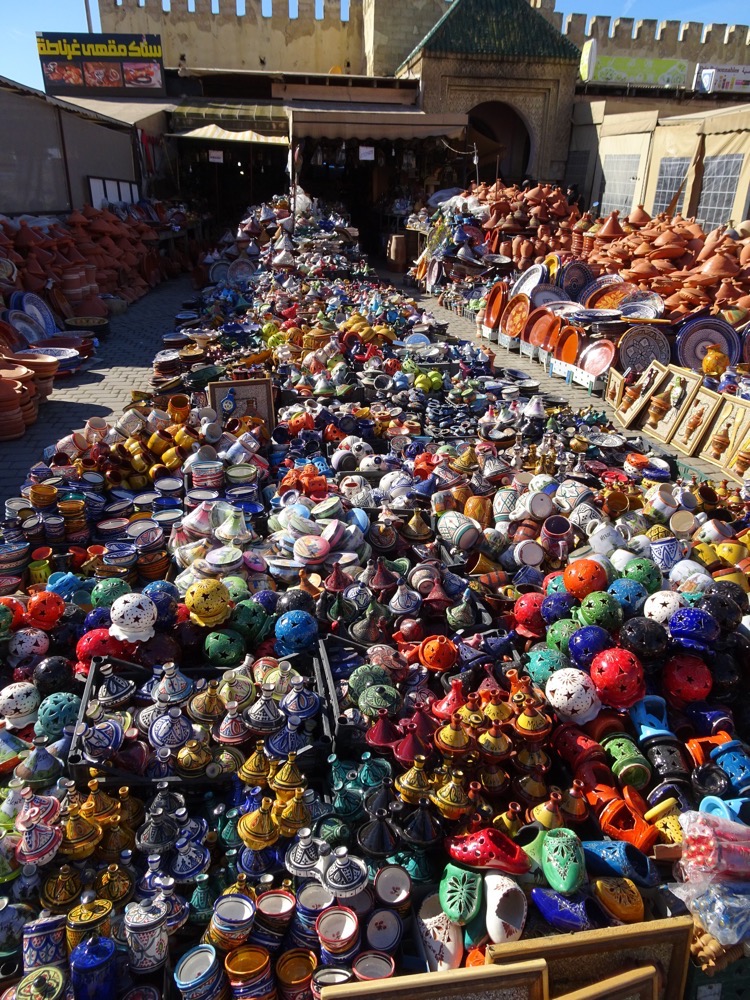
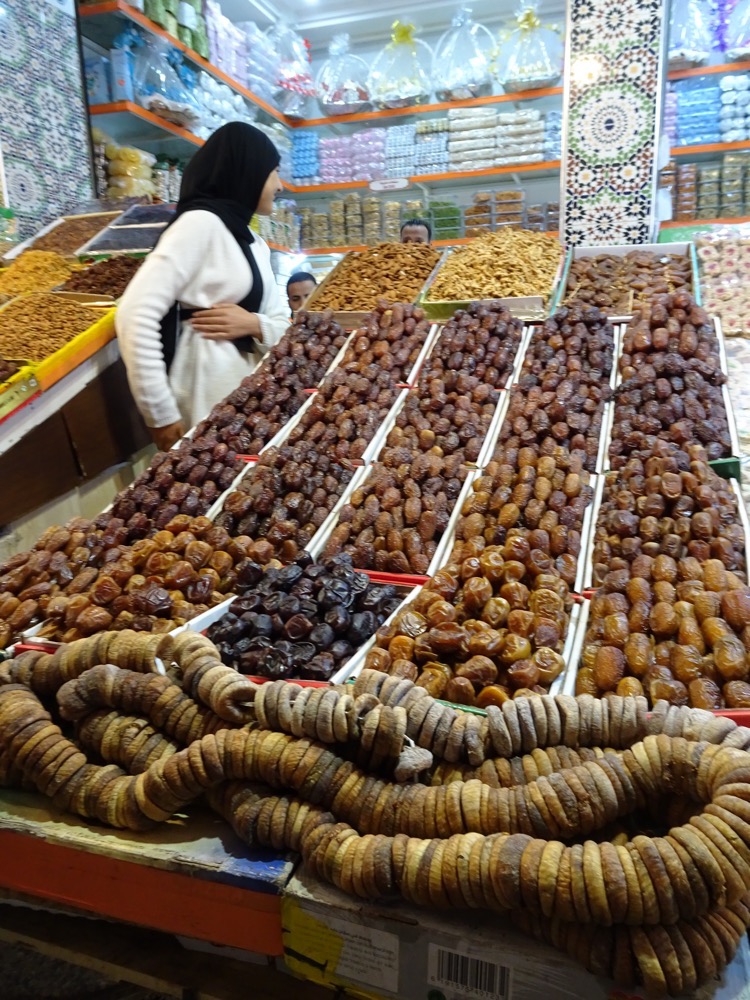 Olives, olives and more olives.
Olives, olives and more olives.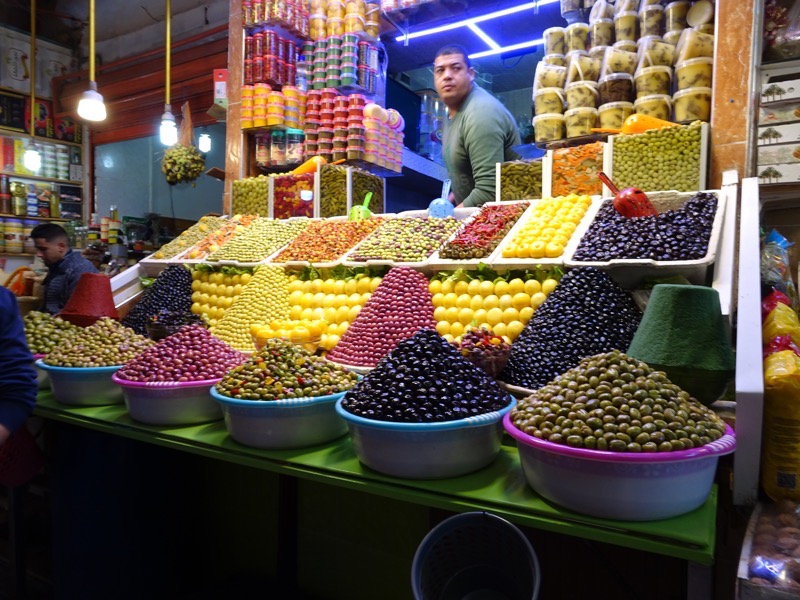 Across the other side of the square, away from the food markets was a maze of little alleyways that were more focused on the textile industries – stores full of silk, braids, garments, and garish fabric. You could hear the busy clatter of old embroidery machines around every corner.
Across the other side of the square, away from the food markets was a maze of little alleyways that were more focused on the textile industries – stores full of silk, braids, garments, and garish fabric. You could hear the busy clatter of old embroidery machines around every corner. 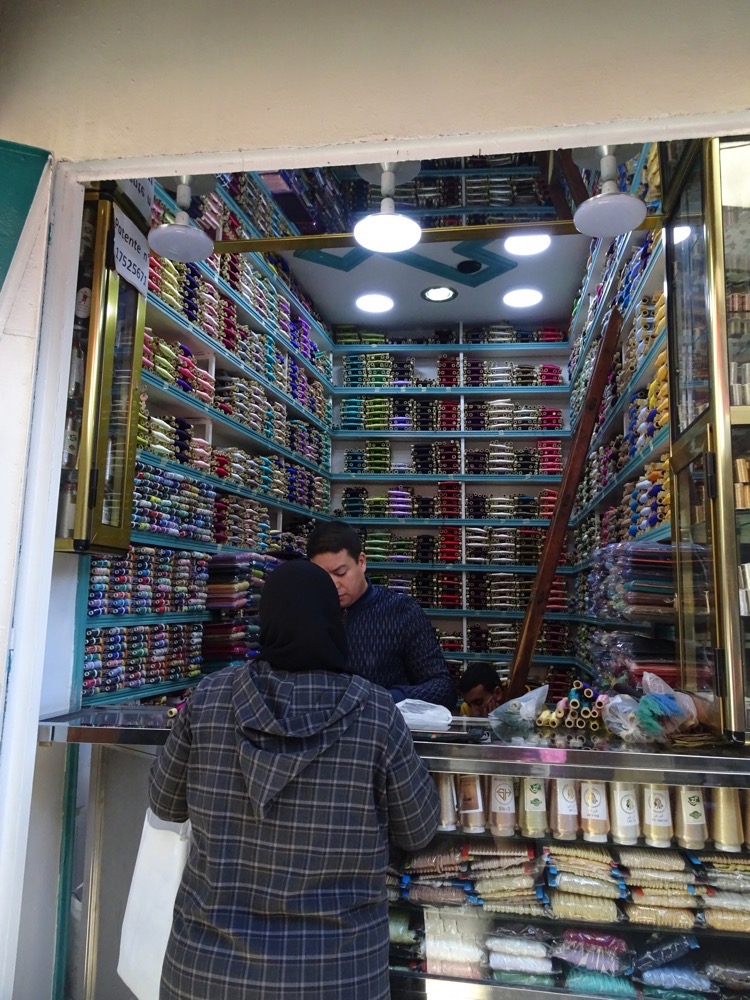
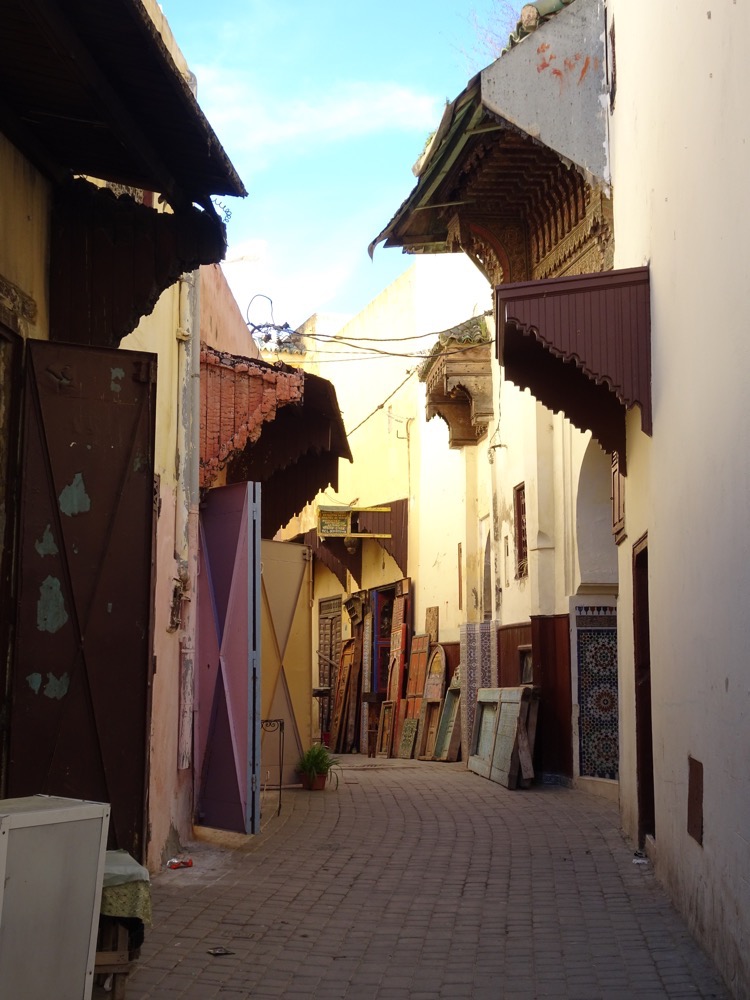

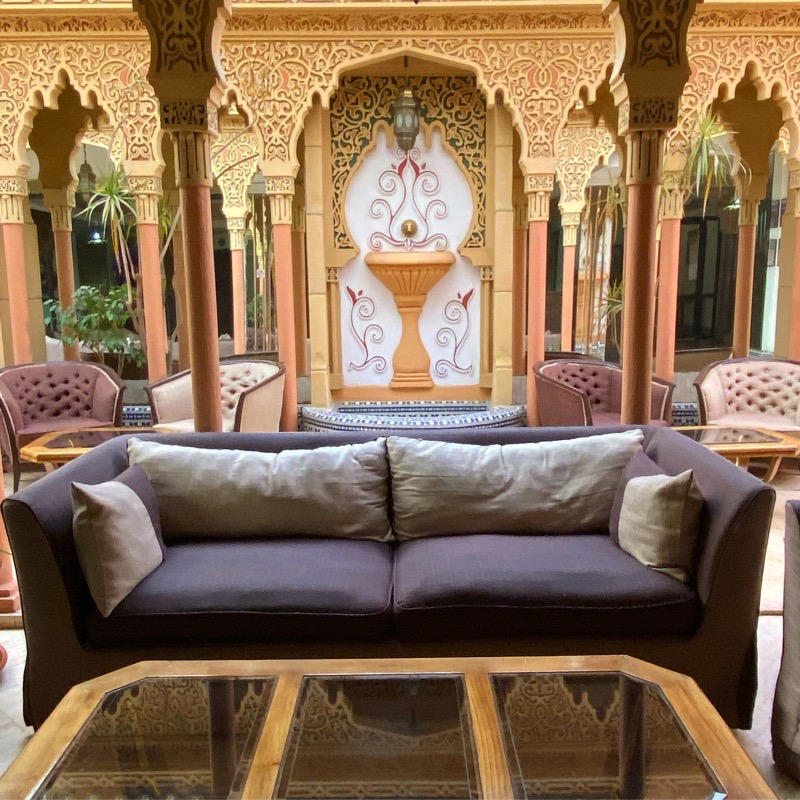
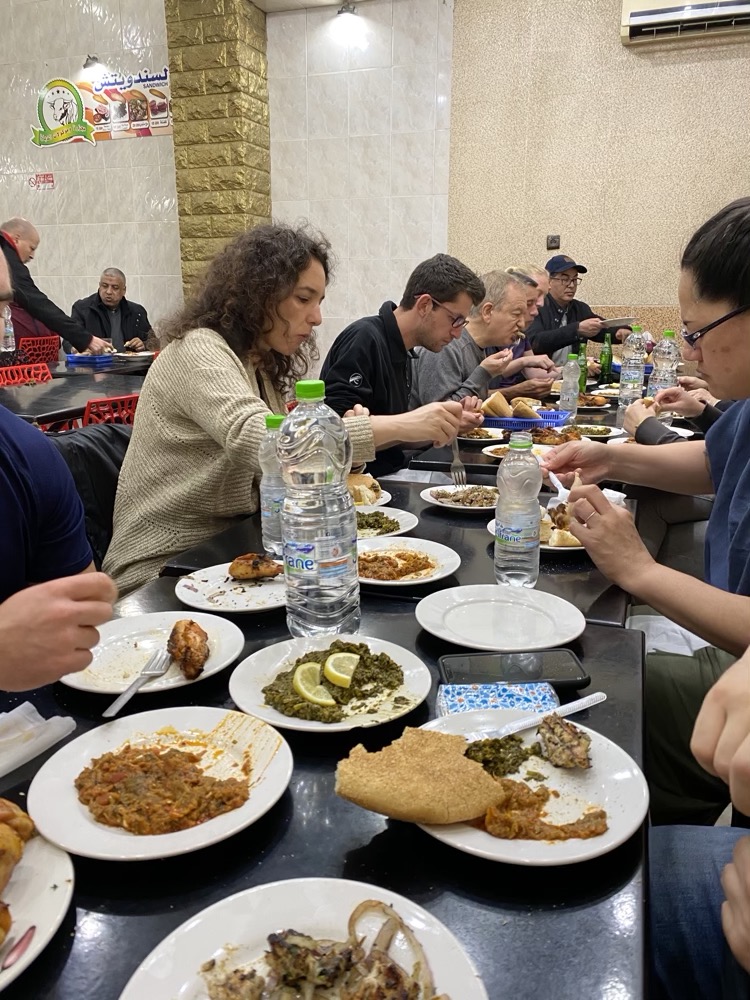 All up, a very tasty meal with some unsual offerings, which, including drinks and tips, it came to a grand total of 55DH per person compared to the 120DH per person at the first tourist restaurant… but someone else can have the next conversation with Samirr when the group wants to change the plan!
All up, a very tasty meal with some unsual offerings, which, including drinks and tips, it came to a grand total of 55DH per person compared to the 120DH per person at the first tourist restaurant… but someone else can have the next conversation with Samirr when the group wants to change the plan! !
!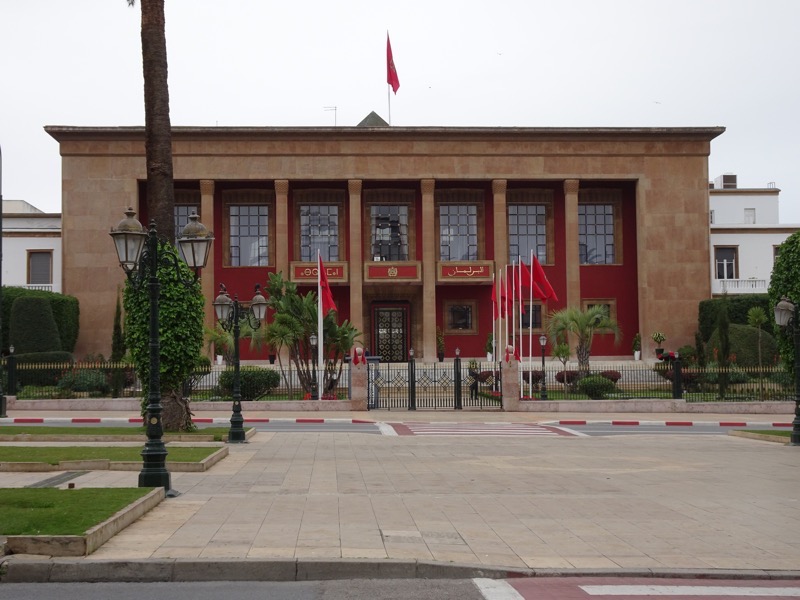
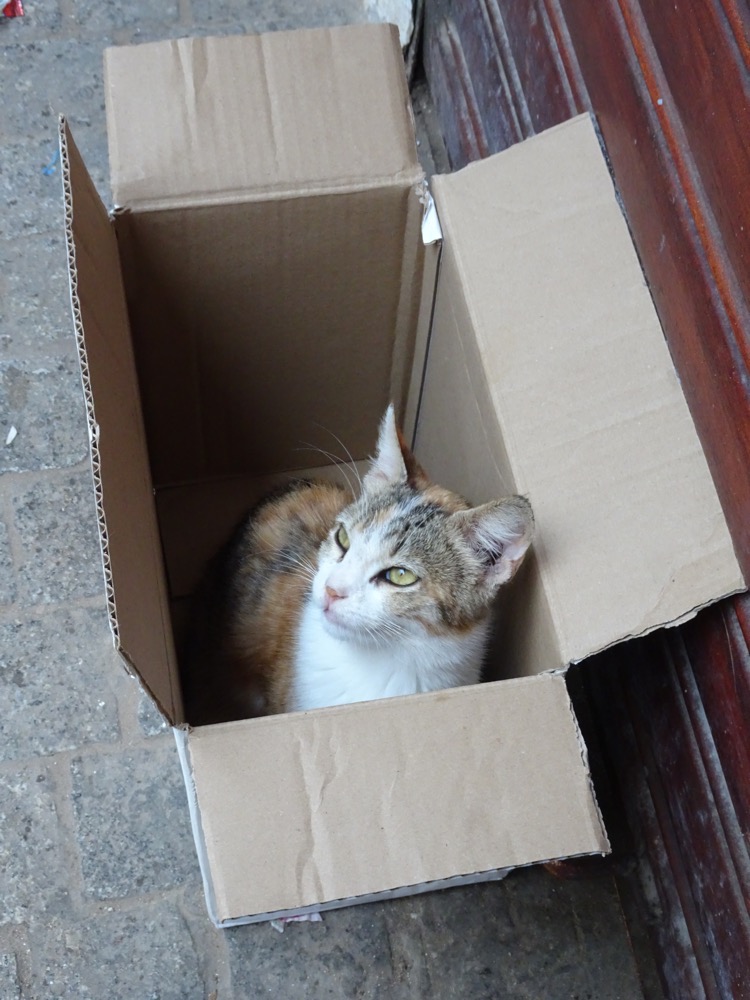
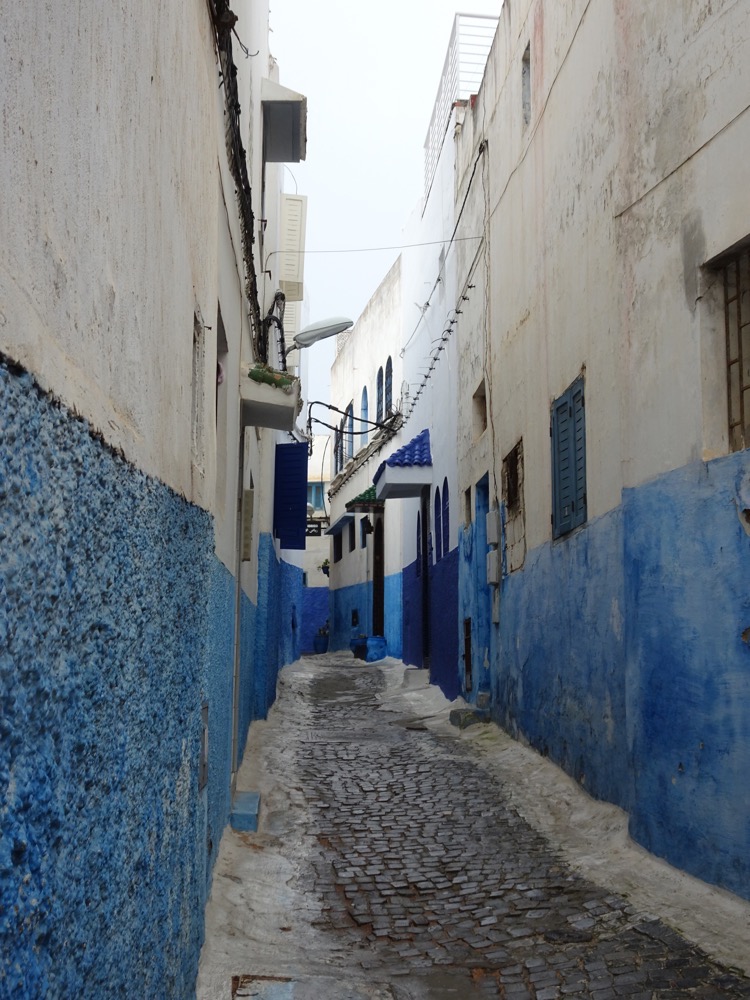
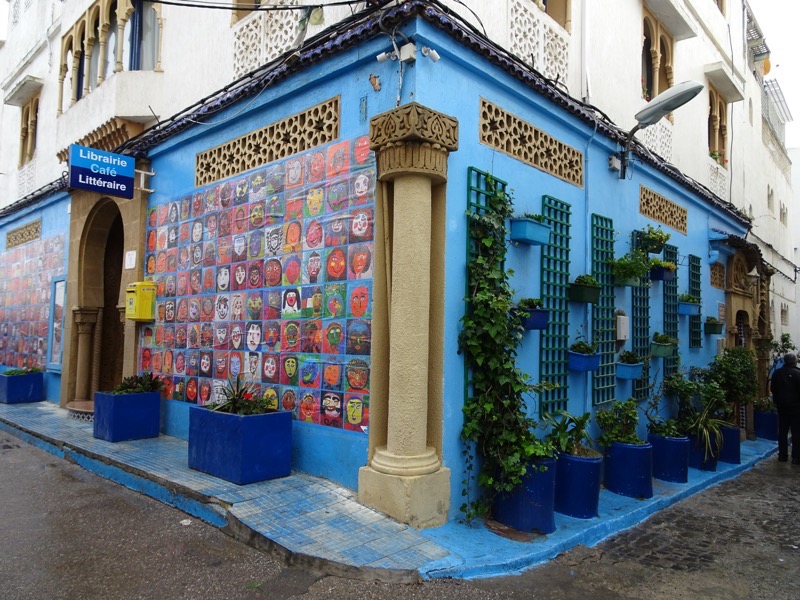
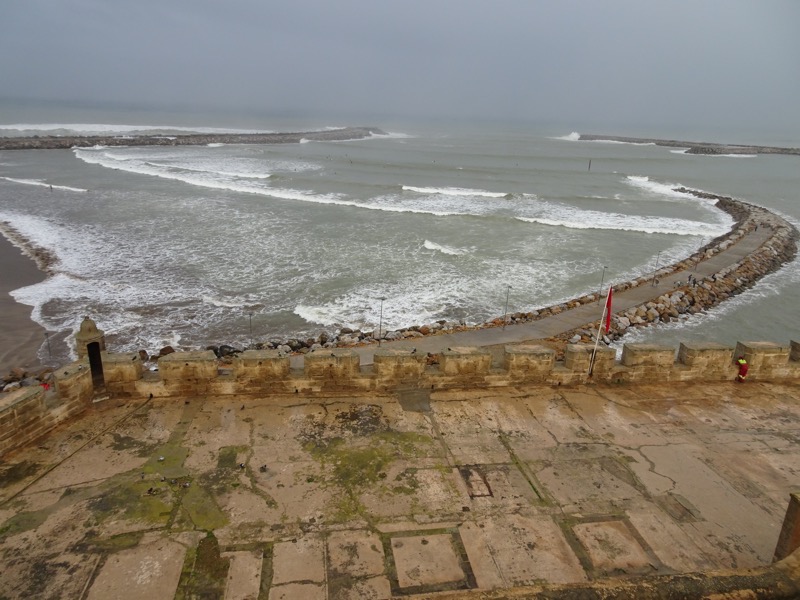
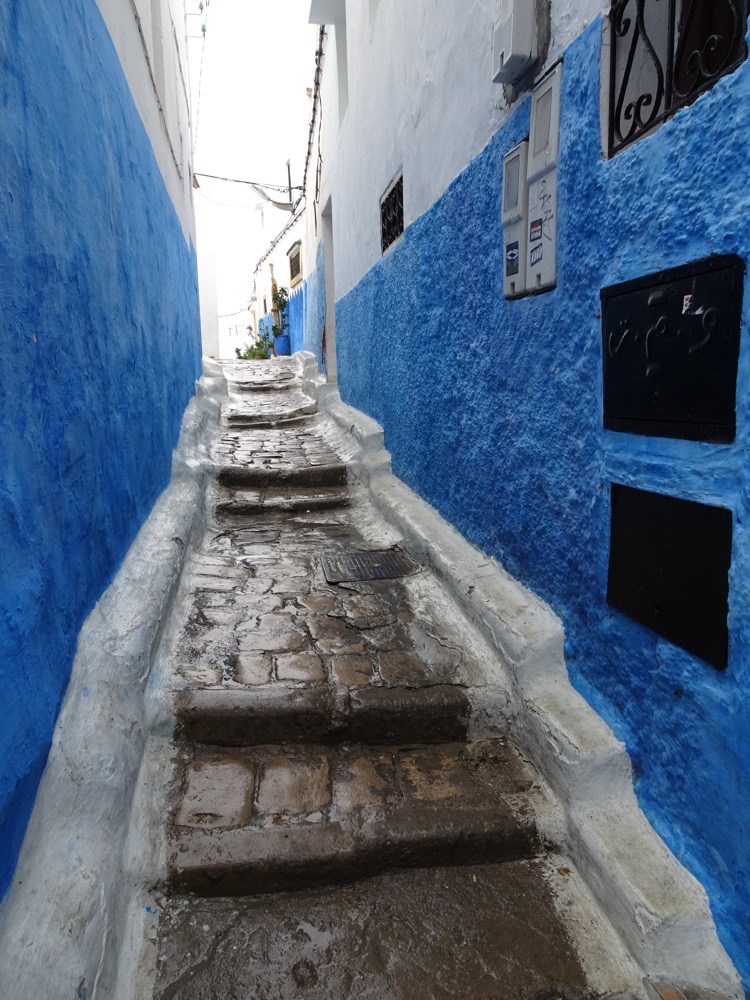
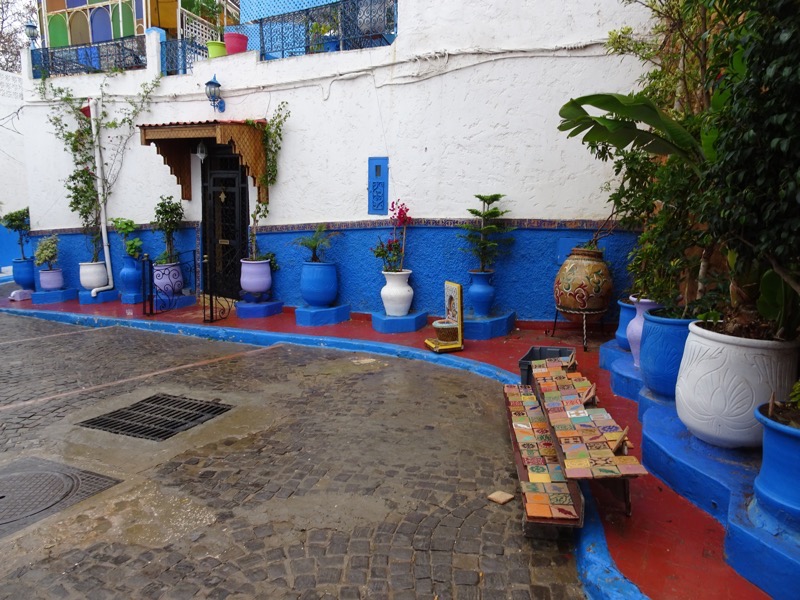
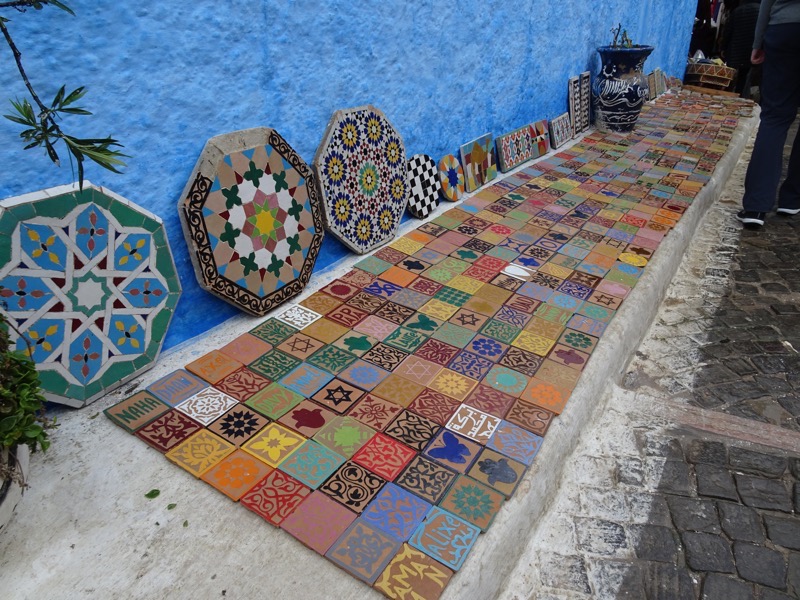
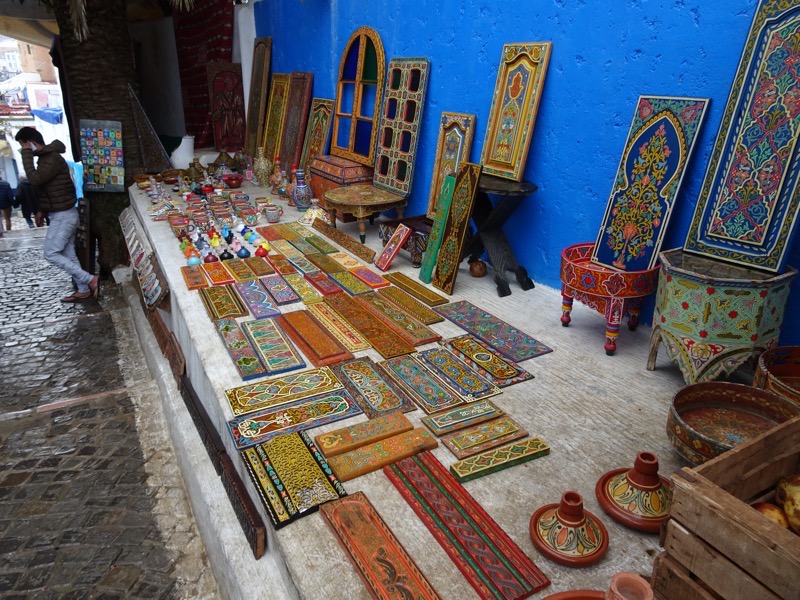
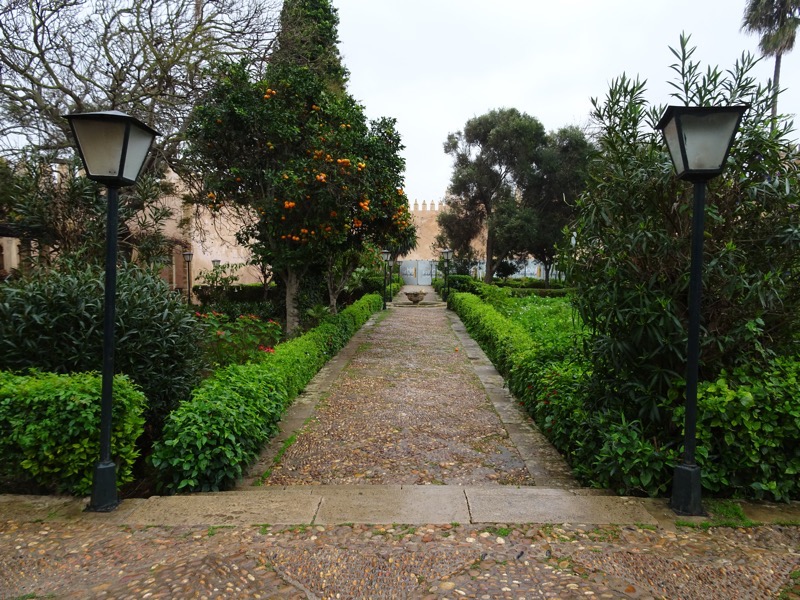 t was a very cute part of Rabat to go wandering through – it has approximately 3000 residents currently, and possibly about 500 cats judging by what we saw today. They’re everywhere, and all very well fed and happy looking critters.
t was a very cute part of Rabat to go wandering through – it has approximately 3000 residents currently, and possibly about 500 cats judging by what we saw today. They’re everywhere, and all very well fed and happy looking critters.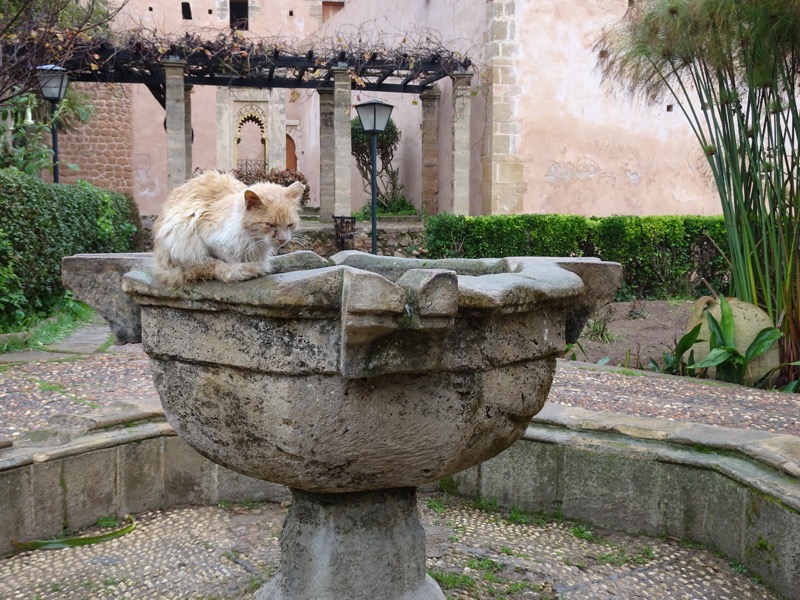 Andalusian Gardens
Andalusian Gardens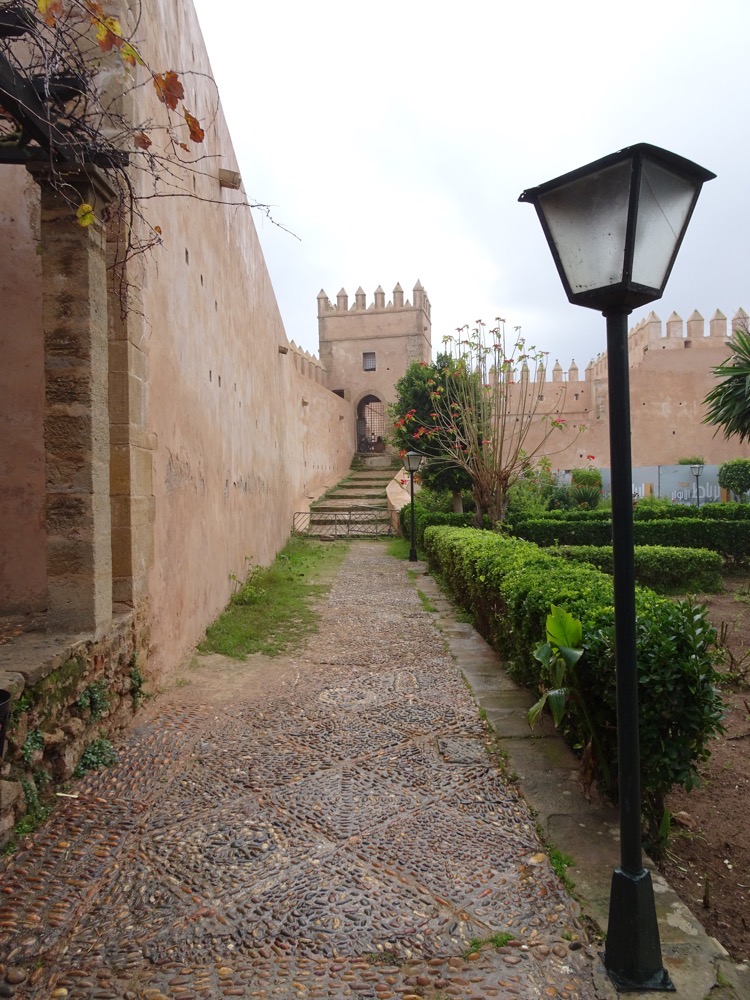
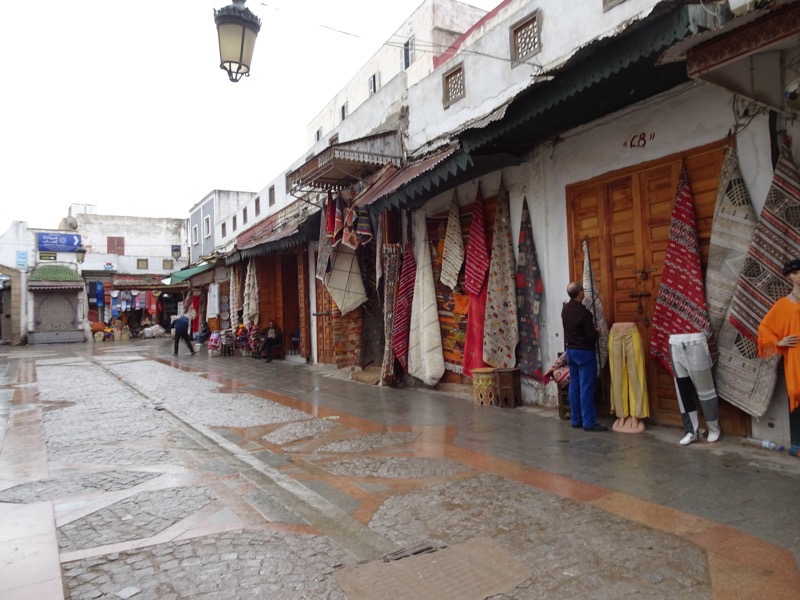
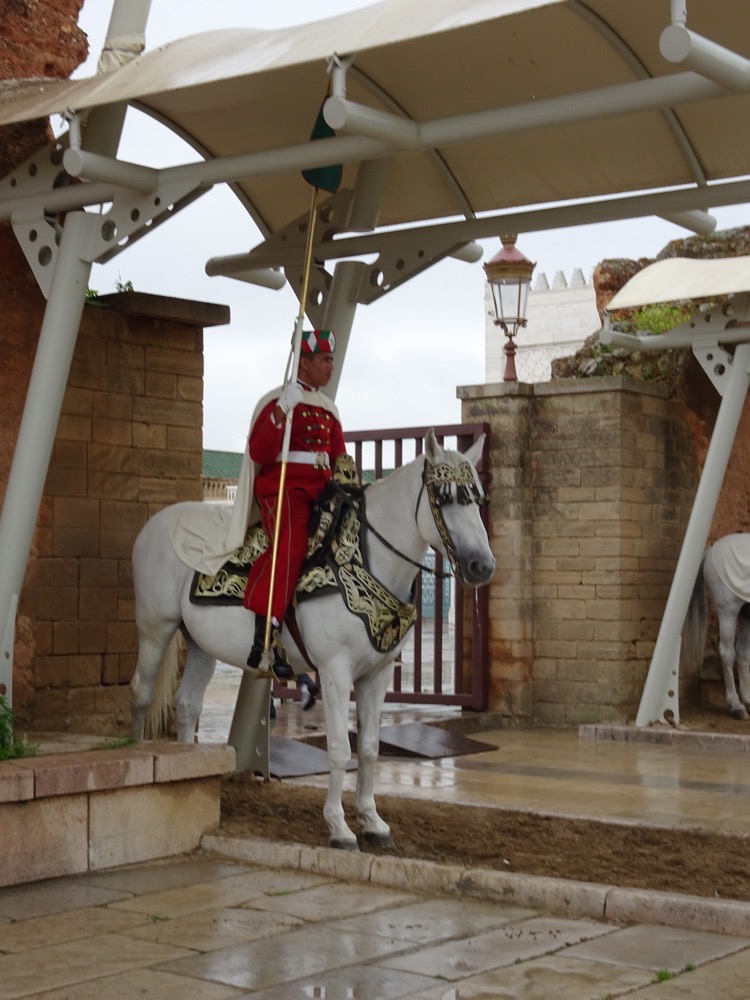
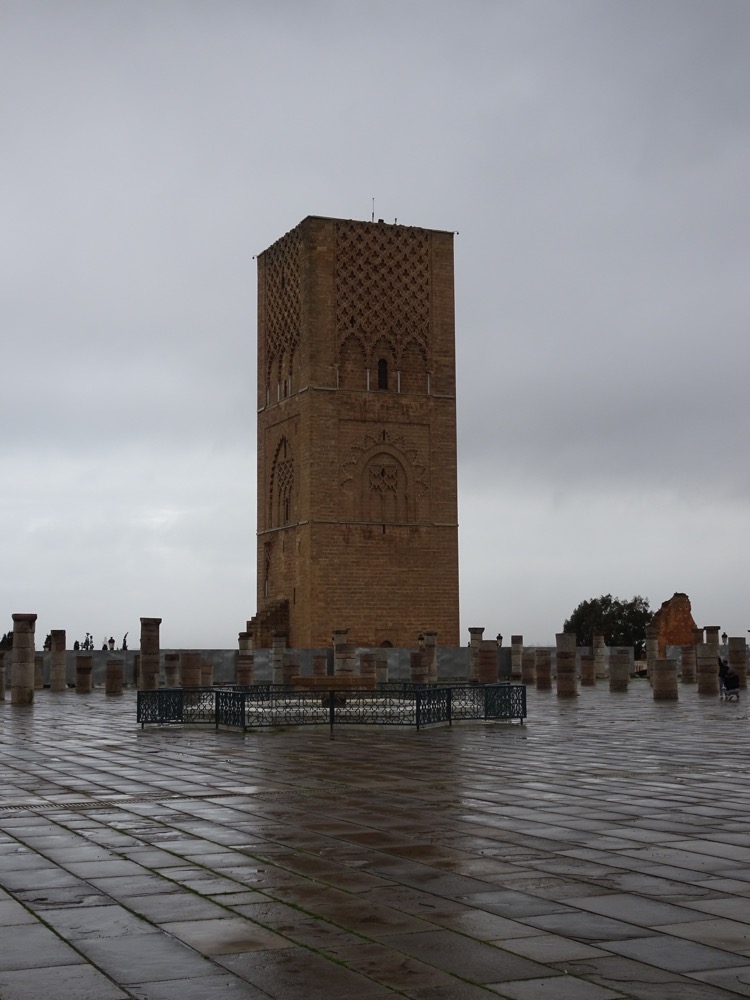
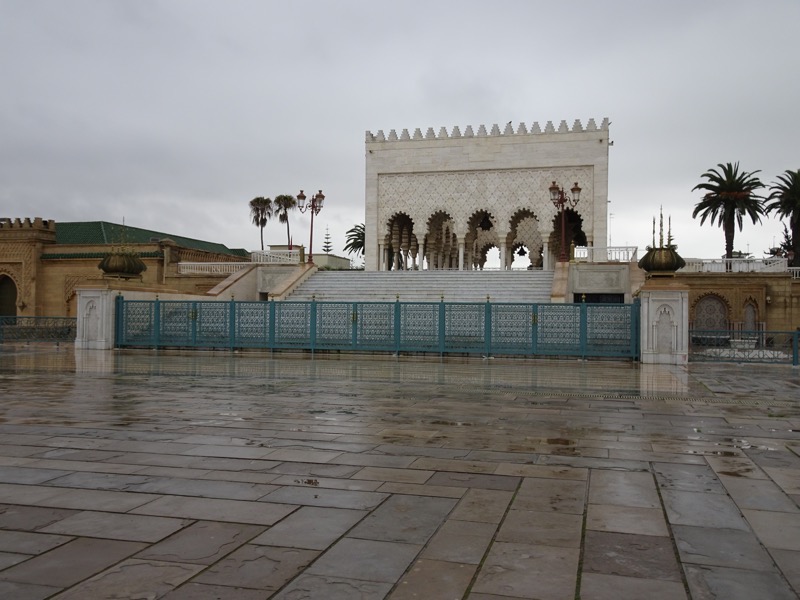
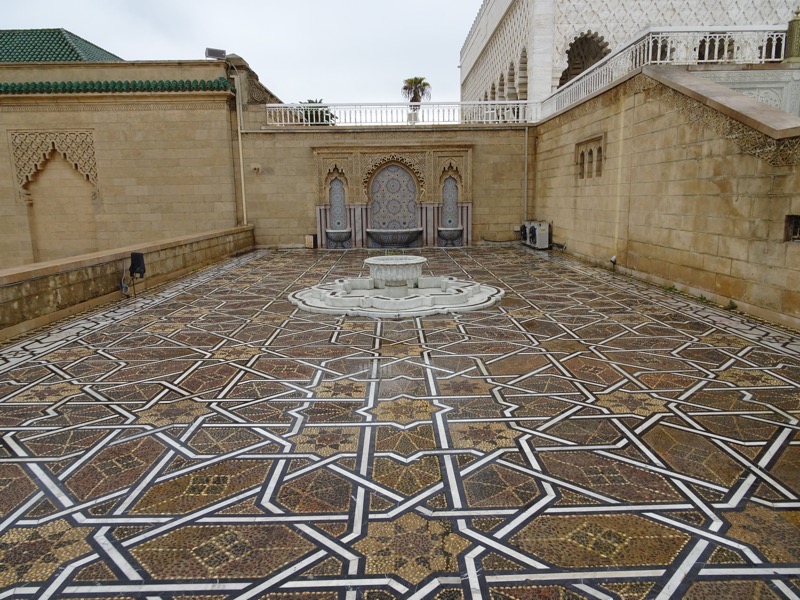
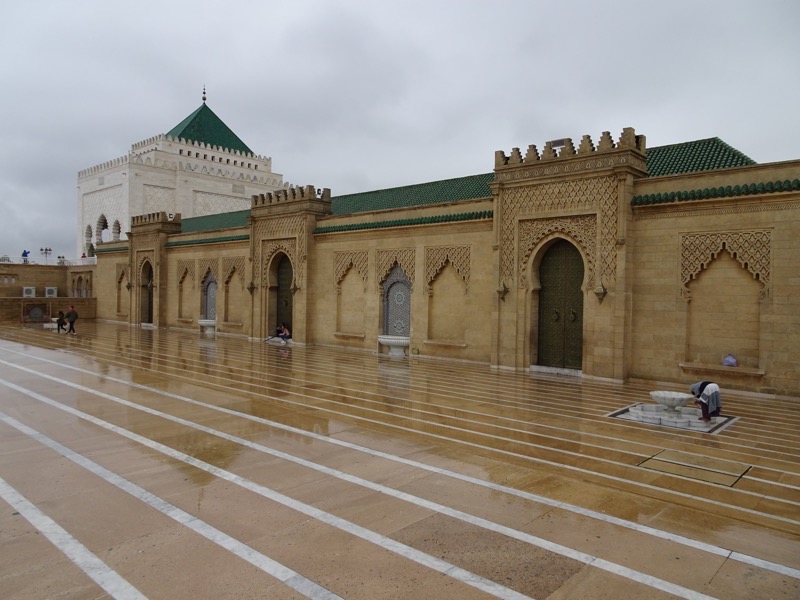 By this point of our day, I was getting a little WTF? As mentioned earlier, our dodgy tourist map hadn’t really laid out for us how far apart things were, and I had inadvertently been walking about 9kms on shitty uneven cobblestones for nearly three hours and my hips and lower back were getting decidedly unhappy with me. So we decided to take a local tram to find St Peter’s Cathedral which is located at Golan Square right in downtown Rabat. It was only built in 1919 and is in a rather bland Art Deco style… I know – I am decidedly hard to impress when it comes to churches and architecture, and this one left very little impression on me. It was designed by someone called Adrien Laforgue… and quite frankly Adrien, I feel you let us all down. When you have the sort of dish that the Catholic Church is prepared to throw at a thing like a new cathedral, you really should have been able to come up with something a bit more … well, just a bit more?!
By this point of our day, I was getting a little WTF? As mentioned earlier, our dodgy tourist map hadn’t really laid out for us how far apart things were, and I had inadvertently been walking about 9kms on shitty uneven cobblestones for nearly three hours and my hips and lower back were getting decidedly unhappy with me. So we decided to take a local tram to find St Peter’s Cathedral which is located at Golan Square right in downtown Rabat. It was only built in 1919 and is in a rather bland Art Deco style… I know – I am decidedly hard to impress when it comes to churches and architecture, and this one left very little impression on me. It was designed by someone called Adrien Laforgue… and quite frankly Adrien, I feel you let us all down. When you have the sort of dish that the Catholic Church is prepared to throw at a thing like a new cathedral, you really should have been able to come up with something a bit more … well, just a bit more?!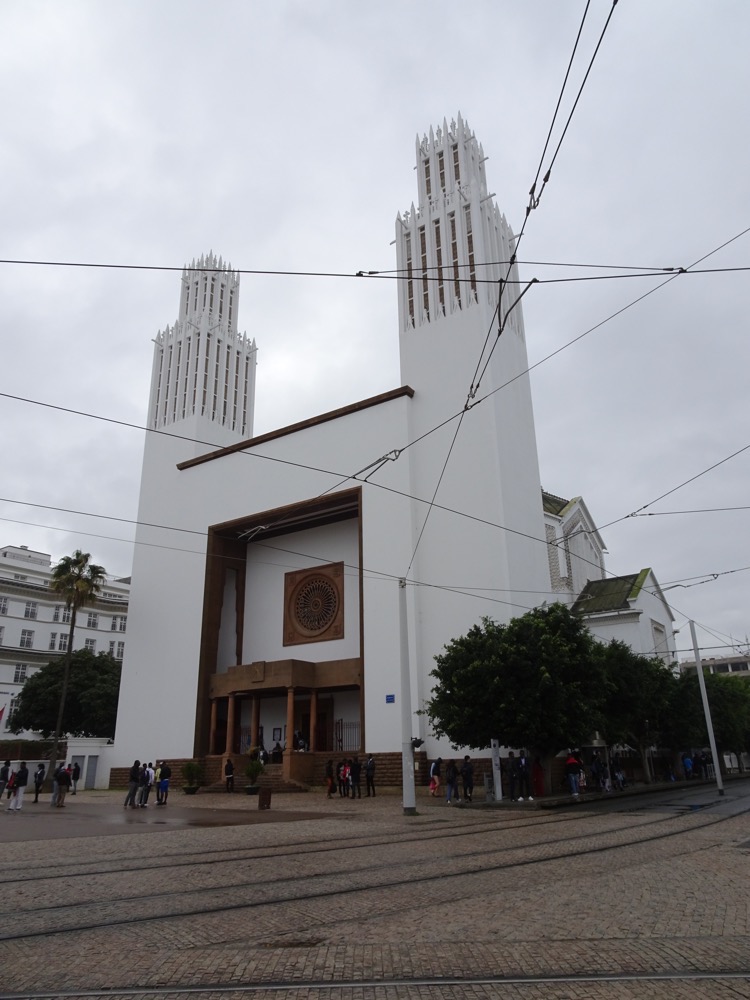
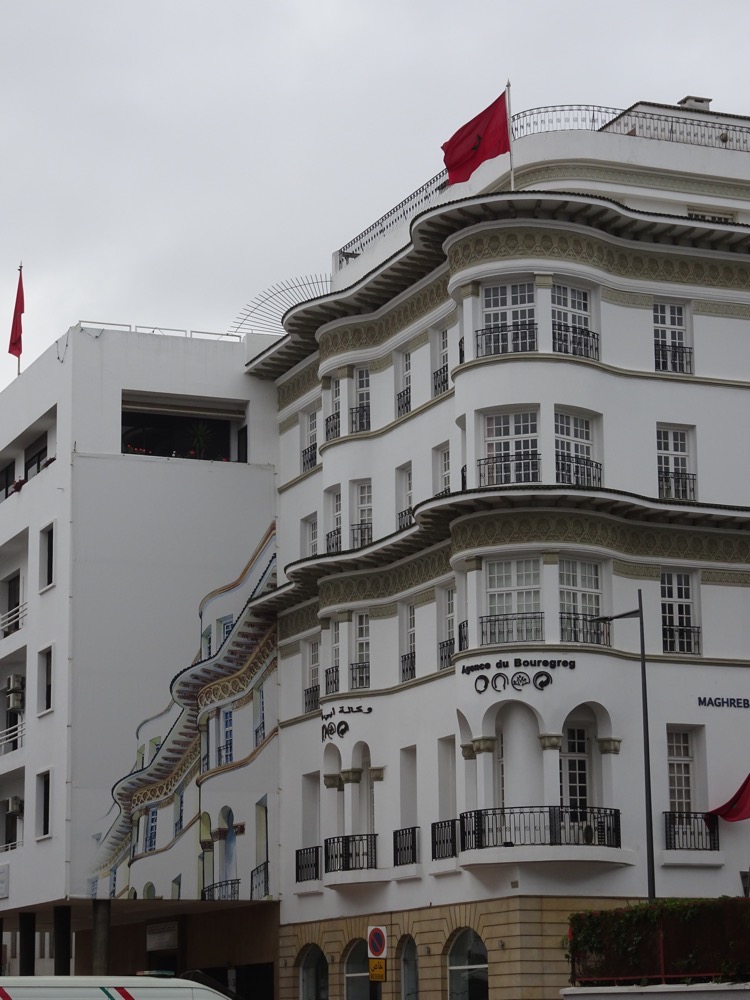
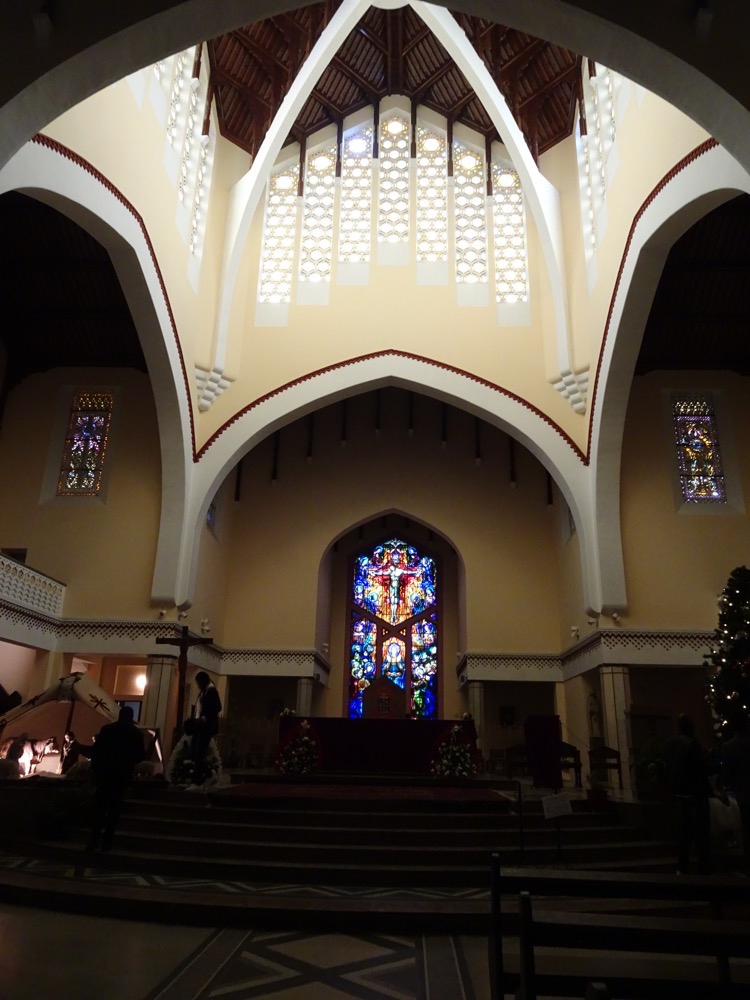
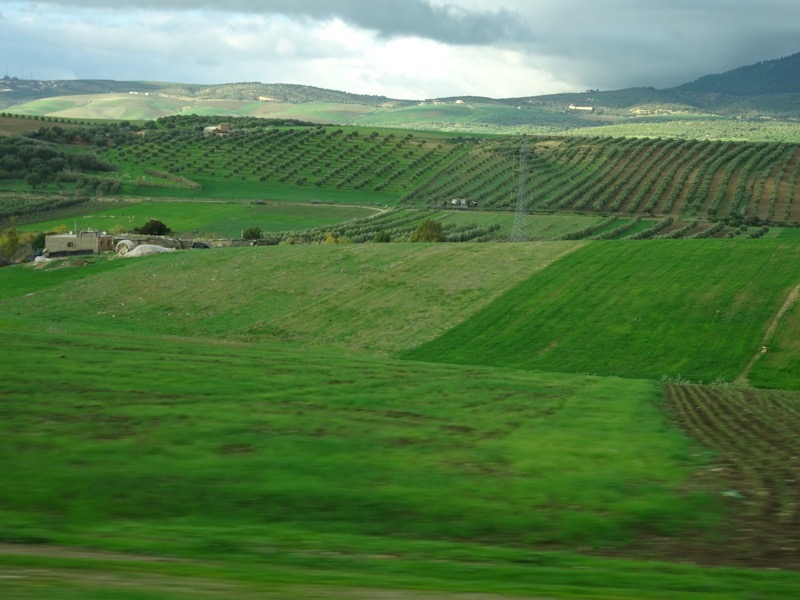
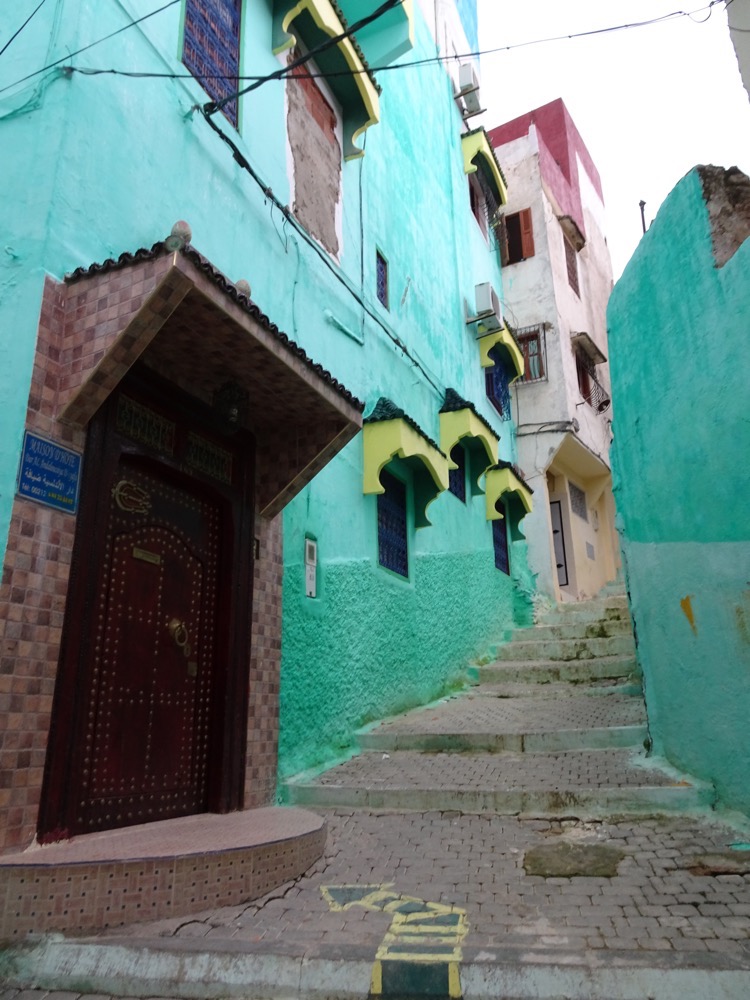
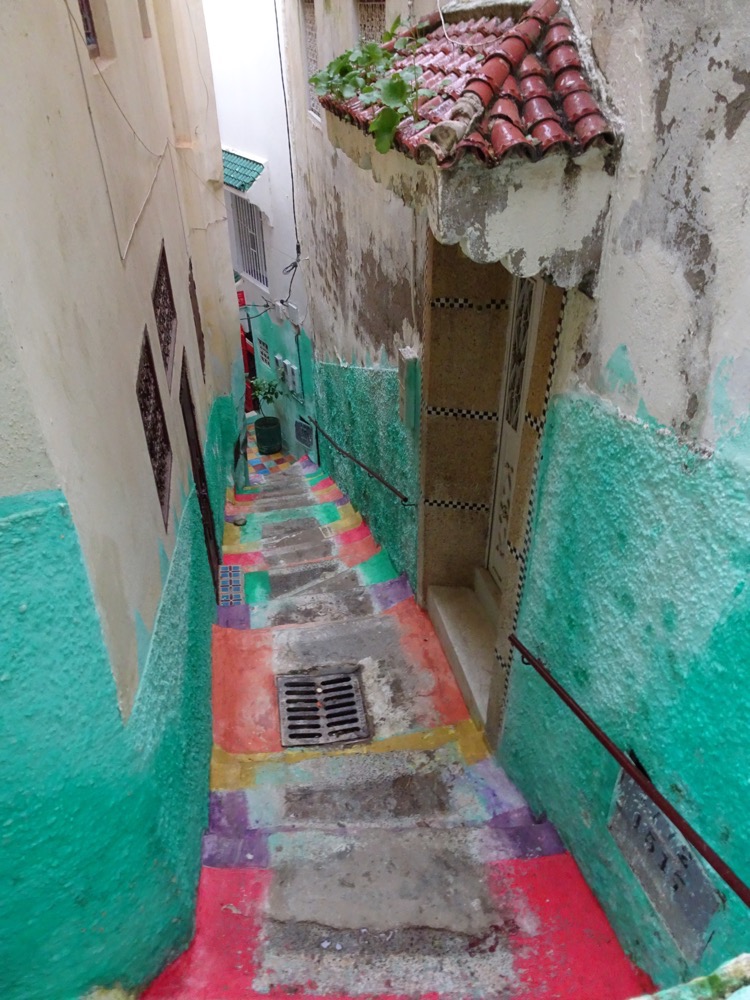
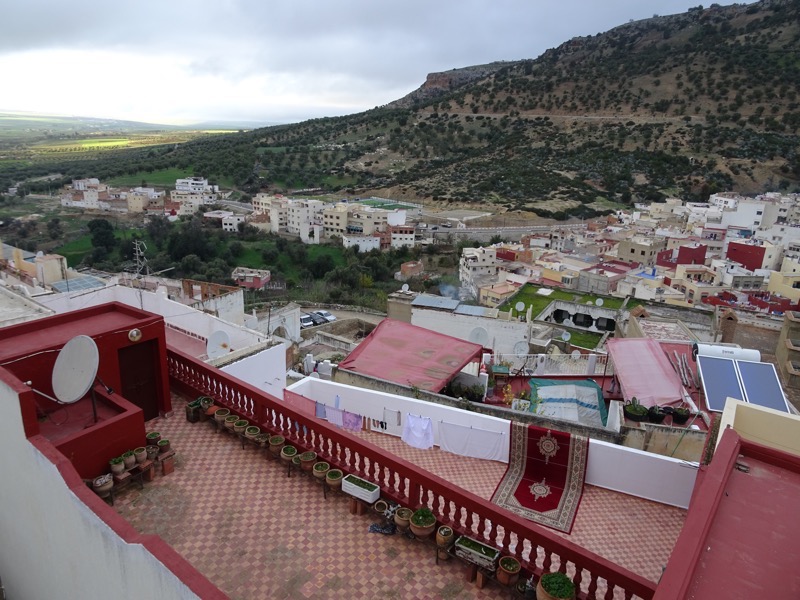 Once we were here, I had to pull the pin on going for a walk around the town to see the buildings, the bakery, the mosque etc… instead Mr K took a pile of photos of me – primarily of the town at sunset – so that I wouldn’t get the total FOMOs. I had to kick off my shoes and rest my lower back, which totally sucks! Thankfully this seem to be one of the longest and most intense days on our itinerary, so it should get a bit easier from here.
Once we were here, I had to pull the pin on going for a walk around the town to see the buildings, the bakery, the mosque etc… instead Mr K took a pile of photos of me – primarily of the town at sunset – so that I wouldn’t get the total FOMOs. I had to kick off my shoes and rest my lower back, which totally sucks! Thankfully this seem to be one of the longest and most intense days on our itinerary, so it should get a bit easier from here.